Human resource management - Assignment PDF
VerifiedAdded on 2022/01/08
|47
|28316
|20
AI Summary
Contribute Materials
Your contribution can guide someone’s learning journey. Share your
documents today.
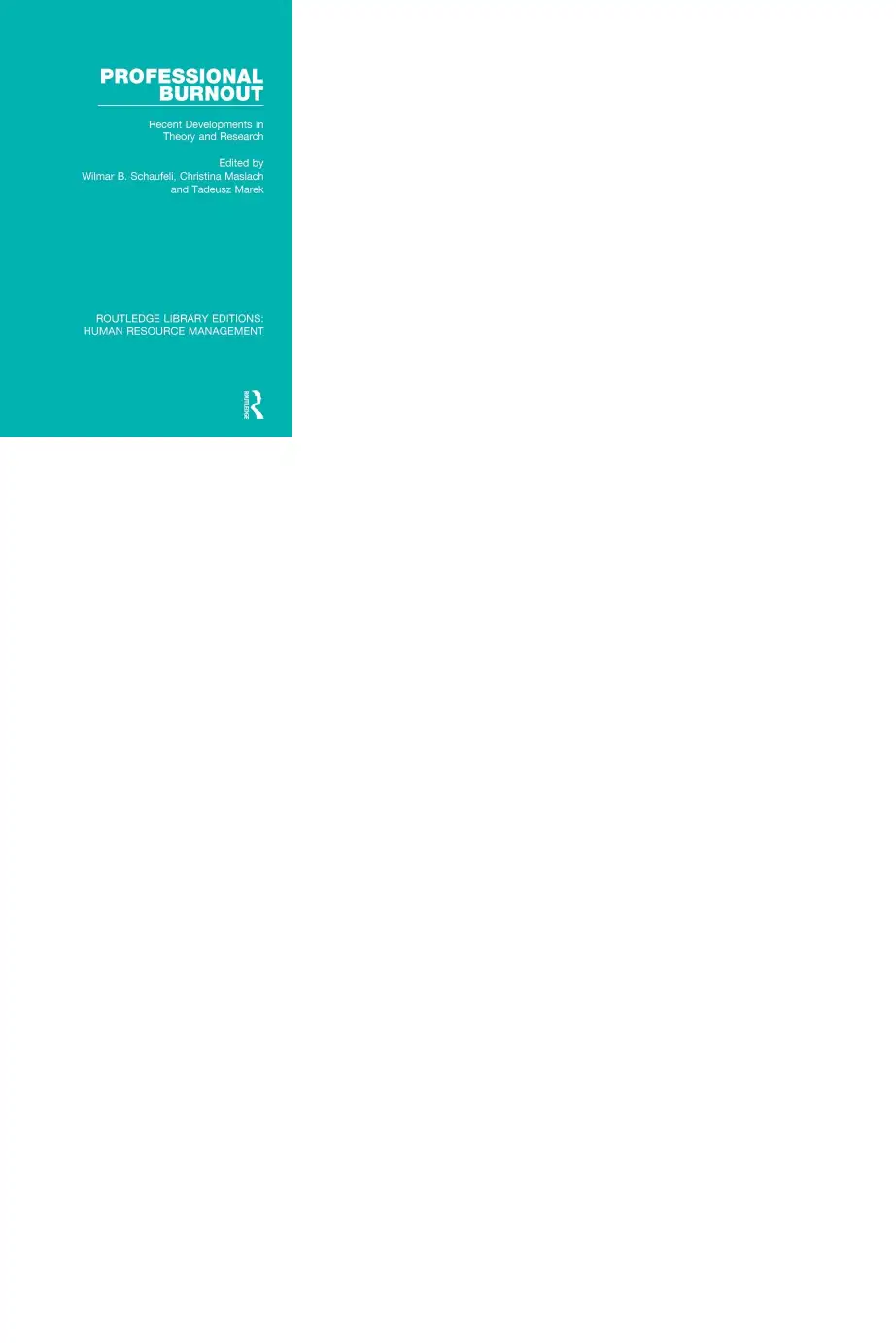
Secure Best Marks with AI Grader
Need help grading? Try our AI Grader for instant feedback on your assignments.
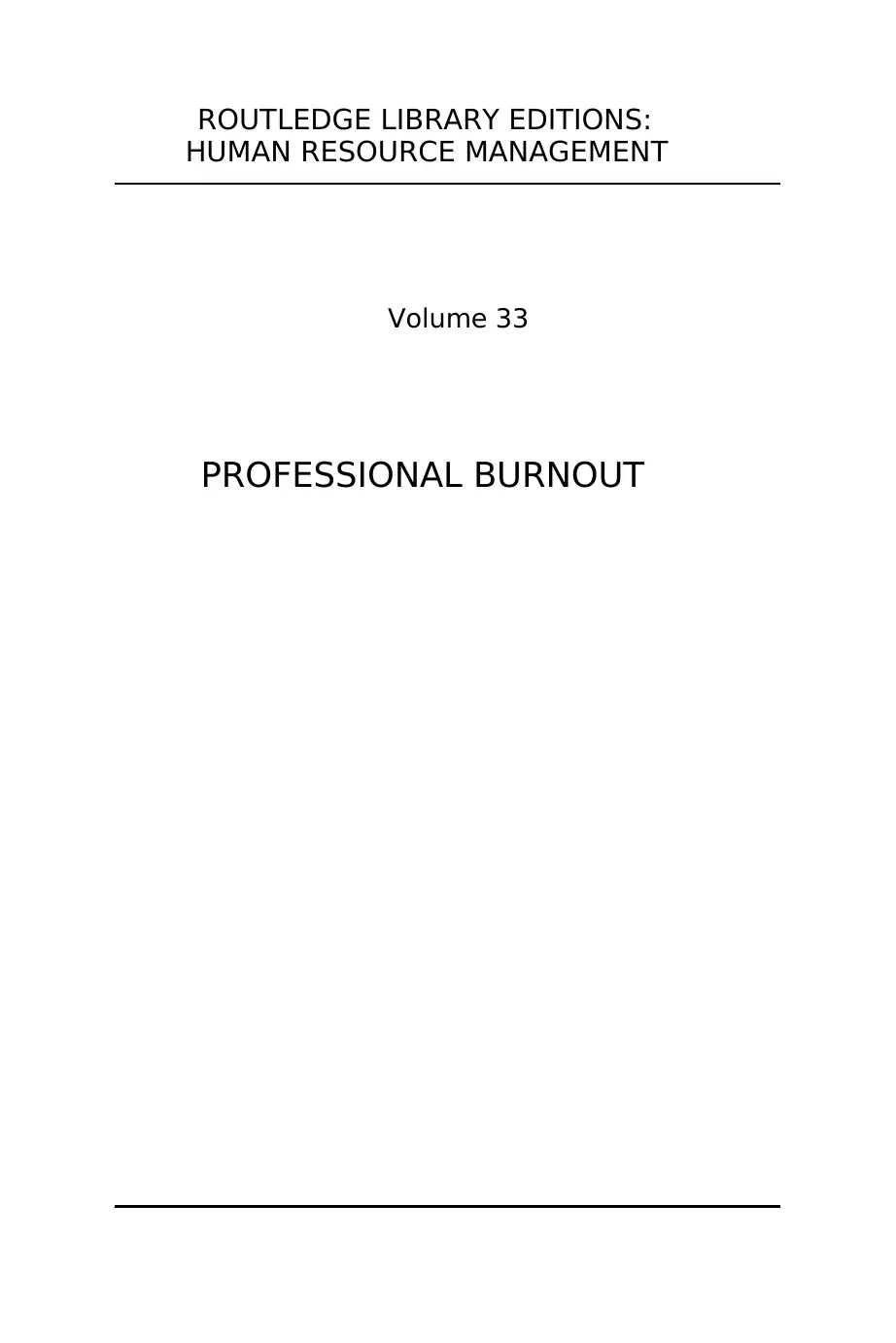
ROUTLEDGE LIBRARY EDITIONS:
HUMAN RESOURCE MANAGEMENT
Volume 33
PROFESSIONAL BURNOUT
HUMAN RESOURCE MANAGEMENT
Volume 33
PROFESSIONAL BURNOUT

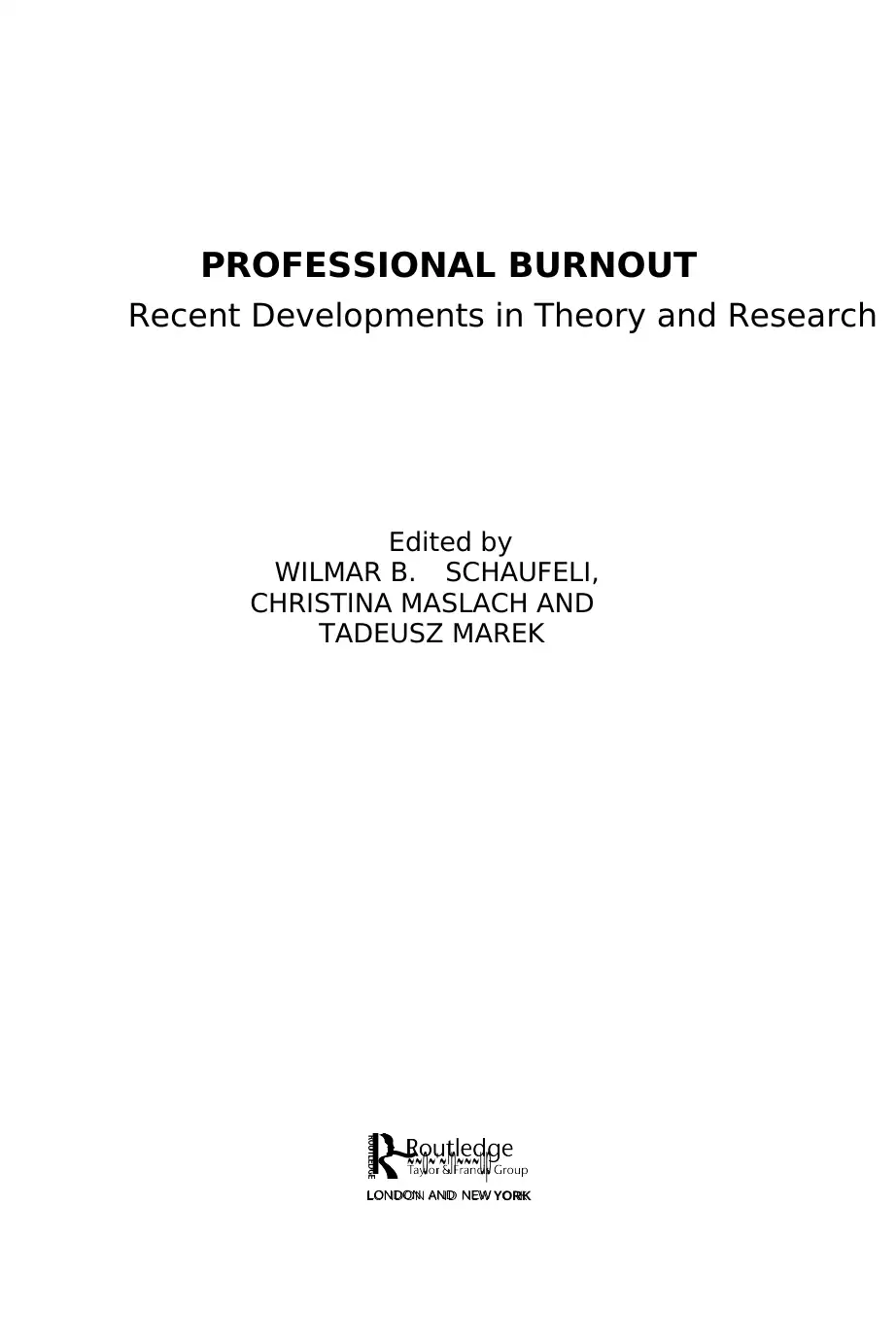
PROFESSIONAL BURNOUT
Recent Developments in Theory and Research
Edited by
WILMAR B. SCHAUFELI,
CHRISTINA MASLACH AND
TADEUSZ MAREK
I~~~o~:~!n~~~up
LONDON AND NEW YORK
Recent Developments in Theory and Research
Edited by
WILMAR B. SCHAUFELI,
CHRISTINA MASLACH AND
TADEUSZ MAREK
I~~~o~:~!n~~~up
LONDON AND NEW YORK
Secure Best Marks with AI Grader
Need help grading? Try our AI Grader for instant feedback on your assignments.
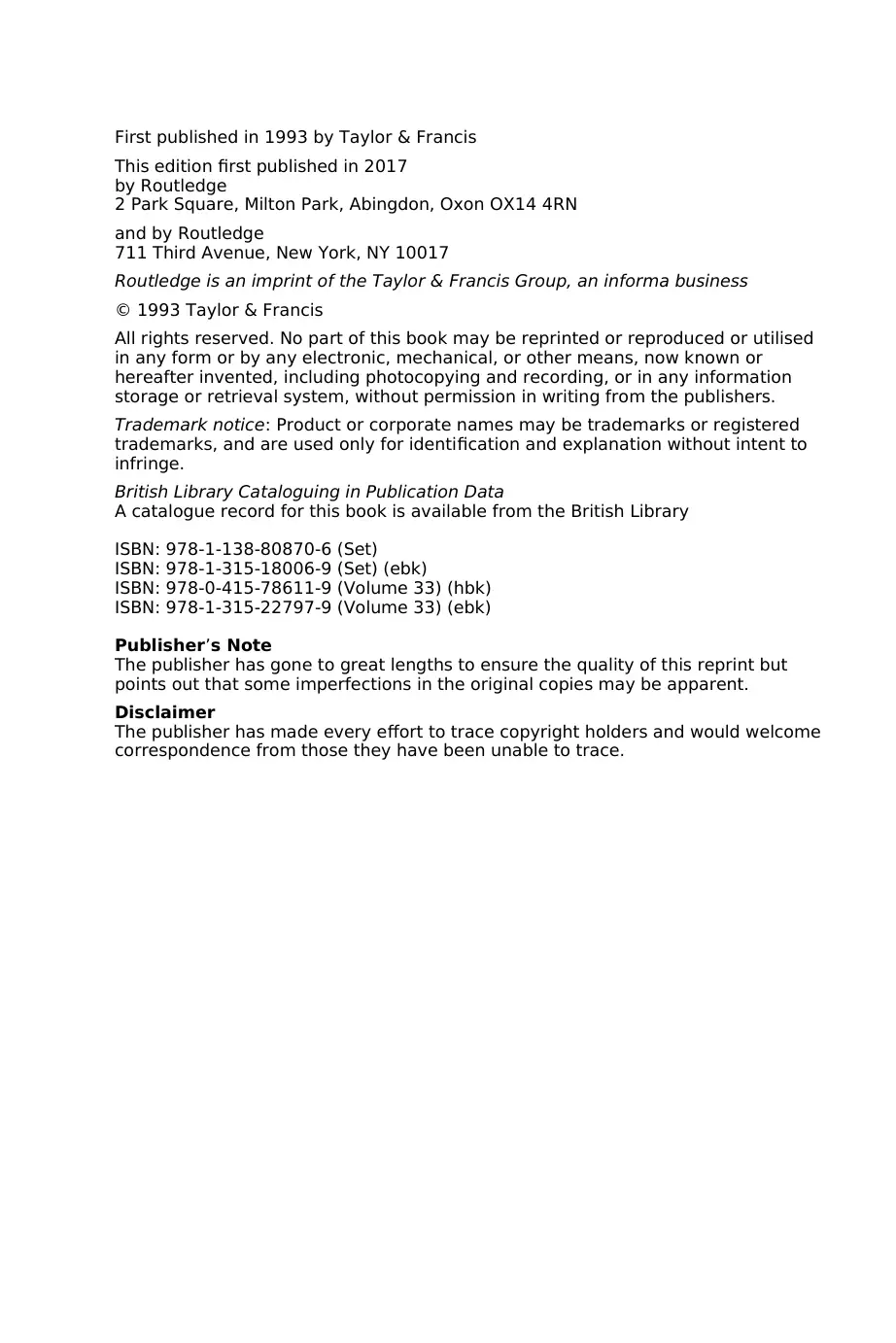
First published in 1993 by Taylor & Francis
This edition first published in 2017
by Routledge
2 Park Square, Milton Park, Abingdon, Oxon OX14 4RN
and by Routledge
711 Third Avenue, New York, NY 10017
Routledge is an imprint of the Taylor & Francis Group, an informa business
© 1993 Taylor & Francis
All rights reserved. No part of this book may be reprinted or reproduced or utilised
in any form or by any electronic, mechanical, or other means, now known or
hereafter invented, including photocopying and recording, or in any information
storage or retrieval system, without permission in writing from the publishers.
Trademark notice: Product or corporate names may be trademarks or registered
trademarks, and are used only for identification and explanation without intent to
infringe.
British Library Cataloguing in Publication Data
A catalogue record for this book is available from the British Library
ISBN: 978-1-138-80870-6 (Set)
ISBN: 978-1-315-18006-9 (Set) (ebk)
ISBN: 978-0-415-78611-9 (Volume 33) (hbk)
ISBN: 978-1-315-22797-9 (Volume 33) (ebk)
Publisher’s Note
The publisher has gone to great lengths to ensure the quality of this reprint but
points out that some imperfections in the original copies may be apparent.
Disclaimer
The publisher has made every effort to trace copyright holders and would welcome
correspondence from those they have been unable to trace.
This edition first published in 2017
by Routledge
2 Park Square, Milton Park, Abingdon, Oxon OX14 4RN
and by Routledge
711 Third Avenue, New York, NY 10017
Routledge is an imprint of the Taylor & Francis Group, an informa business
© 1993 Taylor & Francis
All rights reserved. No part of this book may be reprinted or reproduced or utilised
in any form or by any electronic, mechanical, or other means, now known or
hereafter invented, including photocopying and recording, or in any information
storage or retrieval system, without permission in writing from the publishers.
Trademark notice: Product or corporate names may be trademarks or registered
trademarks, and are used only for identification and explanation without intent to
infringe.
British Library Cataloguing in Publication Data
A catalogue record for this book is available from the British Library
ISBN: 978-1-138-80870-6 (Set)
ISBN: 978-1-315-18006-9 (Set) (ebk)
ISBN: 978-0-415-78611-9 (Volume 33) (hbk)
ISBN: 978-1-315-22797-9 (Volume 33) (ebk)
Publisher’s Note
The publisher has gone to great lengths to ensure the quality of this reprint but
points out that some imperfections in the original copies may be apparent.
Disclaimer
The publisher has made every effort to trace copyright holders and would welcome
correspondence from those they have been unable to trace.
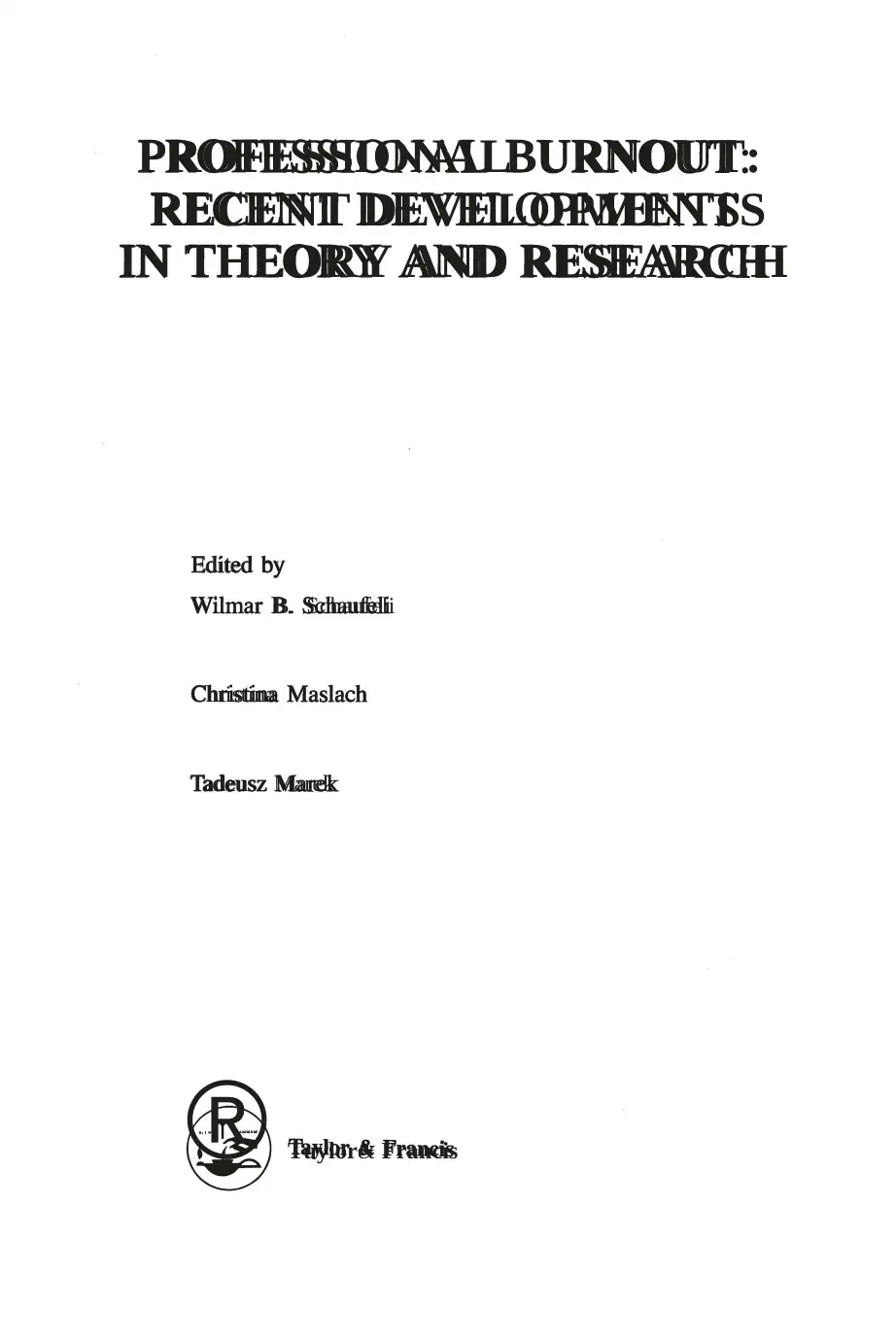
PROFESSIONALBURNOUT:
RECENT DEVELOPMENTS
IN THEORY AND RESEARCH
Edited by
Wilmar B. Schaufeli
Christina Maslach
Tadeusz Marek
® Tuylor& Francis
RECENT DEVELOPMENTS
IN THEORY AND RESEARCH
Edited by
Wilmar B. Schaufeli
Christina Maslach
Tadeusz Marek
® Tuylor& Francis
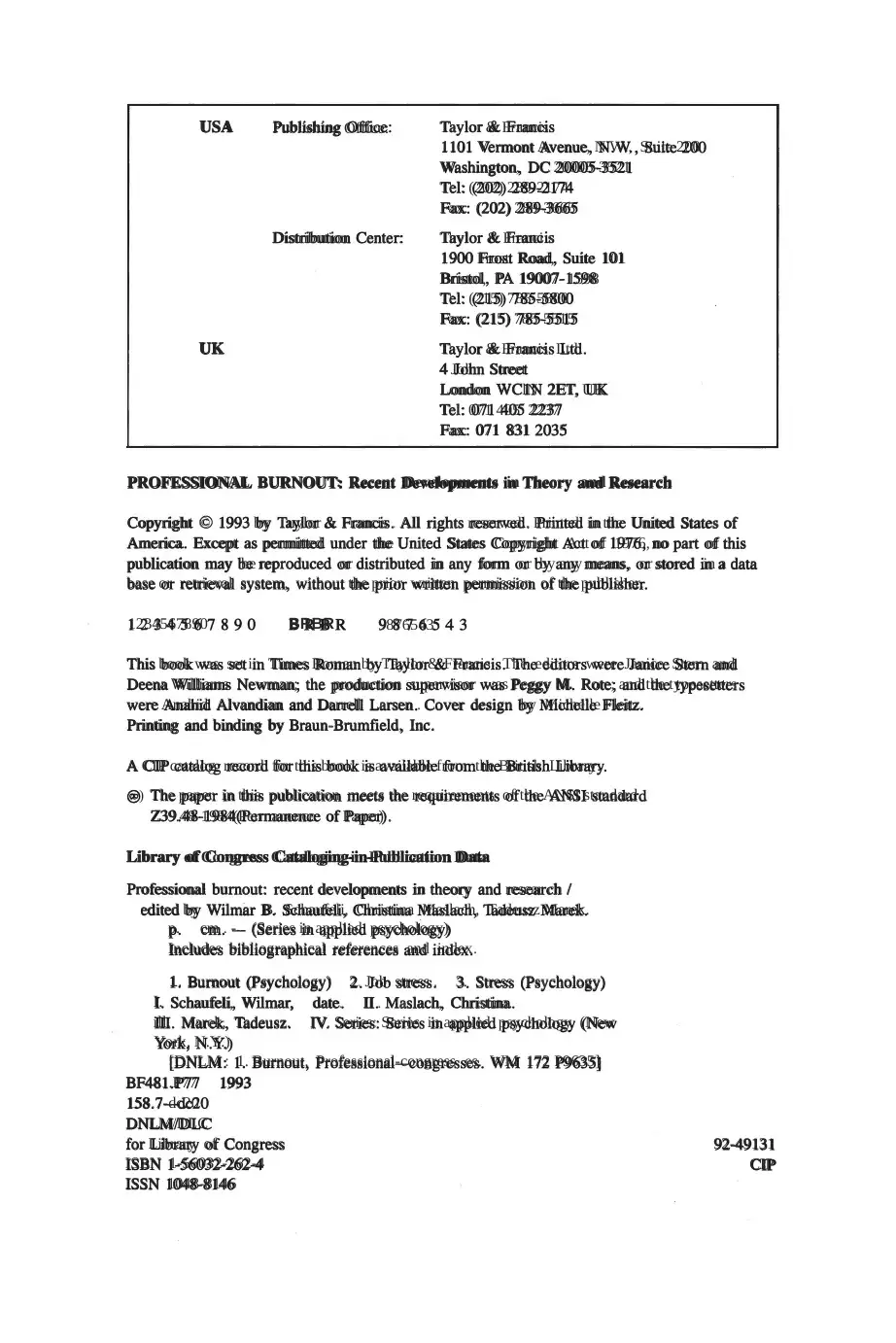
USA Publishing Office:
Distribution Center:
UK
Taylor & Francis
1101 Vermont Avenue, N.W., Suite 200
Washington, DC 20005-3521
Tel: (202) 289-2174
Fax: (202) 289-3665
Tuylor & Franci s
1900 Frost Road, Suite 101
Bristol, PA 19007- 1598
Tel: (215) 785-5800
Fax: (215) 785-5515
Taylor & Francis Ltd.
4 John Street
London WClN 2ET, UK
Tel: 071 405 2237
Fax: 071 831 2035
PROFESSIONAL BURNOUT: Recent Developments in Theory and Research
Copyright © 1993 by Tuylor & Francis . All rights reserved . Printed in the United States of
America. Except as permitted under the United States Copyright Act of 1976, no part of this
publication may be reproduced or distributed in any form or by any means, or stored in a data
base or retrieval system, without the prior written permission of the publisher.
1234567890 BRBR 9876543
This book was set in Times Roman by Taylor & Francis . The editors were Janice Stem and
Deena Williams Newman; the production supervisor was Peggy M. Rote; and the typesetters
were Anahid Alvandian and Darrell Larsen . Cover design by Michelle Fleitz.
Printing and binding by Braun-Brumfield, Inc.
A CIP catalog record for this book is available from the British Library.
@) The paper in this publication meets the requirements of the ANSI standard
Z39.48-1984(Permanence of Paper) .
Library of Congress Cataloging-in-Publication Data
Professional burnout: recent developments in theory and resear ch /
edited by Wilmar B. Schaufeli, Christina Maslach, Tadeusz Marek.
p. cm . - (Series in applied psychology)
Includes bibliographical references and index.
1. Burnout (Psychology) 2. Job stress . 3. Stress (Psychology)
I. Schaufeli, Wilmar, date. II . Maslach, Christina.
ill. Marek, Tadeusz. IV. Series: Series in applied psychology (New
York, N.Y.)
[DNLM : 1. Burnout, Professional-congress es. WM 172 P9635]
BF481.P77 1993
158.7-dc20
DNLM/DLC
for Library of Congress
ISBN 1-56032-262-4
ISSN 1048-8146
92-49131
CIP
Distribution Center:
UK
Taylor & Francis
1101 Vermont Avenue, N.W., Suite 200
Washington, DC 20005-3521
Tel: (202) 289-2174
Fax: (202) 289-3665
Tuylor & Franci s
1900 Frost Road, Suite 101
Bristol, PA 19007- 1598
Tel: (215) 785-5800
Fax: (215) 785-5515
Taylor & Francis Ltd.
4 John Street
London WClN 2ET, UK
Tel: 071 405 2237
Fax: 071 831 2035
PROFESSIONAL BURNOUT: Recent Developments in Theory and Research
Copyright © 1993 by Tuylor & Francis . All rights reserved . Printed in the United States of
America. Except as permitted under the United States Copyright Act of 1976, no part of this
publication may be reproduced or distributed in any form or by any means, or stored in a data
base or retrieval system, without the prior written permission of the publisher.
1234567890 BRBR 9876543
This book was set in Times Roman by Taylor & Francis . The editors were Janice Stem and
Deena Williams Newman; the production supervisor was Peggy M. Rote; and the typesetters
were Anahid Alvandian and Darrell Larsen . Cover design by Michelle Fleitz.
Printing and binding by Braun-Brumfield, Inc.
A CIP catalog record for this book is available from the British Library.
@) The paper in this publication meets the requirements of the ANSI standard
Z39.48-1984(Permanence of Paper) .
Library of Congress Cataloging-in-Publication Data
Professional burnout: recent developments in theory and resear ch /
edited by Wilmar B. Schaufeli, Christina Maslach, Tadeusz Marek.
p. cm . - (Series in applied psychology)
Includes bibliographical references and index.
1. Burnout (Psychology) 2. Job stress . 3. Stress (Psychology)
I. Schaufeli, Wilmar, date. II . Maslach, Christina.
ill. Marek, Tadeusz. IV. Series: Series in applied psychology (New
York, N.Y.)
[DNLM : 1. Burnout, Professional-congress es. WM 172 P9635]
BF481.P77 1993
158.7-dc20
DNLM/DLC
for Library of Congress
ISBN 1-56032-262-4
ISSN 1048-8146
92-49131
CIP
Paraphrase This Document
Need a fresh take? Get an instant paraphrase of this document with our AI Paraphraser
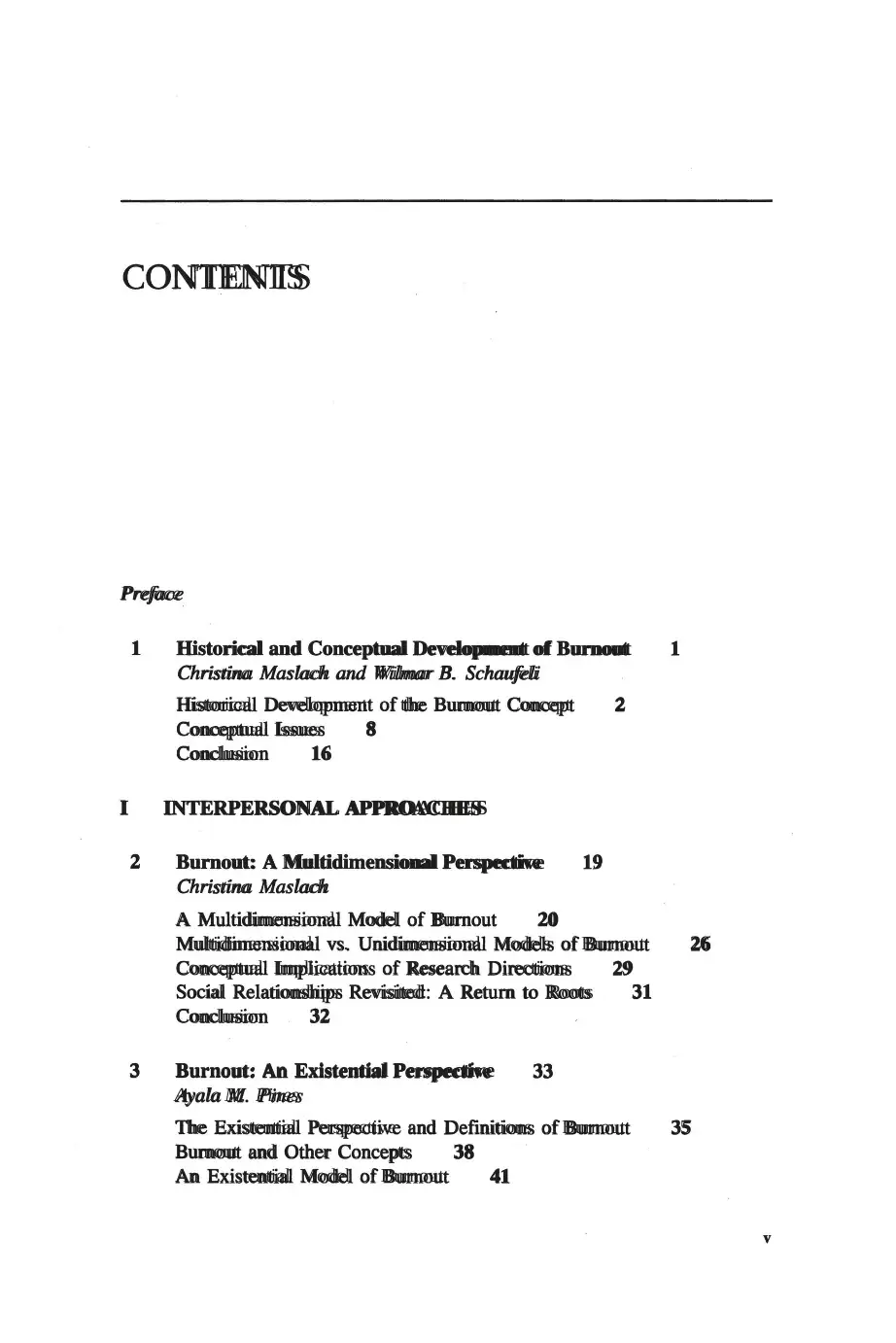
CONTENTS
Preface
1 Historical and Conceptual Development of Burnout
Christina Maslach and Wilmar B. Schaufeli
Historical Development of the Burnout Concept 2
Conceptual Issues 8
Conclusion 16
I INTERPERSONAL APPROACHES
2 Burnout: A Multidimensional Perspective
Christina Maslach
A Multidimensional Model of Burnout 20
19
1
Multidimensional vs. Unidimensional Models of Burnout 26
3
Conceptual Implications of Research Directions 29
Social Relationships Revisited: A Return to Roots 31
Conclusion 32
Burnout: An Existential Perspective
Ayala M. Pines
33
The Existential Perspective and Definitions of Burnout 35
Burnout and Other Concepts 38
An Existential Model of Burnout 41
V
Preface
1 Historical and Conceptual Development of Burnout
Christina Maslach and Wilmar B. Schaufeli
Historical Development of the Burnout Concept 2
Conceptual Issues 8
Conclusion 16
I INTERPERSONAL APPROACHES
2 Burnout: A Multidimensional Perspective
Christina Maslach
A Multidimensional Model of Burnout 20
19
1
Multidimensional vs. Unidimensional Models of Burnout 26
3
Conceptual Implications of Research Directions 29
Social Relationships Revisited: A Return to Roots 31
Conclusion 32
Burnout: An Existential Perspective
Ayala M. Pines
33
The Existential Perspective and Definitions of Burnout 35
Burnout and Other Concepts 38
An Existential Model of Burnout 41
V
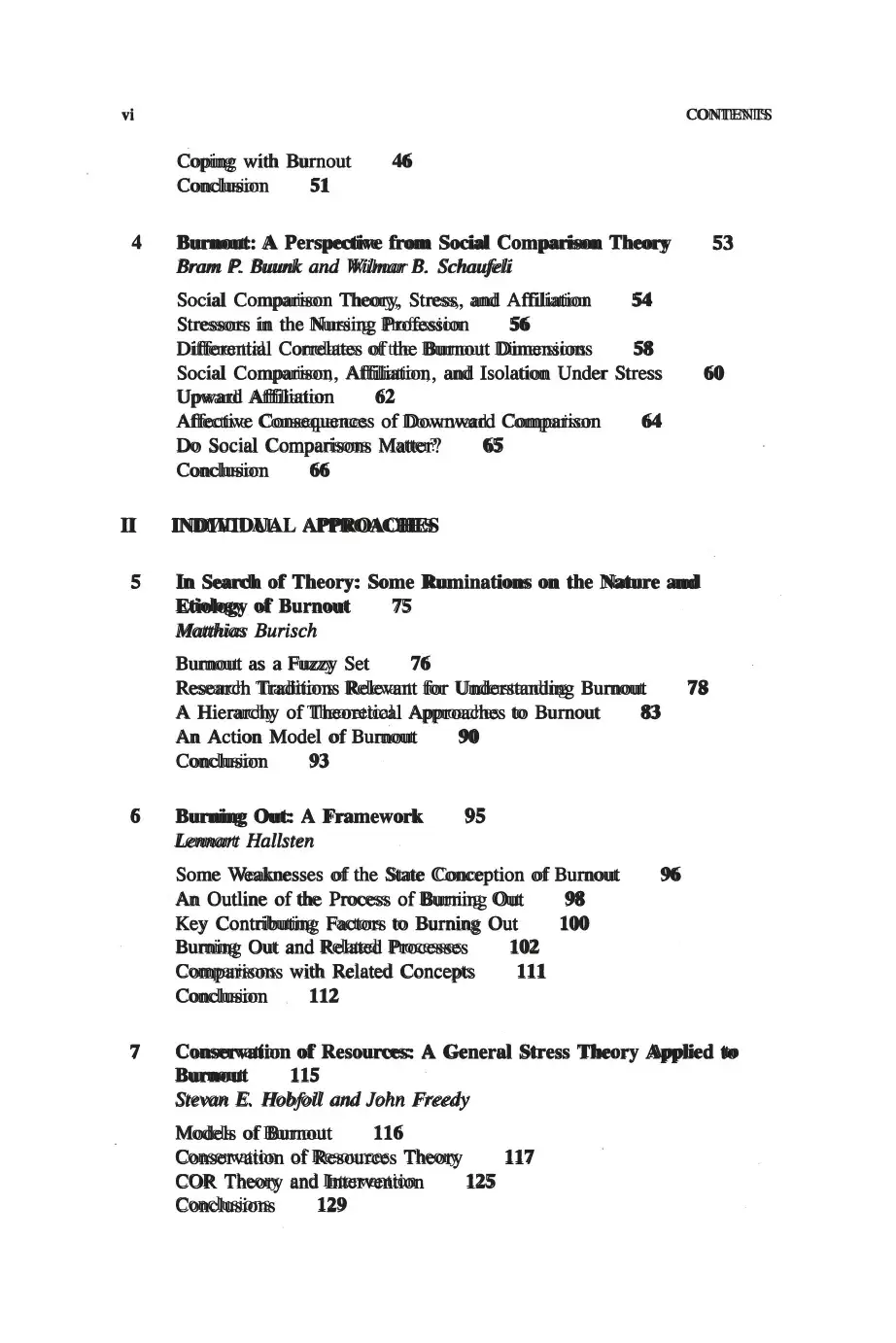
vi
4
Coping with Burnout 46
Conclusion 51
Burnout: A Perspective from Social Comparison Theory
Bram P. Buunk and Wilmar B. Schaufeli
Social Comparison Theory, Stress, and Affiliation 54
Stressors in the Nursing Profession 56
Differential Correlates of the Burnout Dimensions 58
CONTENTS
53
Social Comparison, Affiliation, and Isolation Under Stress 60
Upward Affiliation 62
Affective Consequences of Downward Comparison 64
Do Social Comparisons Matter? 65
Conclusion 66
II INDMDUAL APPROACHES
5 In Search of Theory: Some Ruminations on the Nature and
6
Etiology of Burnout 75
Matthias Burisch
Burnout as a Fuzzy Set 76
Research Traditions Relevant for Understanding Burnout 78
A Hierarchy of Theoretical Approaches to Burnout 83
An Action Model of Burnout 90
Conclusion 93
Burning Out: A Framework
Lennart Hallsten
95
Some Weaknesses of the State Conception of Burnout 96
An Outline of the Process of Burning Out 98
Key Contributing Factors to Burning Out 100
Burning Out and Related Processes 102
Comparisons with Related Concepts 111
Conclusion 112
7 Conservation of Resources: A General Stress Theory Applied to
Burnout 115
Stevan E. Hob/oil and John Freedy
Models of Burnout 116
Conservation of Resources Theory 117
COR Theory and Intervention 125
Conclusions 129
4
Coping with Burnout 46
Conclusion 51
Burnout: A Perspective from Social Comparison Theory
Bram P. Buunk and Wilmar B. Schaufeli
Social Comparison Theory, Stress, and Affiliation 54
Stressors in the Nursing Profession 56
Differential Correlates of the Burnout Dimensions 58
CONTENTS
53
Social Comparison, Affiliation, and Isolation Under Stress 60
Upward Affiliation 62
Affective Consequences of Downward Comparison 64
Do Social Comparisons Matter? 65
Conclusion 66
II INDMDUAL APPROACHES
5 In Search of Theory: Some Ruminations on the Nature and
6
Etiology of Burnout 75
Matthias Burisch
Burnout as a Fuzzy Set 76
Research Traditions Relevant for Understanding Burnout 78
A Hierarchy of Theoretical Approaches to Burnout 83
An Action Model of Burnout 90
Conclusion 93
Burning Out: A Framework
Lennart Hallsten
95
Some Weaknesses of the State Conception of Burnout 96
An Outline of the Process of Burning Out 98
Key Contributing Factors to Burning Out 100
Burning Out and Related Processes 102
Comparisons with Related Concepts 111
Conclusion 112
7 Conservation of Resources: A General Stress Theory Applied to
Burnout 115
Stevan E. Hob/oil and John Freedy
Models of Burnout 116
Conservation of Resources Theory 117
COR Theory and Intervention 125
Conclusions 129
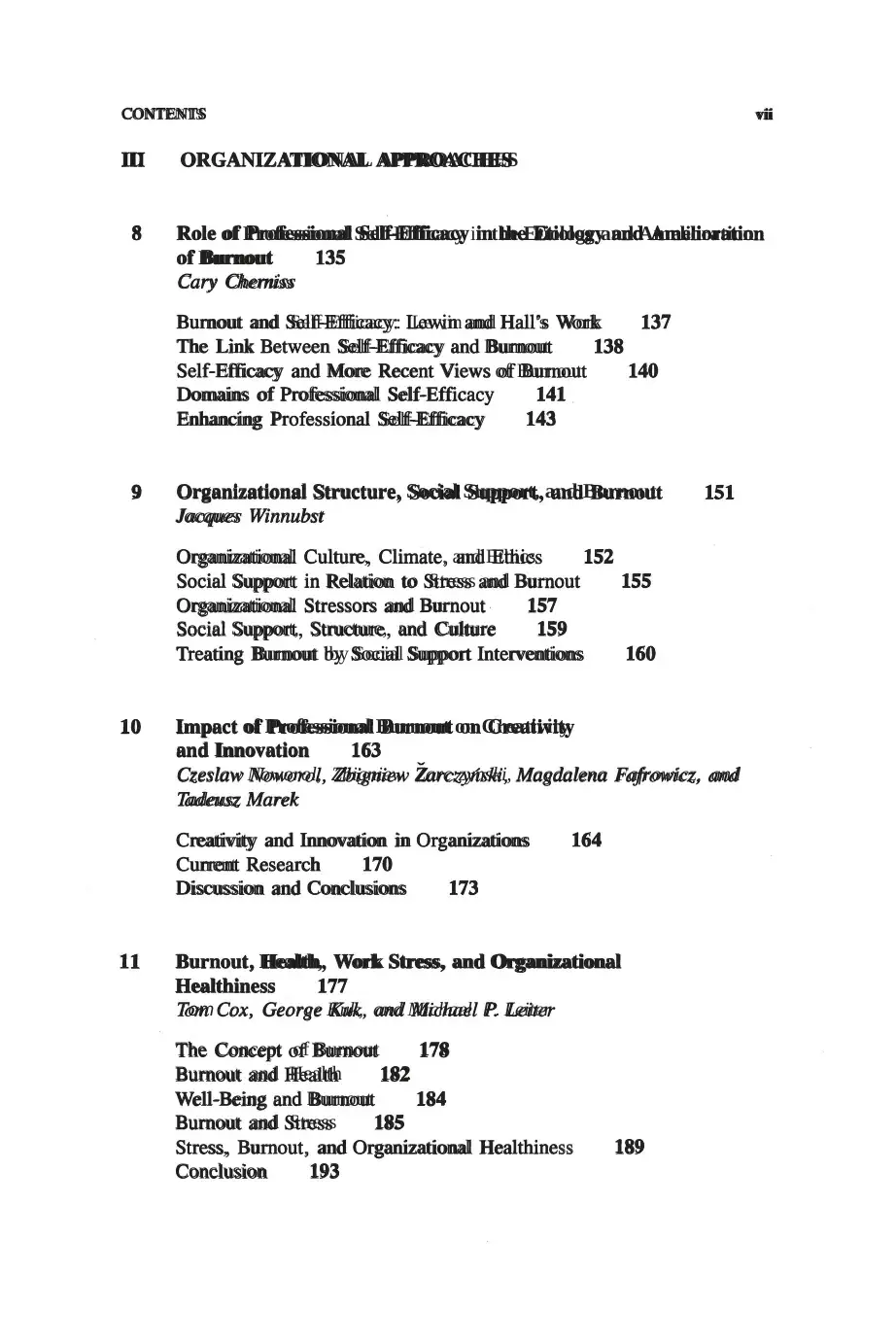
CONTENTS vii
ID ORGANIZATIONAL APPROACHES
8 Role of Professional Self-Efficacy in the Etiology and Amelioration
9
of Burnout 135
Cary Chemiss
Burnout and Self-Efficacy: Lewin and Hall's Work 137
The Link Between Self-Efficacy and Burnout 138
Self-Efficacy and More Recent Views of Burnout 140
Domains of Professional Self-Efficacy 141
Enhancing Professional Self-Efficacy 143
Organizational Structure, Social Support, and Burnout
Jacques Winnubst
Organizational Culture, Climate, and Ethics
Social Support in Relation to Stress and Burnout
Organizational Stressors and Burnout 157
Social Support, Structure, and Culture 159
Treating Burnout by Social Support Interventions
152
155
160
151
10 Impact of Professional Burnout on Creativity
and Innovation 163
Czeslaw Noworol, Zbigniew Zarc:zynski, Magdalena Fafrowicz, and
Tadeusz Marek
Creativity and Innovation in Organizations 164
Current Research 170
Discussion and Conclusions 173
11 Burnout, Health, Work Stress, and Organizational
Healthiness 177
Tom Cox, George Kuk, and Michael P. Leiter
The Concept of Burnout 178
Burnout and Health 182
Well-Being and Burnout 184
Burnout and Stress 185
Stress, Burnout, and Organizational Healthiness 189
Conclusion 193
ID ORGANIZATIONAL APPROACHES
8 Role of Professional Self-Efficacy in the Etiology and Amelioration
9
of Burnout 135
Cary Chemiss
Burnout and Self-Efficacy: Lewin and Hall's Work 137
The Link Between Self-Efficacy and Burnout 138
Self-Efficacy and More Recent Views of Burnout 140
Domains of Professional Self-Efficacy 141
Enhancing Professional Self-Efficacy 143
Organizational Structure, Social Support, and Burnout
Jacques Winnubst
Organizational Culture, Climate, and Ethics
Social Support in Relation to Stress and Burnout
Organizational Stressors and Burnout 157
Social Support, Structure, and Culture 159
Treating Burnout by Social Support Interventions
152
155
160
151
10 Impact of Professional Burnout on Creativity
and Innovation 163
Czeslaw Noworol, Zbigniew Zarc:zynski, Magdalena Fafrowicz, and
Tadeusz Marek
Creativity and Innovation in Organizations 164
Current Research 170
Discussion and Conclusions 173
11 Burnout, Health, Work Stress, and Organizational
Healthiness 177
Tom Cox, George Kuk, and Michael P. Leiter
The Concept of Burnout 178
Burnout and Health 182
Well-Being and Burnout 184
Burnout and Stress 185
Stress, Burnout, and Organizational Healthiness 189
Conclusion 193
Secure Best Marks with AI Grader
Need help grading? Try our AI Grader for instant feedback on your assignments.
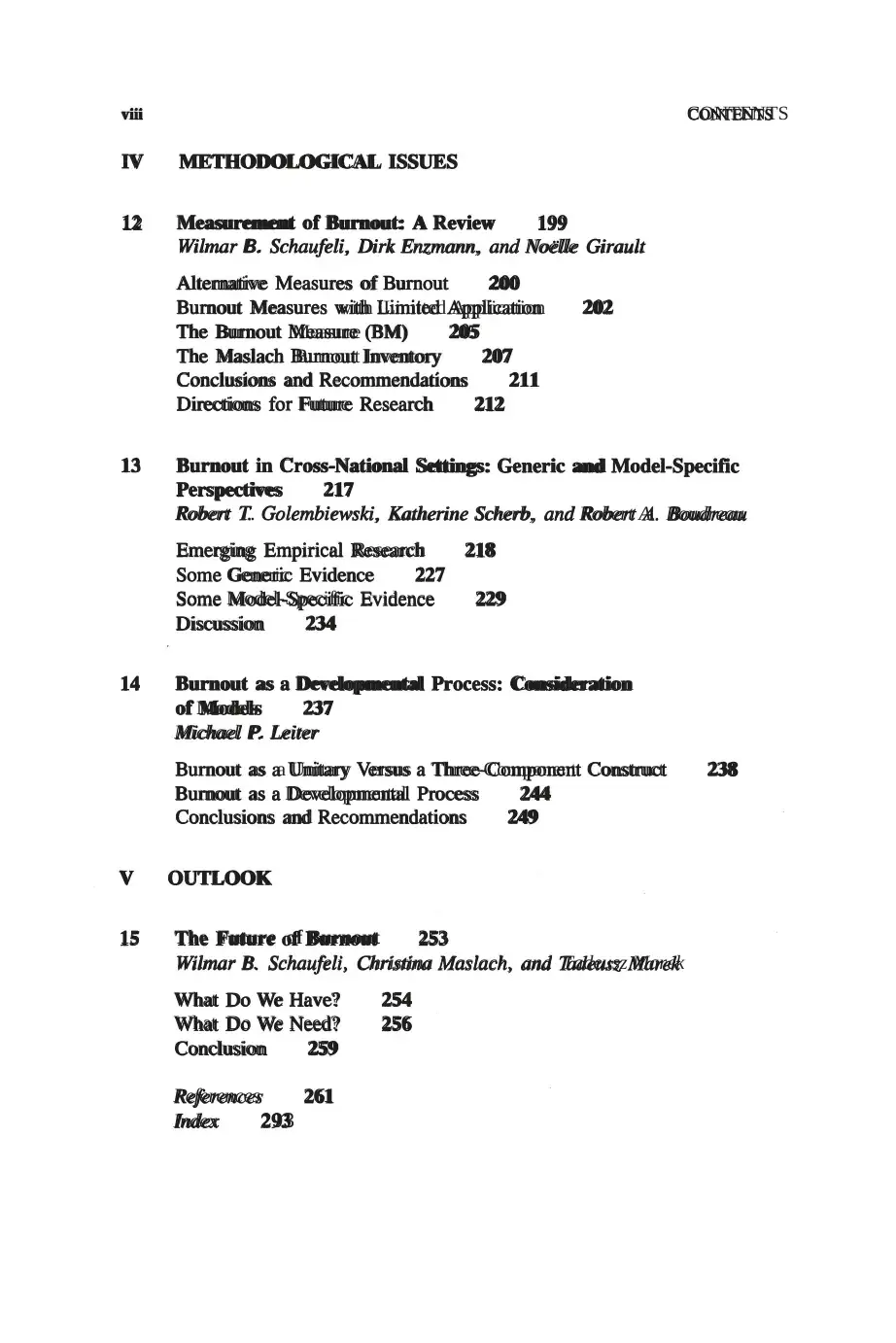
viii CONTENTS
IV METHODOLOGICAL ISSUES
12 Measurement of Burnout: A Review 199
Wilmar B. Schaufeli, Dirk Enzmann, and Noelle Girault
Alternative Measures of Burnout 200
Burnout Measures with Limited Application 202
The Burnout Measure (BM) 205
The Maslach Burnout Inventory 207
Conclusions and Recommendations 211
Directions for Future Research 212
13 Burnout in Cross-National Settings: Generic and Model-Specific
Perspectives 217
Robert T. Golembiewski, Katherine Scherb, and Robert A. Boudreau
Emerging Empirical Research 218
Some Generic Evidence 227
Some Model-Specific Evidence 229
Discussion 234
14 Burnout as a Developmental Process: Consideration
of Models 237
Michael P. Leiter
Burnout as a Unitary Versus a Three-Component Construct 238
Burnout as a Developmental Process 244
Conclusions and Recommendations 249
V OUTLOOK
15 The Future of Burnout 253
Wilmar B. Schaufeli, Christina Maslach, and Tadeusz Marek
What Do We Have? 254
What Do We Need? 256
Conclusion 259
References 261
Index 293
IV METHODOLOGICAL ISSUES
12 Measurement of Burnout: A Review 199
Wilmar B. Schaufeli, Dirk Enzmann, and Noelle Girault
Alternative Measures of Burnout 200
Burnout Measures with Limited Application 202
The Burnout Measure (BM) 205
The Maslach Burnout Inventory 207
Conclusions and Recommendations 211
Directions for Future Research 212
13 Burnout in Cross-National Settings: Generic and Model-Specific
Perspectives 217
Robert T. Golembiewski, Katherine Scherb, and Robert A. Boudreau
Emerging Empirical Research 218
Some Generic Evidence 227
Some Model-Specific Evidence 229
Discussion 234
14 Burnout as a Developmental Process: Consideration
of Models 237
Michael P. Leiter
Burnout as a Unitary Versus a Three-Component Construct 238
Burnout as a Developmental Process 244
Conclusions and Recommendations 249
V OUTLOOK
15 The Future of Burnout 253
Wilmar B. Schaufeli, Christina Maslach, and Tadeusz Marek
What Do We Have? 254
What Do We Need? 256
Conclusion 259
References 261
Index 293
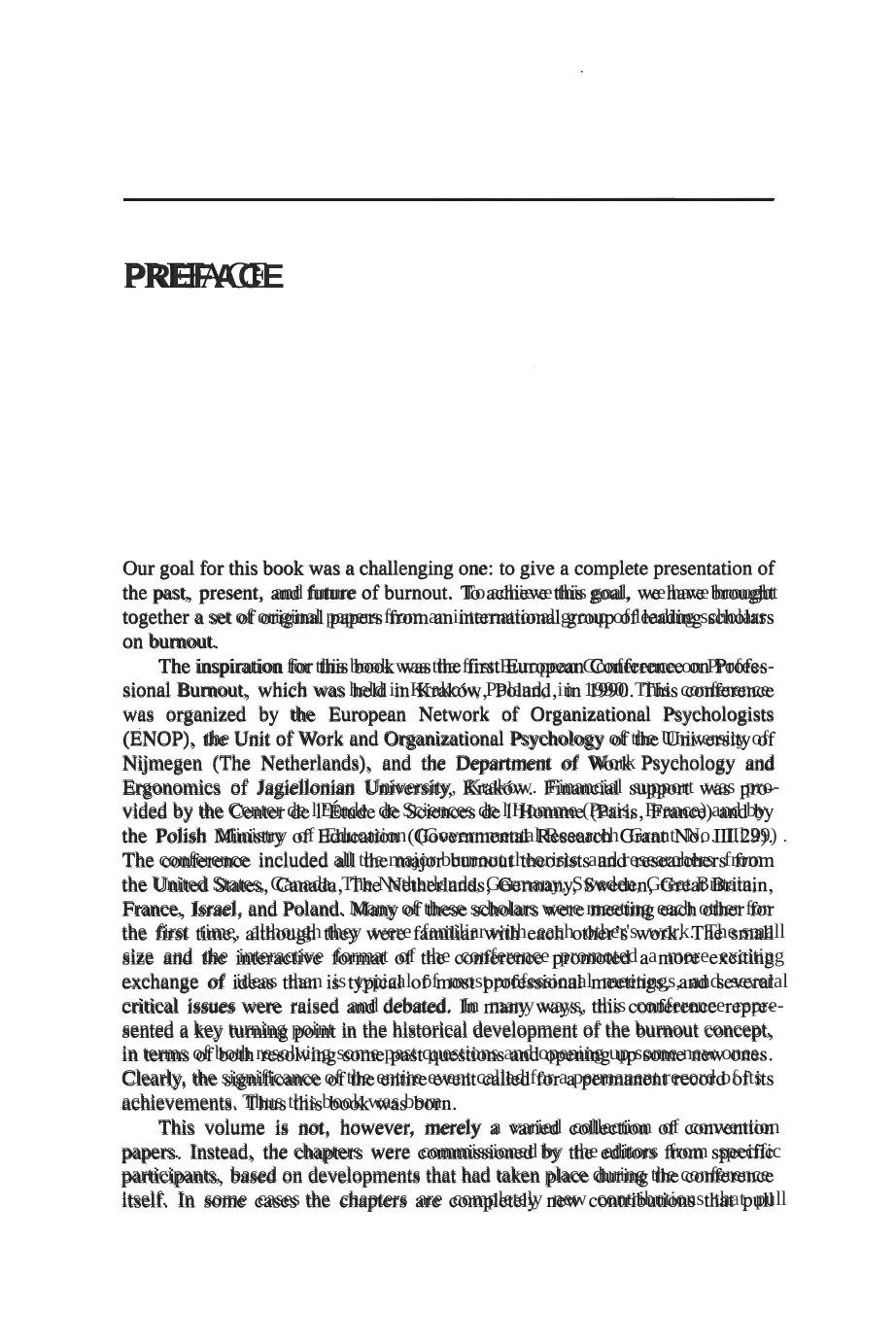
PREFACE
Our goal for this book was a challenging one: to give a complete presentation of
the past, present, and future of burnout. To achieve this goal, we have brought
together a set of original papers from an international group of leading scholars
on burnout.
The inspiration for this book was the first European Conference on Profes-
sional Burnout, which was held in Krakow, Poland, in 1990. This conference
was organized by the European Network of Organizational Psychologists
(ENOP), the Unit of Work and Organizational Psychology of the University of
Nijmegen (The Netherlands), and the Department of Work Psychology and
Ergonomics of Jagiellonian University, Krakow. Financial support was pro-
vided by the Center de l'Etude de Sciences de l'Homme (Paris, France) and by
the Polish Ministry of Education (Governmental Research Grant No. IIl.29) .
The conference included all the major burnout theorists and researchers from
the United States, Canada, The Netherlands, Germany, Sweden, Great Britain,
France, Israel, and Poland. Many of these scholars were meeting each other for
the first time, although they were familiar with each other's work. The small
size and the interactive format of the conference promoted a more exciting
exchange of ideas than is typical of most professional meetings, and several
critical issues were raised and debated. In many ways, this conference repre-
sented a key turning point in the historical development of the burnout concept,
in terms of both resolving some past questions and opening up some new ones.
Clearly, the significance of the entire event called for a permanent record of its
achievements. Thus this book was born.
This volume is not, however, merely a varied collection of convention
papers. Instead, the chapters were commissioned by the editors from specific
participants, based on developments that had taken place during the conference
itself. In some cases the chapters are completely new contributions that pull
Our goal for this book was a challenging one: to give a complete presentation of
the past, present, and future of burnout. To achieve this goal, we have brought
together a set of original papers from an international group of leading scholars
on burnout.
The inspiration for this book was the first European Conference on Profes-
sional Burnout, which was held in Krakow, Poland, in 1990. This conference
was organized by the European Network of Organizational Psychologists
(ENOP), the Unit of Work and Organizational Psychology of the University of
Nijmegen (The Netherlands), and the Department of Work Psychology and
Ergonomics of Jagiellonian University, Krakow. Financial support was pro-
vided by the Center de l'Etude de Sciences de l'Homme (Paris, France) and by
the Polish Ministry of Education (Governmental Research Grant No. IIl.29) .
The conference included all the major burnout theorists and researchers from
the United States, Canada, The Netherlands, Germany, Sweden, Great Britain,
France, Israel, and Poland. Many of these scholars were meeting each other for
the first time, although they were familiar with each other's work. The small
size and the interactive format of the conference promoted a more exciting
exchange of ideas than is typical of most professional meetings, and several
critical issues were raised and debated. In many ways, this conference repre-
sented a key turning point in the historical development of the burnout concept,
in terms of both resolving some past questions and opening up some new ones.
Clearly, the significance of the entire event called for a permanent record of its
achievements. Thus this book was born.
This volume is not, however, merely a varied collection of convention
papers. Instead, the chapters were commissioned by the editors from specific
participants, based on developments that had taken place during the conference
itself. In some cases the chapters are completely new contributions that pull
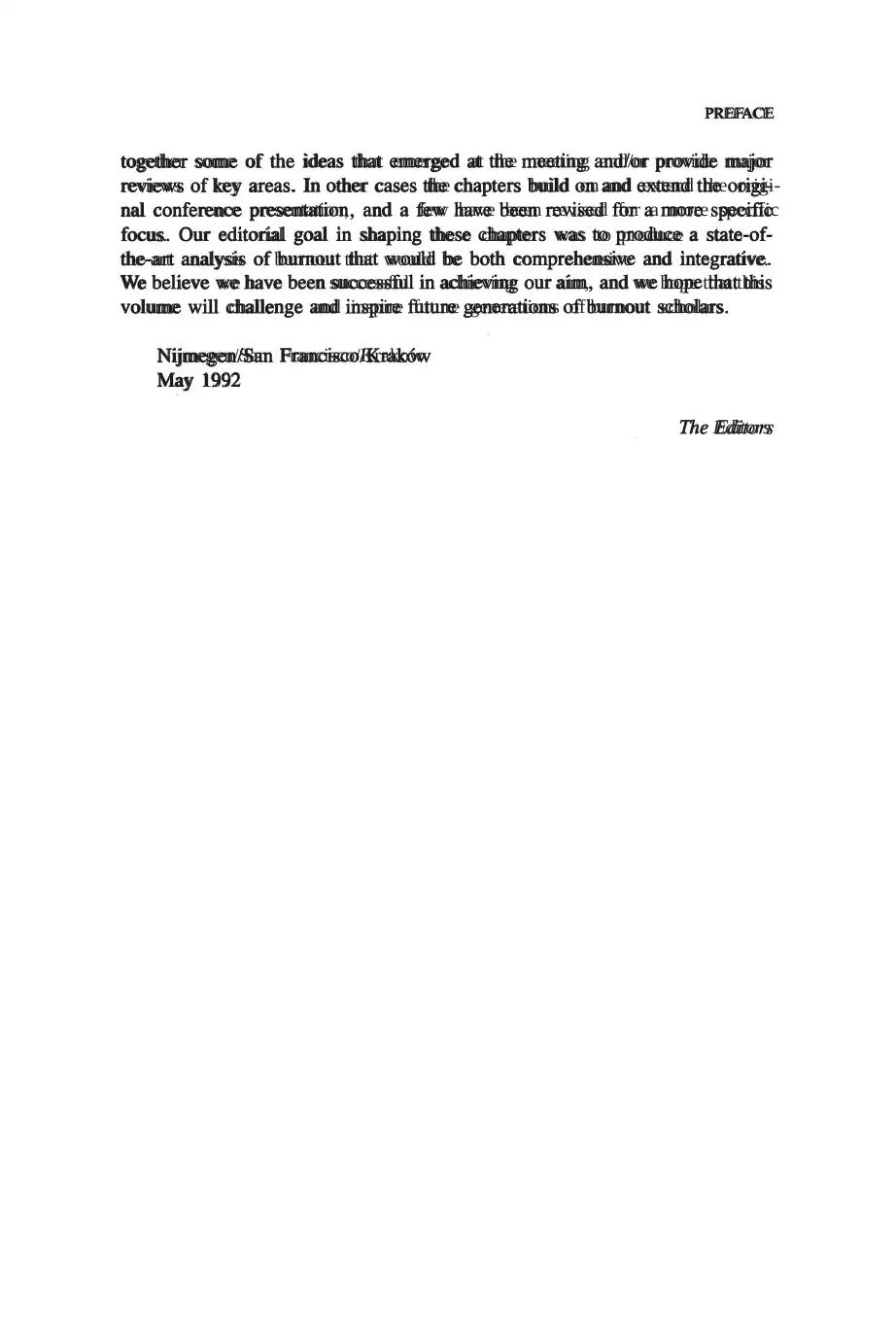
PREFACE
together some of the ideas that emerged at the meeting and/or provide major
reviews of key areas. In other cases the chapters build on and extend the origi-
nal conference presentation, and a few have been revised for a more specific
focus. Our editorial goal in shaping these chapters was to produce a state-of-
the-art analysis of burnout that would be both comprehensive and integrative.
We believe we have been successful in achieving our aim, and we hope that this
volume will challenge and inspire future generations of burnout scholars.
Nijmegen/San Francisco/Krakow
May 1992
The Editors
together some of the ideas that emerged at the meeting and/or provide major
reviews of key areas. In other cases the chapters build on and extend the origi-
nal conference presentation, and a few have been revised for a more specific
focus. Our editorial goal in shaping these chapters was to produce a state-of-
the-art analysis of burnout that would be both comprehensive and integrative.
We believe we have been successful in achieving our aim, and we hope that this
volume will challenge and inspire future generations of burnout scholars.
Nijmegen/San Francisco/Krakow
May 1992
The Editors
Paraphrase This Document
Need a fresh take? Get an instant paraphrase of this document with our AI Paraphraser
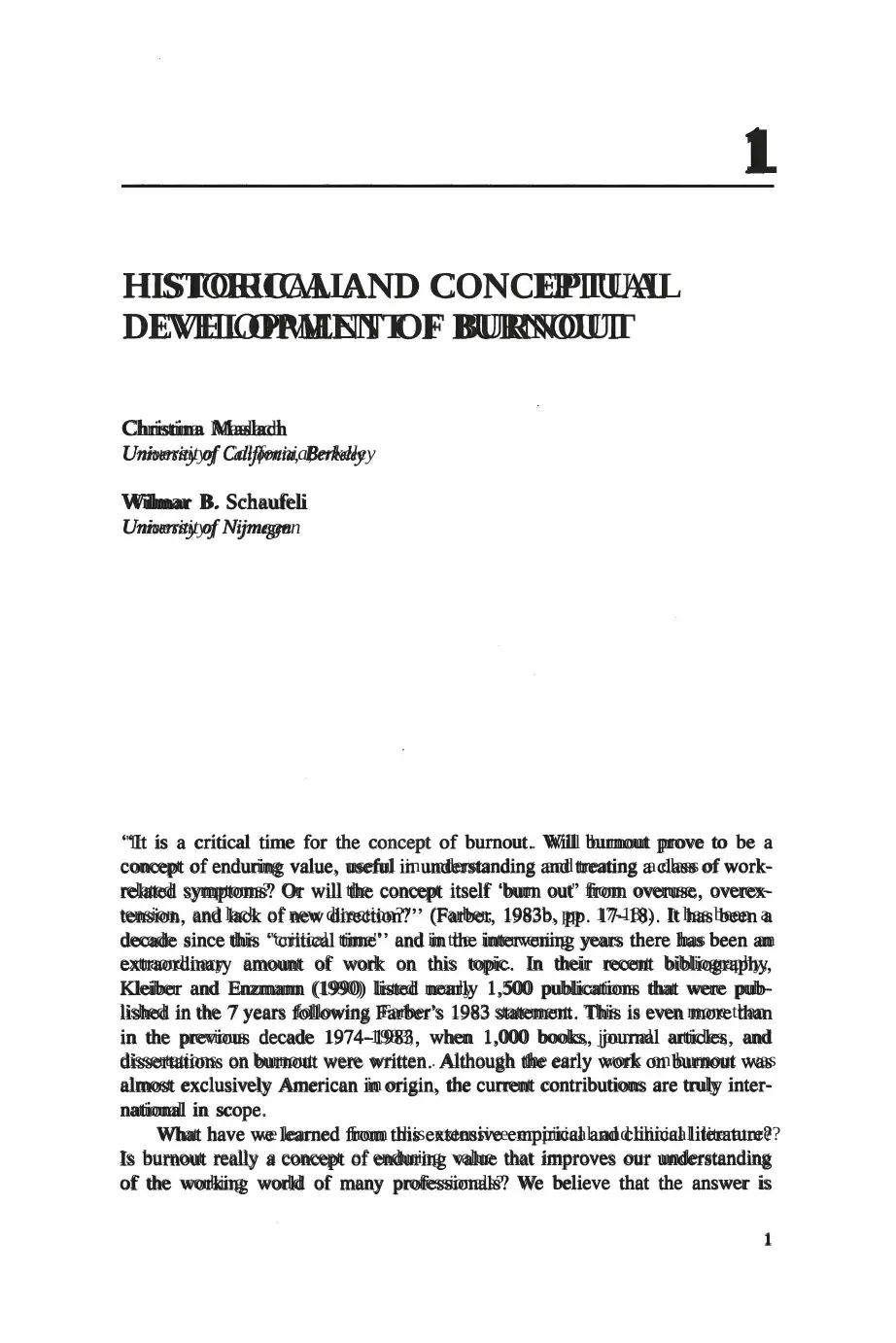
HISTORICALAND CONCEPTUAL
DEVELOPMENTOF BURNOUT
Christina Maslach
Universityof California,Berkeley
Wilmar B. Schaufeli
Universityof Nijmegen
1
"It is a critical time for the concept of burnout . Will burnout prove to be a
concept of enduring value, useful in understanding and treating a class of work-
related symptoms? Or will the concept itself 'bum out' from overuse, overex-
tension, and lack of new direction?" (Farber, 1983b, pp. 17-18). It has been a
decade since this "critical time" and in the intervening years there has been an
extraordinary amount of work on this topic. In their recent bibliography,
Kleiber and Enzmann (1990) listed nearly 1,500 publications that were pub-
lished in the 7 years following Farber's 1983 statement. This is even more than
in the previous decade 1974-1983, when 1,000 books, journal articles, and
dissertations on burnout were written . Although the early work on burnout was
almost exclusively American in origin, the current contributions are truly inter-
national in scope.
What have we learned from this extensive empirical and clinical literature?
Is burnout really a concept of enduring value that improves our understanding
of the working world of many professionals? We believe that the answer is
1
DEVELOPMENTOF BURNOUT
Christina Maslach
Universityof California,Berkeley
Wilmar B. Schaufeli
Universityof Nijmegen
1
"It is a critical time for the concept of burnout . Will burnout prove to be a
concept of enduring value, useful in understanding and treating a class of work-
related symptoms? Or will the concept itself 'bum out' from overuse, overex-
tension, and lack of new direction?" (Farber, 1983b, pp. 17-18). It has been a
decade since this "critical time" and in the intervening years there has been an
extraordinary amount of work on this topic. In their recent bibliography,
Kleiber and Enzmann (1990) listed nearly 1,500 publications that were pub-
lished in the 7 years following Farber's 1983 statement. This is even more than
in the previous decade 1974-1983, when 1,000 books, journal articles, and
dissertations on burnout were written . Although the early work on burnout was
almost exclusively American in origin, the current contributions are truly inter-
national in scope.
What have we learned from this extensive empirical and clinical literature?
Is burnout really a concept of enduring value that improves our understanding
of the working world of many professionals? We believe that the answer is
1
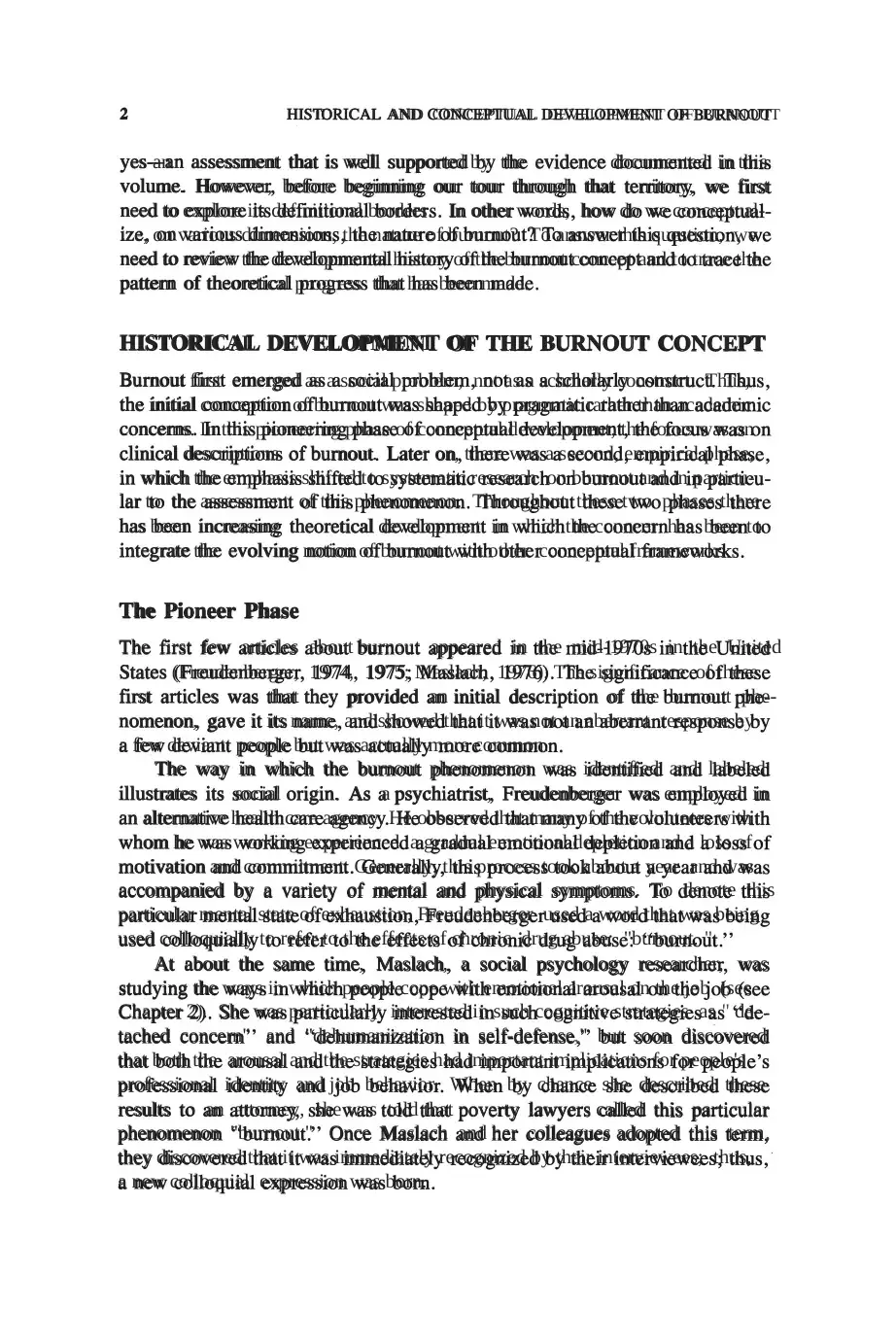
2 HIS'IDRICAL AND CONCEPTUAL DEVELOPMENT OF BURNOUT
yes-an assessment that is well supported by the evidence documented in this
volume. However, before beginning our tour through that territory, we first
need to explore its definitional borders. In other words, how do we conceptual-
ize, on various dimensions, the nature of burnout? To answer this question, we
need to review the developmental history of the burnout concept and to trace the
pattern of theoretical progress that has been made.
HISTORICAL DEVELOPMENT OF THE BURNOUT CONCEPT
Burnout first emerged as a social problem, not as a scholarly construct. Thus,
the initial conception of burnout was shaped by pragmatic rather than academic
concerns. In this pioneering phase of conceptual development, the focus was on
clinical descriptions of burnout. Later on, there was a second, empirical phase,
in which the emphasis shifted to systematic research on burnout and in particu-
lar to the assessment of this phenomenon. Throughout these two phases there
has been increasing theoretical development in which the concern has been to
integrate the evolving notion of burnout with other conceptual frameworks .
The Pioneer Phase
The first few articles about burnout appeared in the mid-1970s in the United
States (Freudenberger, 1974, 1975; Maslach, 1976). The significance of these
first articles was that they provided an initial description of the burnout phe-
nomenon, gave it its name, and showed that it was not an aberrant response by
a few deviant people but was actually more common.
The way in which the burnout phenomenon was identified and labeled
illustrates its social origin. As a psychiatrist, Freudenberger was employed in
an alternative health care agency. He observed that many of the volunteers with
whom he was working experienced a gradual emotional depletion and a loss of
motivation and commitment. Generally, this process took about a year and was
accompanied by a variety of mental and physical symptoms. To denote this
particular mental state of exhaustion, Freudenberger used a word that was being
used colloquially to refer to the effects of chronic drug abuse: "burnout. "
At about the same time, Maslach, a social psychology researcher, was
studying the ways in which people cope with emotional arousal on the job (see
Chapter 2). She was particularly interested in such cognitive strategies as " de-
tached concern" and "dehumanization in self-defense," but soon discovered
that both the arousal and the strategies had important implications for people's
professional identity and job behavior. When by chance she described these
results to an attorney, she was told that poverty lawyers called this particular
phenomenon "burnout." Once Maslach and her colleagues adopted this term,
they discovered that it was immediately recognized by their interviewees; thus,
a new colloquial expression was born.
yes-an assessment that is well supported by the evidence documented in this
volume. However, before beginning our tour through that territory, we first
need to explore its definitional borders. In other words, how do we conceptual-
ize, on various dimensions, the nature of burnout? To answer this question, we
need to review the developmental history of the burnout concept and to trace the
pattern of theoretical progress that has been made.
HISTORICAL DEVELOPMENT OF THE BURNOUT CONCEPT
Burnout first emerged as a social problem, not as a scholarly construct. Thus,
the initial conception of burnout was shaped by pragmatic rather than academic
concerns. In this pioneering phase of conceptual development, the focus was on
clinical descriptions of burnout. Later on, there was a second, empirical phase,
in which the emphasis shifted to systematic research on burnout and in particu-
lar to the assessment of this phenomenon. Throughout these two phases there
has been increasing theoretical development in which the concern has been to
integrate the evolving notion of burnout with other conceptual frameworks .
The Pioneer Phase
The first few articles about burnout appeared in the mid-1970s in the United
States (Freudenberger, 1974, 1975; Maslach, 1976). The significance of these
first articles was that they provided an initial description of the burnout phe-
nomenon, gave it its name, and showed that it was not an aberrant response by
a few deviant people but was actually more common.
The way in which the burnout phenomenon was identified and labeled
illustrates its social origin. As a psychiatrist, Freudenberger was employed in
an alternative health care agency. He observed that many of the volunteers with
whom he was working experienced a gradual emotional depletion and a loss of
motivation and commitment. Generally, this process took about a year and was
accompanied by a variety of mental and physical symptoms. To denote this
particular mental state of exhaustion, Freudenberger used a word that was being
used colloquially to refer to the effects of chronic drug abuse: "burnout. "
At about the same time, Maslach, a social psychology researcher, was
studying the ways in which people cope with emotional arousal on the job (see
Chapter 2). She was particularly interested in such cognitive strategies as " de-
tached concern" and "dehumanization in self-defense," but soon discovered
that both the arousal and the strategies had important implications for people's
professional identity and job behavior. When by chance she described these
results to an attorney, she was told that poverty lawyers called this particular
phenomenon "burnout." Once Maslach and her colleagues adopted this term,
they discovered that it was immediately recognized by their interviewees; thus,
a new colloquial expression was born.
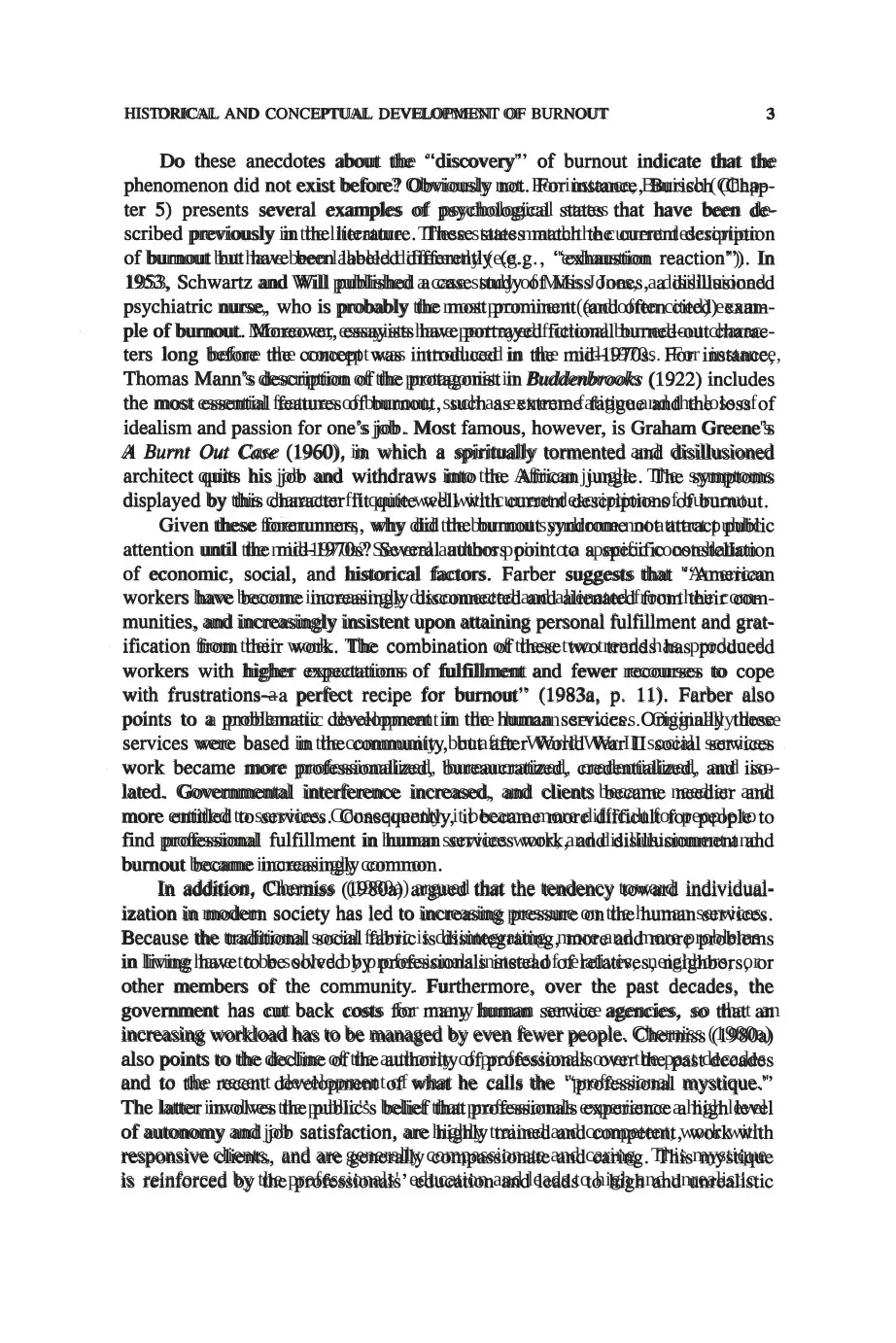
HIS1DRICAL AND CONCEPTUAL DEVELOPMENT OF BURNOUT 3
Do these anecdotes about the "discovery" of burnout indicate that the
phenomenon did not exist before? Obviously not. For instance, Burisch (Chap-
ter 5) presents several examples of psychological states that have been de-
scribed previously in the literature. These states match the current description
of burnout but have been labeled differently (e.g., "exhaustion reaction"). In
1953, Schwartz and Will published a case study of Miss Jones, a disillusioned
psychiatric nurse, who is probably the most prominent (and often cited) exam-
ple of burnout. Moreover, essayists have portrayed fictional burned-out charac-
ters long before the concept was introduced in the mid-1970s. For instance,
Thomas Mann's description of the protagonist in Buddenbrooks (1922) includes
the most essential features of burnout, such as extreme fatigue and the loss of
idealism and passion for one's job . Most famous, however, is Graham Greene's
A Burnt Out Case (1960), in which a spiritually tormented and disillusioned
architect quits his job and withdraws into the African jungle. The symptoms
displayed by this character fit quite well with current descriptions of burnout.
Given these forerunners, why did the burnout syndrome not attract public
attention until the mid-1970s? Several authors point to a specific constellation
of economic, social, and historical factors. Farber suggests that "American
workers have become increasingly disconnected and alienated from their com-
munities, and increasingly insistent upon attaining personal fulfillment and grat-
ification from their work. The combination of these two trends has produced
workers with higher expectations of fulfillment and fewer recourses to cope
with frustrations-a perfect recipe for burnout" (1983a, p. 11). Farber also
points to a problematic development in the human services. Originally these
services were based in the community, but after World War II social services
work became more professionalized, bureaucratized, credentialized, and iso-
lated. Governmental interference increased, and clients became needier and
more entitled to services. Consequently, it became more difficult for people to
find professional fulfillment in human services work, and disillusionment and
burnout became increasingly common.
In addition, Chemiss (1980a) argued that the tendency toward individual-
ization in modem society has led to increasing pressure on the human services.
Because the traditional social fabric is disintegrating, more and more problems
in living have to be solved by professionals instead of relatives, neighbors, or
other members of the community. Furthermore, over the past decades, the
government has cut back costs for many human service agencies, so that an
increasing workload has to be managed by even fewer people. Cherniss (1980a)
also points to the decline of the authority of professionals over the past decades
and to the recent development of what he calls the "professional mystique."
The latter involves the public's belief that professionals experience a high level
of autonomy and job satisfaction, are highly trained and competent, work with
responsive clients, and are generally compassionate and caring. This mystique
is reinforced by the professionals' education and leads to high and unrealistic
Do these anecdotes about the "discovery" of burnout indicate that the
phenomenon did not exist before? Obviously not. For instance, Burisch (Chap-
ter 5) presents several examples of psychological states that have been de-
scribed previously in the literature. These states match the current description
of burnout but have been labeled differently (e.g., "exhaustion reaction"). In
1953, Schwartz and Will published a case study of Miss Jones, a disillusioned
psychiatric nurse, who is probably the most prominent (and often cited) exam-
ple of burnout. Moreover, essayists have portrayed fictional burned-out charac-
ters long before the concept was introduced in the mid-1970s. For instance,
Thomas Mann's description of the protagonist in Buddenbrooks (1922) includes
the most essential features of burnout, such as extreme fatigue and the loss of
idealism and passion for one's job . Most famous, however, is Graham Greene's
A Burnt Out Case (1960), in which a spiritually tormented and disillusioned
architect quits his job and withdraws into the African jungle. The symptoms
displayed by this character fit quite well with current descriptions of burnout.
Given these forerunners, why did the burnout syndrome not attract public
attention until the mid-1970s? Several authors point to a specific constellation
of economic, social, and historical factors. Farber suggests that "American
workers have become increasingly disconnected and alienated from their com-
munities, and increasingly insistent upon attaining personal fulfillment and grat-
ification from their work. The combination of these two trends has produced
workers with higher expectations of fulfillment and fewer recourses to cope
with frustrations-a perfect recipe for burnout" (1983a, p. 11). Farber also
points to a problematic development in the human services. Originally these
services were based in the community, but after World War II social services
work became more professionalized, bureaucratized, credentialized, and iso-
lated. Governmental interference increased, and clients became needier and
more entitled to services. Consequently, it became more difficult for people to
find professional fulfillment in human services work, and disillusionment and
burnout became increasingly common.
In addition, Chemiss (1980a) argued that the tendency toward individual-
ization in modem society has led to increasing pressure on the human services.
Because the traditional social fabric is disintegrating, more and more problems
in living have to be solved by professionals instead of relatives, neighbors, or
other members of the community. Furthermore, over the past decades, the
government has cut back costs for many human service agencies, so that an
increasing workload has to be managed by even fewer people. Cherniss (1980a)
also points to the decline of the authority of professionals over the past decades
and to the recent development of what he calls the "professional mystique."
The latter involves the public's belief that professionals experience a high level
of autonomy and job satisfaction, are highly trained and competent, work with
responsive clients, and are generally compassionate and caring. This mystique
is reinforced by the professionals' education and leads to high and unrealistic
Secure Best Marks with AI Grader
Need help grading? Try our AI Grader for instant feedback on your assignments.
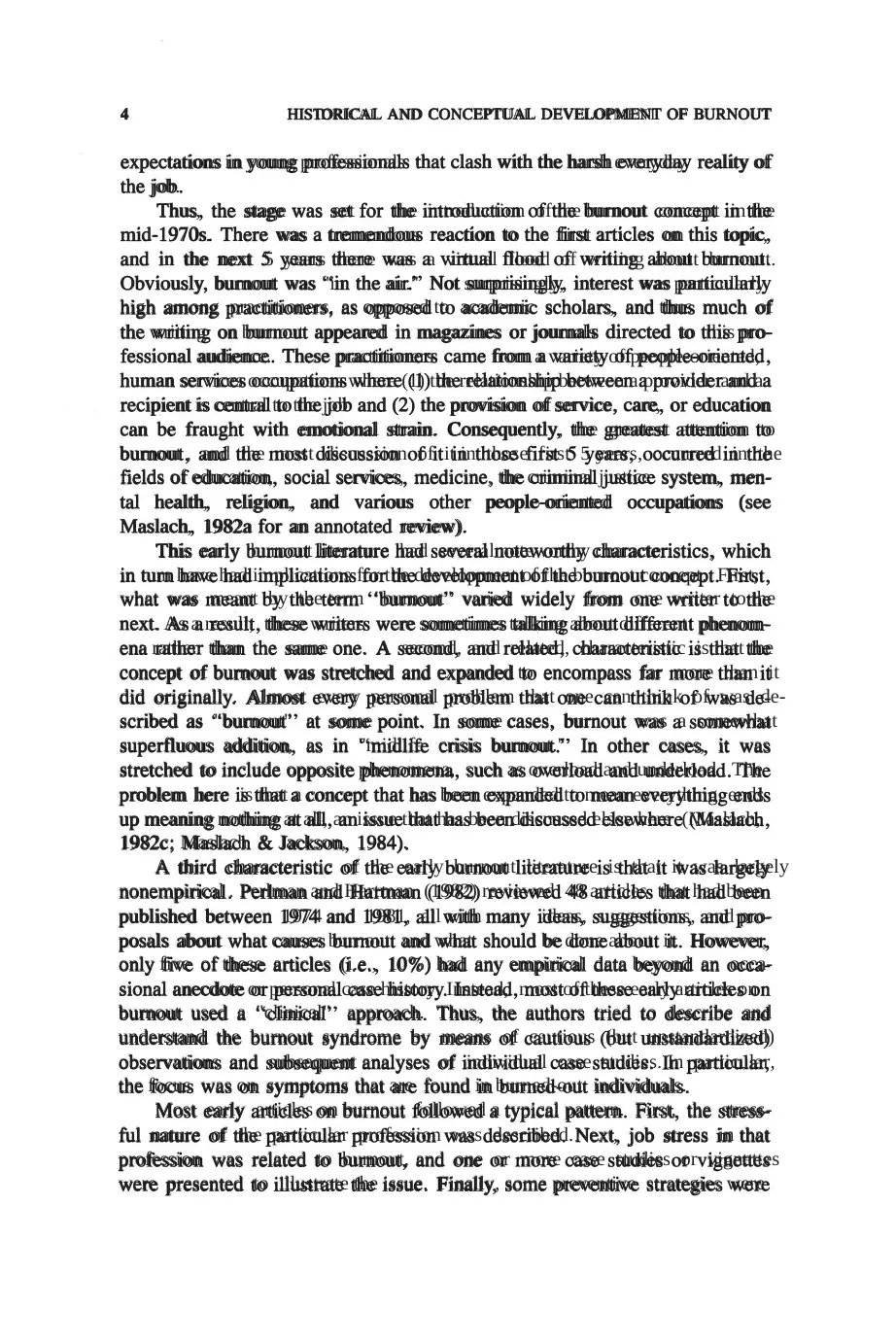
4 HIS1DRICAL AND CONCEPTUAL DEVELOPMENT OF BURNOUT
expectations in young professionals that clash with the harsh everyday reality of
the job.
Thus, the stage was set for the introduction of the burnout concept in the
mid-1970s. There was a tremendous reaction to the first articles on this topic,
and in the next 5 years there was a virtual flood of writing about burnout.
Obviously, burnout was "in the air." Not surprisingly, interest was particularly
high among practitioners, as opposed to academic scholars, and thus much of
the writing on burnout appeared in magazines or journals directed to this pro-
fessional audience. These practitioners came from a variety of people-oriented,
human services occupations where (1) the relationship between a provider and a
recipient is central to the job and (2) the provision of service, care, or education
can be fraught with emotional strain. Consequently, the greatest attention to
burnout , and the most discussion of it in those first 5 years, occurred in the
fields of education, social services, medicine, the criminal justice system, men-
tal health, religion, and various other people-oriented occupations (see
Maslach, 1982a for an annotated review).
This early burnout literature had several noteworthy characteristics, which
in tum have had implications for the development of the burnout concept. First,
what was meant by the term "burnout" varied widely from one writer to the
next. As a result, these writers were sometimes talking about different phenom-
ena rather than the same one. A second, and related, characteristic is that the
concept of burnout was stretched and expanded to encompass far more than it
did originally. Almost every personal problem that one can think of was de-
scribed as "burnout" at some point. In some cases, burnout was a somewhat
superfluous addition, as in "midlife crisis burnout." In other cases, it was
stretched to include opposite phenomena, such as overload and underload . The
problem here is that a concept that has been expanded to mean everything ends
up meaning nothing at all, an issue that has been discussed elsewhere (Maslach,
1982c; Maslach & Jackson, 1984).
A third characteristic of the early burnout literature is that it was largely
nonempirical . Perlman and Hartman (1982) reviewed 48 articles that had been
published between 1974 and 1981, all with many ideas, suggestions, and pro-
posals about what causes burnout and what should be done about it. However,
only five of these articles (i.e., 10%) had any empirical data beyond an occa-
sional anecdote or personal case history. Instead, most of these early articles on
burnout used a "clinical" approach. Thus, the authors tried to describe and
understand the burnout syndrome by means of cautious (but unstandardized)
observations and subsequent analyses of individual case studies. In particular,
the focus was on symptoms that are found in burned-out individuals.
Most early articles on burnout followed a typical pattern. First, the stress-
ful nature of the particular profession was described. Next, job stress in that
profession was related to burnout, and one or more case studies or vignettes
were presented to illustrate the issue. Finally, some preventive strategies were
expectations in young professionals that clash with the harsh everyday reality of
the job.
Thus, the stage was set for the introduction of the burnout concept in the
mid-1970s. There was a tremendous reaction to the first articles on this topic,
and in the next 5 years there was a virtual flood of writing about burnout.
Obviously, burnout was "in the air." Not surprisingly, interest was particularly
high among practitioners, as opposed to academic scholars, and thus much of
the writing on burnout appeared in magazines or journals directed to this pro-
fessional audience. These practitioners came from a variety of people-oriented,
human services occupations where (1) the relationship between a provider and a
recipient is central to the job and (2) the provision of service, care, or education
can be fraught with emotional strain. Consequently, the greatest attention to
burnout , and the most discussion of it in those first 5 years, occurred in the
fields of education, social services, medicine, the criminal justice system, men-
tal health, religion, and various other people-oriented occupations (see
Maslach, 1982a for an annotated review).
This early burnout literature had several noteworthy characteristics, which
in tum have had implications for the development of the burnout concept. First,
what was meant by the term "burnout" varied widely from one writer to the
next. As a result, these writers were sometimes talking about different phenom-
ena rather than the same one. A second, and related, characteristic is that the
concept of burnout was stretched and expanded to encompass far more than it
did originally. Almost every personal problem that one can think of was de-
scribed as "burnout" at some point. In some cases, burnout was a somewhat
superfluous addition, as in "midlife crisis burnout." In other cases, it was
stretched to include opposite phenomena, such as overload and underload . The
problem here is that a concept that has been expanded to mean everything ends
up meaning nothing at all, an issue that has been discussed elsewhere (Maslach,
1982c; Maslach & Jackson, 1984).
A third characteristic of the early burnout literature is that it was largely
nonempirical . Perlman and Hartman (1982) reviewed 48 articles that had been
published between 1974 and 1981, all with many ideas, suggestions, and pro-
posals about what causes burnout and what should be done about it. However,
only five of these articles (i.e., 10%) had any empirical data beyond an occa-
sional anecdote or personal case history. Instead, most of these early articles on
burnout used a "clinical" approach. Thus, the authors tried to describe and
understand the burnout syndrome by means of cautious (but unstandardized)
observations and subsequent analyses of individual case studies. In particular,
the focus was on symptoms that are found in burned-out individuals.
Most early articles on burnout followed a typical pattern. First, the stress-
ful nature of the particular profession was described. Next, job stress in that
profession was related to burnout, and one or more case studies or vignettes
were presented to illustrate the issue. Finally, some preventive strategies were
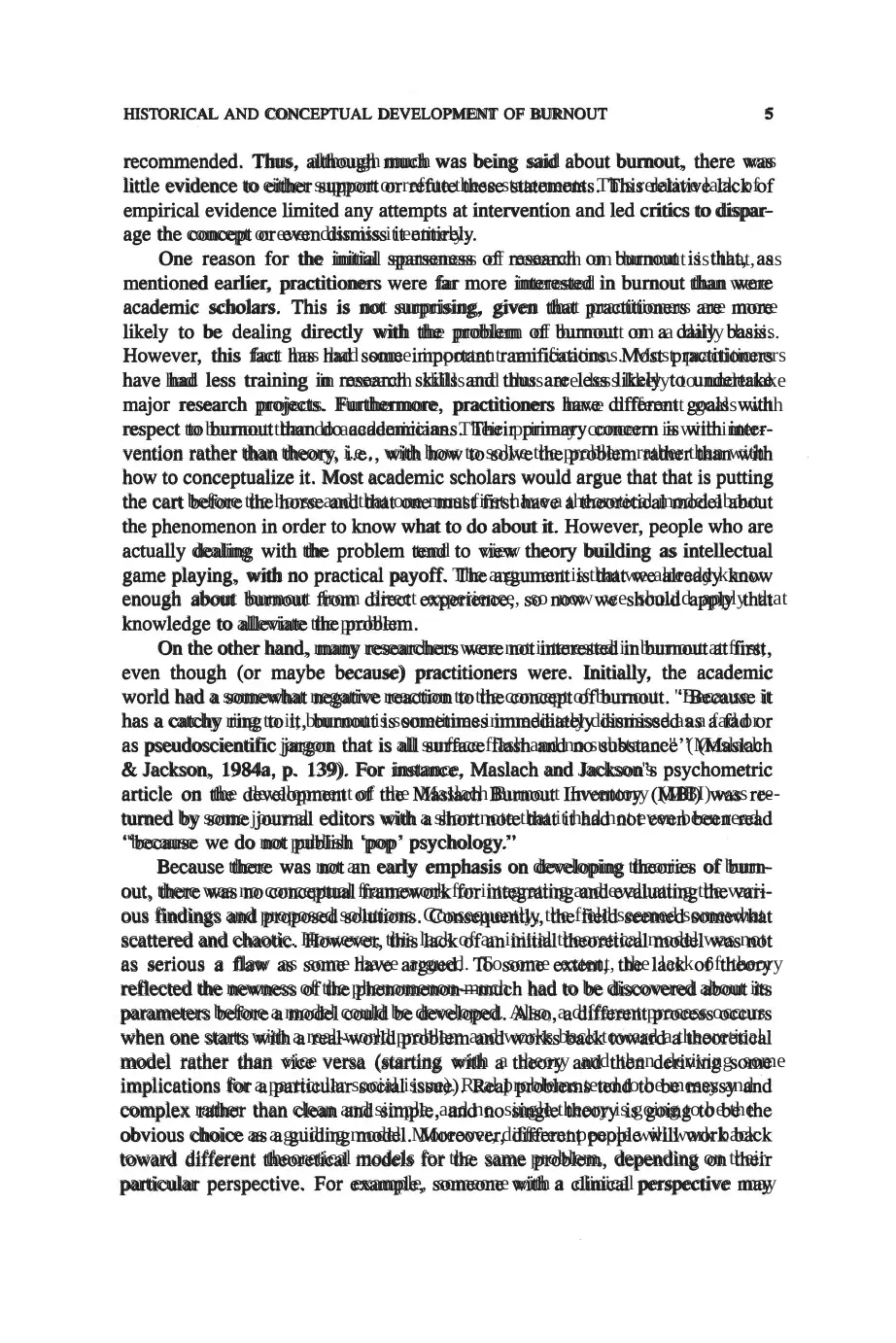
HISTORICAL AND CONCEPTUAL DEVELOPMENT OF BURNOUT 5
recommended. Thus, although much was being said about burnout, there was
little evidence to either support or refute these statements. This relative lack of
empirical evidence limited any attempts at intervention and led critics to dispar-
age the concept or even dismiss it entirely.
One reason for the initial sparseness of research on burnout is that, as
mentioned earlier, practitioners were far more interested in burnout than were
academic scholars. This is not surprising, given that practitioners are more
likely to be dealing directly with the problem of burnout on a daily basis.
However, this fact has had some important ramifications. Most practitioners
have had less training in research skills and thus are less likely to undertake
major research projects. Furthermore, practitioners have different goals with
respect to burnout than do academicians. Their primary concern is with inter-
vention rather than theory, i.e., with how to solve the problem rather than with
how to conceptualize it. Most academic scholars would argue that that is putting
the cart before the horse and that one must first have a theoretical model about
the phenomenon in order to know what to do about it. However, people who are
actually dealing with the problem tend to view theory building as intellectual
game playing, with no practical payoff. The argument is that we already know
enough about burnout from direct experience, so now we should apply that
knowledge to alleviate the problem.
On the other hand, many researchers were not interested in burnout at first,
even though (or maybe because) practitioners were. Initially, the academic
world had a somewhat negative reaction to the concept of burnout. "Because it
has a catchy ring to it, burnout is sometimes immediately dismissed as a fad or
as pseudoscientific jargon that is all surface flash and no substance" (Maslach
& Jackson, 1984a, p. 139). For instance, Maslach and Jackson's psychometric
article on the development of the Maslach Burnout Inventory (MBI) was re-
turned by some journal editors with a short note that it had not even been read
"because we do not publish 'pop ' psychology."
Because there was not an early emphasis on developing theories of burn-
out, there was no conceptual framework for integrating and evaluating the vari-
ous findings and proposed solutions. Consequently, the field seemed somewhat
scattered and chaotic. However, this lack of an initial theoretical model was not
as serious a flaw as some have argued. To some extent, the lack of theory
reflected the newness of the phenomenon-much had to be discovered about its
parameters before a model could be developed. Also, a different process occurs
when one starts with a real-world problem and works back toward a theoretical
model rather than vice versa (starting with a theory and then deriving some
implications for a particular social issue). Real problems tend to be messy and
complex rather than clean and simple, and no single theory is going to be the
obvious choice as a guiding model. Moreover, different people will work back
toward different theoretical models for the same problem, depending on their
particular perspective. For example, someone with a clinical perspective may
recommended. Thus, although much was being said about burnout, there was
little evidence to either support or refute these statements. This relative lack of
empirical evidence limited any attempts at intervention and led critics to dispar-
age the concept or even dismiss it entirely.
One reason for the initial sparseness of research on burnout is that, as
mentioned earlier, practitioners were far more interested in burnout than were
academic scholars. This is not surprising, given that practitioners are more
likely to be dealing directly with the problem of burnout on a daily basis.
However, this fact has had some important ramifications. Most practitioners
have had less training in research skills and thus are less likely to undertake
major research projects. Furthermore, practitioners have different goals with
respect to burnout than do academicians. Their primary concern is with inter-
vention rather than theory, i.e., with how to solve the problem rather than with
how to conceptualize it. Most academic scholars would argue that that is putting
the cart before the horse and that one must first have a theoretical model about
the phenomenon in order to know what to do about it. However, people who are
actually dealing with the problem tend to view theory building as intellectual
game playing, with no practical payoff. The argument is that we already know
enough about burnout from direct experience, so now we should apply that
knowledge to alleviate the problem.
On the other hand, many researchers were not interested in burnout at first,
even though (or maybe because) practitioners were. Initially, the academic
world had a somewhat negative reaction to the concept of burnout. "Because it
has a catchy ring to it, burnout is sometimes immediately dismissed as a fad or
as pseudoscientific jargon that is all surface flash and no substance" (Maslach
& Jackson, 1984a, p. 139). For instance, Maslach and Jackson's psychometric
article on the development of the Maslach Burnout Inventory (MBI) was re-
turned by some journal editors with a short note that it had not even been read
"because we do not publish 'pop ' psychology."
Because there was not an early emphasis on developing theories of burn-
out, there was no conceptual framework for integrating and evaluating the vari-
ous findings and proposed solutions. Consequently, the field seemed somewhat
scattered and chaotic. However, this lack of an initial theoretical model was not
as serious a flaw as some have argued. To some extent, the lack of theory
reflected the newness of the phenomenon-much had to be discovered about its
parameters before a model could be developed. Also, a different process occurs
when one starts with a real-world problem and works back toward a theoretical
model rather than vice versa (starting with a theory and then deriving some
implications for a particular social issue). Real problems tend to be messy and
complex rather than clean and simple, and no single theory is going to be the
obvious choice as a guiding model. Moreover, different people will work back
toward different theoretical models for the same problem, depending on their
particular perspective. For example, someone with a clinical perspective may
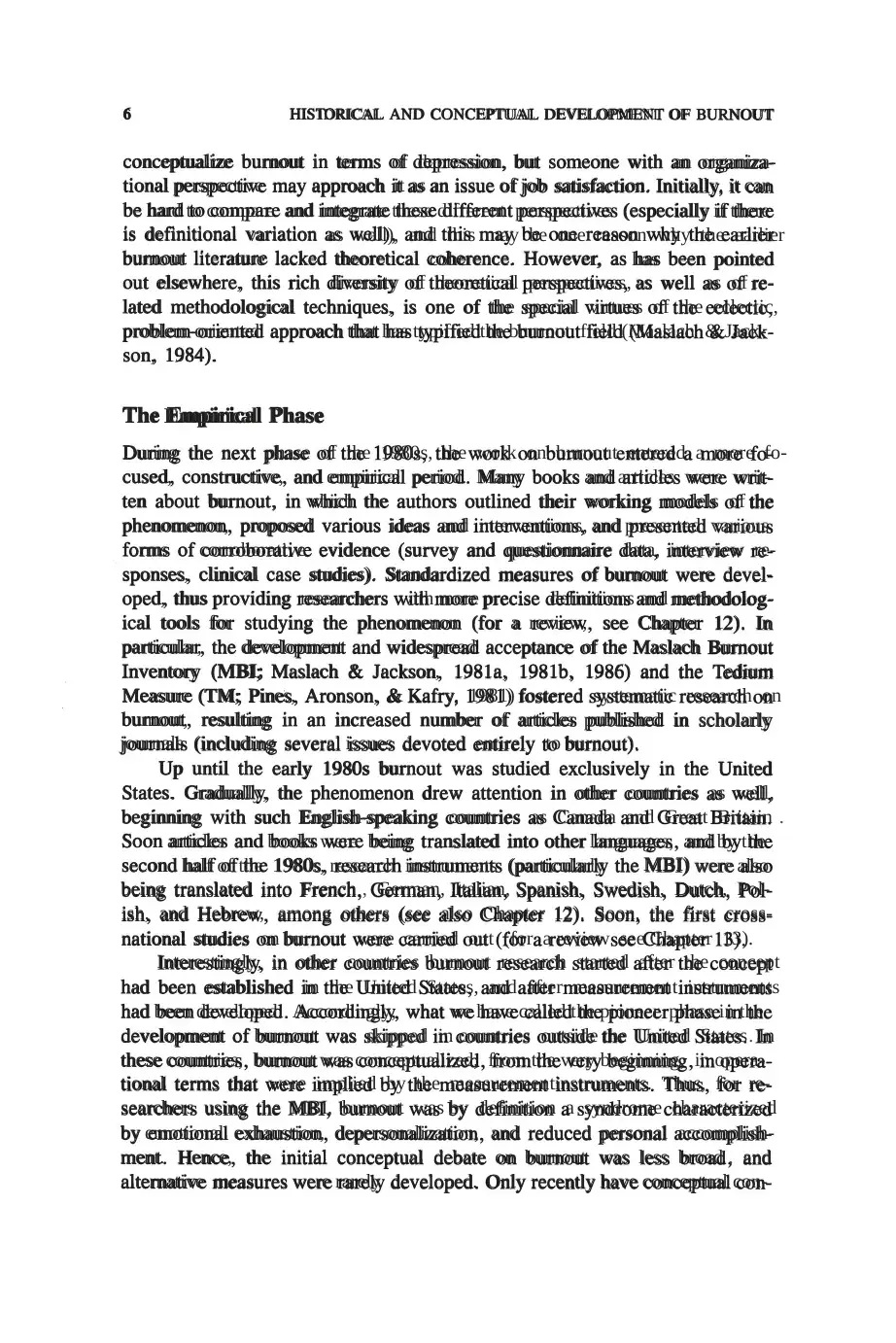
6 HIS1DRICAL AND CONCEPTUAL DEVELOPMENT OF BURNOUT
conceptualize burnout in terms of depression, but someone with an organiza-
tional perspective may approach it as an issue of job satisfaction. Initially, it can
be hard to compare and integrate these different perspectives (especially if there
is definitional variation as well), and this may be one reason why the earlier
burnout literature lacked theoretical coherence. However, as has been pointed
out elsewhere, this rich diversity of theoretical perspectives, as well as of re-
lated methodological techniques, is one of the special virtues of the eclectic,
problem-oriented approach that has typified the burnout field (Maslach & Jack-
son, 1984).
The Empirical Phase
During the next phase of the 1980s, the work on burnout entered a more fo-
cused, constructive, and empirical period. Many books and articles were writ-
ten about burnout, in which the authors outlined their working models of the
phenomenon, proposed various ideas and interventions, and presented various
forms of corroborative evidence (survey and questionnaire data, interview re-
sponses, clinical case studies). Standardized measures of burnout were devel-
oped, thus providing researchers with more precise definitions and methodolog-
ical tools for studying the phenomenon (for a review, see Chapter 12). In
particular, the development and widespread acceptance of the Maslach Burnout
Inventory (MBI; Maslach & Jackson, 1981a, 1981b, 1986) and the Tedium
Measure (TM; Pines, Aronson, & Kafry, 1981) fostered systematic research on
burnout, resulting in an increased number of articles published in scholarly
journals (including several issues devoted entirely to burnout).
Up until the early 1980s burnout was studied exclusively in the United
States. Gradually, the phenomenon drew attention in other countries as well,
beginning with such English-speaking countries as Canada and Great Britain .
Soon articles and books were being translated into other languages, and by the
second half of the 1980s, research instruments (particularly the MBI) were also
being translated into French , German, Italian, Spanish, Swedish, Dutch, Pol-
ish, and Hebrew, among others (see also Chapter 12). Soon, the first cross-
national studies on burnout were carried out (for a review see Chapter 13).
Interestingly, in other countries burnout research started after the concept
had been established in the United States, and after measurement instruments
had been developed. Accordingly, what we have called the pioneer phase in the
development of burnout was skipped in countries outside the United States. In
these countries, burnout was conceptualized, from the very beginning, in opera-
tional terms that were implied by the measurementinstruments. Thus, for re-
searchers using the MBI, burnout was by definition a syndrome characterized
by emotional exhaustion, depersonalization, and reduced personal accomplish-
ment. Hence, the initial conceptual debate on burnout was less broad , and
alternative measures were rarely developed. Only recently have conceptual con-
conceptualize burnout in terms of depression, but someone with an organiza-
tional perspective may approach it as an issue of job satisfaction. Initially, it can
be hard to compare and integrate these different perspectives (especially if there
is definitional variation as well), and this may be one reason why the earlier
burnout literature lacked theoretical coherence. However, as has been pointed
out elsewhere, this rich diversity of theoretical perspectives, as well as of re-
lated methodological techniques, is one of the special virtues of the eclectic,
problem-oriented approach that has typified the burnout field (Maslach & Jack-
son, 1984).
The Empirical Phase
During the next phase of the 1980s, the work on burnout entered a more fo-
cused, constructive, and empirical period. Many books and articles were writ-
ten about burnout, in which the authors outlined their working models of the
phenomenon, proposed various ideas and interventions, and presented various
forms of corroborative evidence (survey and questionnaire data, interview re-
sponses, clinical case studies). Standardized measures of burnout were devel-
oped, thus providing researchers with more precise definitions and methodolog-
ical tools for studying the phenomenon (for a review, see Chapter 12). In
particular, the development and widespread acceptance of the Maslach Burnout
Inventory (MBI; Maslach & Jackson, 1981a, 1981b, 1986) and the Tedium
Measure (TM; Pines, Aronson, & Kafry, 1981) fostered systematic research on
burnout, resulting in an increased number of articles published in scholarly
journals (including several issues devoted entirely to burnout).
Up until the early 1980s burnout was studied exclusively in the United
States. Gradually, the phenomenon drew attention in other countries as well,
beginning with such English-speaking countries as Canada and Great Britain .
Soon articles and books were being translated into other languages, and by the
second half of the 1980s, research instruments (particularly the MBI) were also
being translated into French , German, Italian, Spanish, Swedish, Dutch, Pol-
ish, and Hebrew, among others (see also Chapter 12). Soon, the first cross-
national studies on burnout were carried out (for a review see Chapter 13).
Interestingly, in other countries burnout research started after the concept
had been established in the United States, and after measurement instruments
had been developed. Accordingly, what we have called the pioneer phase in the
development of burnout was skipped in countries outside the United States. In
these countries, burnout was conceptualized, from the very beginning, in opera-
tional terms that were implied by the measurementinstruments. Thus, for re-
searchers using the MBI, burnout was by definition a syndrome characterized
by emotional exhaustion, depersonalization, and reduced personal accomplish-
ment. Hence, the initial conceptual debate on burnout was less broad , and
alternative measures were rarely developed. Only recently have conceptual con-
Paraphrase This Document
Need a fresh take? Get an instant paraphrase of this document with our AI Paraphraser
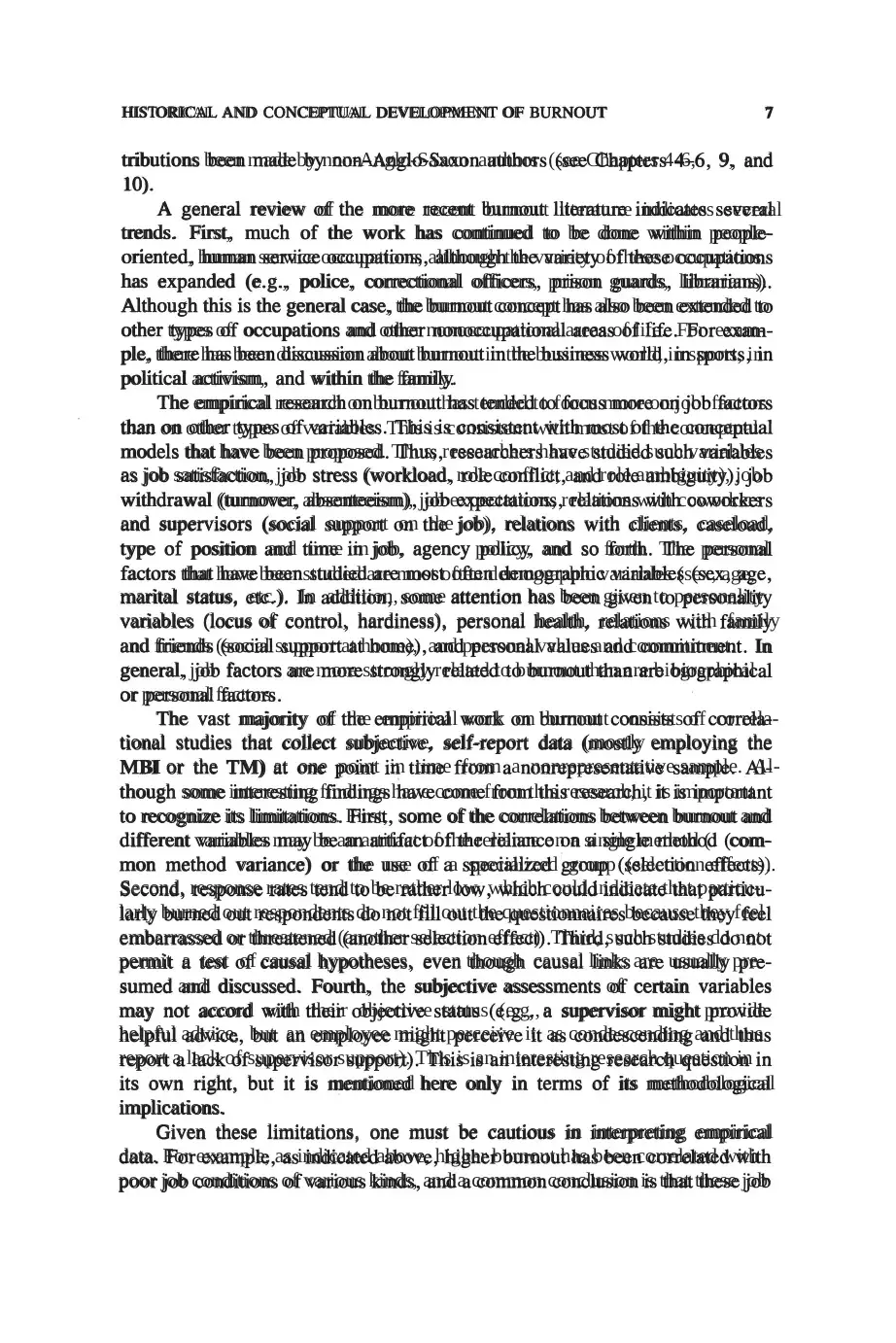
HIS'IORICAL AND CONCEPTUAL DEVELOPMENT OF BURNOUT 7
tributions been made by non-Anglo-Saxon authors (see Chapters 4-6, 9, and
10).
A general review of the more recent burnout literature indicates several
trends. First, much of the work has continued to be done within people-
oriented, human service occupations, although the variety of these occupations
has expanded (e.g., police, correctional officers, prison guards, librarians).
Although this is the general case, the burnout concept has also been extended to
other types of occupations and other nonoccupational areas of life. For exam-
ple, there has been discussion about burnout in the business world, in sports, in
political activism, and within the family.
The empirical research on burnout has tended to focus more on job factors
than on other types of variables. This is consistent with most of the conceptual
models that have been proposed. Thus, researchers have studied such variables
as job satisfaction, job stress (workload, role conflict, and role ambiguity), job
withdrawal (turnover, absenteeism), job expectations, relations with coworkers
and supervisors (social support on the job), relations with clients, caseload,
type of position and time in job, agency policy, and so forth. The personal
factors that have been studied are most often demographic variables (sex, age,
marital status, etc.). In addition, some attention has been given to personality
variables (locus of control, hardiness), personal health, relations with family
and friends (social support at home), and personal values and commitment. In
general, job factors are more strongly related to burnout than are biographical
or personal factors.
The vast majority of the empirical work on burnout consists of correla-
tional studies that collect subjective, self-report data (mostly employing the
MBI or the TM) at one point in time from a nonrepresentative sample. Al-
though some interesting findings have come from this research, it is important
to recognize its limitations. First, some of the correlations between burnout and
different variables may be an artifact of the reliance on a single method ( com-
mon method variance) or the use of a specialized group (selection effects).
Second, response rates tend to be rather low, which could indicate that particu-
larly burned out respondents do not fill out the questionnaires because they feel
embarrassed or threatened (another selection effect). Third, such studies do not
permit a test of causal hypotheses, even though causal links are usually pre-
sumed and discussed. Fourth, the subjective assessments of certain variables
may not accord with their objective status (e.g., a supervisor might provide
helpful advice, but an employee might perceive it as condescending and thus
report a lack of supervisor support). This is an interesting research question in
its own right, but it is mentioned here only in terms of its methodological
implications.
Given these limitations, one must be cautious in interpreting empirical
data. For example, as indicated above, higher burnout has been correlated with
poor job conditions of various kinds, and a common conclusion is that these job
tributions been made by non-Anglo-Saxon authors (see Chapters 4-6, 9, and
10).
A general review of the more recent burnout literature indicates several
trends. First, much of the work has continued to be done within people-
oriented, human service occupations, although the variety of these occupations
has expanded (e.g., police, correctional officers, prison guards, librarians).
Although this is the general case, the burnout concept has also been extended to
other types of occupations and other nonoccupational areas of life. For exam-
ple, there has been discussion about burnout in the business world, in sports, in
political activism, and within the family.
The empirical research on burnout has tended to focus more on job factors
than on other types of variables. This is consistent with most of the conceptual
models that have been proposed. Thus, researchers have studied such variables
as job satisfaction, job stress (workload, role conflict, and role ambiguity), job
withdrawal (turnover, absenteeism), job expectations, relations with coworkers
and supervisors (social support on the job), relations with clients, caseload,
type of position and time in job, agency policy, and so forth. The personal
factors that have been studied are most often demographic variables (sex, age,
marital status, etc.). In addition, some attention has been given to personality
variables (locus of control, hardiness), personal health, relations with family
and friends (social support at home), and personal values and commitment. In
general, job factors are more strongly related to burnout than are biographical
or personal factors.
The vast majority of the empirical work on burnout consists of correla-
tional studies that collect subjective, self-report data (mostly employing the
MBI or the TM) at one point in time from a nonrepresentative sample. Al-
though some interesting findings have come from this research, it is important
to recognize its limitations. First, some of the correlations between burnout and
different variables may be an artifact of the reliance on a single method ( com-
mon method variance) or the use of a specialized group (selection effects).
Second, response rates tend to be rather low, which could indicate that particu-
larly burned out respondents do not fill out the questionnaires because they feel
embarrassed or threatened (another selection effect). Third, such studies do not
permit a test of causal hypotheses, even though causal links are usually pre-
sumed and discussed. Fourth, the subjective assessments of certain variables
may not accord with their objective status (e.g., a supervisor might provide
helpful advice, but an employee might perceive it as condescending and thus
report a lack of supervisor support). This is an interesting research question in
its own right, but it is mentioned here only in terms of its methodological
implications.
Given these limitations, one must be cautious in interpreting empirical
data. For example, as indicated above, higher burnout has been correlated with
poor job conditions of various kinds, and a common conclusion is that these job
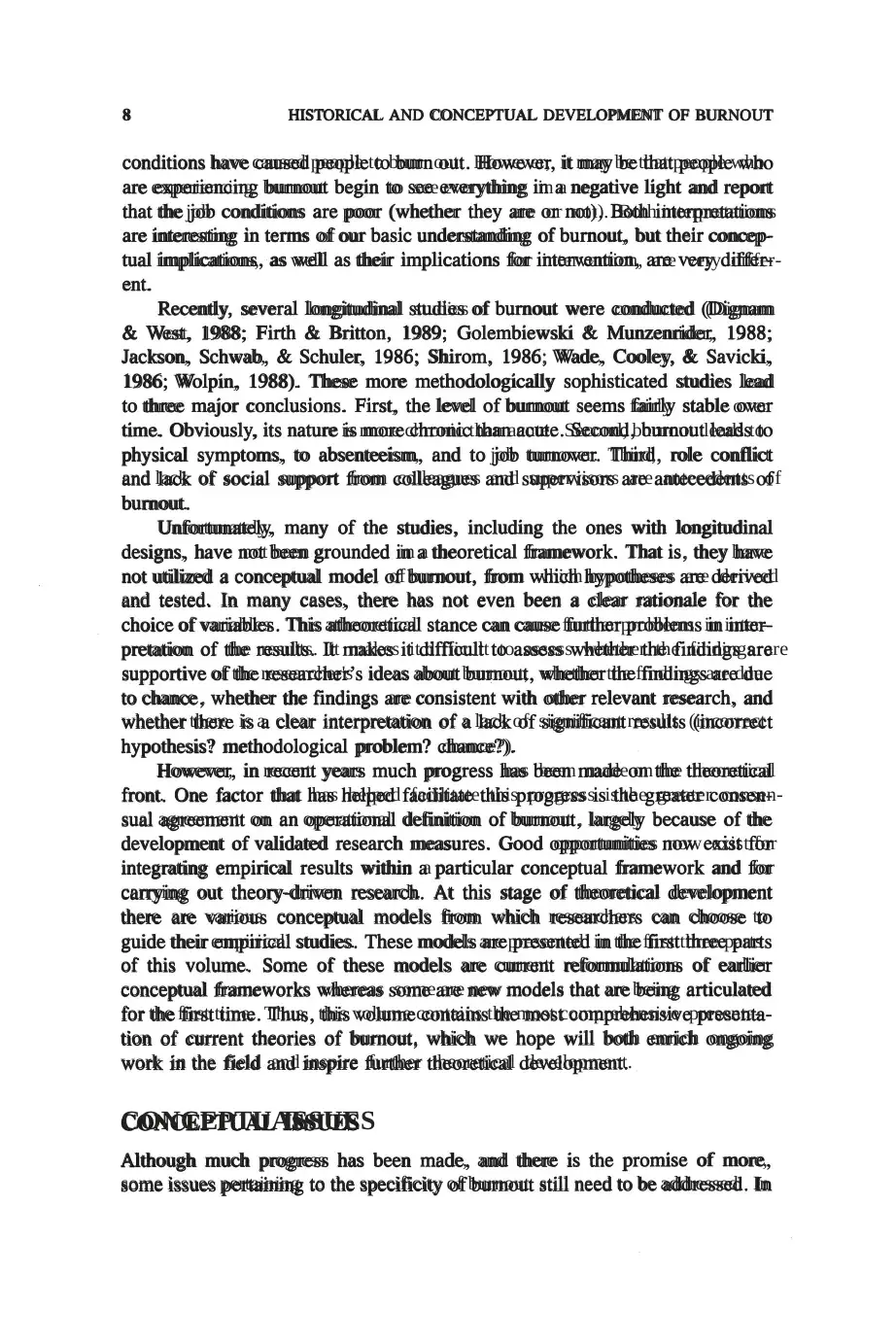
8 HISTORICAL AND CONCEPTUAL DEVELOPMENT OF BURNOUT
conditions have caused people to bum out. However, it may be that people who
are experiencing burnout begin to see everything in a negative light and report
that the job conditions are poor (whether they are or not). Both interpretations
are interesting in terms of our basic understanding of burnout, but their concep-
tual implications, as well as their implications for intervention, are very differ-
ent.
Recently, several longitudinal studies of burnout were conducted (Dignam
& West, 1988; Firth & Britton, 1989; Golembiewski & Munzenrider, 1988;
Jackson, Schwab, & Schuler, 1986; Shirom, 1986; Wade, Cooley, & Savicki,
1986; Wolpin, 1988). These more methodologically sophisticated studies lead
to three major conclusions. First, the level of burnout seems fairly stable over
time. Obviously, its nature is more chronic than acute. Second, burnout leads to
physical symptoms, to absenteeism, and to job turnover. Third, role conflict
and lack of social support from colleagues and supervisors are antecedents of
burnout.
Unfortunately, many of the studies, including the ones with longitudinal
designs, have not been grounded in a theoretical framework. That is, they have
not utilized a conceptual model of burnout, from which hypotheses are derived
and tested. In many cases, there has not even been a clear rationale for the
choice of variables. This atheoretical stance can cause further problems in inter-
pretation of the results. It makes it difficult to assess whether the findings are
supportive of the researcher's ideas about burnout, whether the findings are due
to chance , whether the findings are consistent with other relevant research, and
whether there is a clear interpretation of a lack of significant results (incorrect
hypothesis? methodological problem? chance?).
However, in recent years much progress has been made on the theoretical
front. One factor that has helped facilitate this progress is the greater consen-
sual agreement on an operational definition of burnout , largely because of the
development of validated research measures. Good opportunities now exist for
integrating empirical results within a particular conceptual framework and for
carrying out theory-driven research. At this stage of theoretical development
there are various conceptual models from which researchers can choose to
guide their empirical studies. These models are presented in the first three parts
of this volume. Some of these models are current reformulations of earlier
conceptual frameworks whereas some are new models that are being articulated
for the first time. Thus, this volume contains the most comprehensive presenta-
tion of current theories of burnout, which we hope will both enrich ongoing
work in the field and inspire further theoretical development.
CONCEPTUALISSUES
Although much progress has been made, and there is the promise of more,
some issues pertaining to the specificity of burnout still need to be addressed. In
conditions have caused people to bum out. However, it may be that people who
are experiencing burnout begin to see everything in a negative light and report
that the job conditions are poor (whether they are or not). Both interpretations
are interesting in terms of our basic understanding of burnout, but their concep-
tual implications, as well as their implications for intervention, are very differ-
ent.
Recently, several longitudinal studies of burnout were conducted (Dignam
& West, 1988; Firth & Britton, 1989; Golembiewski & Munzenrider, 1988;
Jackson, Schwab, & Schuler, 1986; Shirom, 1986; Wade, Cooley, & Savicki,
1986; Wolpin, 1988). These more methodologically sophisticated studies lead
to three major conclusions. First, the level of burnout seems fairly stable over
time. Obviously, its nature is more chronic than acute. Second, burnout leads to
physical symptoms, to absenteeism, and to job turnover. Third, role conflict
and lack of social support from colleagues and supervisors are antecedents of
burnout.
Unfortunately, many of the studies, including the ones with longitudinal
designs, have not been grounded in a theoretical framework. That is, they have
not utilized a conceptual model of burnout, from which hypotheses are derived
and tested. In many cases, there has not even been a clear rationale for the
choice of variables. This atheoretical stance can cause further problems in inter-
pretation of the results. It makes it difficult to assess whether the findings are
supportive of the researcher's ideas about burnout, whether the findings are due
to chance , whether the findings are consistent with other relevant research, and
whether there is a clear interpretation of a lack of significant results (incorrect
hypothesis? methodological problem? chance?).
However, in recent years much progress has been made on the theoretical
front. One factor that has helped facilitate this progress is the greater consen-
sual agreement on an operational definition of burnout , largely because of the
development of validated research measures. Good opportunities now exist for
integrating empirical results within a particular conceptual framework and for
carrying out theory-driven research. At this stage of theoretical development
there are various conceptual models from which researchers can choose to
guide their empirical studies. These models are presented in the first three parts
of this volume. Some of these models are current reformulations of earlier
conceptual frameworks whereas some are new models that are being articulated
for the first time. Thus, this volume contains the most comprehensive presenta-
tion of current theories of burnout, which we hope will both enrich ongoing
work in the field and inspire further theoretical development.
CONCEPTUALISSUES
Although much progress has been made, and there is the promise of more,
some issues pertaining to the specificity of burnout still need to be addressed. In
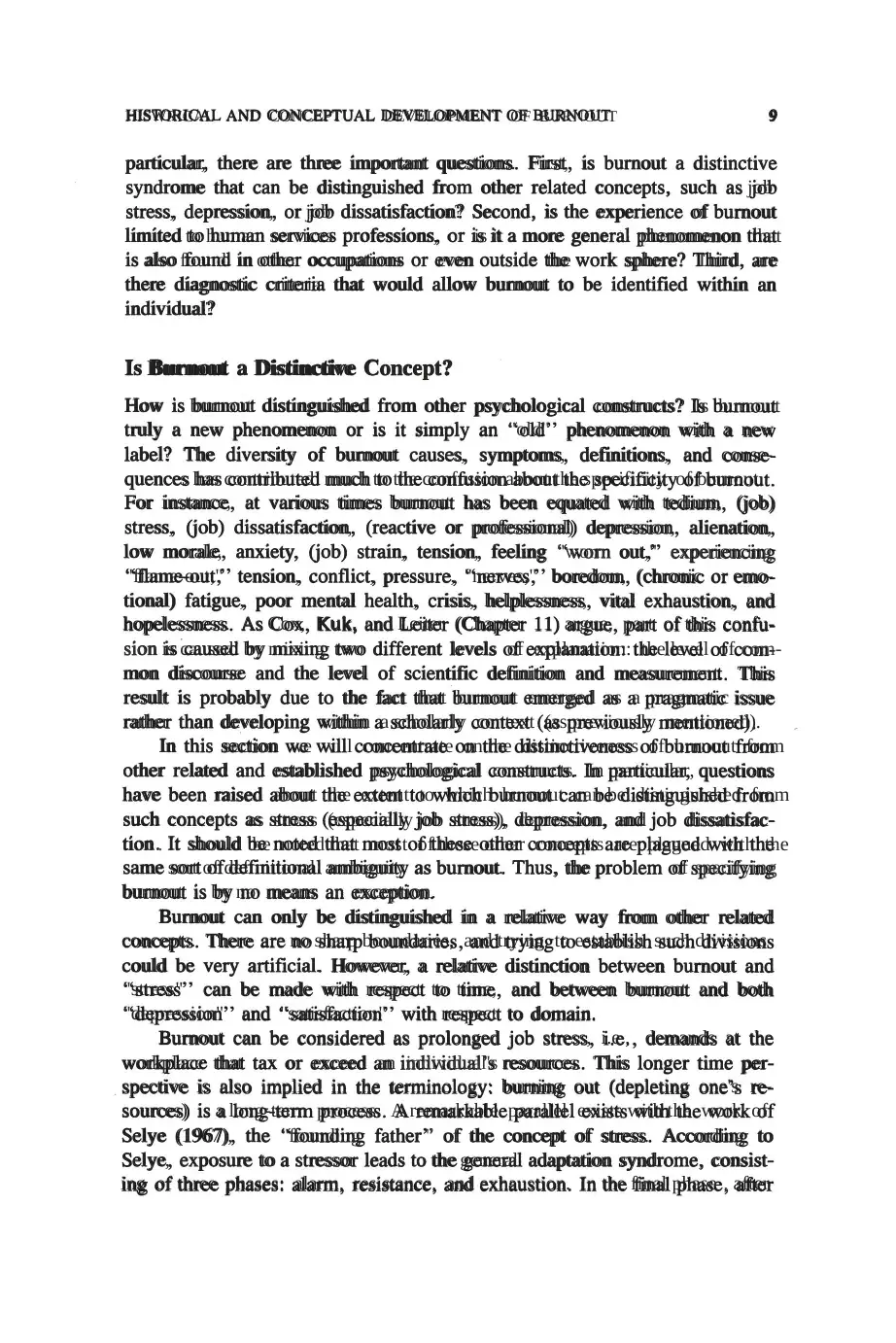
HISWRICAL AND CONCEPTUAL DEVELOPMENT OF BURNOUT 9
particular, there are three important questions. First, is burnout a distinctive
syndrome that can be distinguished from other related concepts, such as job
stress, depression, or job dissatisfaction? Second, is the experience of burnout
limited to human services professions, or is it a more general phenomenon that
is also found in other occupations or even outside the work sphere? Third, are
there diagnostic criteria that would allow burnout to be identified within an
individual?
Is Burnout a Distinctive Concept?
How is burnout distinguished from other psychological constructs? Is burnout
truly a new phenomenon or is it simply an "old" phenomenon with a new
label? The diversity of burnout causes, symptoms, definitions, and conse-
quences has contributed much to the confusion about the specificity of burnout.
For instance, at various times burnout has been equated with tedium, (job)
stress, (job) dissatisfaction, (reactive or professional) depression, alienation,
low morale, anxiety, (job) strain, tension, feeling "worn out," experiencing
"flame-out," tension, conflict, pressure, "nerves," boredom, (chronic or emo-
tional) fatigue, poor mental health, crisis, helplessness, vital exhaustion, and
hopelessness. As Cox, Kuk, and Leiter (Chapter 11) argue, part of this confu-
sion is caused by mixing two different levels of explanation: the level of com-
mon discourse and the level of scientific definition and measurement. This
result is probably due to the fact that burnout emerged as a pragmatic issue
rather than developing within a scholarly context (as previously mentioned).
In this section we will concentrate on the distinctiveness of burnout from
other related and established psychological constructs. In particular, questions
have been raised about the extent to which burnout can be distinguished from
such concepts as stress (especially job stress), depression, and job dissatisfac-
tion . It should be noted that most of these other concepts are plagued with the
same sort of definitional ambiguity as burnout. Thus, the problem of specifying
burnout is by no means an exception.
Burnout can only be distinguished in a relative way from other related
concepts. There are no sharp boundaries, and trying to establish such divisions
could be very artificial. However, a relative distinction between burnout and
"stress" can be made with respect to time, and between burnout and both
"depression" and "satisfaction" with respect to domain.
Burnout can be considered as prolonged job stress, i.e., demands at the
workplace that tax or exceed an individual's resources. This longer time per-
spective is also implied in the terminology: burning out (depleting one's re-
sources) is a long-term process. A remarkable parallel exists with the work of
Selye (1967), the "founding father " of the concept of stress. According to
Selye, exposure to a stressor leads to the general adaptation syndrome, consist-
ing of three phases: alarm, resistance, and exhaustion. In the final phase , after
particular, there are three important questions. First, is burnout a distinctive
syndrome that can be distinguished from other related concepts, such as job
stress, depression, or job dissatisfaction? Second, is the experience of burnout
limited to human services professions, or is it a more general phenomenon that
is also found in other occupations or even outside the work sphere? Third, are
there diagnostic criteria that would allow burnout to be identified within an
individual?
Is Burnout a Distinctive Concept?
How is burnout distinguished from other psychological constructs? Is burnout
truly a new phenomenon or is it simply an "old" phenomenon with a new
label? The diversity of burnout causes, symptoms, definitions, and conse-
quences has contributed much to the confusion about the specificity of burnout.
For instance, at various times burnout has been equated with tedium, (job)
stress, (job) dissatisfaction, (reactive or professional) depression, alienation,
low morale, anxiety, (job) strain, tension, feeling "worn out," experiencing
"flame-out," tension, conflict, pressure, "nerves," boredom, (chronic or emo-
tional) fatigue, poor mental health, crisis, helplessness, vital exhaustion, and
hopelessness. As Cox, Kuk, and Leiter (Chapter 11) argue, part of this confu-
sion is caused by mixing two different levels of explanation: the level of com-
mon discourse and the level of scientific definition and measurement. This
result is probably due to the fact that burnout emerged as a pragmatic issue
rather than developing within a scholarly context (as previously mentioned).
In this section we will concentrate on the distinctiveness of burnout from
other related and established psychological constructs. In particular, questions
have been raised about the extent to which burnout can be distinguished from
such concepts as stress (especially job stress), depression, and job dissatisfac-
tion . It should be noted that most of these other concepts are plagued with the
same sort of definitional ambiguity as burnout. Thus, the problem of specifying
burnout is by no means an exception.
Burnout can only be distinguished in a relative way from other related
concepts. There are no sharp boundaries, and trying to establish such divisions
could be very artificial. However, a relative distinction between burnout and
"stress" can be made with respect to time, and between burnout and both
"depression" and "satisfaction" with respect to domain.
Burnout can be considered as prolonged job stress, i.e., demands at the
workplace that tax or exceed an individual's resources. This longer time per-
spective is also implied in the terminology: burning out (depleting one's re-
sources) is a long-term process. A remarkable parallel exists with the work of
Selye (1967), the "founding father " of the concept of stress. According to
Selye, exposure to a stressor leads to the general adaptation syndrome, consist-
ing of three phases: alarm, resistance, and exhaustion. In the final phase , after
Secure Best Marks with AI Grader
Need help grading? Try our AI Grader for instant feedback on your assignments.
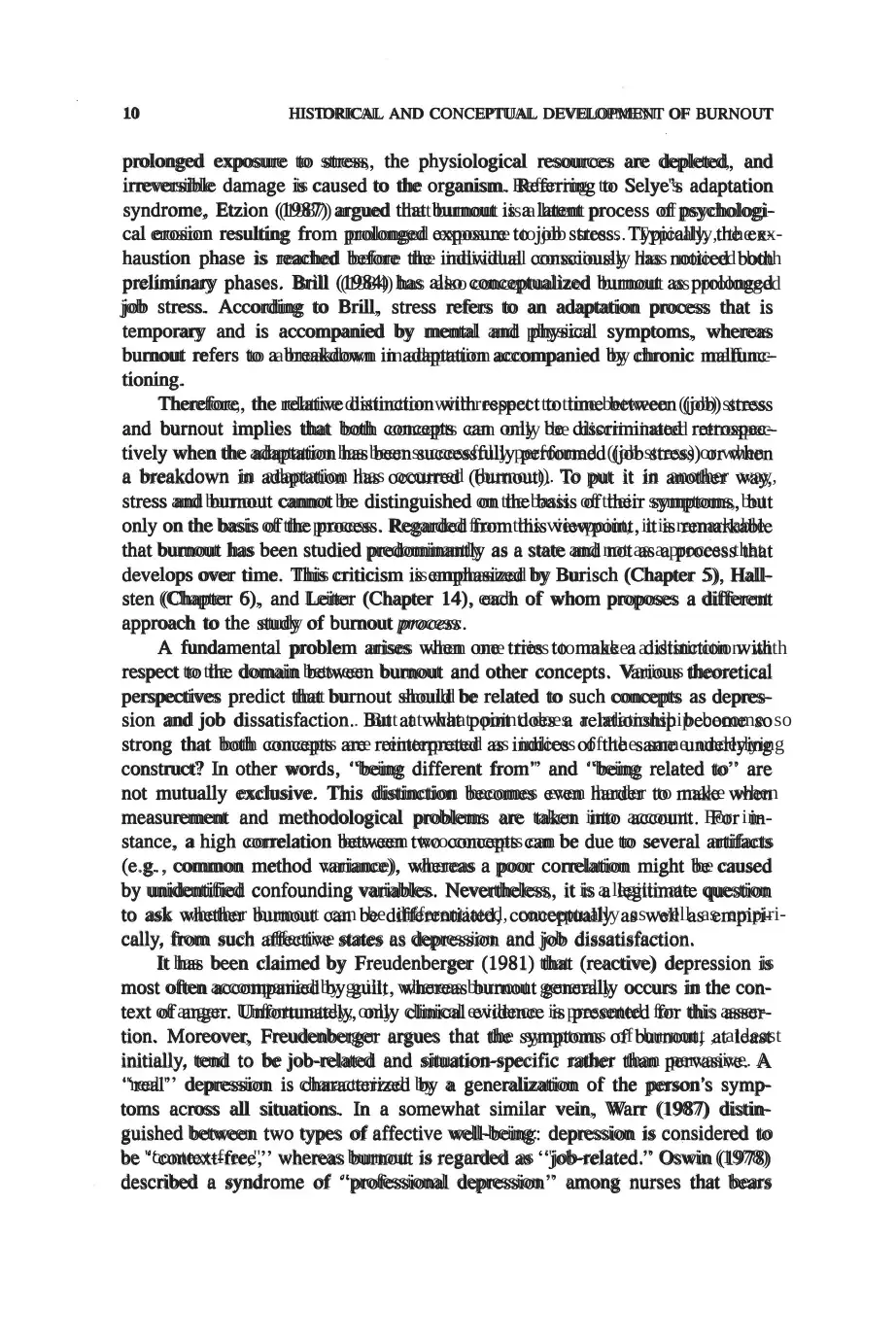
10 HIS1DRICAL AND CONCEPTUAL DEVELOPMENT OF BURNOUT
prolonged exposure to stress, the physiological resources are depleted, and
irreversible damage is caused to the organism. Referring to Selye's adaptation
syndrome, Etzion (1987) argued that burnout is a latent process of psychologi-
cal erosion resulting from prolonged exposure to job stress. Typically, the ex-
haustion phase is reached before the individual consciously has noticed both
preliminary phases. Brill (1984) has also conceptualized burnout as prolonged
job stress. According to Brill, stress refers to an adaptation process that is
temporary and is accompanied by mental and physical symptoms, whereas
burnout refers to a breakdown in adaptation accompanied by chronic malfunc-
tioning.
Therefore, the relative distinction with respect to time between (job) stress
and burnout implies that both concepts can only be discriminated retrospec-
tively when the adaptation has been successfully performed (job stress) or when
a breakdown in adaptation has occurred (burnout). To put it in another way,
stress and burnout cannot be distinguished on the basis of their symptoms, but
only on the basis of the process . Regarded from this viewpoint, it is remarkable
that burnout has been studied predominantly as a state and not as a process that
develops over time. This criticism is emphasized by Burisch (Chapter 5), Hall-
sten (Chapter 6), and Leiter (Chapter 14), each of whom proposes a different
approach to the study of burnout process.
A fundamental problem arises when one tries to make a distinction with
respect to the domain between burnout and other concepts. Various theoretical
perspectives predict that burnout should be related to such concepts as depres-
sion and job dissatisfaction . But at what point does a relationship become so
strong that both concepts are reinterpreted as indices of the same underlying
construct? In other words, "being different from" and "being related to" are
not mutually exclusive. This distinction becomes even harder to make when
measurement and methodological problems are taken into account. For in-
stance, a high correlation between two concepts can be due to several artifacts
(e.g. , common method variance), whereas a poor correlation might be caused
by unidentified confounding variables. Nevertheless, it is a legitimate question
to ask whether burnout can be differentiated, conceptually as well as empiri-
cally, from such affective states as depression and job dissatisfaction.
It has been claimed by Freudenberger (1981) that (reactive) depression is
most often accompanied by guilt, whereas burnout generally occurs in the con-
text of anger. Unfortunately, only clinical evidence is presented for this asser-
tion. Moreover, Freudenberger argues that the symptoms of burnout , at least
initially, tend to be job-related and situation-specific rather than pervasive. A
"real" depression is characterized by a generalization of the person's symp-
toms across all situations. In a somewhat similar vein, Warr (1987) distin-
guished between two types of affective well-being: depression is considered to
be "context-free," whereas burnout is regarded as "job-related." Oswin (1978)
described a syndrome of "professional depression " among nurses that bears
prolonged exposure to stress, the physiological resources are depleted, and
irreversible damage is caused to the organism. Referring to Selye's adaptation
syndrome, Etzion (1987) argued that burnout is a latent process of psychologi-
cal erosion resulting from prolonged exposure to job stress. Typically, the ex-
haustion phase is reached before the individual consciously has noticed both
preliminary phases. Brill (1984) has also conceptualized burnout as prolonged
job stress. According to Brill, stress refers to an adaptation process that is
temporary and is accompanied by mental and physical symptoms, whereas
burnout refers to a breakdown in adaptation accompanied by chronic malfunc-
tioning.
Therefore, the relative distinction with respect to time between (job) stress
and burnout implies that both concepts can only be discriminated retrospec-
tively when the adaptation has been successfully performed (job stress) or when
a breakdown in adaptation has occurred (burnout). To put it in another way,
stress and burnout cannot be distinguished on the basis of their symptoms, but
only on the basis of the process . Regarded from this viewpoint, it is remarkable
that burnout has been studied predominantly as a state and not as a process that
develops over time. This criticism is emphasized by Burisch (Chapter 5), Hall-
sten (Chapter 6), and Leiter (Chapter 14), each of whom proposes a different
approach to the study of burnout process.
A fundamental problem arises when one tries to make a distinction with
respect to the domain between burnout and other concepts. Various theoretical
perspectives predict that burnout should be related to such concepts as depres-
sion and job dissatisfaction . But at what point does a relationship become so
strong that both concepts are reinterpreted as indices of the same underlying
construct? In other words, "being different from" and "being related to" are
not mutually exclusive. This distinction becomes even harder to make when
measurement and methodological problems are taken into account. For in-
stance, a high correlation between two concepts can be due to several artifacts
(e.g. , common method variance), whereas a poor correlation might be caused
by unidentified confounding variables. Nevertheless, it is a legitimate question
to ask whether burnout can be differentiated, conceptually as well as empiri-
cally, from such affective states as depression and job dissatisfaction.
It has been claimed by Freudenberger (1981) that (reactive) depression is
most often accompanied by guilt, whereas burnout generally occurs in the con-
text of anger. Unfortunately, only clinical evidence is presented for this asser-
tion. Moreover, Freudenberger argues that the symptoms of burnout , at least
initially, tend to be job-related and situation-specific rather than pervasive. A
"real" depression is characterized by a generalization of the person's symp-
toms across all situations. In a somewhat similar vein, Warr (1987) distin-
guished between two types of affective well-being: depression is considered to
be "context-free," whereas burnout is regarded as "job-related." Oswin (1978)
described a syndrome of "professional depression " among nurses that bears
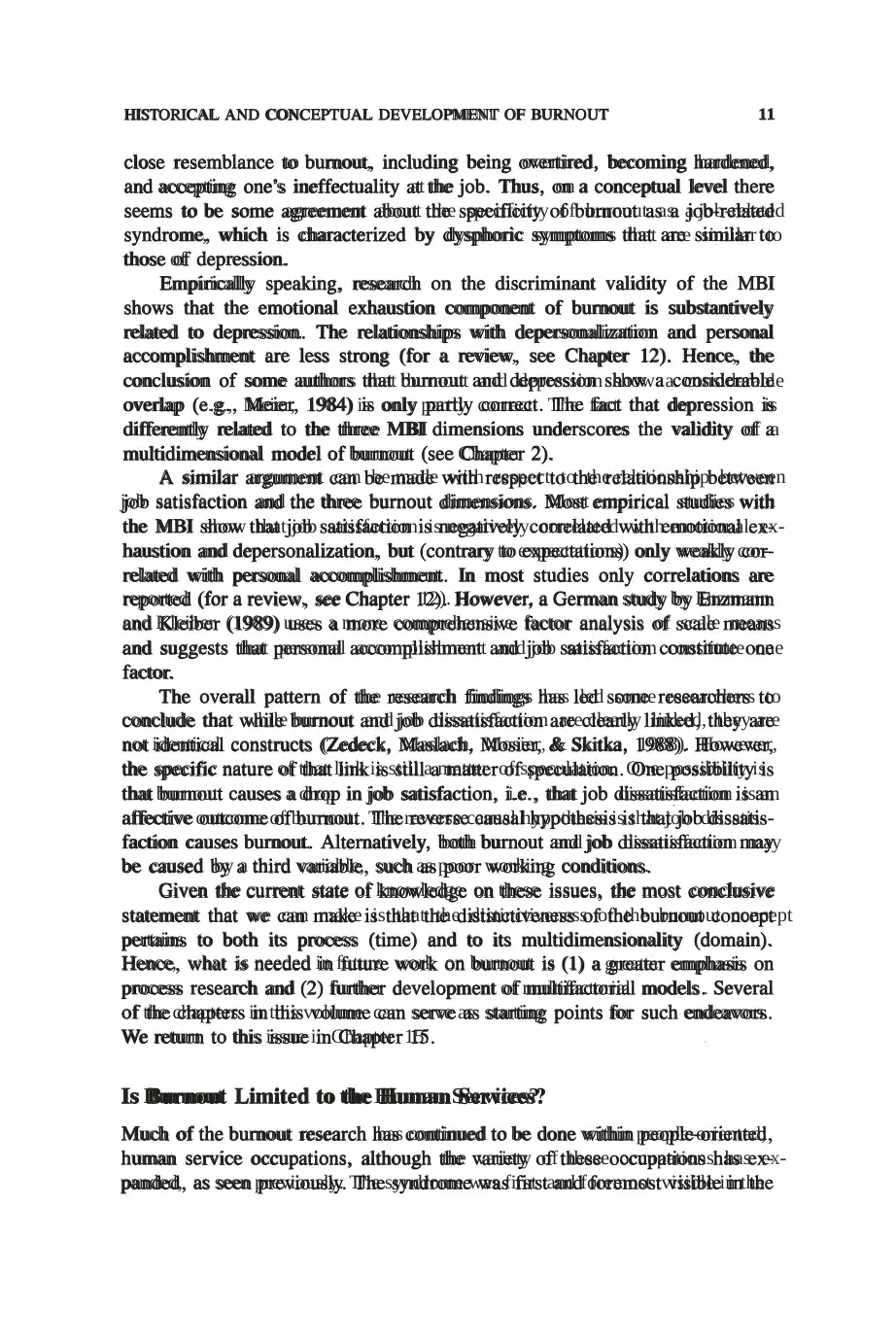
HISTORICAL AND CONCEPTUAL DEVELOPMENT OF BURNOUT 11
close resemblance to burnout, including being overtired, becoming hardened,
and accepting one's ineffectuality at the job. Thus, on a conceptual level there
seems to be some agreement about the specificity of burnout as a job-related
syndrome, which is characterized by dysphoric symptoms that are similar to
those of depression.
Empirically speaking, research on the discriminant validity of the MBI
shows that the emotional exhaustion component of burnout is substantively
related to depression. The relationships with depersonalization and personal
accomplishment are less strong (for a review, see Chapter 12). Hence, the
conclusion of some authors that burnout and depression show a considerable
overlap (e.g., Meier, 1984) is only partly correct. The fact that depression is
differently related to the three MBI dimensions underscores the validity of a
multidimensional model of burnout (see Chapter 2).
A similar argument can be made with respect to the relationship between
job satisfaction and the three burnout dimensions. Most empirical studies with
the MBI show that job satisfaction is negatively correlated with emotional ex-
haustion and depersonalization, but (contrary to expectations) only weakly cor-
related with personal accomplishment. In most studies only correlations are
reported (for a review, see Chapter 12). However, a German study by Enzmann
and Kleiber (1989) uses a more comprehensive factor analysis of scale means
and suggests that personal accomplishment and job satisfaction constitute one
factor.
The overall pattern of the research findings has led some researchers to
conclude that while burnout and job dissatisfaction are clearly linked, they are
not identical constructs (Zedeck, Maslach, Mosier, & Skitka, 1988). However,
the specific nature of that link is still a matter of speculation. One possibility is
that burnout causes a drop in job satisfaction, i.e., that job dissatisfaction is an
affective outcome of burnout. The reverse causal hypothesis is that job dissatis-
faction causes burnout. Alternatively, both burnout and job dissatisfaction may
be caused by a third variable, such as poor working conditions.
Given the current state of knowledge on these issues, the most conclusive
statement that we can make is that the distinctiveness of the burnout concept
pertains to both its process (time) and to its multidimensionality (domain).
Hence, what is needed in future work on burnout is (1) a greater emphasis on
process research and (2) further development of multifactorial models . Several
of the chapters in this volume can serve as starting points for such endeavors.
We return to this issue in Chapter 15.
Is Burnout Limited to the Human Services?
Much of the burnout research has continued to be done within people-oriented,
human service occupations, although the variety of these occupations has ex-
panded, as seen previously. The syndrome was first and foremost visible in the
close resemblance to burnout, including being overtired, becoming hardened,
and accepting one's ineffectuality at the job. Thus, on a conceptual level there
seems to be some agreement about the specificity of burnout as a job-related
syndrome, which is characterized by dysphoric symptoms that are similar to
those of depression.
Empirically speaking, research on the discriminant validity of the MBI
shows that the emotional exhaustion component of burnout is substantively
related to depression. The relationships with depersonalization and personal
accomplishment are less strong (for a review, see Chapter 12). Hence, the
conclusion of some authors that burnout and depression show a considerable
overlap (e.g., Meier, 1984) is only partly correct. The fact that depression is
differently related to the three MBI dimensions underscores the validity of a
multidimensional model of burnout (see Chapter 2).
A similar argument can be made with respect to the relationship between
job satisfaction and the three burnout dimensions. Most empirical studies with
the MBI show that job satisfaction is negatively correlated with emotional ex-
haustion and depersonalization, but (contrary to expectations) only weakly cor-
related with personal accomplishment. In most studies only correlations are
reported (for a review, see Chapter 12). However, a German study by Enzmann
and Kleiber (1989) uses a more comprehensive factor analysis of scale means
and suggests that personal accomplishment and job satisfaction constitute one
factor.
The overall pattern of the research findings has led some researchers to
conclude that while burnout and job dissatisfaction are clearly linked, they are
not identical constructs (Zedeck, Maslach, Mosier, & Skitka, 1988). However,
the specific nature of that link is still a matter of speculation. One possibility is
that burnout causes a drop in job satisfaction, i.e., that job dissatisfaction is an
affective outcome of burnout. The reverse causal hypothesis is that job dissatis-
faction causes burnout. Alternatively, both burnout and job dissatisfaction may
be caused by a third variable, such as poor working conditions.
Given the current state of knowledge on these issues, the most conclusive
statement that we can make is that the distinctiveness of the burnout concept
pertains to both its process (time) and to its multidimensionality (domain).
Hence, what is needed in future work on burnout is (1) a greater emphasis on
process research and (2) further development of multifactorial models . Several
of the chapters in this volume can serve as starting points for such endeavors.
We return to this issue in Chapter 15.
Is Burnout Limited to the Human Services?
Much of the burnout research has continued to be done within people-oriented,
human service occupations, although the variety of these occupations has ex-
panded, as seen previously. The syndrome was first and foremost visible in the
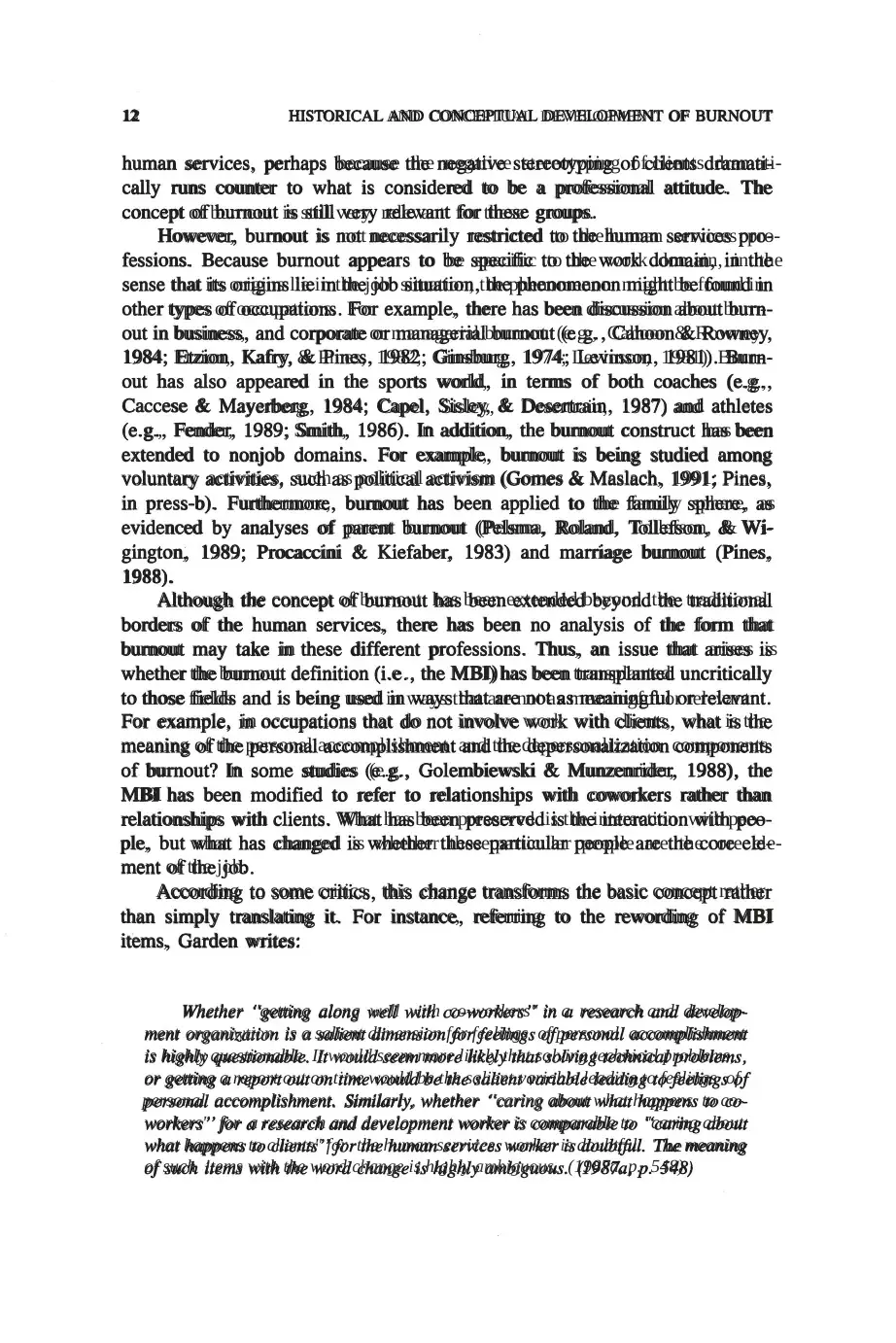
12 HISTORICAL AND CONCEPTUAL DEVELOPMENT OF BURNOUT
human services, perhaps because the negative stereotyping of clients dramati-
cally runs counter to what is considered to be a professional attitude. The
concept of burnout is still very relevant for these groups.
However, burnout is not necessarily restricted to the human services pro-
fessions. Because burnout appears to be specific to the work domain, in the
sense that its origins lie in the job situation, the phenomenon might be found in
other types of occupations. For example, there has been discussion about burn-
out in business, and corporate or managerial burnout (e.g., Cahoon & Rowney,
1984; Etzion, Kafry, & Pines, 1982; Ginsburg, 1974; Levinson, 1981). Burn-
out has also appeared in the sports world, in terms of both coaches (e.g.,
Caccese & Mayerberg, 1984; Capel, Sisley, & Desertrain, 1987) and athletes
(e.g., Fender, 1989; Smith, 1986). In addition, the burnout construct has been
extended to nonjob domains. For example, burnout is being studied among
voluntary activities, such as political activism (Gomes & Maslach, 1991; Pines,
in press-b). Furthermore, burnout has been applied to the family sphere, as
evidenced by analyses of parent burnout (Pelsma, Roland, Tollefson, & Wi-
gington, 1989; Procaccini & Kiefaber, 1983) and marriage burnout (Pines,
1988).
Although the concept of burnout has been extended beyond the traditional
borders of the human services, there has been no analysis of the form that
burnout may take in these different professions. Thus, an issue that arises is
whether the burnout definition (i.e ., the MBI) has been transplanted uncritically
to those fields and is being used in ways that are not as meaningful or relevant.
For example, in occupations that do not involve work with clients, what is the
meaning of the personal accomplishment and the depersonalization components
of burnout? In some studies (e.g., Golembiewski & Munzenrider, 1988), the
MBI has been modified to refer to relationships with coworkers rather than
relationships with clients. What has been preserved is the interaction with peo-
ple, but what has changed is whether these particular people are the core ele-
ment of the job.
According to some critics, this change transforms the basic concept rather
than simply translating it. For instance, referring to the rewording of MBI
items, Garden writes:
Whether "getting along well with co-workers" in a research and develop-
ment organiwtion is a salient dimension for feelings of personal accomplishment
is highly questionable. It would seem more likely that solving technical problems,
or getting a report out on time would be the salient variable leading to feelings of
personal accomplishment. Similarly, whether "caring about what happens to co-
workers" for a research and development worker is comparable to "caring about
what happens to clients" for the human services worker is doubtful. The meaning
of such items with the word change is highly ambiguous. (1987a, p. 548)
human services, perhaps because the negative stereotyping of clients dramati-
cally runs counter to what is considered to be a professional attitude. The
concept of burnout is still very relevant for these groups.
However, burnout is not necessarily restricted to the human services pro-
fessions. Because burnout appears to be specific to the work domain, in the
sense that its origins lie in the job situation, the phenomenon might be found in
other types of occupations. For example, there has been discussion about burn-
out in business, and corporate or managerial burnout (e.g., Cahoon & Rowney,
1984; Etzion, Kafry, & Pines, 1982; Ginsburg, 1974; Levinson, 1981). Burn-
out has also appeared in the sports world, in terms of both coaches (e.g.,
Caccese & Mayerberg, 1984; Capel, Sisley, & Desertrain, 1987) and athletes
(e.g., Fender, 1989; Smith, 1986). In addition, the burnout construct has been
extended to nonjob domains. For example, burnout is being studied among
voluntary activities, such as political activism (Gomes & Maslach, 1991; Pines,
in press-b). Furthermore, burnout has been applied to the family sphere, as
evidenced by analyses of parent burnout (Pelsma, Roland, Tollefson, & Wi-
gington, 1989; Procaccini & Kiefaber, 1983) and marriage burnout (Pines,
1988).
Although the concept of burnout has been extended beyond the traditional
borders of the human services, there has been no analysis of the form that
burnout may take in these different professions. Thus, an issue that arises is
whether the burnout definition (i.e ., the MBI) has been transplanted uncritically
to those fields and is being used in ways that are not as meaningful or relevant.
For example, in occupations that do not involve work with clients, what is the
meaning of the personal accomplishment and the depersonalization components
of burnout? In some studies (e.g., Golembiewski & Munzenrider, 1988), the
MBI has been modified to refer to relationships with coworkers rather than
relationships with clients. What has been preserved is the interaction with peo-
ple, but what has changed is whether these particular people are the core ele-
ment of the job.
According to some critics, this change transforms the basic concept rather
than simply translating it. For instance, referring to the rewording of MBI
items, Garden writes:
Whether "getting along well with co-workers" in a research and develop-
ment organiwtion is a salient dimension for feelings of personal accomplishment
is highly questionable. It would seem more likely that solving technical problems,
or getting a report out on time would be the salient variable leading to feelings of
personal accomplishment. Similarly, whether "caring about what happens to co-
workers" for a research and development worker is comparable to "caring about
what happens to clients" for the human services worker is doubtful. The meaning
of such items with the word change is highly ambiguous. (1987a, p. 548)
Paraphrase This Document
Need a fresh take? Get an instant paraphrase of this document with our AI Paraphraser
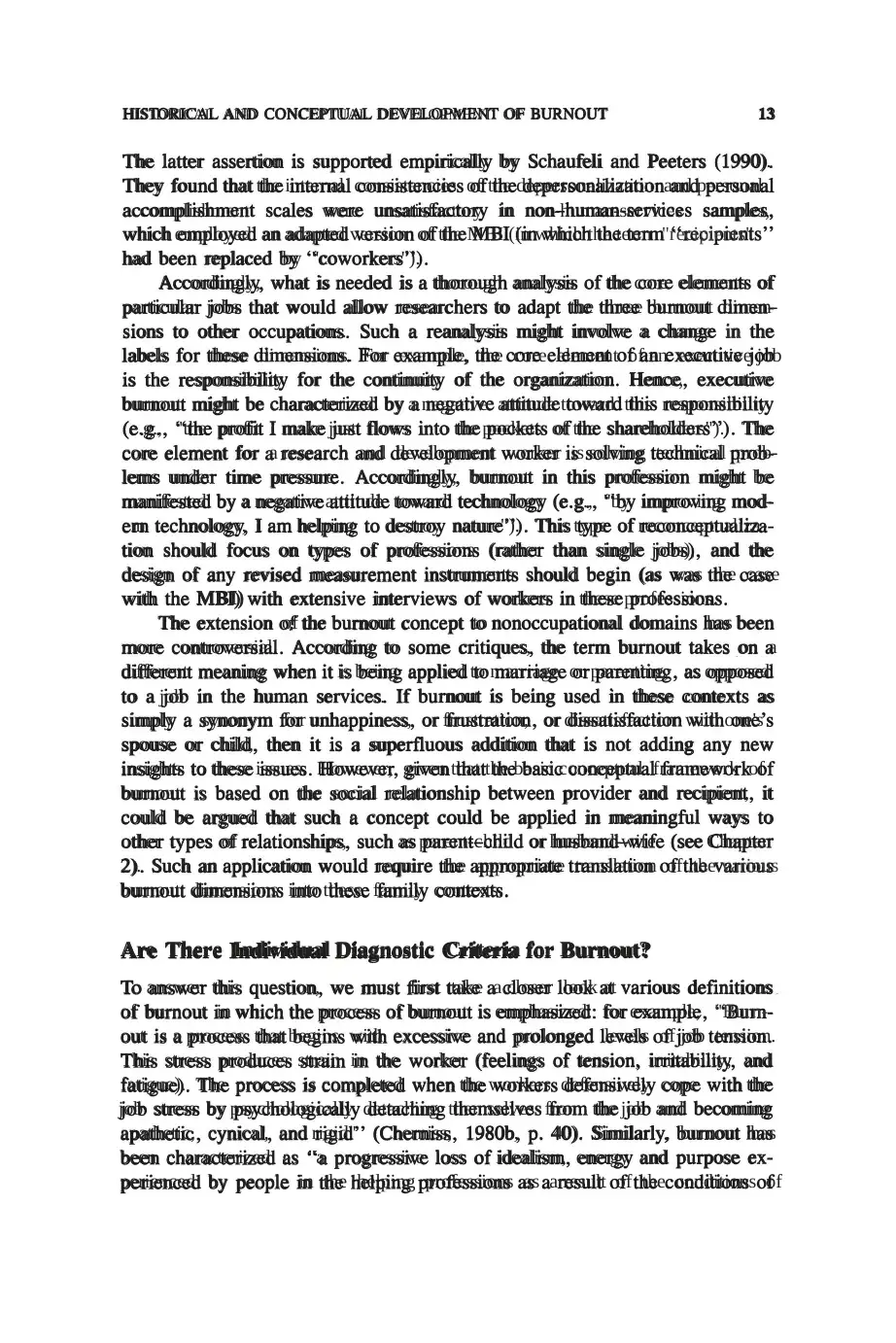
HIS1DRICAL AND CONCEPTUAL DEVELOPMENT OF BURNOUT 13
The latter assertion is supported empirically by Schaufeli and Peeters (1990).
They found that the internal consistencies of the depersonalization and personal
accomplishment scales were unsatisfactory in non-human-services samples,
which employed an adapted version of the MBI (in which the term "recipients"
had been replaced by "coworkers").
Accordingly, what is needed is a thorough analysis of the core elements of
particular jobs that would allow researchers to adapt the three burnout dimen-
sions to other occupations. Such a reanalysis might involve a change in the
labels for these dimensions. For example, the core element of an executive job
is the responsibility for the continuity of the organization. Hence, executive
burnout might be characterized by a negative attitude toward this responsibility
(e.g., "the profit I make just flows into the pockets of the shareholders"). The
core element for a research and development worker is solving technical prob-
lems under time pressure. Accordingly, burnout in this profession might be
manifested by a negative attitude toward technology (e.g., "by improving mod-
em technology, I am helping to destroy nature"). This type of reconceptualiza-
tion should focus on types of professions (rather than single jobs), and the
design of any revised measurement instruments should begin (as was the case
with the MBI) with extensive interviews of workers in these professions.
The extension of the burnout concept to nonoccupational domains has been
more controversial. According to some critiques, the term burnout takes on a
different meaning when it is being applied to marriage or parenting, as opposed
to a job in the human services. If burnout is being used in these contexts as
simply a synonym for unhappiness, or frustration, or dissatisfaction with one's
spouse or child, then it is a superfluous addition that is not adding any new
insights to these issues. However, given that the basic conceptual framework of
burnout is based on the social relationship between provider and recipient, it
could be argued that such a concept could be applied in meaningful ways to
other types of relationships, such as parent-child or husband-wife (see Chapter
2). Such an application would require the appropriate translation of the various
burnout dimensions into these family contexts.
Are There Individual Diagnostic Criteria for Burnout?
To answer this question, we must first take a closer look at various definitions
of burnout in which the process of burnout is emphasized: for example, "Burn-
out is a process that begins with excessive and prolonged levels of job tension.
This stress produces strain in the worker (feelings of tension, irritability, and
fatigue). The process is completed when the workers defensively cope with the
job stress by psychologically detaching themselves from the job and becoming
apathetic, cynical, and rigid" (Cherniss, 1980b, p. 40). Similarly, burnout has
been characterized as "a progressive loss of idealism, energy and purpose ex-
perienced by people in the helping professions as a result of the conditions of
The latter assertion is supported empirically by Schaufeli and Peeters (1990).
They found that the internal consistencies of the depersonalization and personal
accomplishment scales were unsatisfactory in non-human-services samples,
which employed an adapted version of the MBI (in which the term "recipients"
had been replaced by "coworkers").
Accordingly, what is needed is a thorough analysis of the core elements of
particular jobs that would allow researchers to adapt the three burnout dimen-
sions to other occupations. Such a reanalysis might involve a change in the
labels for these dimensions. For example, the core element of an executive job
is the responsibility for the continuity of the organization. Hence, executive
burnout might be characterized by a negative attitude toward this responsibility
(e.g., "the profit I make just flows into the pockets of the shareholders"). The
core element for a research and development worker is solving technical prob-
lems under time pressure. Accordingly, burnout in this profession might be
manifested by a negative attitude toward technology (e.g., "by improving mod-
em technology, I am helping to destroy nature"). This type of reconceptualiza-
tion should focus on types of professions (rather than single jobs), and the
design of any revised measurement instruments should begin (as was the case
with the MBI) with extensive interviews of workers in these professions.
The extension of the burnout concept to nonoccupational domains has been
more controversial. According to some critiques, the term burnout takes on a
different meaning when it is being applied to marriage or parenting, as opposed
to a job in the human services. If burnout is being used in these contexts as
simply a synonym for unhappiness, or frustration, or dissatisfaction with one's
spouse or child, then it is a superfluous addition that is not adding any new
insights to these issues. However, given that the basic conceptual framework of
burnout is based on the social relationship between provider and recipient, it
could be argued that such a concept could be applied in meaningful ways to
other types of relationships, such as parent-child or husband-wife (see Chapter
2). Such an application would require the appropriate translation of the various
burnout dimensions into these family contexts.
Are There Individual Diagnostic Criteria for Burnout?
To answer this question, we must first take a closer look at various definitions
of burnout in which the process of burnout is emphasized: for example, "Burn-
out is a process that begins with excessive and prolonged levels of job tension.
This stress produces strain in the worker (feelings of tension, irritability, and
fatigue). The process is completed when the workers defensively cope with the
job stress by psychologically detaching themselves from the job and becoming
apathetic, cynical, and rigid" (Cherniss, 1980b, p. 40). Similarly, burnout has
been characterized as "a progressive loss of idealism, energy and purpose ex-
perienced by people in the helping professions as a result of the conditions of
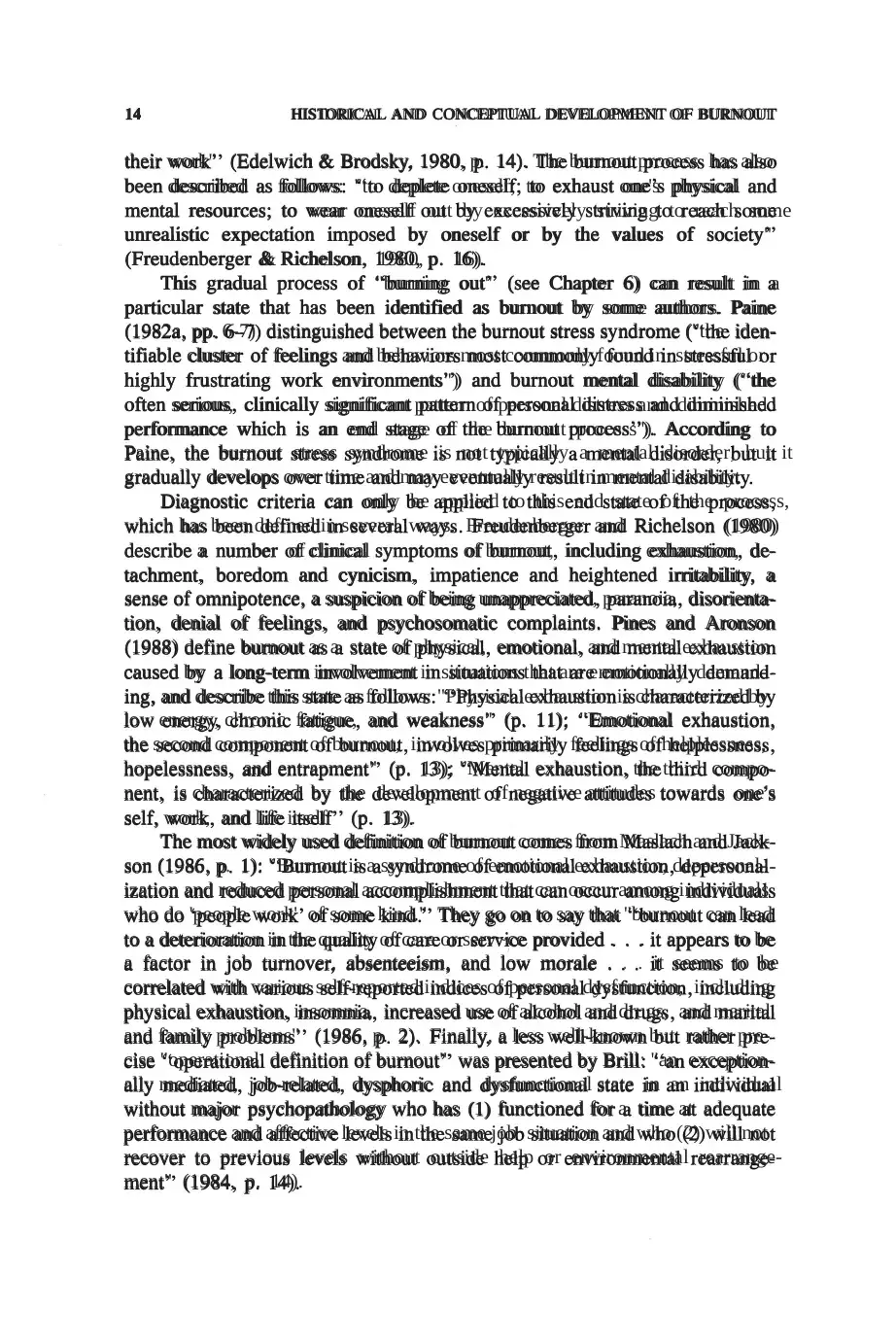
14 HIS1DRICAL AND CONCEPTUAL DEVELOPMENT OF BURNOUT
their work" (Edelwich & Brodsky, 1980, p. 14). The burnout process has also
been described as follows: "to deplete oneself; to exhaust one's physical and
mental resources; to wear oneself out by excessively striving to reach some
unrealistic expectation imposed by oneself or by the values of society"
(Freudenberger & Richelson, 1980, p. 16).
This gradual process of "burning out" (see Chapter 6) can result in a
particular state that has been identified as burnout by some authors. Paine
(1982a, pp. 6-7) distinguished between the burnout stress syndrome (''the iden-
tifiable cluster of feelings and behaviors most commonly found in stressful or
highly frustrating work environments") and burnout mental disability ("the
often serious, clinically significant pattern of personal distress and diminished
performance which is an end stage of the burnout process"). According to
Paine, the burnout stress syndrome is not typically a mental disorder, but it
gradually develops over time and may eventually result in mental disability.
Diagnostic criteria can only be applied to this end state of the process,
which has been defined in several ways. Freudenberger and Richelson (1980)
describe a number of clinical symptoms of burnout, including exhaustion, de-
tachment, boredom and cynicism, impatience and heightened irritability, a
sense of omnipotence, a suspicion of being unappreciated, paranoia, disorienta-
tion, denial of feelings, and psychosomatic complaints. Pines and Aronson
(1988) define burnout as a state of physical, emotional, and mental exhaustion
caused by a long-term involvement in situations that are emotionally demand-
ing, and describe this state as follows: "Physical exhaustion is characterized by
low energy, chronic fatigue, and weakness" (p. 11); "Emotional exhaustion,
the second component of burnout, involves primarily feelings of helplessness,
hopelessness, and entrapment" (p. 13); "Mental exhaustion, the third compo-
nent, is characterized by the development of negative attitudes towards one's
self, work, and life itself' (p. 13).
The most widely used definition of burnout comes from Maslach and Jack-
son (1986, p. 1): "Burnout is a syndrome of emotional exhaustion, depersonal-
ization and reduced personal accomplishment that can occur among individuals
who do 'people work' of some kind." They go on to say that "burnout can lead
to a deterioration in the quality of care or serv~ce provided . . . it appears to be
a factor in job turnover, absenteeism, and low morale . . . it seems to be
correlated with various self-reported indices of personal dysfunction, including
physical exhaustion, insomnia, increased use of alcohol and drugs, and marital
and family problems" (1986, p. 2). Finally, a less well-known but rather pre-
cise "operational definition of burnout" was presented by Brill: "an exception-
ally mediated, job-related, dysphoric and dysfunctional state in an individual
without major psychopathology who has (1) functioned for a time at adequate
performance and affective levels in the same job situation and who (2) will not
recover to previous levels without outside help or environmental rearrange-
ment" (1984, p. 14).
their work" (Edelwich & Brodsky, 1980, p. 14). The burnout process has also
been described as follows: "to deplete oneself; to exhaust one's physical and
mental resources; to wear oneself out by excessively striving to reach some
unrealistic expectation imposed by oneself or by the values of society"
(Freudenberger & Richelson, 1980, p. 16).
This gradual process of "burning out" (see Chapter 6) can result in a
particular state that has been identified as burnout by some authors. Paine
(1982a, pp. 6-7) distinguished between the burnout stress syndrome (''the iden-
tifiable cluster of feelings and behaviors most commonly found in stressful or
highly frustrating work environments") and burnout mental disability ("the
often serious, clinically significant pattern of personal distress and diminished
performance which is an end stage of the burnout process"). According to
Paine, the burnout stress syndrome is not typically a mental disorder, but it
gradually develops over time and may eventually result in mental disability.
Diagnostic criteria can only be applied to this end state of the process,
which has been defined in several ways. Freudenberger and Richelson (1980)
describe a number of clinical symptoms of burnout, including exhaustion, de-
tachment, boredom and cynicism, impatience and heightened irritability, a
sense of omnipotence, a suspicion of being unappreciated, paranoia, disorienta-
tion, denial of feelings, and psychosomatic complaints. Pines and Aronson
(1988) define burnout as a state of physical, emotional, and mental exhaustion
caused by a long-term involvement in situations that are emotionally demand-
ing, and describe this state as follows: "Physical exhaustion is characterized by
low energy, chronic fatigue, and weakness" (p. 11); "Emotional exhaustion,
the second component of burnout, involves primarily feelings of helplessness,
hopelessness, and entrapment" (p. 13); "Mental exhaustion, the third compo-
nent, is characterized by the development of negative attitudes towards one's
self, work, and life itself' (p. 13).
The most widely used definition of burnout comes from Maslach and Jack-
son (1986, p. 1): "Burnout is a syndrome of emotional exhaustion, depersonal-
ization and reduced personal accomplishment that can occur among individuals
who do 'people work' of some kind." They go on to say that "burnout can lead
to a deterioration in the quality of care or serv~ce provided . . . it appears to be
a factor in job turnover, absenteeism, and low morale . . . it seems to be
correlated with various self-reported indices of personal dysfunction, including
physical exhaustion, insomnia, increased use of alcohol and drugs, and marital
and family problems" (1986, p. 2). Finally, a less well-known but rather pre-
cise "operational definition of burnout" was presented by Brill: "an exception-
ally mediated, job-related, dysphoric and dysfunctional state in an individual
without major psychopathology who has (1) functioned for a time at adequate
performance and affective levels in the same job situation and who (2) will not
recover to previous levels without outside help or environmental rearrange-
ment" (1984, p. 14).
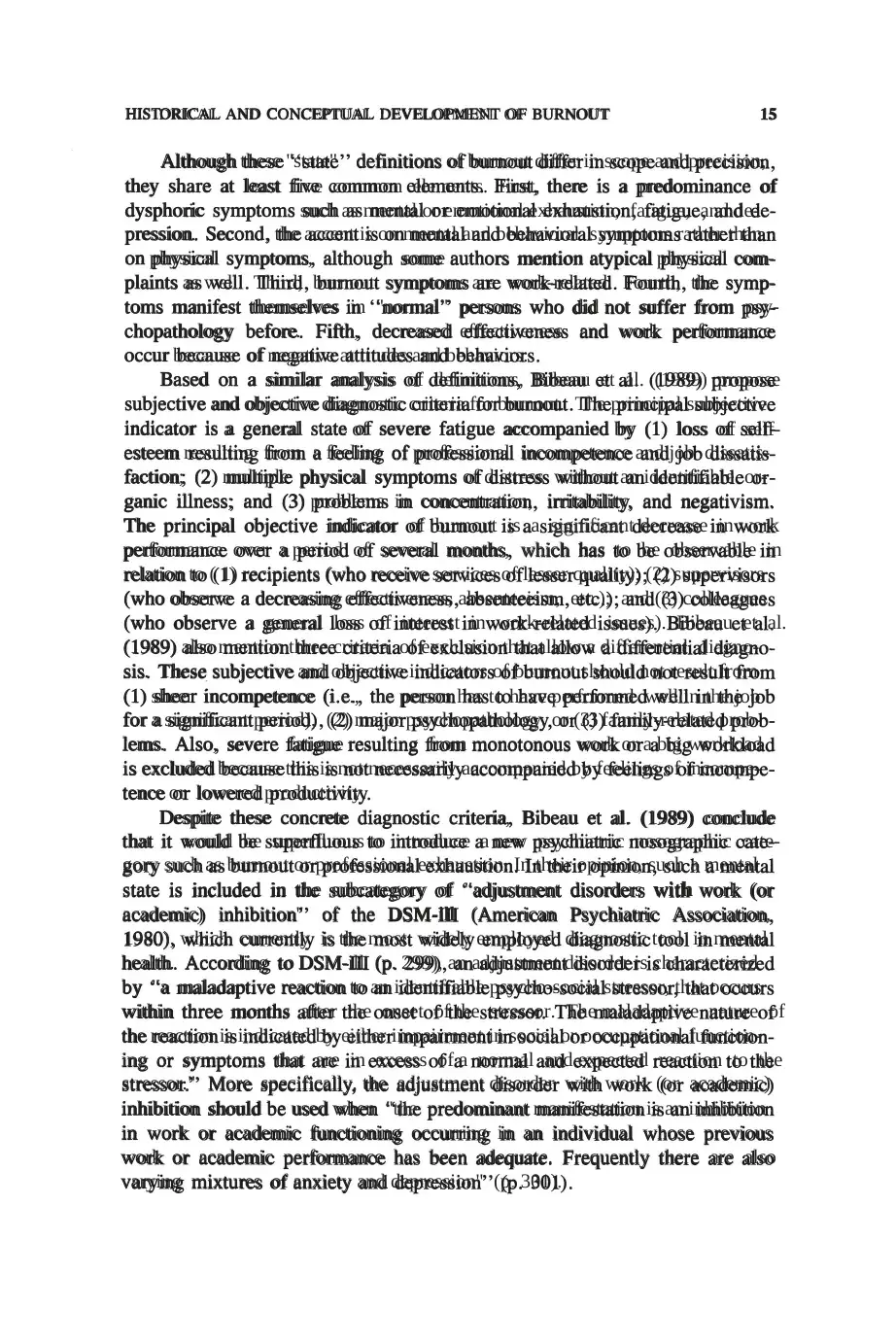
HIS1DRICAL AND CONCEPTUAL DEVELOPMENT OF BURNOUT 15
Although these ''state'' definitions of burnout differ in scope and precision,
they share at least five common elements. First, there is a predominance of
dysphoric symptoms such as mental or emotional exhaustion, fatigue, and de-
pression. Second, the accent is on mental and behavioral symptoms rather than
on physical symptoms, although some authors mention atypical physical com-
plaints as well. Third, burnout symptoms are work-related. Fourth, the symp-
toms manifest themselves in "normal" persons who did not suffer from psy-
chopathology before. Fifth, decreased effectiveness and work performance
occur because of negative attitudes and behaviors.
Based on a similar analysis of definitions, Bibeau et al. (1989) propose
subjective and objective diagnostic criteria for burnout. The principal subjective
indicator is a general state of severe fatigue accompanied by (1) loss of self-
esteem resulting from a feeling of professional incompetence and job dissatis-
faction; (2) multiple physical symptoms of distress without an identifiable or-
ganic illness; and (3) problems in concentration, irritability, and negativism.
The principal objective indicator of burnout is a significant decrease in work
performance over a period of several months, which has to be observable in
relation to ( 1) recipients (who receive services of lesser quality); (2) supervisors
(who observe a decreasing effectiveness, absenteeism, etc.); and (3) colleagues
(who observe a general loss of interest in work-related issues). Bibeau et al.
(1989) also mention three criteria of exclusion that allow a differential diagno-
sis. These subjective and objective indicators of burnout should not result from
(1) sheer incompetence (i.e., the person has to have performed well in the job
for a significant period), (2) major psychopathology, or (3) family-related prob-
lems. Also, severe fatigue resulting from monotonous work or a big workload
is excluded because this is not necessarily accompanied by feelings of incompe-
tence or lowered productivity.
Despite these concrete diagnostic criteria, Bibeau et al. (1989) conclude
that it would be superfluous to introduce a new psychiatric nosographic cate-
gory such as burnout or professional exhaustion. In their opinion, such a mental
state is included in the subcategory of "adjustment disorders with work (or
academic) inhibition" of the DSM-ill (American Psychiatric Association,
1980), which currently is the most widely employed diagnostic tool in mental
health. According to DSM-ill (p. 299), an adjustment disorder is characterized
by "a maladaptive reaction to an identifiable psycho-social stressor, that occurs
within three months after the onset of the stressor. The maladaptive nature of
the reaction is indicated by either impairment in social or occupational function-
ing or symptoms that are in excess of a normal and expected reaction to the
stressor." More specifically, the adjustment disorder with work (or academic)
inhibition should be used when ''the predominant manifestation is an inhibition
in work or academic functioning occurring in an individual whose previous
work or academic performance has been adequate. Frequently there are also
varying mixtures of anxiety and depression" (p. 301).
Although these ''state'' definitions of burnout differ in scope and precision,
they share at least five common elements. First, there is a predominance of
dysphoric symptoms such as mental or emotional exhaustion, fatigue, and de-
pression. Second, the accent is on mental and behavioral symptoms rather than
on physical symptoms, although some authors mention atypical physical com-
plaints as well. Third, burnout symptoms are work-related. Fourth, the symp-
toms manifest themselves in "normal" persons who did not suffer from psy-
chopathology before. Fifth, decreased effectiveness and work performance
occur because of negative attitudes and behaviors.
Based on a similar analysis of definitions, Bibeau et al. (1989) propose
subjective and objective diagnostic criteria for burnout. The principal subjective
indicator is a general state of severe fatigue accompanied by (1) loss of self-
esteem resulting from a feeling of professional incompetence and job dissatis-
faction; (2) multiple physical symptoms of distress without an identifiable or-
ganic illness; and (3) problems in concentration, irritability, and negativism.
The principal objective indicator of burnout is a significant decrease in work
performance over a period of several months, which has to be observable in
relation to ( 1) recipients (who receive services of lesser quality); (2) supervisors
(who observe a decreasing effectiveness, absenteeism, etc.); and (3) colleagues
(who observe a general loss of interest in work-related issues). Bibeau et al.
(1989) also mention three criteria of exclusion that allow a differential diagno-
sis. These subjective and objective indicators of burnout should not result from
(1) sheer incompetence (i.e., the person has to have performed well in the job
for a significant period), (2) major psychopathology, or (3) family-related prob-
lems. Also, severe fatigue resulting from monotonous work or a big workload
is excluded because this is not necessarily accompanied by feelings of incompe-
tence or lowered productivity.
Despite these concrete diagnostic criteria, Bibeau et al. (1989) conclude
that it would be superfluous to introduce a new psychiatric nosographic cate-
gory such as burnout or professional exhaustion. In their opinion, such a mental
state is included in the subcategory of "adjustment disorders with work (or
academic) inhibition" of the DSM-ill (American Psychiatric Association,
1980), which currently is the most widely employed diagnostic tool in mental
health. According to DSM-ill (p. 299), an adjustment disorder is characterized
by "a maladaptive reaction to an identifiable psycho-social stressor, that occurs
within three months after the onset of the stressor. The maladaptive nature of
the reaction is indicated by either impairment in social or occupational function-
ing or symptoms that are in excess of a normal and expected reaction to the
stressor." More specifically, the adjustment disorder with work (or academic)
inhibition should be used when ''the predominant manifestation is an inhibition
in work or academic functioning occurring in an individual whose previous
work or academic performance has been adequate. Frequently there are also
varying mixtures of anxiety and depression" (p. 301).
Secure Best Marks with AI Grader
Need help grading? Try our AI Grader for instant feedback on your assignments.
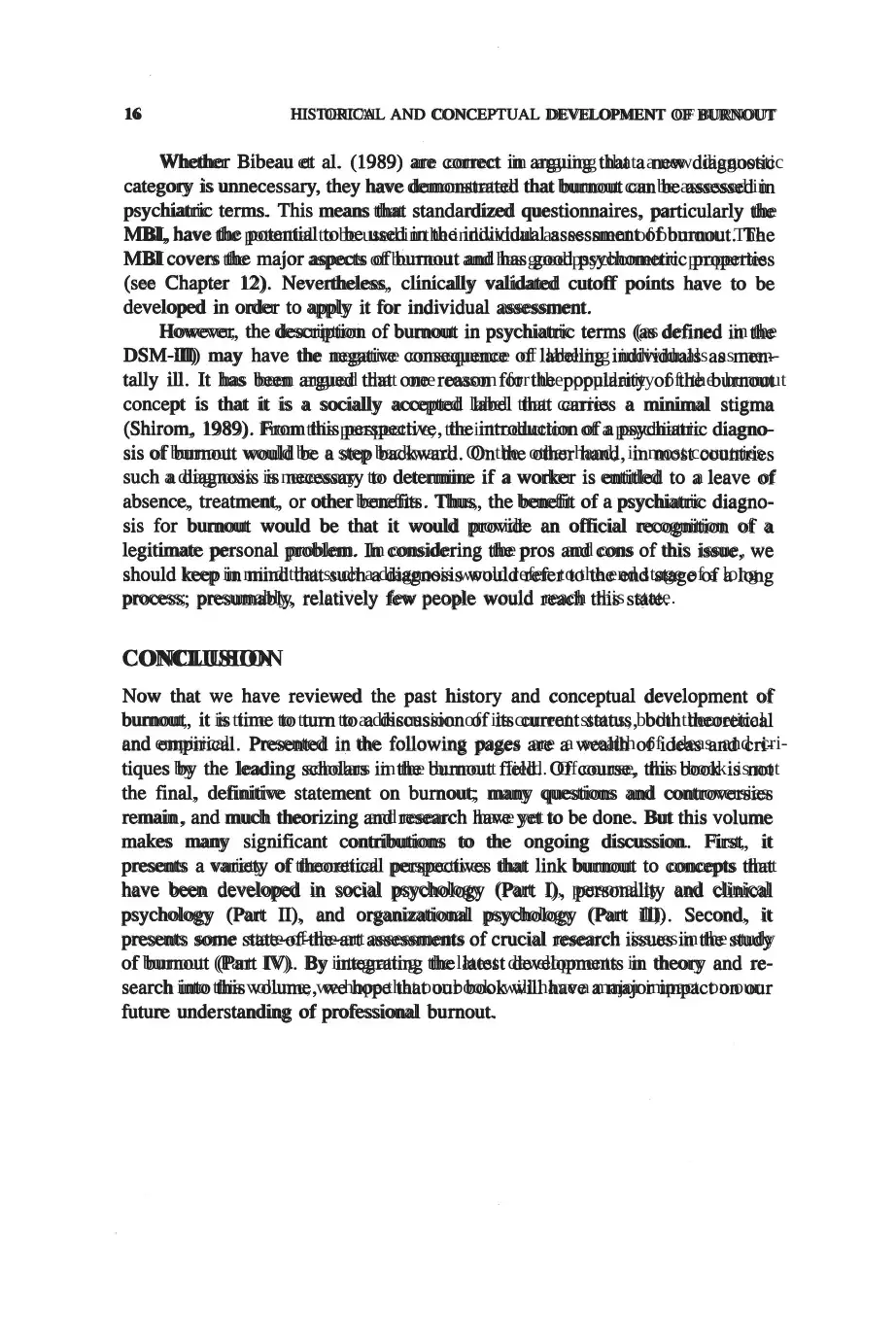
16 HIS10RICAL AND CONCEPTUAL DEVELOPMENT OF BURNOUT
Whether Bibeau et al. (1989) are correct in arguing that a new diagnostic
category is unnecessary, they have demonstrated that burnout can be assessed in
psychiatric terms. This means that standardized questionnaires, particularly the
MBI, have the potential to be used in the individual assessment of burnout. The
MBI covers the major aspects of burnout and has good psychometric properties
(see Chapter 12). Nevertheless, clinically validated cutoff points have to be
developed in order to apply it for individual assessment.
However, the description of burnout in psychiatric terms (as defined in the
DSM-ill) may have the negative consequence of labeling individuals as men-
tally ill. It has been argued that one reason for the popularity of the burnout
concept is that it is a socially accepted label that carries a minimal stigma
(Shirom, 1989). From this perspective, the introduction of a psychiatric diagno-
sis of burnout would be a step backward. On the other hand, in most countries
such a diagnosis is necessary to determine if a worker is entitled to a leave of
absence, treatment, or other benefits . Thus, the benefit of a psychiatric diagno-
sis for burnout would be that it would provide an official recognition of a
legitimate personal problem. In considering the pros and cons of this issue, we
should keep in mind that such a diagnosis would refer to the end stage of a long
process; presumably, relatively few people would reach this state.
CONCLUSION
Now that we have reviewed the past history and conceptual development of
burnout, it is time to tum to a discussion of its current status, both theoretical
and empirical. Presented in the following pages are a wealth of ideas and cri-
tiques by the leading scholars in the burnout field. Of course, this book is not
the final, definitive statement on burnout; many questions and controversies
remain , and much theorizing and research have yet to be done. But this volume
makes many significant contributions to the ongoing discussion. First, it
presents a variety of theoretical perspectives that link burnout to concepts that
have been developed in social psychology (Part I), personality and clinical
psychology (Part II), and organizational psychology (Part ill). Second, it
presents some state-of-the-art assessments of crucial research issues in the study
of burnout (Part IV). By integrating the latest developments in theory and re-
search into this volume, we hope that our book will have a major impact on our
future understanding of professional burnout.
Whether Bibeau et al. (1989) are correct in arguing that a new diagnostic
category is unnecessary, they have demonstrated that burnout can be assessed in
psychiatric terms. This means that standardized questionnaires, particularly the
MBI, have the potential to be used in the individual assessment of burnout. The
MBI covers the major aspects of burnout and has good psychometric properties
(see Chapter 12). Nevertheless, clinically validated cutoff points have to be
developed in order to apply it for individual assessment.
However, the description of burnout in psychiatric terms (as defined in the
DSM-ill) may have the negative consequence of labeling individuals as men-
tally ill. It has been argued that one reason for the popularity of the burnout
concept is that it is a socially accepted label that carries a minimal stigma
(Shirom, 1989). From this perspective, the introduction of a psychiatric diagno-
sis of burnout would be a step backward. On the other hand, in most countries
such a diagnosis is necessary to determine if a worker is entitled to a leave of
absence, treatment, or other benefits . Thus, the benefit of a psychiatric diagno-
sis for burnout would be that it would provide an official recognition of a
legitimate personal problem. In considering the pros and cons of this issue, we
should keep in mind that such a diagnosis would refer to the end stage of a long
process; presumably, relatively few people would reach this state.
CONCLUSION
Now that we have reviewed the past history and conceptual development of
burnout, it is time to tum to a discussion of its current status, both theoretical
and empirical. Presented in the following pages are a wealth of ideas and cri-
tiques by the leading scholars in the burnout field. Of course, this book is not
the final, definitive statement on burnout; many questions and controversies
remain , and much theorizing and research have yet to be done. But this volume
makes many significant contributions to the ongoing discussion. First, it
presents a variety of theoretical perspectives that link burnout to concepts that
have been developed in social psychology (Part I), personality and clinical
psychology (Part II), and organizational psychology (Part ill). Second, it
presents some state-of-the-art assessments of crucial research issues in the study
of burnout (Part IV). By integrating the latest developments in theory and re-
search into this volume, we hope that our book will have a major impact on our
future understanding of professional burnout.
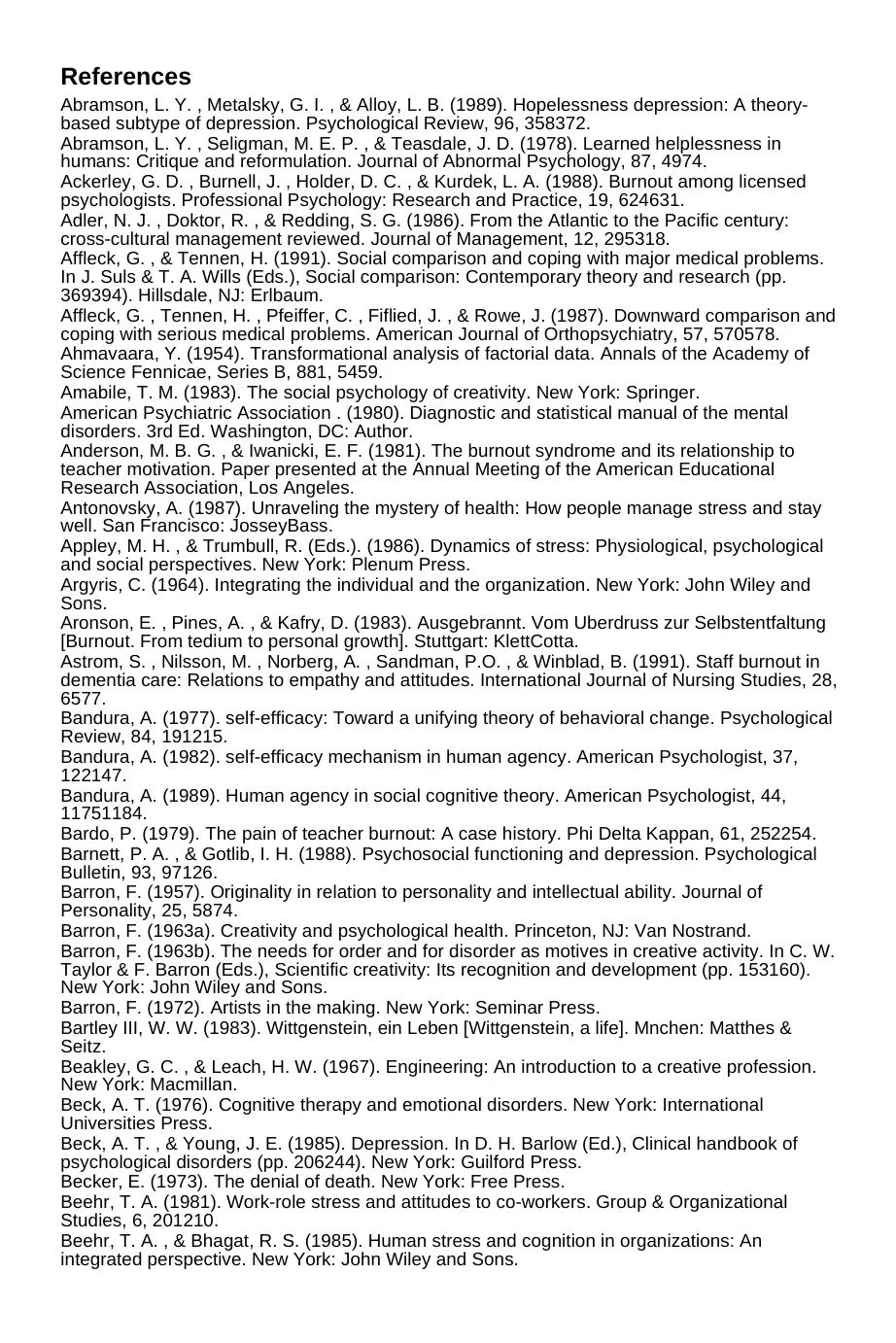
References
Abramson, L. Y. , Metalsky, G. I. , & Alloy, L. B. (1989). Hopelessness depression: A theory-
based subtype of depression. Psychological Review, 96, 358372.
Abramson, L. Y. , Seligman, M. E. P. , & Teasdale, J. D. (1978). Learned helplessness in
humans: Critique and reformulation. Journal of Abnormal Psychology, 87, 4974.
Ackerley, G. D. , Burnell, J. , Holder, D. C. , & Kurdek, L. A. (1988). Burnout among licensed
psychologists. Professional Psychology: Research and Practice, 19, 624631.
Adler, N. J. , Doktor, R. , & Redding, S. G. (1986). From the Atlantic to the Pacific century:
cross-cultural management reviewed. Journal of Management, 12, 295318.
Affleck, G. , & Tennen, H. (1991). Social comparison and coping with major medical problems.
In J. Suls & T. A. Wills (Eds.), Social comparison: Contemporary theory and research (pp.
369394). Hillsdale, NJ: Erlbaum.
Affleck, G. , Tennen, H. , Pfeiffer, C. , Fiflied, J. , & Rowe, J. (1987). Downward comparison and
coping with serious medical problems. American Journal of Orthopsychiatry, 57, 570578.
Ahmavaara, Y. (1954). Transformational analysis of factorial data. Annals of the Academy of
Science Fennicae, Series B, 881, 5459.
Amabile, T. M. (1983). The social psychology of creativity. New York: Springer.
American Psychiatric Association . (1980). Diagnostic and statistical manual of the mental
disorders. 3rd Ed. Washington, DC: Author.
Anderson, M. B. G. , & Iwanicki, E. F. (1981). The burnout syndrome and its relationship to
teacher motivation. Paper presented at the Annual Meeting of the American Educational
Research Association, Los Angeles.
Antonovsky, A. (1987). Unraveling the mystery of health: How people manage stress and stay
well. San Francisco: JosseyBass.
Appley, M. H. , & Trumbull, R. (Eds.). (1986). Dynamics of stress: Physiological, psychological
and social perspectives. New York: Plenum Press.
Argyris, C. (1964). Integrating the individual and the organization. New York: John Wiley and
Sons.
Aronson, E. , Pines, A. , & Kafry, D. (1983). Ausgebrannt. Vom Uberdruss zur Selbstentfaltung
[Burnout. From tedium to personal growth]. Stuttgart: KlettCotta.
Astrom, S. , Nilsson, M. , Norberg, A. , Sandman, P.O. , & Winblad, B. (1991). Staff burnout in
dementia care: Relations to empathy and attitudes. International Journal of Nursing Studies, 28,
6577.
Bandura, A. (1977). self-efficacy: Toward a unifying theory of behavioral change. Psychological
Review, 84, 191215.
Bandura, A. (1982). self-efficacy mechanism in human agency. American Psychologist, 37,
122147.
Bandura, A. (1989). Human agency in social cognitive theory. American Psychologist, 44,
11751184.
Bardo, P. (1979). The pain of teacher burnout: A case history. Phi Delta Kappan, 61, 252254.
Barnett, P. A. , & Gotlib, I. H. (1988). Psychosocial functioning and depression. Psychological
Bulletin, 93, 97126.
Barron, F. (1957). Originality in relation to personality and intellectual ability. Journal of
Personality, 25, 5874.
Barron, F. (1963a). Creativity and psychological health. Princeton, NJ: Van Nostrand.
Barron, F. (1963b). The needs for order and for disorder as motives in creative activity. In C. W.
Taylor & F. Barron (Eds.), Scientific creativity: Its recognition and development (pp. 153160).
New York: John Wiley and Sons.
Barron, F. (1972). Artists in the making. New York: Seminar Press.
Bartley III, W. W. (1983). Wittgenstein, ein Leben [Wittgenstein, a life]. Mnchen: Matthes &
Seitz.
Beakley, G. C. , & Leach, H. W. (1967). Engineering: An introduction to a creative profession.
New York: Macmillan.
Beck, A. T. (1976). Cognitive therapy and emotional disorders. New York: International
Universities Press.
Beck, A. T. , & Young, J. E. (1985). Depression. In D. H. Barlow (Ed.), Clinical handbook of
psychological disorders (pp. 206244). New York: Guilford Press.
Becker, E. (1973). The denial of death. New York: Free Press.
Beehr, T. A. (1981). Work-role stress and attitudes to co-workers. Group & Organizational
Studies, 6, 201210.
Beehr, T. A. , & Bhagat, R. S. (1985). Human stress and cognition in organizations: An
integrated perspective. New York: John Wiley and Sons.
Abramson, L. Y. , Metalsky, G. I. , & Alloy, L. B. (1989). Hopelessness depression: A theory-
based subtype of depression. Psychological Review, 96, 358372.
Abramson, L. Y. , Seligman, M. E. P. , & Teasdale, J. D. (1978). Learned helplessness in
humans: Critique and reformulation. Journal of Abnormal Psychology, 87, 4974.
Ackerley, G. D. , Burnell, J. , Holder, D. C. , & Kurdek, L. A. (1988). Burnout among licensed
psychologists. Professional Psychology: Research and Practice, 19, 624631.
Adler, N. J. , Doktor, R. , & Redding, S. G. (1986). From the Atlantic to the Pacific century:
cross-cultural management reviewed. Journal of Management, 12, 295318.
Affleck, G. , & Tennen, H. (1991). Social comparison and coping with major medical problems.
In J. Suls & T. A. Wills (Eds.), Social comparison: Contemporary theory and research (pp.
369394). Hillsdale, NJ: Erlbaum.
Affleck, G. , Tennen, H. , Pfeiffer, C. , Fiflied, J. , & Rowe, J. (1987). Downward comparison and
coping with serious medical problems. American Journal of Orthopsychiatry, 57, 570578.
Ahmavaara, Y. (1954). Transformational analysis of factorial data. Annals of the Academy of
Science Fennicae, Series B, 881, 5459.
Amabile, T. M. (1983). The social psychology of creativity. New York: Springer.
American Psychiatric Association . (1980). Diagnostic and statistical manual of the mental
disorders. 3rd Ed. Washington, DC: Author.
Anderson, M. B. G. , & Iwanicki, E. F. (1981). The burnout syndrome and its relationship to
teacher motivation. Paper presented at the Annual Meeting of the American Educational
Research Association, Los Angeles.
Antonovsky, A. (1987). Unraveling the mystery of health: How people manage stress and stay
well. San Francisco: JosseyBass.
Appley, M. H. , & Trumbull, R. (Eds.). (1986). Dynamics of stress: Physiological, psychological
and social perspectives. New York: Plenum Press.
Argyris, C. (1964). Integrating the individual and the organization. New York: John Wiley and
Sons.
Aronson, E. , Pines, A. , & Kafry, D. (1983). Ausgebrannt. Vom Uberdruss zur Selbstentfaltung
[Burnout. From tedium to personal growth]. Stuttgart: KlettCotta.
Astrom, S. , Nilsson, M. , Norberg, A. , Sandman, P.O. , & Winblad, B. (1991). Staff burnout in
dementia care: Relations to empathy and attitudes. International Journal of Nursing Studies, 28,
6577.
Bandura, A. (1977). self-efficacy: Toward a unifying theory of behavioral change. Psychological
Review, 84, 191215.
Bandura, A. (1982). self-efficacy mechanism in human agency. American Psychologist, 37,
122147.
Bandura, A. (1989). Human agency in social cognitive theory. American Psychologist, 44,
11751184.
Bardo, P. (1979). The pain of teacher burnout: A case history. Phi Delta Kappan, 61, 252254.
Barnett, P. A. , & Gotlib, I. H. (1988). Psychosocial functioning and depression. Psychological
Bulletin, 93, 97126.
Barron, F. (1957). Originality in relation to personality and intellectual ability. Journal of
Personality, 25, 5874.
Barron, F. (1963a). Creativity and psychological health. Princeton, NJ: Van Nostrand.
Barron, F. (1963b). The needs for order and for disorder as motives in creative activity. In C. W.
Taylor & F. Barron (Eds.), Scientific creativity: Its recognition and development (pp. 153160).
New York: John Wiley and Sons.
Barron, F. (1972). Artists in the making. New York: Seminar Press.
Bartley III, W. W. (1983). Wittgenstein, ein Leben [Wittgenstein, a life]. Mnchen: Matthes &
Seitz.
Beakley, G. C. , & Leach, H. W. (1967). Engineering: An introduction to a creative profession.
New York: Macmillan.
Beck, A. T. (1976). Cognitive therapy and emotional disorders. New York: International
Universities Press.
Beck, A. T. , & Young, J. E. (1985). Depression. In D. H. Barlow (Ed.), Clinical handbook of
psychological disorders (pp. 206244). New York: Guilford Press.
Becker, E. (1973). The denial of death. New York: Free Press.
Beehr, T. A. (1981). Work-role stress and attitudes to co-workers. Group & Organizational
Studies, 6, 201210.
Beehr, T. A. , & Bhagat, R. S. (1985). Human stress and cognition in organizations: An
integrated perspective. New York: John Wiley and Sons.
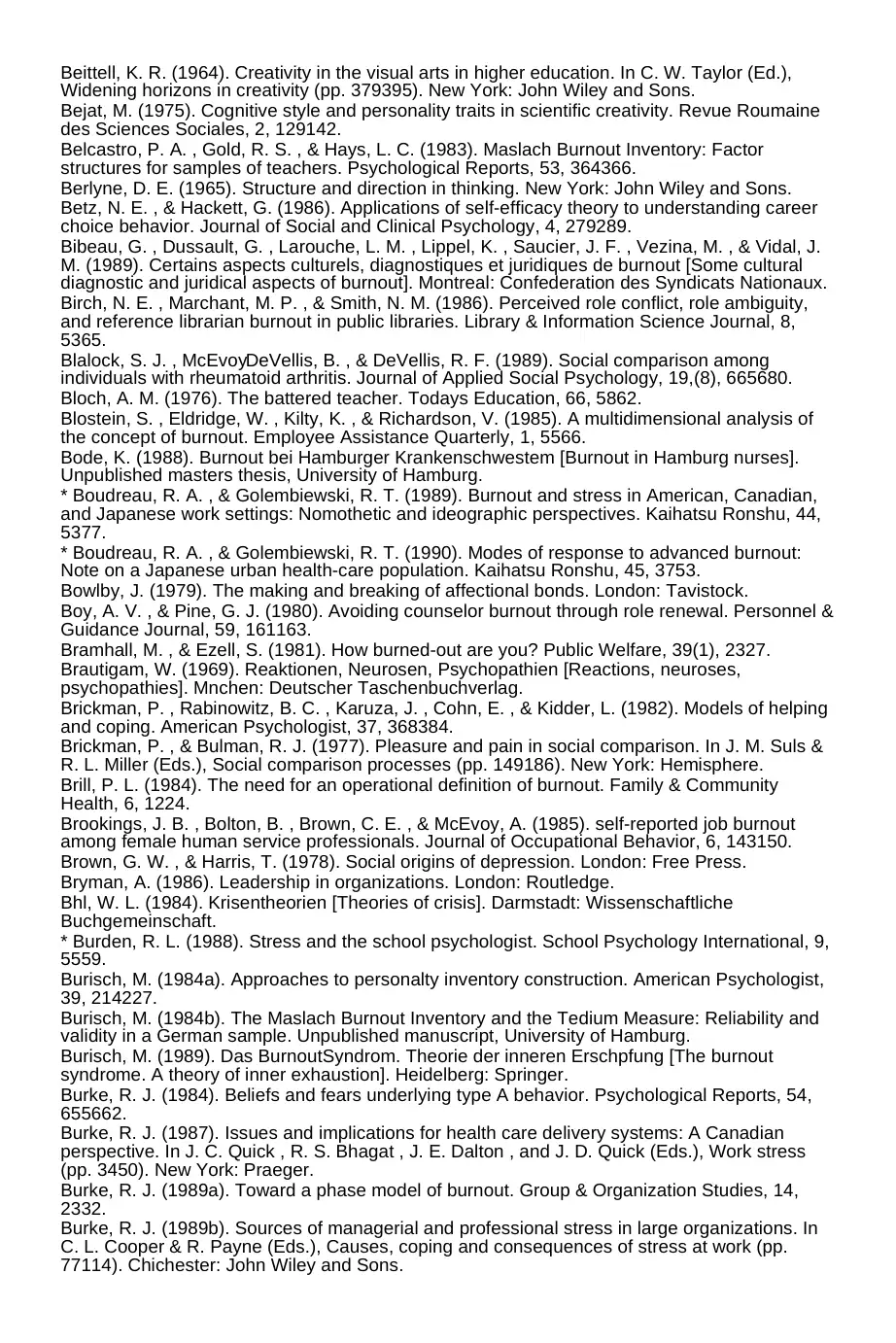
Beittell, K. R. (1964). Creativity in the visual arts in higher education. In C. W. Taylor (Ed.),
Widening horizons in creativity (pp. 379395). New York: John Wiley and Sons.
Bejat, M. (1975). Cognitive style and personality traits in scientific creativity. Revue Roumaine
des Sciences Sociales, 2, 129142.
Belcastro, P. A. , Gold, R. S. , & Hays, L. C. (1983). Maslach Burnout Inventory: Factor
structures for samples of teachers. Psychological Reports, 53, 364366.
Berlyne, D. E. (1965). Structure and direction in thinking. New York: John Wiley and Sons.
Betz, N. E. , & Hackett, G. (1986). Applications of self-efficacy theory to understanding career
choice behavior. Journal of Social and Clinical Psychology, 4, 279289.
Bibeau, G. , Dussault, G. , Larouche, L. M. , Lippel, K. , Saucier, J. F. , Vezina, M. , & Vidal, J.
M. (1989). Certains aspects culturels, diagnostiques et juridiques de burnout [Some cultural
diagnostic and juridical aspects of burnout]. Montreal: Confederation des Syndicats Nationaux.
Birch, N. E. , Marchant, M. P. , & Smith, N. M. (1986). Perceived role conflict, role ambiguity,
and reference librarian burnout in public libraries. Library & Information Science Journal, 8,
5365.
Blalock, S. J. , McEvoyDeVellis, B. , & DeVellis, R. F. (1989). Social comparison among
individuals with rheumatoid arthritis. Journal of Applied Social Psychology, 19,(8), 665680.
Bloch, A. M. (1976). The battered teacher. Todays Education, 66, 5862.
Blostein, S. , Eldridge, W. , Kilty, K. , & Richardson, V. (1985). A multidimensional analysis of
the concept of burnout. Employee Assistance Quarterly, 1, 5566.
Bode, K. (1988). Burnout bei Hamburger Krankenschwestem [Burnout in Hamburg nurses].
Unpublished masters thesis, University of Hamburg.
* Boudreau, R. A. , & Golembiewski, R. T. (1989). Burnout and stress in American, Canadian,
and Japanese work settings: Nomothetic and ideographic perspectives. Kaihatsu Ronshu, 44,
5377.
* Boudreau, R. A. , & Golembiewski, R. T. (1990). Modes of response to advanced burnout:
Note on a Japanese urban health-care population. Kaihatsu Ronshu, 45, 3753.
Bowlby, J. (1979). The making and breaking of affectional bonds. London: Tavistock.
Boy, A. V. , & Pine, G. J. (1980). Avoiding counselor burnout through role renewal. Personnel &
Guidance Journal, 59, 161163.
Bramhall, M. , & Ezell, S. (1981). How burned-out are you? Public Welfare, 39(1), 2327.
Brautigam, W. (1969). Reaktionen, Neurosen, Psychopathien [Reactions, neuroses,
psychopathies]. Mnchen: Deutscher Taschenbuchverlag.
Brickman, P. , Rabinowitz, B. C. , Karuza, J. , Cohn, E. , & Kidder, L. (1982). Models of helping
and coping. American Psychologist, 37, 368384.
Brickman, P. , & Bulman, R. J. (1977). Pleasure and pain in social comparison. In J. M. Suls &
R. L. Miller (Eds.), Social comparison processes (pp. 149186). New York: Hemisphere.
Brill, P. L. (1984). The need for an operational definition of burnout. Family & Community
Health, 6, 1224.
Brookings, J. B. , Bolton, B. , Brown, C. E. , & McEvoy, A. (1985). self-reported job burnout
among female human service professionals. Journal of Occupational Behavior, 6, 143150.
Brown, G. W. , & Harris, T. (1978). Social origins of depression. London: Free Press.
Bryman, A. (1986). Leadership in organizations. London: Routledge.
Bhl, W. L. (1984). Krisentheorien [Theories of crisis]. Darmstadt: Wissenschaftliche
Buchgemeinschaft.
* Burden, R. L. (1988). Stress and the school psychologist. School Psychology International, 9,
5559.
Burisch, M. (1984a). Approaches to personalty inventory construction. American Psychologist,
39, 214227.
Burisch, M. (1984b). The Maslach Burnout Inventory and the Tedium Measure: Reliability and
validity in a German sample. Unpublished manuscript, University of Hamburg.
Burisch, M. (1989). Das BurnoutSyndrom. Theorie der inneren Erschpfung [The burnout
syndrome. A theory of inner exhaustion]. Heidelberg: Springer.
Burke, R. J. (1984). Beliefs and fears underlying type A behavior. Psychological Reports, 54,
655662.
Burke, R. J. (1987). Issues and implications for health care delivery systems: A Canadian
perspective. In J. C. Quick , R. S. Bhagat , J. E. Dalton , and J. D. Quick (Eds.), Work stress
(pp. 3450). New York: Praeger.
Burke, R. J. (1989a). Toward a phase model of burnout. Group & Organization Studies, 14,
2332.
Burke, R. J. (1989b). Sources of managerial and professional stress in large organizations. In
C. L. Cooper & R. Payne (Eds.), Causes, coping and consequences of stress at work (pp.
77114). Chichester: John Wiley and Sons.
Widening horizons in creativity (pp. 379395). New York: John Wiley and Sons.
Bejat, M. (1975). Cognitive style and personality traits in scientific creativity. Revue Roumaine
des Sciences Sociales, 2, 129142.
Belcastro, P. A. , Gold, R. S. , & Hays, L. C. (1983). Maslach Burnout Inventory: Factor
structures for samples of teachers. Psychological Reports, 53, 364366.
Berlyne, D. E. (1965). Structure and direction in thinking. New York: John Wiley and Sons.
Betz, N. E. , & Hackett, G. (1986). Applications of self-efficacy theory to understanding career
choice behavior. Journal of Social and Clinical Psychology, 4, 279289.
Bibeau, G. , Dussault, G. , Larouche, L. M. , Lippel, K. , Saucier, J. F. , Vezina, M. , & Vidal, J.
M. (1989). Certains aspects culturels, diagnostiques et juridiques de burnout [Some cultural
diagnostic and juridical aspects of burnout]. Montreal: Confederation des Syndicats Nationaux.
Birch, N. E. , Marchant, M. P. , & Smith, N. M. (1986). Perceived role conflict, role ambiguity,
and reference librarian burnout in public libraries. Library & Information Science Journal, 8,
5365.
Blalock, S. J. , McEvoyDeVellis, B. , & DeVellis, R. F. (1989). Social comparison among
individuals with rheumatoid arthritis. Journal of Applied Social Psychology, 19,(8), 665680.
Bloch, A. M. (1976). The battered teacher. Todays Education, 66, 5862.
Blostein, S. , Eldridge, W. , Kilty, K. , & Richardson, V. (1985). A multidimensional analysis of
the concept of burnout. Employee Assistance Quarterly, 1, 5566.
Bode, K. (1988). Burnout bei Hamburger Krankenschwestem [Burnout in Hamburg nurses].
Unpublished masters thesis, University of Hamburg.
* Boudreau, R. A. , & Golembiewski, R. T. (1989). Burnout and stress in American, Canadian,
and Japanese work settings: Nomothetic and ideographic perspectives. Kaihatsu Ronshu, 44,
5377.
* Boudreau, R. A. , & Golembiewski, R. T. (1990). Modes of response to advanced burnout:
Note on a Japanese urban health-care population. Kaihatsu Ronshu, 45, 3753.
Bowlby, J. (1979). The making and breaking of affectional bonds. London: Tavistock.
Boy, A. V. , & Pine, G. J. (1980). Avoiding counselor burnout through role renewal. Personnel &
Guidance Journal, 59, 161163.
Bramhall, M. , & Ezell, S. (1981). How burned-out are you? Public Welfare, 39(1), 2327.
Brautigam, W. (1969). Reaktionen, Neurosen, Psychopathien [Reactions, neuroses,
psychopathies]. Mnchen: Deutscher Taschenbuchverlag.
Brickman, P. , Rabinowitz, B. C. , Karuza, J. , Cohn, E. , & Kidder, L. (1982). Models of helping
and coping. American Psychologist, 37, 368384.
Brickman, P. , & Bulman, R. J. (1977). Pleasure and pain in social comparison. In J. M. Suls &
R. L. Miller (Eds.), Social comparison processes (pp. 149186). New York: Hemisphere.
Brill, P. L. (1984). The need for an operational definition of burnout. Family & Community
Health, 6, 1224.
Brookings, J. B. , Bolton, B. , Brown, C. E. , & McEvoy, A. (1985). self-reported job burnout
among female human service professionals. Journal of Occupational Behavior, 6, 143150.
Brown, G. W. , & Harris, T. (1978). Social origins of depression. London: Free Press.
Bryman, A. (1986). Leadership in organizations. London: Routledge.
Bhl, W. L. (1984). Krisentheorien [Theories of crisis]. Darmstadt: Wissenschaftliche
Buchgemeinschaft.
* Burden, R. L. (1988). Stress and the school psychologist. School Psychology International, 9,
5559.
Burisch, M. (1984a). Approaches to personalty inventory construction. American Psychologist,
39, 214227.
Burisch, M. (1984b). The Maslach Burnout Inventory and the Tedium Measure: Reliability and
validity in a German sample. Unpublished manuscript, University of Hamburg.
Burisch, M. (1989). Das BurnoutSyndrom. Theorie der inneren Erschpfung [The burnout
syndrome. A theory of inner exhaustion]. Heidelberg: Springer.
Burke, R. J. (1984). Beliefs and fears underlying type A behavior. Psychological Reports, 54,
655662.
Burke, R. J. (1987). Issues and implications for health care delivery systems: A Canadian
perspective. In J. C. Quick , R. S. Bhagat , J. E. Dalton , and J. D. Quick (Eds.), Work stress
(pp. 3450). New York: Praeger.
Burke, R. J. (1989a). Toward a phase model of burnout. Group & Organization Studies, 14,
2332.
Burke, R. J. (1989b). Sources of managerial and professional stress in large organizations. In
C. L. Cooper & R. Payne (Eds.), Causes, coping and consequences of stress at work (pp.
77114). Chichester: John Wiley and Sons.
Paraphrase This Document
Need a fresh take? Get an instant paraphrase of this document with our AI Paraphraser
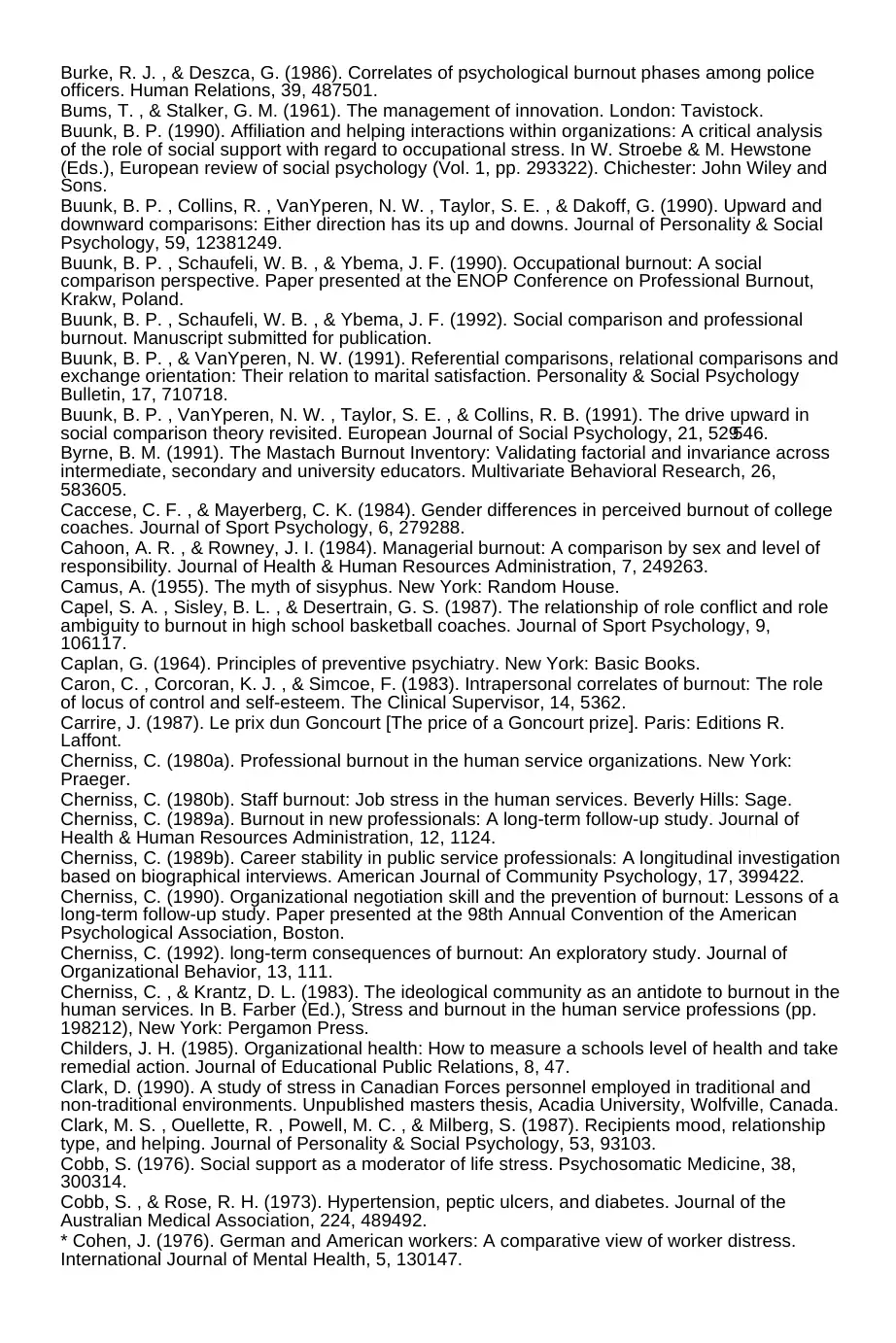
Burke, R. J. , & Deszca, G. (1986). Correlates of psychological burnout phases among police
officers. Human Relations, 39, 487501.
Bums, T. , & Stalker, G. M. (1961). The management of innovation. London: Tavistock.
Buunk, B. P. (1990). Affiliation and helping interactions within organizations: A critical analysis
of the role of social support with regard to occupational stress. In W. Stroebe & M. Hewstone
(Eds.), European review of social psychology (Vol. 1, pp. 293322). Chichester: John Wiley and
Sons.
Buunk, B. P. , Collins, R. , VanYperen, N. W. , Taylor, S. E. , & Dakoff, G. (1990). Upward and
downward comparisons: Either direction has its up and downs. Journal of Personality & Social
Psychology, 59, 12381249.
Buunk, B. P. , Schaufeli, W. B. , & Ybema, J. F. (1990). Occupational burnout: A social
comparison perspective. Paper presented at the ENOP Conference on Professional Burnout,
Krakw, Poland.
Buunk, B. P. , Schaufeli, W. B. , & Ybema, J. F. (1992). Social comparison and professional
burnout. Manuscript submitted for publication.
Buunk, B. P. , & VanYperen, N. W. (1991). Referential comparisons, relational comparisons and
exchange orientation: Their relation to marital satisfaction. Personality & Social Psychology
Bulletin, 17, 710718.
Buunk, B. P. , VanYperen, N. W. , Taylor, S. E. , & Collins, R. B. (1991). The drive upward in
social comparison theory revisited. European Journal of Social Psychology, 21, 529546.
Byrne, B. M. (1991). The Mastach Burnout Inventory: Validating factorial and invariance across
intermediate, secondary and university educators. Multivariate Behavioral Research, 26,
583605.
Caccese, C. F. , & Mayerberg, C. K. (1984). Gender differences in perceived burnout of college
coaches. Journal of Sport Psychology, 6, 279288.
Cahoon, A. R. , & Rowney, J. I. (1984). Managerial burnout: A comparison by sex and level of
responsibility. Journal of Health & Human Resources Administration, 7, 249263.
Camus, A. (1955). The myth of sisyphus. New York: Random House.
Capel, S. A. , Sisley, B. L. , & Desertrain, G. S. (1987). The relationship of role conflict and role
ambiguity to burnout in high school basketball coaches. Journal of Sport Psychology, 9,
106117.
Caplan, G. (1964). Principles of preventive psychiatry. New York: Basic Books.
Caron, C. , Corcoran, K. J. , & Simcoe, F. (1983). Intrapersonal correlates of burnout: The role
of locus of control and self-esteem. The Clinical Supervisor, 14, 5362.
Carrire, J. (1987). Le prix dun Goncourt [The price of a Goncourt prize]. Paris: Editions R.
Laffont.
Cherniss, C. (1980a). Professional burnout in the human service organizations. New York:
Praeger.
Cherniss, C. (1980b). Staff burnout: Job stress in the human services. Beverly Hills: Sage.
Cherniss, C. (1989a). Burnout in new professionals: A long-term follow-up study. Journal of
Health & Human Resources Administration, 12, 1124.
Cherniss, C. (1989b). Career stability in public service professionals: A longitudinal investigation
based on biographical interviews. American Journal of Community Psychology, 17, 399422.
Cherniss, C. (1990). Organizational negotiation skill and the prevention of burnout: Lessons of a
long-term follow-up study. Paper presented at the 98th Annual Convention of the American
Psychological Association, Boston.
Cherniss, C. (1992). long-term consequences of burnout: An exploratory study. Journal of
Organizational Behavior, 13, 111.
Cherniss, C. , & Krantz, D. L. (1983). The ideological community as an antidote to burnout in the
human services. In B. Farber (Ed.), Stress and burnout in the human service professions (pp.
198212), New York: Pergamon Press.
Childers, J. H. (1985). Organizational health: How to measure a schools level of health and take
remedial action. Journal of Educational Public Relations, 8, 47.
Clark, D. (1990). A study of stress in Canadian Forces personnel employed in traditional and
non-traditional environments. Unpublished masters thesis, Acadia University, Wolfville, Canada.
Clark, M. S. , Ouellette, R. , Powell, M. C. , & Milberg, S. (1987). Recipients mood, relationship
type, and helping. Journal of Personality & Social Psychology, 53, 93103.
Cobb, S. (1976). Social support as a moderator of life stress. Psychosomatic Medicine, 38,
300314.
Cobb, S. , & Rose, R. H. (1973). Hypertension, peptic ulcers, and diabetes. Journal of the
Australian Medical Association, 224, 489492.
* Cohen, J. (1976). German and American workers: A comparative view of worker distress.
International Journal of Mental Health, 5, 130147.
officers. Human Relations, 39, 487501.
Bums, T. , & Stalker, G. M. (1961). The management of innovation. London: Tavistock.
Buunk, B. P. (1990). Affiliation and helping interactions within organizations: A critical analysis
of the role of social support with regard to occupational stress. In W. Stroebe & M. Hewstone
(Eds.), European review of social psychology (Vol. 1, pp. 293322). Chichester: John Wiley and
Sons.
Buunk, B. P. , Collins, R. , VanYperen, N. W. , Taylor, S. E. , & Dakoff, G. (1990). Upward and
downward comparisons: Either direction has its up and downs. Journal of Personality & Social
Psychology, 59, 12381249.
Buunk, B. P. , Schaufeli, W. B. , & Ybema, J. F. (1990). Occupational burnout: A social
comparison perspective. Paper presented at the ENOP Conference on Professional Burnout,
Krakw, Poland.
Buunk, B. P. , Schaufeli, W. B. , & Ybema, J. F. (1992). Social comparison and professional
burnout. Manuscript submitted for publication.
Buunk, B. P. , & VanYperen, N. W. (1991). Referential comparisons, relational comparisons and
exchange orientation: Their relation to marital satisfaction. Personality & Social Psychology
Bulletin, 17, 710718.
Buunk, B. P. , VanYperen, N. W. , Taylor, S. E. , & Collins, R. B. (1991). The drive upward in
social comparison theory revisited. European Journal of Social Psychology, 21, 529546.
Byrne, B. M. (1991). The Mastach Burnout Inventory: Validating factorial and invariance across
intermediate, secondary and university educators. Multivariate Behavioral Research, 26,
583605.
Caccese, C. F. , & Mayerberg, C. K. (1984). Gender differences in perceived burnout of college
coaches. Journal of Sport Psychology, 6, 279288.
Cahoon, A. R. , & Rowney, J. I. (1984). Managerial burnout: A comparison by sex and level of
responsibility. Journal of Health & Human Resources Administration, 7, 249263.
Camus, A. (1955). The myth of sisyphus. New York: Random House.
Capel, S. A. , Sisley, B. L. , & Desertrain, G. S. (1987). The relationship of role conflict and role
ambiguity to burnout in high school basketball coaches. Journal of Sport Psychology, 9,
106117.
Caplan, G. (1964). Principles of preventive psychiatry. New York: Basic Books.
Caron, C. , Corcoran, K. J. , & Simcoe, F. (1983). Intrapersonal correlates of burnout: The role
of locus of control and self-esteem. The Clinical Supervisor, 14, 5362.
Carrire, J. (1987). Le prix dun Goncourt [The price of a Goncourt prize]. Paris: Editions R.
Laffont.
Cherniss, C. (1980a). Professional burnout in the human service organizations. New York:
Praeger.
Cherniss, C. (1980b). Staff burnout: Job stress in the human services. Beverly Hills: Sage.
Cherniss, C. (1989a). Burnout in new professionals: A long-term follow-up study. Journal of
Health & Human Resources Administration, 12, 1124.
Cherniss, C. (1989b). Career stability in public service professionals: A longitudinal investigation
based on biographical interviews. American Journal of Community Psychology, 17, 399422.
Cherniss, C. (1990). Organizational negotiation skill and the prevention of burnout: Lessons of a
long-term follow-up study. Paper presented at the 98th Annual Convention of the American
Psychological Association, Boston.
Cherniss, C. (1992). long-term consequences of burnout: An exploratory study. Journal of
Organizational Behavior, 13, 111.
Cherniss, C. , & Krantz, D. L. (1983). The ideological community as an antidote to burnout in the
human services. In B. Farber (Ed.), Stress and burnout in the human service professions (pp.
198212), New York: Pergamon Press.
Childers, J. H. (1985). Organizational health: How to measure a schools level of health and take
remedial action. Journal of Educational Public Relations, 8, 47.
Clark, D. (1990). A study of stress in Canadian Forces personnel employed in traditional and
non-traditional environments. Unpublished masters thesis, Acadia University, Wolfville, Canada.
Clark, M. S. , Ouellette, R. , Powell, M. C. , & Milberg, S. (1987). Recipients mood, relationship
type, and helping. Journal of Personality & Social Psychology, 53, 93103.
Cobb, S. (1976). Social support as a moderator of life stress. Psychosomatic Medicine, 38,
300314.
Cobb, S. , & Rose, R. H. (1973). Hypertension, peptic ulcers, and diabetes. Journal of the
Australian Medical Association, 224, 489492.
* Cohen, J. (1976). German and American workers: A comparative view of worker distress.
International Journal of Mental Health, 5, 130147.
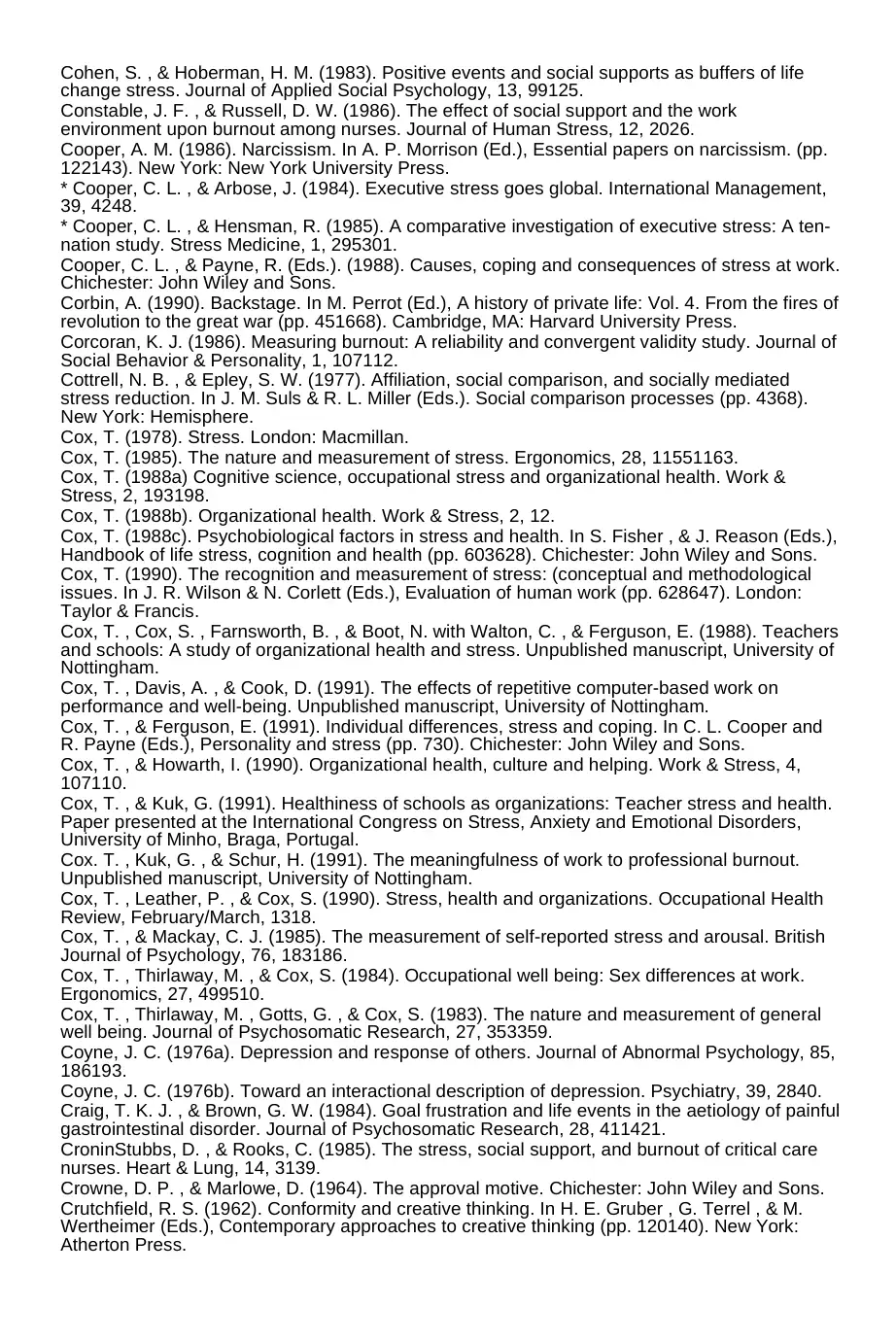
Cohen, S. , & Hoberman, H. M. (1983). Positive events and social supports as buffers of life
change stress. Journal of Applied Social Psychology, 13, 99125.
Constable, J. F. , & Russell, D. W. (1986). The effect of social support and the work
environment upon burnout among nurses. Journal of Human Stress, 12, 2026.
Cooper, A. M. (1986). Narcissism. In A. P. Morrison (Ed.), Essential papers on narcissism. (pp.
122143). New York: New York University Press.
* Cooper, C. L. , & Arbose, J. (1984). Executive stress goes global. International Management,
39, 4248.
* Cooper, C. L. , & Hensman, R. (1985). A comparative investigation of executive stress: A ten-
nation study. Stress Medicine, 1, 295301.
Cooper, C. L. , & Payne, R. (Eds.). (1988). Causes, coping and consequences of stress at work.
Chichester: John Wiley and Sons.
Corbin, A. (1990). Backstage. In M. Perrot (Ed.), A history of private life: Vol. 4. From the fires of
revolution to the great war (pp. 451668). Cambridge, MA: Harvard University Press.
Corcoran, K. J. (1986). Measuring burnout: A reliability and convergent validity study. Journal of
Social Behavior & Personality, 1, 107112.
Cottrell, N. B. , & Epley, S. W. (1977). Affiliation, social comparison, and socially mediated
stress reduction. In J. M. Suls & R. L. Miller (Eds.). Social comparison processes (pp. 4368).
New York: Hemisphere.
Cox, T. (1978). Stress. London: Macmillan.
Cox, T. (1985). The nature and measurement of stress. Ergonomics, 28, 11551163.
Cox, T. (1988a) Cognitive science, occupational stress and organizational health. Work &
Stress, 2, 193198.
Cox, T. (1988b). Organizational health. Work & Stress, 2, 12.
Cox, T. (1988c). Psychobiological factors in stress and health. In S. Fisher , & J. Reason (Eds.),
Handbook of life stress, cognition and health (pp. 603628). Chichester: John Wiley and Sons.
Cox, T. (1990). The recognition and measurement of stress: (conceptual and methodological
issues. In J. R. Wilson & N. Corlett (Eds.), Evaluation of human work (pp. 628647). London:
Taylor & Francis.
Cox, T. , Cox, S. , Farnsworth, B. , & Boot, N. with Walton, C. , & Ferguson, E. (1988). Teachers
and schools: A study of organizational health and stress. Unpublished manuscript, University of
Nottingham.
Cox, T. , Davis, A. , & Cook, D. (1991). The effects of repetitive computer-based work on
performance and well-being. Unpublished manuscript, University of Nottingham.
Cox, T. , & Ferguson, E. (1991). Individual differences, stress and coping. In C. L. Cooper and
R. Payne (Eds.), Personality and stress (pp. 730). Chichester: John Wiley and Sons.
Cox, T. , & Howarth, I. (1990). Organizational health, culture and helping. Work & Stress, 4,
107110.
Cox, T. , & Kuk, G. (1991). Healthiness of schools as organizations: Teacher stress and health.
Paper presented at the International Congress on Stress, Anxiety and Emotional Disorders,
University of Minho, Braga, Portugal.
Cox. T. , Kuk, G. , & Schur, H. (1991). The meaningfulness of work to professional burnout.
Unpublished manuscript, University of Nottingham.
Cox, T. , Leather, P. , & Cox, S. (1990). Stress, health and organizations. Occupational Health
Review, February/March, 1318.
Cox, T. , & Mackay, C. J. (1985). The measurement of self-reported stress and arousal. British
Journal of Psychology, 76, 183186.
Cox, T. , Thirlaway, M. , & Cox, S. (1984). Occupational well being: Sex differences at work.
Ergonomics, 27, 499510.
Cox, T. , Thirlaway, M. , Gotts, G. , & Cox, S. (1983). The nature and measurement of general
well being. Journal of Psychosomatic Research, 27, 353359.
Coyne, J. C. (1976a). Depression and response of others. Journal of Abnormal Psychology, 85,
186193.
Coyne, J. C. (1976b). Toward an interactional description of depression. Psychiatry, 39, 2840.
Craig, T. K. J. , & Brown, G. W. (1984). Goal frustration and life events in the aetiology of painful
gastrointestinal disorder. Journal of Psychosomatic Research, 28, 411421.
CroninStubbs, D. , & Rooks, C. (1985). The stress, social support, and burnout of critical care
nurses. Heart & Lung, 14, 3139.
Crowne, D. P. , & Marlowe, D. (1964). The approval motive. Chichester: John Wiley and Sons.
Crutchfield, R. S. (1962). Conformity and creative thinking. In H. E. Gruber , G. Terrel , & M.
Wertheimer (Eds.), Contemporary approaches to creative thinking (pp. 120140). New York:
Atherton Press.
change stress. Journal of Applied Social Psychology, 13, 99125.
Constable, J. F. , & Russell, D. W. (1986). The effect of social support and the work
environment upon burnout among nurses. Journal of Human Stress, 12, 2026.
Cooper, A. M. (1986). Narcissism. In A. P. Morrison (Ed.), Essential papers on narcissism. (pp.
122143). New York: New York University Press.
* Cooper, C. L. , & Arbose, J. (1984). Executive stress goes global. International Management,
39, 4248.
* Cooper, C. L. , & Hensman, R. (1985). A comparative investigation of executive stress: A ten-
nation study. Stress Medicine, 1, 295301.
Cooper, C. L. , & Payne, R. (Eds.). (1988). Causes, coping and consequences of stress at work.
Chichester: John Wiley and Sons.
Corbin, A. (1990). Backstage. In M. Perrot (Ed.), A history of private life: Vol. 4. From the fires of
revolution to the great war (pp. 451668). Cambridge, MA: Harvard University Press.
Corcoran, K. J. (1986). Measuring burnout: A reliability and convergent validity study. Journal of
Social Behavior & Personality, 1, 107112.
Cottrell, N. B. , & Epley, S. W. (1977). Affiliation, social comparison, and socially mediated
stress reduction. In J. M. Suls & R. L. Miller (Eds.). Social comparison processes (pp. 4368).
New York: Hemisphere.
Cox, T. (1978). Stress. London: Macmillan.
Cox, T. (1985). The nature and measurement of stress. Ergonomics, 28, 11551163.
Cox, T. (1988a) Cognitive science, occupational stress and organizational health. Work &
Stress, 2, 193198.
Cox, T. (1988b). Organizational health. Work & Stress, 2, 12.
Cox, T. (1988c). Psychobiological factors in stress and health. In S. Fisher , & J. Reason (Eds.),
Handbook of life stress, cognition and health (pp. 603628). Chichester: John Wiley and Sons.
Cox, T. (1990). The recognition and measurement of stress: (conceptual and methodological
issues. In J. R. Wilson & N. Corlett (Eds.), Evaluation of human work (pp. 628647). London:
Taylor & Francis.
Cox, T. , Cox, S. , Farnsworth, B. , & Boot, N. with Walton, C. , & Ferguson, E. (1988). Teachers
and schools: A study of organizational health and stress. Unpublished manuscript, University of
Nottingham.
Cox, T. , Davis, A. , & Cook, D. (1991). The effects of repetitive computer-based work on
performance and well-being. Unpublished manuscript, University of Nottingham.
Cox, T. , & Ferguson, E. (1991). Individual differences, stress and coping. In C. L. Cooper and
R. Payne (Eds.), Personality and stress (pp. 730). Chichester: John Wiley and Sons.
Cox, T. , & Howarth, I. (1990). Organizational health, culture and helping. Work & Stress, 4,
107110.
Cox, T. , & Kuk, G. (1991). Healthiness of schools as organizations: Teacher stress and health.
Paper presented at the International Congress on Stress, Anxiety and Emotional Disorders,
University of Minho, Braga, Portugal.
Cox. T. , Kuk, G. , & Schur, H. (1991). The meaningfulness of work to professional burnout.
Unpublished manuscript, University of Nottingham.
Cox, T. , Leather, P. , & Cox, S. (1990). Stress, health and organizations. Occupational Health
Review, February/March, 1318.
Cox, T. , & Mackay, C. J. (1985). The measurement of self-reported stress and arousal. British
Journal of Psychology, 76, 183186.
Cox, T. , Thirlaway, M. , & Cox, S. (1984). Occupational well being: Sex differences at work.
Ergonomics, 27, 499510.
Cox, T. , Thirlaway, M. , Gotts, G. , & Cox, S. (1983). The nature and measurement of general
well being. Journal of Psychosomatic Research, 27, 353359.
Coyne, J. C. (1976a). Depression and response of others. Journal of Abnormal Psychology, 85,
186193.
Coyne, J. C. (1976b). Toward an interactional description of depression. Psychiatry, 39, 2840.
Craig, T. K. J. , & Brown, G. W. (1984). Goal frustration and life events in the aetiology of painful
gastrointestinal disorder. Journal of Psychosomatic Research, 28, 411421.
CroninStubbs, D. , & Rooks, C. (1985). The stress, social support, and burnout of critical care
nurses. Heart & Lung, 14, 3139.
Crowne, D. P. , & Marlowe, D. (1964). The approval motive. Chichester: John Wiley and Sons.
Crutchfield, R. S. (1962). Conformity and creative thinking. In H. E. Gruber , G. Terrel , & M.
Wertheimer (Eds.), Contemporary approaches to creative thinking (pp. 120140). New York:
Atherton Press.
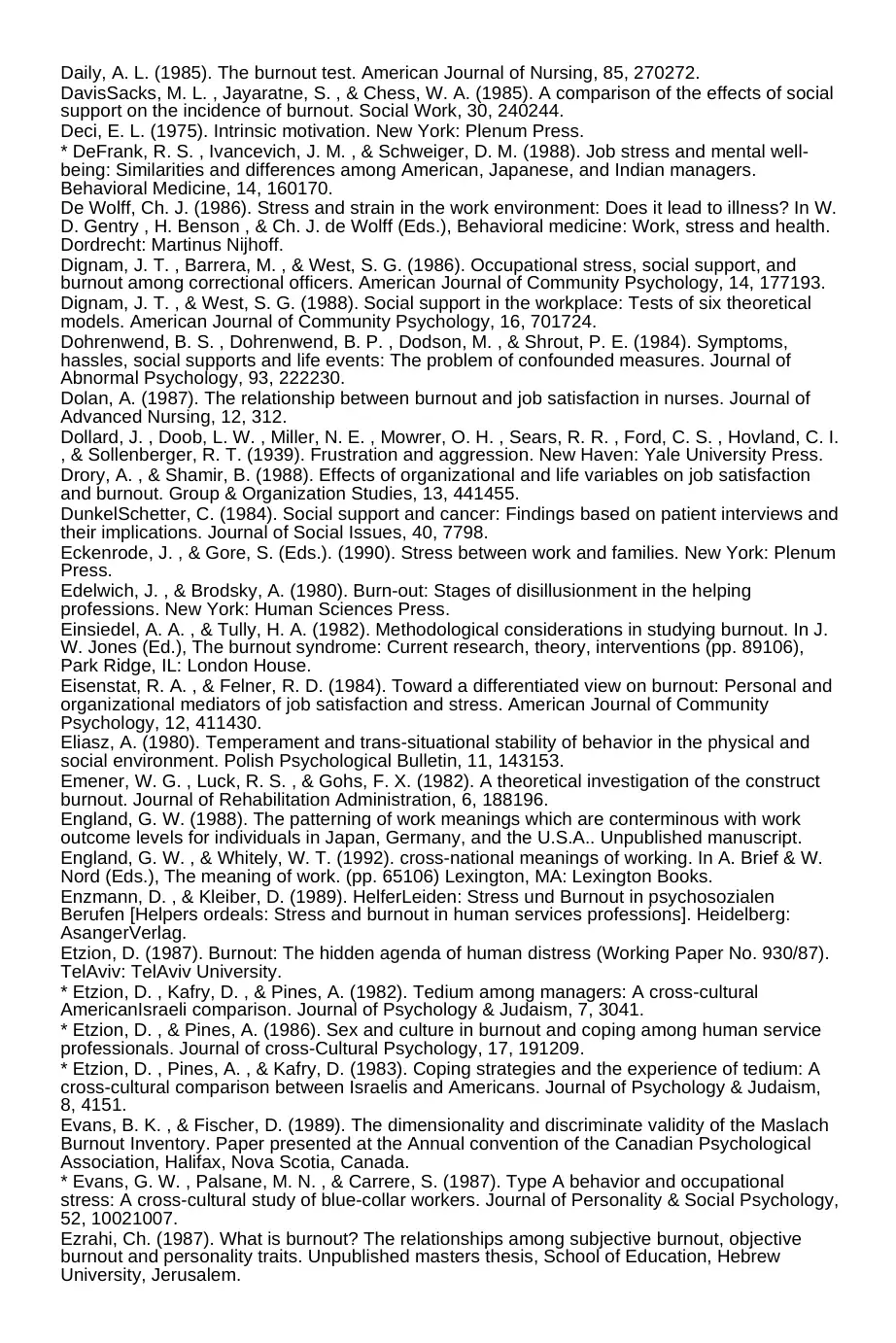
Daily, A. L. (1985). The burnout test. American Journal of Nursing, 85, 270272.
DavisSacks, M. L. , Jayaratne, S. , & Chess, W. A. (1985). A comparison of the effects of social
support on the incidence of burnout. Social Work, 30, 240244.
Deci, E. L. (1975). Intrinsic motivation. New York: Plenum Press.
* DeFrank, R. S. , Ivancevich, J. M. , & Schweiger, D. M. (1988). Job stress and mental well-
being: Similarities and differences among American, Japanese, and Indian managers.
Behavioral Medicine, 14, 160170.
De Wolff, Ch. J. (1986). Stress and strain in the work environment: Does it lead to illness? In W.
D. Gentry , H. Benson , & Ch. J. de Wolff (Eds.), Behavioral medicine: Work, stress and health.
Dordrecht: Martinus Nijhoff.
Dignam, J. T. , Barrera, M. , & West, S. G. (1986). Occupational stress, social support, and
burnout among correctional officers. American Journal of Community Psychology, 14, 177193.
Dignam, J. T. , & West, S. G. (1988). Social support in the workplace: Tests of six theoretical
models. American Journal of Community Psychology, 16, 701724.
Dohrenwend, B. S. , Dohrenwend, B. P. , Dodson, M. , & Shrout, P. E. (1984). Symptoms,
hassles, social supports and life events: The problem of confounded measures. Journal of
Abnormal Psychology, 93, 222230.
Dolan, A. (1987). The relationship between burnout and job satisfaction in nurses. Journal of
Advanced Nursing, 12, 312.
Dollard, J. , Doob, L. W. , Miller, N. E. , Mowrer, O. H. , Sears, R. R. , Ford, C. S. , Hovland, C. I.
, & Sollenberger, R. T. (1939). Frustration and aggression. New Haven: Yale University Press.
Drory, A. , & Shamir, B. (1988). Effects of organizational and life variables on job satisfaction
and burnout. Group & Organization Studies, 13, 441455.
DunkelSchetter, C. (1984). Social support and cancer: Findings based on patient interviews and
their implications. Journal of Social Issues, 40, 7798.
Eckenrode, J. , & Gore, S. (Eds.). (1990). Stress between work and families. New York: Plenum
Press.
Edelwich, J. , & Brodsky, A. (1980). Burn-out: Stages of disillusionment in the helping
professions. New York: Human Sciences Press.
Einsiedel, A. A. , & Tully, H. A. (1982). Methodological considerations in studying burnout. In J.
W. Jones (Ed.), The burnout syndrome: Current research, theory, interventions (pp. 89106),
Park Ridge, IL: London House.
Eisenstat, R. A. , & Felner, R. D. (1984). Toward a differentiated view on burnout: Personal and
organizational mediators of job satisfaction and stress. American Journal of Community
Psychology, 12, 411430.
Eliasz, A. (1980). Temperament and trans-situational stability of behavior in the physical and
social environment. Polish Psychological Bulletin, 11, 143153.
Emener, W. G. , Luck, R. S. , & Gohs, F. X. (1982). A theoretical investigation of the construct
burnout. Journal of Rehabilitation Administration, 6, 188196.
England, G. W. (1988). The patterning of work meanings which are conterminous with work
outcome levels for individuals in Japan, Germany, and the U.S.A.. Unpublished manuscript.
England, G. W. , & Whitely, W. T. (1992). cross-national meanings of working. In A. Brief & W.
Nord (Eds.), The meaning of work. (pp. 65106) Lexington, MA: Lexington Books.
Enzmann, D. , & Kleiber, D. (1989). HelferLeiden: Stress und Burnout in psychosozialen
Berufen [Helpers ordeals: Stress and burnout in human services professions]. Heidelberg:
AsangerVerlag.
Etzion, D. (1987). Burnout: The hidden agenda of human distress (Working Paper No. 930/87).
TelAviv: TelAviv University.
* Etzion, D. , Kafry, D. , & Pines, A. (1982). Tedium among managers: A cross-cultural
AmericanIsraeli comparison. Journal of Psychology & Judaism, 7, 3041.
* Etzion, D. , & Pines, A. (1986). Sex and culture in burnout and coping among human service
professionals. Journal of cross-Cultural Psychology, 17, 191209.
* Etzion, D. , Pines, A. , & Kafry, D. (1983). Coping strategies and the experience of tedium: A
cross-cultural comparison between Israelis and Americans. Journal of Psychology & Judaism,
8, 4151.
Evans, B. K. , & Fischer, D. (1989). The dimensionality and discriminate validity of the Maslach
Burnout Inventory. Paper presented at the Annual convention of the Canadian Psychological
Association, Halifax, Nova Scotia, Canada.
* Evans, G. W. , Palsane, M. N. , & Carrere, S. (1987). Type A behavior and occupational
stress: A cross-cultural study of blue-collar workers. Journal of Personality & Social Psychology,
52, 10021007.
Ezrahi, Ch. (1987). What is burnout? The relationships among subjective burnout, objective
burnout and personality traits. Unpublished masters thesis, School of Education, Hebrew
University, Jerusalem.
DavisSacks, M. L. , Jayaratne, S. , & Chess, W. A. (1985). A comparison of the effects of social
support on the incidence of burnout. Social Work, 30, 240244.
Deci, E. L. (1975). Intrinsic motivation. New York: Plenum Press.
* DeFrank, R. S. , Ivancevich, J. M. , & Schweiger, D. M. (1988). Job stress and mental well-
being: Similarities and differences among American, Japanese, and Indian managers.
Behavioral Medicine, 14, 160170.
De Wolff, Ch. J. (1986). Stress and strain in the work environment: Does it lead to illness? In W.
D. Gentry , H. Benson , & Ch. J. de Wolff (Eds.), Behavioral medicine: Work, stress and health.
Dordrecht: Martinus Nijhoff.
Dignam, J. T. , Barrera, M. , & West, S. G. (1986). Occupational stress, social support, and
burnout among correctional officers. American Journal of Community Psychology, 14, 177193.
Dignam, J. T. , & West, S. G. (1988). Social support in the workplace: Tests of six theoretical
models. American Journal of Community Psychology, 16, 701724.
Dohrenwend, B. S. , Dohrenwend, B. P. , Dodson, M. , & Shrout, P. E. (1984). Symptoms,
hassles, social supports and life events: The problem of confounded measures. Journal of
Abnormal Psychology, 93, 222230.
Dolan, A. (1987). The relationship between burnout and job satisfaction in nurses. Journal of
Advanced Nursing, 12, 312.
Dollard, J. , Doob, L. W. , Miller, N. E. , Mowrer, O. H. , Sears, R. R. , Ford, C. S. , Hovland, C. I.
, & Sollenberger, R. T. (1939). Frustration and aggression. New Haven: Yale University Press.
Drory, A. , & Shamir, B. (1988). Effects of organizational and life variables on job satisfaction
and burnout. Group & Organization Studies, 13, 441455.
DunkelSchetter, C. (1984). Social support and cancer: Findings based on patient interviews and
their implications. Journal of Social Issues, 40, 7798.
Eckenrode, J. , & Gore, S. (Eds.). (1990). Stress between work and families. New York: Plenum
Press.
Edelwich, J. , & Brodsky, A. (1980). Burn-out: Stages of disillusionment in the helping
professions. New York: Human Sciences Press.
Einsiedel, A. A. , & Tully, H. A. (1982). Methodological considerations in studying burnout. In J.
W. Jones (Ed.), The burnout syndrome: Current research, theory, interventions (pp. 89106),
Park Ridge, IL: London House.
Eisenstat, R. A. , & Felner, R. D. (1984). Toward a differentiated view on burnout: Personal and
organizational mediators of job satisfaction and stress. American Journal of Community
Psychology, 12, 411430.
Eliasz, A. (1980). Temperament and trans-situational stability of behavior in the physical and
social environment. Polish Psychological Bulletin, 11, 143153.
Emener, W. G. , Luck, R. S. , & Gohs, F. X. (1982). A theoretical investigation of the construct
burnout. Journal of Rehabilitation Administration, 6, 188196.
England, G. W. (1988). The patterning of work meanings which are conterminous with work
outcome levels for individuals in Japan, Germany, and the U.S.A.. Unpublished manuscript.
England, G. W. , & Whitely, W. T. (1992). cross-national meanings of working. In A. Brief & W.
Nord (Eds.), The meaning of work. (pp. 65106) Lexington, MA: Lexington Books.
Enzmann, D. , & Kleiber, D. (1989). HelferLeiden: Stress und Burnout in psychosozialen
Berufen [Helpers ordeals: Stress and burnout in human services professions]. Heidelberg:
AsangerVerlag.
Etzion, D. (1987). Burnout: The hidden agenda of human distress (Working Paper No. 930/87).
TelAviv: TelAviv University.
* Etzion, D. , Kafry, D. , & Pines, A. (1982). Tedium among managers: A cross-cultural
AmericanIsraeli comparison. Journal of Psychology & Judaism, 7, 3041.
* Etzion, D. , & Pines, A. (1986). Sex and culture in burnout and coping among human service
professionals. Journal of cross-Cultural Psychology, 17, 191209.
* Etzion, D. , Pines, A. , & Kafry, D. (1983). Coping strategies and the experience of tedium: A
cross-cultural comparison between Israelis and Americans. Journal of Psychology & Judaism,
8, 4151.
Evans, B. K. , & Fischer, D. (1989). The dimensionality and discriminate validity of the Maslach
Burnout Inventory. Paper presented at the Annual convention of the Canadian Psychological
Association, Halifax, Nova Scotia, Canada.
* Evans, G. W. , Palsane, M. N. , & Carrere, S. (1987). Type A behavior and occupational
stress: A cross-cultural study of blue-collar workers. Journal of Personality & Social Psychology,
52, 10021007.
Ezrahi, Ch. (1987). What is burnout? The relationships among subjective burnout, objective
burnout and personality traits. Unpublished masters thesis, School of Education, Hebrew
University, Jerusalem.
Secure Best Marks with AI Grader
Need help grading? Try our AI Grader for instant feedback on your assignments.
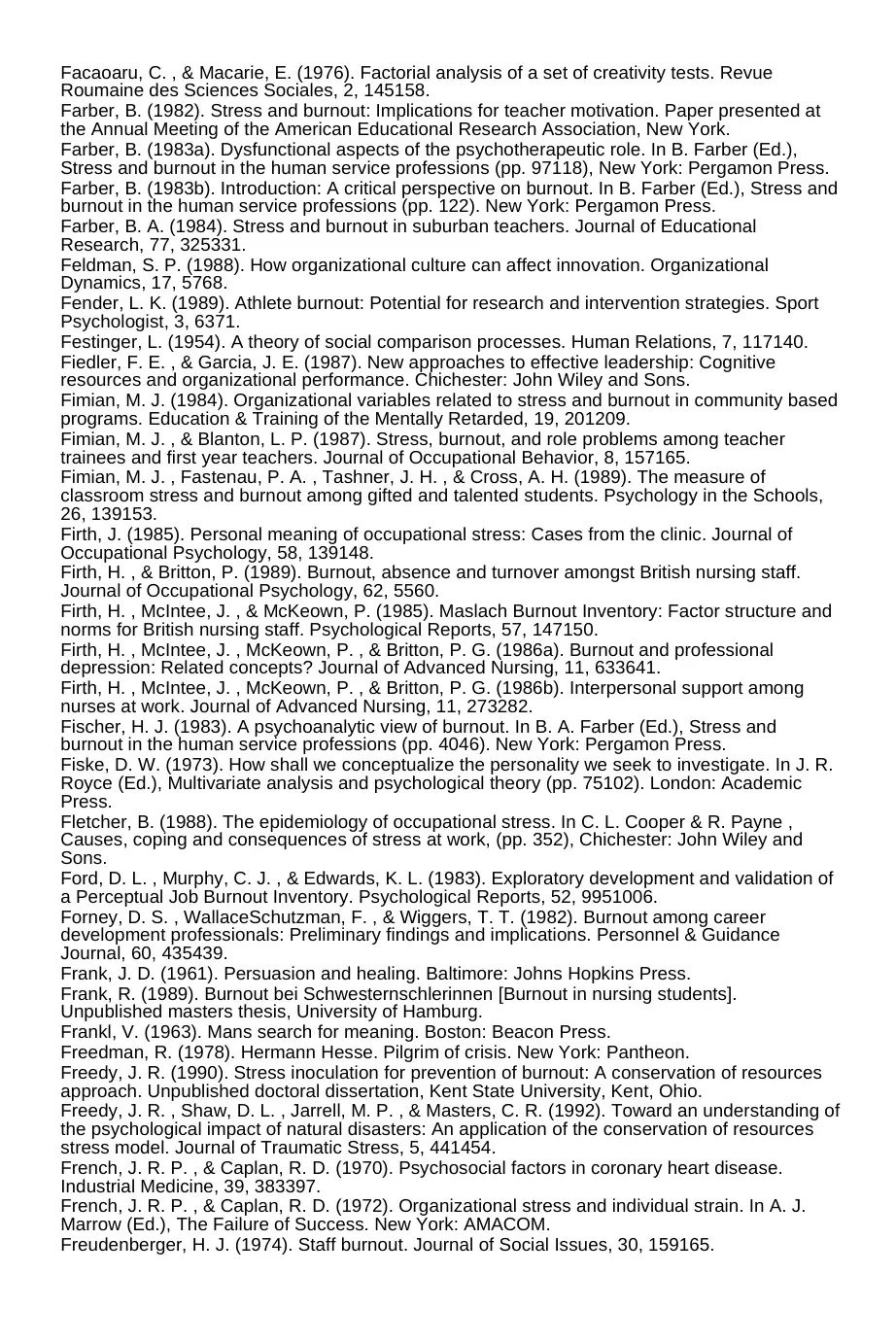
Facaoaru, C. , & Macarie, E. (1976). Factorial analysis of a set of creativity tests. Revue
Roumaine des Sciences Sociales, 2, 145158.
Farber, B. (1982). Stress and burnout: Implications for teacher motivation. Paper presented at
the Annual Meeting of the American Educational Research Association, New York.
Farber, B. (1983a). Dysfunctional aspects of the psychotherapeutic role. In B. Farber (Ed.),
Stress and burnout in the human service professions (pp. 97118), New York: Pergamon Press.
Farber, B. (1983b). Introduction: A critical perspective on burnout. In B. Farber (Ed.), Stress and
burnout in the human service professions (pp. 122). New York: Pergamon Press.
Farber, B. A. (1984). Stress and burnout in suburban teachers. Journal of Educational
Research, 77, 325331.
Feldman, S. P. (1988). How organizational culture can affect innovation. Organizational
Dynamics, 17, 5768.
Fender, L. K. (1989). Athlete burnout: Potential for research and intervention strategies. Sport
Psychologist, 3, 6371.
Festinger, L. (1954). A theory of social comparison processes. Human Relations, 7, 117140.
Fiedler, F. E. , & Garcia, J. E. (1987). New approaches to effective leadership: Cognitive
resources and organizational performance. Chichester: John Wiley and Sons.
Fimian, M. J. (1984). Organizational variables related to stress and burnout in community based
programs. Education & Training of the Mentally Retarded, 19, 201209.
Fimian, M. J. , & Blanton, L. P. (1987). Stress, burnout, and role problems among teacher
trainees and first year teachers. Journal of Occupational Behavior, 8, 157165.
Fimian, M. J. , Fastenau, P. A. , Tashner, J. H. , & Cross, A. H. (1989). The measure of
classroom stress and burnout among gifted and talented students. Psychology in the Schools,
26, 139153.
Firth, J. (1985). Personal meaning of occupational stress: Cases from the clinic. Journal of
Occupational Psychology, 58, 139148.
Firth, H. , & Britton, P. (1989). Burnout, absence and turnover amongst British nursing staff.
Journal of Occupational Psychology, 62, 5560.
Firth, H. , McIntee, J. , & McKeown, P. (1985). Maslach Burnout Inventory: Factor structure and
norms for British nursing staff. Psychological Reports, 57, 147150.
Firth, H. , McIntee, J. , McKeown, P. , & Britton, P. G. (1986a). Burnout and professional
depression: Related concepts? Journal of Advanced Nursing, 11, 633641.
Firth, H. , McIntee, J. , McKeown, P. , & Britton, P. G. (1986b). Interpersonal support among
nurses at work. Journal of Advanced Nursing, 11, 273282.
Fischer, H. J. (1983). A psychoanalytic view of burnout. In B. A. Farber (Ed.), Stress and
burnout in the human service professions (pp. 4046). New York: Pergamon Press.
Fiske, D. W. (1973). How shall we conceptualize the personality we seek to investigate. In J. R.
Royce (Ed.), Multivariate analysis and psychological theory (pp. 75102). London: Academic
Press.
Fletcher, B. (1988). The epidemiology of occupational stress. In C. L. Cooper & R. Payne ,
Causes, coping and consequences of stress at work, (pp. 352), Chichester: John Wiley and
Sons.
Ford, D. L. , Murphy, C. J. , & Edwards, K. L. (1983). Exploratory development and validation of
a Perceptual Job Burnout Inventory. Psychological Reports, 52, 9951006.
Forney, D. S. , WallaceSchutzman, F. , & Wiggers, T. T. (1982). Burnout among career
development professionals: Preliminary findings and implications. Personnel & Guidance
Journal, 60, 435439.
Frank, J. D. (1961). Persuasion and healing. Baltimore: Johns Hopkins Press.
Frank, R. (1989). Burnout bei Schwesternschlerinnen [Burnout in nursing students].
Unpublished masters thesis, University of Hamburg.
Frankl, V. (1963). Mans search for meaning. Boston: Beacon Press.
Freedman, R. (1978). Hermann Hesse. Pilgrim of crisis. New York: Pantheon.
Freedy, J. R. (1990). Stress inoculation for prevention of burnout: A conservation of resources
approach. Unpublished doctoral dissertation, Kent State University, Kent, Ohio.
Freedy, J. R. , Shaw, D. L. , Jarrell, M. P. , & Masters, C. R. (1992). Toward an understanding of
the psychological impact of natural disasters: An application of the conservation of resources
stress model. Journal of Traumatic Stress, 5, 441454.
French, J. R. P. , & Caplan, R. D. (1970). Psychosocial factors in coronary heart disease.
Industrial Medicine, 39, 383397.
French, J. R. P. , & Caplan, R. D. (1972). Organizational stress and individual strain. In A. J.
Marrow (Ed.), The Failure of Success. New York: AMACOM.
Freudenberger, H. J. (1974). Staff burnout. Journal of Social Issues, 30, 159165.
Roumaine des Sciences Sociales, 2, 145158.
Farber, B. (1982). Stress and burnout: Implications for teacher motivation. Paper presented at
the Annual Meeting of the American Educational Research Association, New York.
Farber, B. (1983a). Dysfunctional aspects of the psychotherapeutic role. In B. Farber (Ed.),
Stress and burnout in the human service professions (pp. 97118), New York: Pergamon Press.
Farber, B. (1983b). Introduction: A critical perspective on burnout. In B. Farber (Ed.), Stress and
burnout in the human service professions (pp. 122). New York: Pergamon Press.
Farber, B. A. (1984). Stress and burnout in suburban teachers. Journal of Educational
Research, 77, 325331.
Feldman, S. P. (1988). How organizational culture can affect innovation. Organizational
Dynamics, 17, 5768.
Fender, L. K. (1989). Athlete burnout: Potential for research and intervention strategies. Sport
Psychologist, 3, 6371.
Festinger, L. (1954). A theory of social comparison processes. Human Relations, 7, 117140.
Fiedler, F. E. , & Garcia, J. E. (1987). New approaches to effective leadership: Cognitive
resources and organizational performance. Chichester: John Wiley and Sons.
Fimian, M. J. (1984). Organizational variables related to stress and burnout in community based
programs. Education & Training of the Mentally Retarded, 19, 201209.
Fimian, M. J. , & Blanton, L. P. (1987). Stress, burnout, and role problems among teacher
trainees and first year teachers. Journal of Occupational Behavior, 8, 157165.
Fimian, M. J. , Fastenau, P. A. , Tashner, J. H. , & Cross, A. H. (1989). The measure of
classroom stress and burnout among gifted and talented students. Psychology in the Schools,
26, 139153.
Firth, J. (1985). Personal meaning of occupational stress: Cases from the clinic. Journal of
Occupational Psychology, 58, 139148.
Firth, H. , & Britton, P. (1989). Burnout, absence and turnover amongst British nursing staff.
Journal of Occupational Psychology, 62, 5560.
Firth, H. , McIntee, J. , & McKeown, P. (1985). Maslach Burnout Inventory: Factor structure and
norms for British nursing staff. Psychological Reports, 57, 147150.
Firth, H. , McIntee, J. , McKeown, P. , & Britton, P. G. (1986a). Burnout and professional
depression: Related concepts? Journal of Advanced Nursing, 11, 633641.
Firth, H. , McIntee, J. , McKeown, P. , & Britton, P. G. (1986b). Interpersonal support among
nurses at work. Journal of Advanced Nursing, 11, 273282.
Fischer, H. J. (1983). A psychoanalytic view of burnout. In B. A. Farber (Ed.), Stress and
burnout in the human service professions (pp. 4046). New York: Pergamon Press.
Fiske, D. W. (1973). How shall we conceptualize the personality we seek to investigate. In J. R.
Royce (Ed.), Multivariate analysis and psychological theory (pp. 75102). London: Academic
Press.
Fletcher, B. (1988). The epidemiology of occupational stress. In C. L. Cooper & R. Payne ,
Causes, coping and consequences of stress at work, (pp. 352), Chichester: John Wiley and
Sons.
Ford, D. L. , Murphy, C. J. , & Edwards, K. L. (1983). Exploratory development and validation of
a Perceptual Job Burnout Inventory. Psychological Reports, 52, 9951006.
Forney, D. S. , WallaceSchutzman, F. , & Wiggers, T. T. (1982). Burnout among career
development professionals: Preliminary findings and implications. Personnel & Guidance
Journal, 60, 435439.
Frank, J. D. (1961). Persuasion and healing. Baltimore: Johns Hopkins Press.
Frank, R. (1989). Burnout bei Schwesternschlerinnen [Burnout in nursing students].
Unpublished masters thesis, University of Hamburg.
Frankl, V. (1963). Mans search for meaning. Boston: Beacon Press.
Freedman, R. (1978). Hermann Hesse. Pilgrim of crisis. New York: Pantheon.
Freedy, J. R. (1990). Stress inoculation for prevention of burnout: A conservation of resources
approach. Unpublished doctoral dissertation, Kent State University, Kent, Ohio.
Freedy, J. R. , Shaw, D. L. , Jarrell, M. P. , & Masters, C. R. (1992). Toward an understanding of
the psychological impact of natural disasters: An application of the conservation of resources
stress model. Journal of Traumatic Stress, 5, 441454.
French, J. R. P. , & Caplan, R. D. (1970). Psychosocial factors in coronary heart disease.
Industrial Medicine, 39, 383397.
French, J. R. P. , & Caplan, R. D. (1972). Organizational stress and individual strain. In A. J.
Marrow (Ed.), The Failure of Success. New York: AMACOM.
Freudenberger, H. J. (1974). Staff burnout. Journal of Social Issues, 30, 159165.
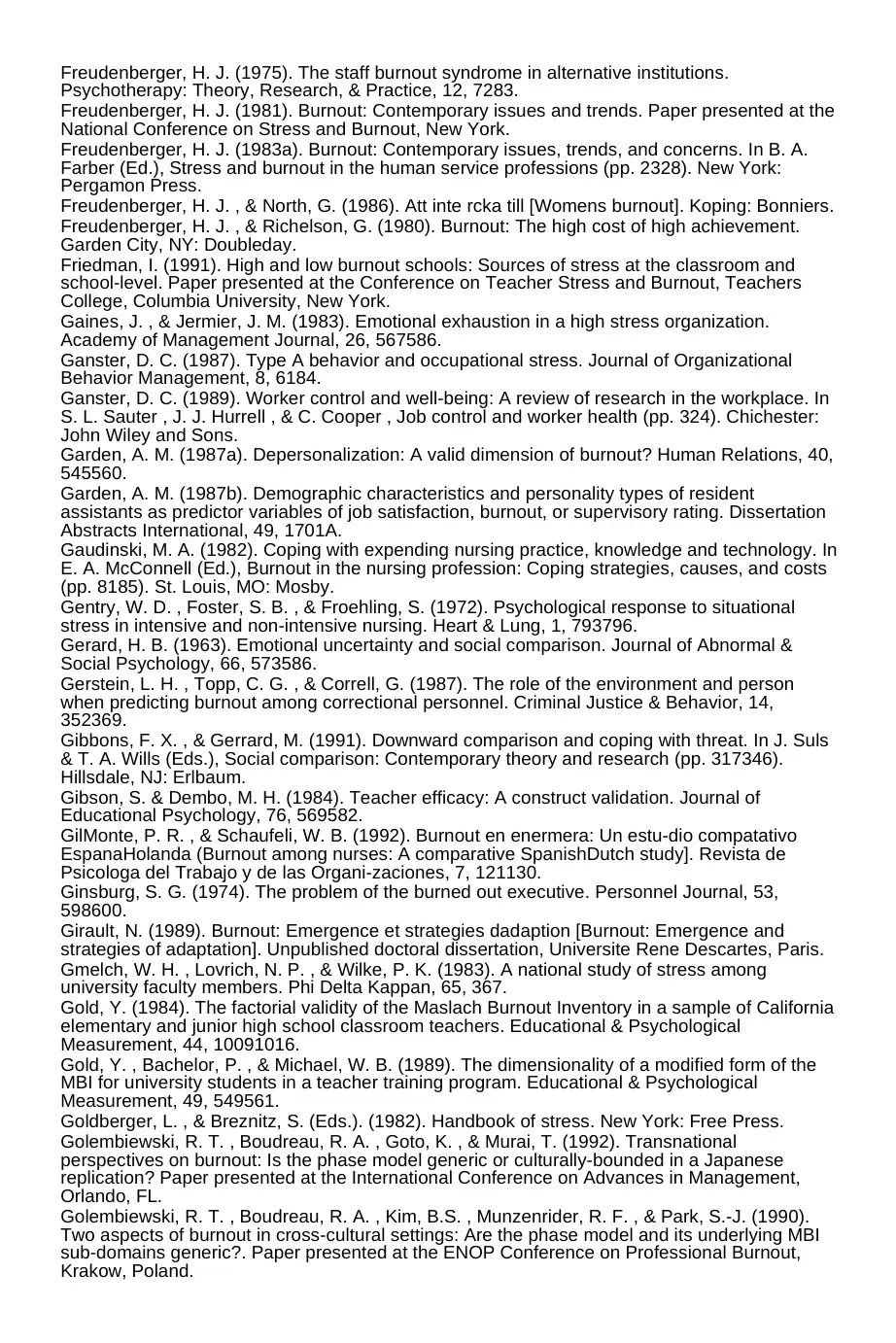
Freudenberger, H. J. (1975). The staff burnout syndrome in alternative institutions.
Psychotherapy: Theory, Research, & Practice, 12, 7283.
Freudenberger, H. J. (1981). Burnout: Contemporary issues and trends. Paper presented at the
National Conference on Stress and Burnout, New York.
Freudenberger, H. J. (1983a). Burnout: Contemporary issues, trends, and concerns. In B. A.
Farber (Ed.), Stress and burnout in the human service professions (pp. 2328). New York:
Pergamon Press.
Freudenberger, H. J. , & North, G. (1986). Att inte rcka till [Womens burnout]. Koping: Bonniers.
Freudenberger, H. J. , & Richelson, G. (1980). Burnout: The high cost of high achievement.
Garden City, NY: Doubleday.
Friedman, I. (1991). High and low burnout schools: Sources of stress at the classroom and
school-level. Paper presented at the Conference on Teacher Stress and Burnout, Teachers
College, Columbia University, New York.
Gaines, J. , & Jermier, J. M. (1983). Emotional exhaustion in a high stress organization.
Academy of Management Journal, 26, 567586.
Ganster, D. C. (1987). Type A behavior and occupational stress. Journal of Organizational
Behavior Management, 8, 6184.
Ganster, D. C. (1989). Worker control and well-being: A review of research in the workplace. In
S. L. Sauter , J. J. Hurrell , & C. Cooper , Job control and worker health (pp. 324). Chichester:
John Wiley and Sons.
Garden, A. M. (1987a). Depersonalization: A valid dimension of burnout? Human Relations, 40,
545560.
Garden, A. M. (1987b). Demographic characteristics and personality types of resident
assistants as predictor variables of job satisfaction, burnout, or supervisory rating. Dissertation
Abstracts International, 49, 1701A.
Gaudinski, M. A. (1982). Coping with expending nursing practice, knowledge and technology. In
E. A. McConnell (Ed.), Burnout in the nursing profession: Coping strategies, causes, and costs
(pp. 8185). St. Louis, MO: Mosby.
Gentry, W. D. , Foster, S. B. , & Froehling, S. (1972). Psychological response to situational
stress in intensive and non-intensive nursing. Heart & Lung, 1, 793796.
Gerard, H. B. (1963). Emotional uncertainty and social comparison. Journal of Abnormal &
Social Psychology, 66, 573586.
Gerstein, L. H. , Topp, C. G. , & Correll, G. (1987). The role of the environment and person
when predicting burnout among correctional personnel. Criminal Justice & Behavior, 14,
352369.
Gibbons, F. X. , & Gerrard, M. (1991). Downward comparison and coping with threat. In J. Suls
& T. A. Wills (Eds.), Social comparison: Contemporary theory and research (pp. 317346).
Hillsdale, NJ: Erlbaum.
Gibson, S. & Dembo, M. H. (1984). Teacher efficacy: A construct validation. Journal of
Educational Psychology, 76, 569582.
GilMonte, P. R. , & Schaufeli, W. B. (1992). Burnout en enermera: Un estu-dio compatativo
EspanaHolanda (Burnout among nurses: A comparative SpanishDutch study]. Revista de
Psicologa del Trabajo y de las Organi-zaciones, 7, 121130.
Ginsburg, S. G. (1974). The problem of the burned out executive. Personnel Journal, 53,
598600.
Girault, N. (1989). Burnout: Emergence et strategies dadaption [Burnout: Emergence and
strategies of adaptation]. Unpublished doctoral dissertation, Universite Rene Descartes, Paris.
Gmelch, W. H. , Lovrich, N. P. , & Wilke, P. K. (1983). A national study of stress among
university faculty members. Phi Delta Kappan, 65, 367.
Gold, Y. (1984). The factorial validity of the Maslach Burnout Inventory in a sample of California
elementary and junior high school classroom teachers. Educational & Psychological
Measurement, 44, 10091016.
Gold, Y. , Bachelor, P. , & Michael, W. B. (1989). The dimensionality of a modified form of the
MBI for university students in a teacher training program. Educational & Psychological
Measurement, 49, 549561.
Goldberger, L. , & Breznitz, S. (Eds.). (1982). Handbook of stress. New York: Free Press.
Golembiewski, R. T. , Boudreau, R. A. , Goto, K. , & Murai, T. (1992). Transnational
perspectives on burnout: Is the phase model generic or culturally-bounded in a Japanese
replication? Paper presented at the International Conference on Advances in Management,
Orlando, FL.
Golembiewski, R. T. , Boudreau, R. A. , Kim, B.S. , Munzenrider, R. F. , & Park, S.-J. (1990).
Two aspects of burnout in cross-cultural settings: Are the phase model and its underlying MBI
sub-domains generic?. Paper presented at the ENOP Conference on Professional Burnout,
Krakow, Poland.
Psychotherapy: Theory, Research, & Practice, 12, 7283.
Freudenberger, H. J. (1981). Burnout: Contemporary issues and trends. Paper presented at the
National Conference on Stress and Burnout, New York.
Freudenberger, H. J. (1983a). Burnout: Contemporary issues, trends, and concerns. In B. A.
Farber (Ed.), Stress and burnout in the human service professions (pp. 2328). New York:
Pergamon Press.
Freudenberger, H. J. , & North, G. (1986). Att inte rcka till [Womens burnout]. Koping: Bonniers.
Freudenberger, H. J. , & Richelson, G. (1980). Burnout: The high cost of high achievement.
Garden City, NY: Doubleday.
Friedman, I. (1991). High and low burnout schools: Sources of stress at the classroom and
school-level. Paper presented at the Conference on Teacher Stress and Burnout, Teachers
College, Columbia University, New York.
Gaines, J. , & Jermier, J. M. (1983). Emotional exhaustion in a high stress organization.
Academy of Management Journal, 26, 567586.
Ganster, D. C. (1987). Type A behavior and occupational stress. Journal of Organizational
Behavior Management, 8, 6184.
Ganster, D. C. (1989). Worker control and well-being: A review of research in the workplace. In
S. L. Sauter , J. J. Hurrell , & C. Cooper , Job control and worker health (pp. 324). Chichester:
John Wiley and Sons.
Garden, A. M. (1987a). Depersonalization: A valid dimension of burnout? Human Relations, 40,
545560.
Garden, A. M. (1987b). Demographic characteristics and personality types of resident
assistants as predictor variables of job satisfaction, burnout, or supervisory rating. Dissertation
Abstracts International, 49, 1701A.
Gaudinski, M. A. (1982). Coping with expending nursing practice, knowledge and technology. In
E. A. McConnell (Ed.), Burnout in the nursing profession: Coping strategies, causes, and costs
(pp. 8185). St. Louis, MO: Mosby.
Gentry, W. D. , Foster, S. B. , & Froehling, S. (1972). Psychological response to situational
stress in intensive and non-intensive nursing. Heart & Lung, 1, 793796.
Gerard, H. B. (1963). Emotional uncertainty and social comparison. Journal of Abnormal &
Social Psychology, 66, 573586.
Gerstein, L. H. , Topp, C. G. , & Correll, G. (1987). The role of the environment and person
when predicting burnout among correctional personnel. Criminal Justice & Behavior, 14,
352369.
Gibbons, F. X. , & Gerrard, M. (1991). Downward comparison and coping with threat. In J. Suls
& T. A. Wills (Eds.), Social comparison: Contemporary theory and research (pp. 317346).
Hillsdale, NJ: Erlbaum.
Gibson, S. & Dembo, M. H. (1984). Teacher efficacy: A construct validation. Journal of
Educational Psychology, 76, 569582.
GilMonte, P. R. , & Schaufeli, W. B. (1992). Burnout en enermera: Un estu-dio compatativo
EspanaHolanda (Burnout among nurses: A comparative SpanishDutch study]. Revista de
Psicologa del Trabajo y de las Organi-zaciones, 7, 121130.
Ginsburg, S. G. (1974). The problem of the burned out executive. Personnel Journal, 53,
598600.
Girault, N. (1989). Burnout: Emergence et strategies dadaption [Burnout: Emergence and
strategies of adaptation]. Unpublished doctoral dissertation, Universite Rene Descartes, Paris.
Gmelch, W. H. , Lovrich, N. P. , & Wilke, P. K. (1983). A national study of stress among
university faculty members. Phi Delta Kappan, 65, 367.
Gold, Y. (1984). The factorial validity of the Maslach Burnout Inventory in a sample of California
elementary and junior high school classroom teachers. Educational & Psychological
Measurement, 44, 10091016.
Gold, Y. , Bachelor, P. , & Michael, W. B. (1989). The dimensionality of a modified form of the
MBI for university students in a teacher training program. Educational & Psychological
Measurement, 49, 549561.
Goldberger, L. , & Breznitz, S. (Eds.). (1982). Handbook of stress. New York: Free Press.
Golembiewski, R. T. , Boudreau, R. A. , Goto, K. , & Murai, T. (1992). Transnational
perspectives on burnout: Is the phase model generic or culturally-bounded in a Japanese
replication? Paper presented at the International Conference on Advances in Management,
Orlando, FL.
Golembiewski, R. T. , Boudreau, R. A. , Kim, B.S. , Munzenrider, R. F. , & Park, S.-J. (1990).
Two aspects of burnout in cross-cultural settings: Are the phase model and its underlying MBI
sub-domains generic?. Paper presented at the ENOP Conference on Professional Burnout,
Krakow, Poland.
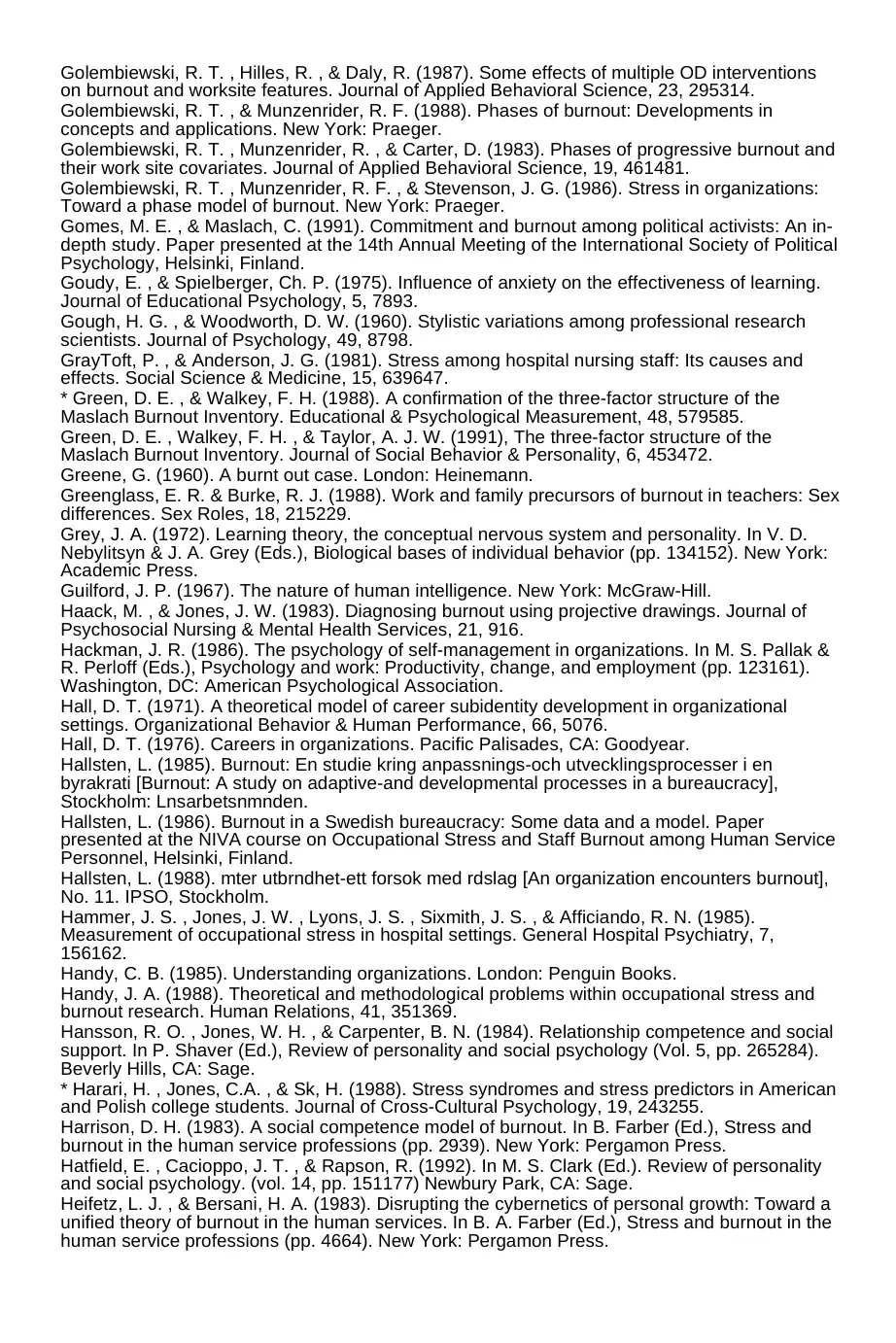
Golembiewski, R. T. , Hilles, R. , & Daly, R. (1987). Some effects of multiple OD interventions
on burnout and worksite features. Journal of Applied Behavioral Science, 23, 295314.
Golembiewski, R. T. , & Munzenrider, R. F. (1988). Phases of burnout: Developments in
concepts and applications. New York: Praeger.
Golembiewski, R. T. , Munzenrider, R. , & Carter, D. (1983). Phases of progressive burnout and
their work site covariates. Journal of Applied Behavioral Science, 19, 461481.
Golembiewski, R. T. , Munzenrider, R. F. , & Stevenson, J. G. (1986). Stress in organizations:
Toward a phase model of burnout. New York: Praeger.
Gomes, M. E. , & Maslach, C. (1991). Commitment and burnout among political activists: An in-
depth study. Paper presented at the 14th Annual Meeting of the International Society of Political
Psychology, Helsinki, Finland.
Goudy, E. , & Spielberger, Ch. P. (1975). Influence of anxiety on the effectiveness of learning.
Journal of Educational Psychology, 5, 7893.
Gough, H. G. , & Woodworth, D. W. (1960). Stylistic variations among professional research
scientists. Journal of Psychology, 49, 8798.
GrayToft, P. , & Anderson, J. G. (1981). Stress among hospital nursing staff: Its causes and
effects. Social Science & Medicine, 15, 639647.
* Green, D. E. , & Walkey, F. H. (1988). A confirmation of the three-factor structure of the
Maslach Burnout Inventory. Educational & Psychological Measurement, 48, 579585.
Green, D. E. , Walkey, F. H. , & Taylor, A. J. W. (1991), The three-factor structure of the
Maslach Burnout Inventory. Journal of Social Behavior & Personality, 6, 453472.
Greene, G. (1960). A burnt out case. London: Heinemann.
Greenglass, E. R. & Burke, R. J. (1988). Work and family precursors of burnout in teachers: Sex
differences. Sex Roles, 18, 215229.
Grey, J. A. (1972). Learning theory, the conceptual nervous system and personality. In V. D.
Nebylitsyn & J. A. Grey (Eds.), Biological bases of individual behavior (pp. 134152). New York:
Academic Press.
Guilford, J. P. (1967). The nature of human intelligence. New York: McGraw-Hill.
Haack, M. , & Jones, J. W. (1983). Diagnosing burnout using projective drawings. Journal of
Psychosocial Nursing & Mental Health Services, 21, 916.
Hackman, J. R. (1986). The psychology of self-management in organizations. In M. S. Pallak &
R. Perloff (Eds.), Psychology and work: Productivity, change, and employment (pp. 123161).
Washington, DC: American Psychological Association.
Hall, D. T. (1971). A theoretical model of career subidentity development in organizational
settings. Organizational Behavior & Human Performance, 66, 5076.
Hall, D. T. (1976). Careers in organizations. Pacific Palisades, CA: Goodyear.
Hallsten, L. (1985). Burnout: En studie kring anpassnings-och utvecklingsprocesser i en
byrakrati [Burnout: A study on adaptive-and developmental processes in a bureaucracy],
Stockholm: Lnsarbetsnmnden.
Hallsten, L. (1986). Burnout in a Swedish bureaucracy: Some data and a model. Paper
presented at the NIVA course on Occupational Stress and Staff Burnout among Human Service
Personnel, Helsinki, Finland.
Hallsten, L. (1988). mter utbrndhet-ett forsok med rdslag [An organization encounters burnout],
No. 11. IPSO, Stockholm.
Hammer, J. S. , Jones, J. W. , Lyons, J. S. , Sixmith, J. S. , & Afficiando, R. N. (1985).
Measurement of occupational stress in hospital settings. General Hospital Psychiatry, 7,
156162.
Handy, C. B. (1985). Understanding organizations. London: Penguin Books.
Handy, J. A. (1988). Theoretical and methodological problems within occupational stress and
burnout research. Human Relations, 41, 351369.
Hansson, R. O. , Jones, W. H. , & Carpenter, B. N. (1984). Relationship competence and social
support. In P. Shaver (Ed.), Review of personality and social psychology (Vol. 5, pp. 265284).
Beverly Hills, CA: Sage.
* Harari, H. , Jones, C.A. , & Sk, H. (1988). Stress syndromes and stress predictors in American
and Polish college students. Journal of Cross-Cultural Psychology, 19, 243255.
Harrison, D. H. (1983). A social competence model of burnout. In B. Farber (Ed.), Stress and
burnout in the human service professions (pp. 2939). New York: Pergamon Press.
Hatfield, E. , Cacioppo, J. T. , & Rapson, R. (1992). In M. S. Clark (Ed.). Review of personality
and social psychology. (vol. 14, pp. 151177) Newbury Park, CA: Sage.
Heifetz, L. J. , & Bersani, H. A. (1983). Disrupting the cybernetics of personal growth: Toward a
unified theory of burnout in the human services. In B. A. Farber (Ed.), Stress and burnout in the
human service professions (pp. 4664). New York: Pergamon Press.
on burnout and worksite features. Journal of Applied Behavioral Science, 23, 295314.
Golembiewski, R. T. , & Munzenrider, R. F. (1988). Phases of burnout: Developments in
concepts and applications. New York: Praeger.
Golembiewski, R. T. , Munzenrider, R. , & Carter, D. (1983). Phases of progressive burnout and
their work site covariates. Journal of Applied Behavioral Science, 19, 461481.
Golembiewski, R. T. , Munzenrider, R. F. , & Stevenson, J. G. (1986). Stress in organizations:
Toward a phase model of burnout. New York: Praeger.
Gomes, M. E. , & Maslach, C. (1991). Commitment and burnout among political activists: An in-
depth study. Paper presented at the 14th Annual Meeting of the International Society of Political
Psychology, Helsinki, Finland.
Goudy, E. , & Spielberger, Ch. P. (1975). Influence of anxiety on the effectiveness of learning.
Journal of Educational Psychology, 5, 7893.
Gough, H. G. , & Woodworth, D. W. (1960). Stylistic variations among professional research
scientists. Journal of Psychology, 49, 8798.
GrayToft, P. , & Anderson, J. G. (1981). Stress among hospital nursing staff: Its causes and
effects. Social Science & Medicine, 15, 639647.
* Green, D. E. , & Walkey, F. H. (1988). A confirmation of the three-factor structure of the
Maslach Burnout Inventory. Educational & Psychological Measurement, 48, 579585.
Green, D. E. , Walkey, F. H. , & Taylor, A. J. W. (1991), The three-factor structure of the
Maslach Burnout Inventory. Journal of Social Behavior & Personality, 6, 453472.
Greene, G. (1960). A burnt out case. London: Heinemann.
Greenglass, E. R. & Burke, R. J. (1988). Work and family precursors of burnout in teachers: Sex
differences. Sex Roles, 18, 215229.
Grey, J. A. (1972). Learning theory, the conceptual nervous system and personality. In V. D.
Nebylitsyn & J. A. Grey (Eds.), Biological bases of individual behavior (pp. 134152). New York:
Academic Press.
Guilford, J. P. (1967). The nature of human intelligence. New York: McGraw-Hill.
Haack, M. , & Jones, J. W. (1983). Diagnosing burnout using projective drawings. Journal of
Psychosocial Nursing & Mental Health Services, 21, 916.
Hackman, J. R. (1986). The psychology of self-management in organizations. In M. S. Pallak &
R. Perloff (Eds.), Psychology and work: Productivity, change, and employment (pp. 123161).
Washington, DC: American Psychological Association.
Hall, D. T. (1971). A theoretical model of career subidentity development in organizational
settings. Organizational Behavior & Human Performance, 66, 5076.
Hall, D. T. (1976). Careers in organizations. Pacific Palisades, CA: Goodyear.
Hallsten, L. (1985). Burnout: En studie kring anpassnings-och utvecklingsprocesser i en
byrakrati [Burnout: A study on adaptive-and developmental processes in a bureaucracy],
Stockholm: Lnsarbetsnmnden.
Hallsten, L. (1986). Burnout in a Swedish bureaucracy: Some data and a model. Paper
presented at the NIVA course on Occupational Stress and Staff Burnout among Human Service
Personnel, Helsinki, Finland.
Hallsten, L. (1988). mter utbrndhet-ett forsok med rdslag [An organization encounters burnout],
No. 11. IPSO, Stockholm.
Hammer, J. S. , Jones, J. W. , Lyons, J. S. , Sixmith, J. S. , & Afficiando, R. N. (1985).
Measurement of occupational stress in hospital settings. General Hospital Psychiatry, 7,
156162.
Handy, C. B. (1985). Understanding organizations. London: Penguin Books.
Handy, J. A. (1988). Theoretical and methodological problems within occupational stress and
burnout research. Human Relations, 41, 351369.
Hansson, R. O. , Jones, W. H. , & Carpenter, B. N. (1984). Relationship competence and social
support. In P. Shaver (Ed.), Review of personality and social psychology (Vol. 5, pp. 265284).
Beverly Hills, CA: Sage.
* Harari, H. , Jones, C.A. , & Sk, H. (1988). Stress syndromes and stress predictors in American
and Polish college students. Journal of Cross-Cultural Psychology, 19, 243255.
Harrison, D. H. (1983). A social competence model of burnout. In B. Farber (Ed.), Stress and
burnout in the human service professions (pp. 2939). New York: Pergamon Press.
Hatfield, E. , Cacioppo, J. T. , & Rapson, R. (1992). In M. S. Clark (Ed.). Review of personality
and social psychology. (vol. 14, pp. 151177) Newbury Park, CA: Sage.
Heifetz, L. J. , & Bersani, H. A. (1983). Disrupting the cybernetics of personal growth: Toward a
unified theory of burnout in the human services. In B. A. Farber (Ed.), Stress and burnout in the
human service professions (pp. 4664). New York: Pergamon Press.
Paraphrase This Document
Need a fresh take? Get an instant paraphrase of this document with our AI Paraphraser
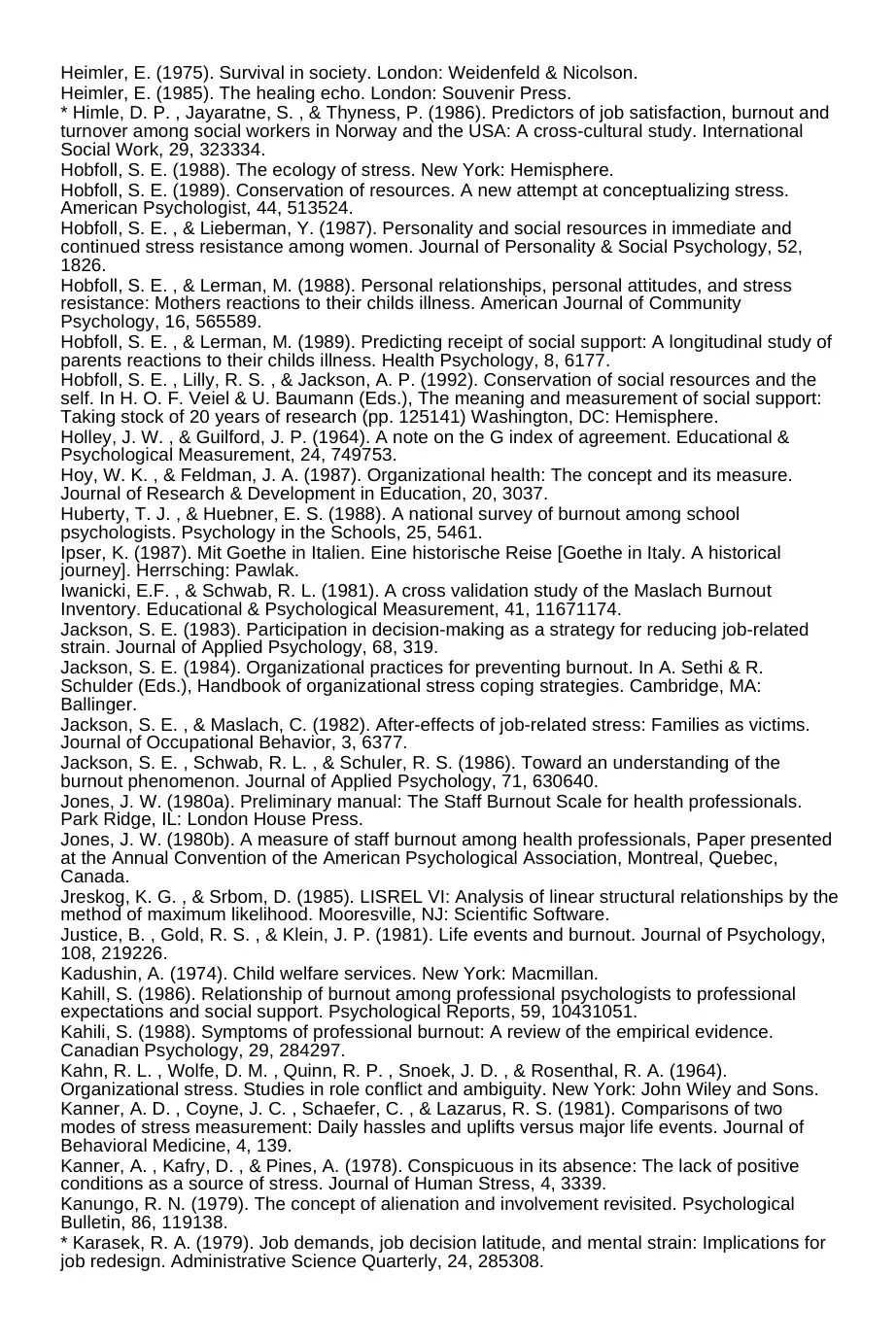
Heimler, E. (1975). Survival in society. London: Weidenfeld & Nicolson.
Heimler, E. (1985). The healing echo. London: Souvenir Press.
* Himle, D. P. , Jayaratne, S. , & Thyness, P. (1986). Predictors of job satisfaction, burnout and
turnover among social workers in Norway and the USA: A cross-cultural study. International
Social Work, 29, 323334.
Hobfoll, S. E. (1988). The ecology of stress. New York: Hemisphere.
Hobfoll, S. E. (1989). Conservation of resources. A new attempt at conceptualizing stress.
American Psychologist, 44, 513524.
Hobfoll, S. E. , & Lieberman, Y. (1987). Personality and social resources in immediate and
continued stress resistance among women. Journal of Personality & Social Psychology, 52,
1826.
Hobfoll, S. E. , & Lerman, M. (1988). Personal relationships, personal attitudes, and stress
resistance: Mothers reactions to their childs illness. American Journal of Community
Psychology, 16, 565589.
Hobfoll, S. E. , & Lerman, M. (1989). Predicting receipt of social support: A longitudinal study of
parents reactions to their childs illness. Health Psychology, 8, 6177.
Hobfoll, S. E. , Lilly, R. S. , & Jackson, A. P. (1992). Conservation of social resources and the
self. In H. O. F. Veiel & U. Baumann (Eds.), The meaning and measurement of social support:
Taking stock of 20 years of research (pp. 125141) Washington, DC: Hemisphere.
Holley, J. W. , & Guilford, J. P. (1964). A note on the G index of agreement. Educational &
Psychological Measurement, 24, 749753.
Hoy, W. K. , & Feldman, J. A. (1987). Organizational health: The concept and its measure.
Journal of Research & Development in Education, 20, 3037.
Huberty, T. J. , & Huebner, E. S. (1988). A national survey of burnout among school
psychologists. Psychology in the Schools, 25, 5461.
Ipser, K. (1987). Mit Goethe in Italien. Eine historische Reise [Goethe in Italy. A historical
journey]. Herrsching: Pawlak.
Iwanicki, E.F. , & Schwab, R. L. (1981). A cross validation study of the Maslach Burnout
Inventory. Educational & Psychological Measurement, 41, 11671174.
Jackson, S. E. (1983). Participation in decision-making as a strategy for reducing job-related
strain. Journal of Applied Psychology, 68, 319.
Jackson, S. E. (1984). Organizational practices for preventing burnout. In A. Sethi & R.
Schulder (Eds.), Handbook of organizational stress coping strategies. Cambridge, MA:
Ballinger.
Jackson, S. E. , & Maslach, C. (1982). After-effects of job-related stress: Families as victims.
Journal of Occupational Behavior, 3, 6377.
Jackson, S. E. , Schwab, R. L. , & Schuler, R. S. (1986). Toward an understanding of the
burnout phenomenon. Journal of Applied Psychology, 71, 630640.
Jones, J. W. (1980a). Preliminary manual: The Staff Burnout Scale for health professionals.
Park Ridge, IL: London House Press.
Jones, J. W. (1980b). A measure of staff burnout among health professionals, Paper presented
at the Annual Convention of the American Psychological Association, Montreal, Quebec,
Canada.
Jreskog, K. G. , & Srbom, D. (1985). LISREL VI: Analysis of linear structural relationships by the
method of maximum likelihood. Mooresville, NJ: Scientific Software.
Justice, B. , Gold, R. S. , & Klein, J. P. (1981). Life events and burnout. Journal of Psychology,
108, 219226.
Kadushin, A. (1974). Child welfare services. New York: Macmillan.
Kahill, S. (1986). Relationship of burnout among professional psychologists to professional
expectations and social support. Psychological Reports, 59, 10431051.
Kahili, S. (1988). Symptoms of professional burnout: A review of the empirical evidence.
Canadian Psychology, 29, 284297.
Kahn, R. L. , Wolfe, D. M. , Quinn, R. P. , Snoek, J. D. , & Rosenthal, R. A. (1964).
Organizational stress. Studies in role conflict and ambiguity. New York: John Wiley and Sons.
Kanner, A. D. , Coyne, J. C. , Schaefer, C. , & Lazarus, R. S. (1981). Comparisons of two
modes of stress measurement: Daily hassles and uplifts versus major life events. Journal of
Behavioral Medicine, 4, 139.
Kanner, A. , Kafry, D. , & Pines, A. (1978). Conspicuous in its absence: The lack of positive
conditions as a source of stress. Journal of Human Stress, 4, 3339.
Kanungo, R. N. (1979). The concept of alienation and involvement revisited. Psychological
Bulletin, 86, 119138.
* Karasek, R. A. (1979). Job demands, job decision latitude, and mental strain: Implications for
job redesign. Administrative Science Quarterly, 24, 285308.
Heimler, E. (1985). The healing echo. London: Souvenir Press.
* Himle, D. P. , Jayaratne, S. , & Thyness, P. (1986). Predictors of job satisfaction, burnout and
turnover among social workers in Norway and the USA: A cross-cultural study. International
Social Work, 29, 323334.
Hobfoll, S. E. (1988). The ecology of stress. New York: Hemisphere.
Hobfoll, S. E. (1989). Conservation of resources. A new attempt at conceptualizing stress.
American Psychologist, 44, 513524.
Hobfoll, S. E. , & Lieberman, Y. (1987). Personality and social resources in immediate and
continued stress resistance among women. Journal of Personality & Social Psychology, 52,
1826.
Hobfoll, S. E. , & Lerman, M. (1988). Personal relationships, personal attitudes, and stress
resistance: Mothers reactions to their childs illness. American Journal of Community
Psychology, 16, 565589.
Hobfoll, S. E. , & Lerman, M. (1989). Predicting receipt of social support: A longitudinal study of
parents reactions to their childs illness. Health Psychology, 8, 6177.
Hobfoll, S. E. , Lilly, R. S. , & Jackson, A. P. (1992). Conservation of social resources and the
self. In H. O. F. Veiel & U. Baumann (Eds.), The meaning and measurement of social support:
Taking stock of 20 years of research (pp. 125141) Washington, DC: Hemisphere.
Holley, J. W. , & Guilford, J. P. (1964). A note on the G index of agreement. Educational &
Psychological Measurement, 24, 749753.
Hoy, W. K. , & Feldman, J. A. (1987). Organizational health: The concept and its measure.
Journal of Research & Development in Education, 20, 3037.
Huberty, T. J. , & Huebner, E. S. (1988). A national survey of burnout among school
psychologists. Psychology in the Schools, 25, 5461.
Ipser, K. (1987). Mit Goethe in Italien. Eine historische Reise [Goethe in Italy. A historical
journey]. Herrsching: Pawlak.
Iwanicki, E.F. , & Schwab, R. L. (1981). A cross validation study of the Maslach Burnout
Inventory. Educational & Psychological Measurement, 41, 11671174.
Jackson, S. E. (1983). Participation in decision-making as a strategy for reducing job-related
strain. Journal of Applied Psychology, 68, 319.
Jackson, S. E. (1984). Organizational practices for preventing burnout. In A. Sethi & R.
Schulder (Eds.), Handbook of organizational stress coping strategies. Cambridge, MA:
Ballinger.
Jackson, S. E. , & Maslach, C. (1982). After-effects of job-related stress: Families as victims.
Journal of Occupational Behavior, 3, 6377.
Jackson, S. E. , Schwab, R. L. , & Schuler, R. S. (1986). Toward an understanding of the
burnout phenomenon. Journal of Applied Psychology, 71, 630640.
Jones, J. W. (1980a). Preliminary manual: The Staff Burnout Scale for health professionals.
Park Ridge, IL: London House Press.
Jones, J. W. (1980b). A measure of staff burnout among health professionals, Paper presented
at the Annual Convention of the American Psychological Association, Montreal, Quebec,
Canada.
Jreskog, K. G. , & Srbom, D. (1985). LISREL VI: Analysis of linear structural relationships by the
method of maximum likelihood. Mooresville, NJ: Scientific Software.
Justice, B. , Gold, R. S. , & Klein, J. P. (1981). Life events and burnout. Journal of Psychology,
108, 219226.
Kadushin, A. (1974). Child welfare services. New York: Macmillan.
Kahill, S. (1986). Relationship of burnout among professional psychologists to professional
expectations and social support. Psychological Reports, 59, 10431051.
Kahili, S. (1988). Symptoms of professional burnout: A review of the empirical evidence.
Canadian Psychology, 29, 284297.
Kahn, R. L. , Wolfe, D. M. , Quinn, R. P. , Snoek, J. D. , & Rosenthal, R. A. (1964).
Organizational stress. Studies in role conflict and ambiguity. New York: John Wiley and Sons.
Kanner, A. D. , Coyne, J. C. , Schaefer, C. , & Lazarus, R. S. (1981). Comparisons of two
modes of stress measurement: Daily hassles and uplifts versus major life events. Journal of
Behavioral Medicine, 4, 139.
Kanner, A. , Kafry, D. , & Pines, A. (1978). Conspicuous in its absence: The lack of positive
conditions as a source of stress. Journal of Human Stress, 4, 3339.
Kanungo, R. N. (1979). The concept of alienation and involvement revisited. Psychological
Bulletin, 86, 119138.
* Karasek, R. A. (1979). Job demands, job decision latitude, and mental strain: Implications for
job redesign. Administrative Science Quarterly, 24, 285308.
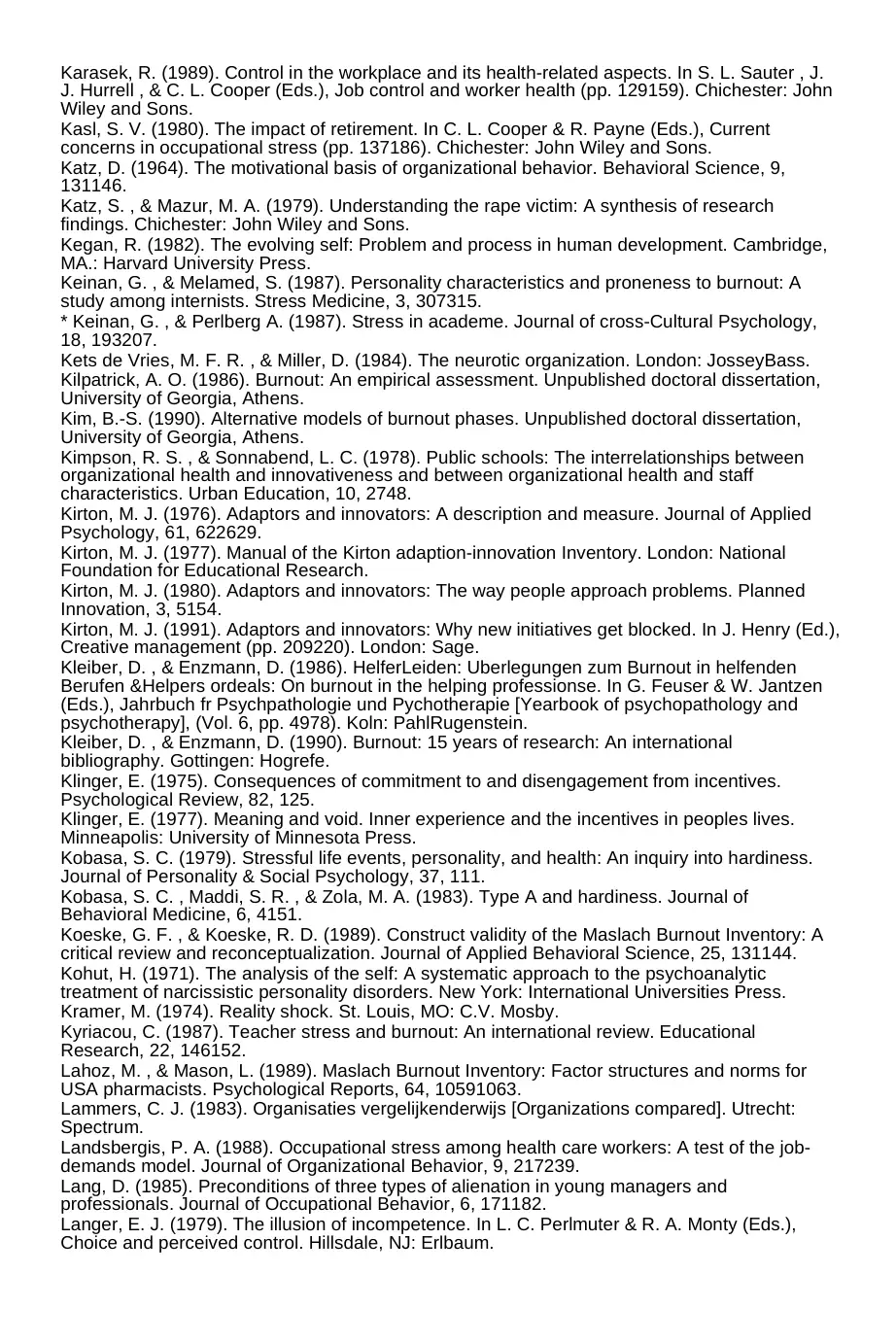
Karasek, R. (1989). Control in the workplace and its health-related aspects. In S. L. Sauter , J.
J. Hurrell , & C. L. Cooper (Eds.), Job control and worker health (pp. 129159). Chichester: John
Wiley and Sons.
Kasl, S. V. (1980). The impact of retirement. In C. L. Cooper & R. Payne (Eds.), Current
concerns in occupational stress (pp. 137186). Chichester: John Wiley and Sons.
Katz, D. (1964). The motivational basis of organizational behavior. Behavioral Science, 9,
131146.
Katz, S. , & Mazur, M. A. (1979). Understanding the rape victim: A synthesis of research
findings. Chichester: John Wiley and Sons.
Kegan, R. (1982). The evolving self: Problem and process in human development. Cambridge,
MA.: Harvard University Press.
Keinan, G. , & Melamed, S. (1987). Personality characteristics and proneness to burnout: A
study among internists. Stress Medicine, 3, 307315.
* Keinan, G. , & Perlberg A. (1987). Stress in academe. Journal of cross-Cultural Psychology,
18, 193207.
Kets de Vries, M. F. R. , & Miller, D. (1984). The neurotic organization. London: JosseyBass.
Kilpatrick, A. O. (1986). Burnout: An empirical assessment. Unpublished doctoral dissertation,
University of Georgia, Athens.
Kim, B.-S. (1990). Alternative models of burnout phases. Unpublished doctoral dissertation,
University of Georgia, Athens.
Kimpson, R. S. , & Sonnabend, L. C. (1978). Public schools: The interrelationships between
organizational health and innovativeness and between organizational health and staff
characteristics. Urban Education, 10, 2748.
Kirton, M. J. (1976). Adaptors and innovators: A description and measure. Journal of Applied
Psychology, 61, 622629.
Kirton, M. J. (1977). Manual of the Kirton adaption-innovation Inventory. London: National
Foundation for Educational Research.
Kirton, M. J. (1980). Adaptors and innovators: The way people approach problems. Planned
Innovation, 3, 5154.
Kirton, M. J. (1991). Adaptors and innovators: Why new initiatives get blocked. In J. Henry (Ed.),
Creative management (pp. 209220). London: Sage.
Kleiber, D. , & Enzmann, D. (1986). HelferLeiden: Uberlegungen zum Burnout in helfenden
Berufen &Helpers ordeals: On burnout in the helping professionse. In G. Feuser & W. Jantzen
(Eds.), Jahrbuch fr Psychpathologie und Pychotherapie [Yearbook of psychopathology and
psychotherapy], (Vol. 6, pp. 4978). Koln: PahlRugenstein.
Kleiber, D. , & Enzmann, D. (1990). Burnout: 15 years of research: An international
bibliography. Gottingen: Hogrefe.
Klinger, E. (1975). Consequences of commitment to and disengagement from incentives.
Psychological Review, 82, 125.
Klinger, E. (1977). Meaning and void. Inner experience and the incentives in peoples lives.
Minneapolis: University of Minnesota Press.
Kobasa, S. C. (1979). Stressful life events, personality, and health: An inquiry into hardiness.
Journal of Personality & Social Psychology, 37, 111.
Kobasa, S. C. , Maddi, S. R. , & Zola, M. A. (1983). Type A and hardiness. Journal of
Behavioral Medicine, 6, 4151.
Koeske, G. F. , & Koeske, R. D. (1989). Construct validity of the Maslach Burnout Inventory: A
critical review and reconceptualization. Journal of Applied Behavioral Science, 25, 131144.
Kohut, H. (1971). The analysis of the self: A systematic approach to the psychoanalytic
treatment of narcissistic personality disorders. New York: International Universities Press.
Kramer, M. (1974). Reality shock. St. Louis, MO: C.V. Mosby.
Kyriacou, C. (1987). Teacher stress and burnout: An international review. Educational
Research, 22, 146152.
Lahoz, M. , & Mason, L. (1989). Maslach Burnout Inventory: Factor structures and norms for
USA pharmacists. Psychological Reports, 64, 10591063.
Lammers, C. J. (1983). Organisaties vergelijkenderwijs [Organizations compared]. Utrecht:
Spectrum.
Landsbergis, P. A. (1988). Occupational stress among health care workers: A test of the job-
demands model. Journal of Organizational Behavior, 9, 217239.
Lang, D. (1985). Preconditions of three types of alienation in young managers and
professionals. Journal of Occupational Behavior, 6, 171182.
Langer, E. J. (1979). The illusion of incompetence. In L. C. Perlmuter & R. A. Monty (Eds.),
Choice and perceived control. Hillsdale, NJ: Erlbaum.
J. Hurrell , & C. L. Cooper (Eds.), Job control and worker health (pp. 129159). Chichester: John
Wiley and Sons.
Kasl, S. V. (1980). The impact of retirement. In C. L. Cooper & R. Payne (Eds.), Current
concerns in occupational stress (pp. 137186). Chichester: John Wiley and Sons.
Katz, D. (1964). The motivational basis of organizational behavior. Behavioral Science, 9,
131146.
Katz, S. , & Mazur, M. A. (1979). Understanding the rape victim: A synthesis of research
findings. Chichester: John Wiley and Sons.
Kegan, R. (1982). The evolving self: Problem and process in human development. Cambridge,
MA.: Harvard University Press.
Keinan, G. , & Melamed, S. (1987). Personality characteristics and proneness to burnout: A
study among internists. Stress Medicine, 3, 307315.
* Keinan, G. , & Perlberg A. (1987). Stress in academe. Journal of cross-Cultural Psychology,
18, 193207.
Kets de Vries, M. F. R. , & Miller, D. (1984). The neurotic organization. London: JosseyBass.
Kilpatrick, A. O. (1986). Burnout: An empirical assessment. Unpublished doctoral dissertation,
University of Georgia, Athens.
Kim, B.-S. (1990). Alternative models of burnout phases. Unpublished doctoral dissertation,
University of Georgia, Athens.
Kimpson, R. S. , & Sonnabend, L. C. (1978). Public schools: The interrelationships between
organizational health and innovativeness and between organizational health and staff
characteristics. Urban Education, 10, 2748.
Kirton, M. J. (1976). Adaptors and innovators: A description and measure. Journal of Applied
Psychology, 61, 622629.
Kirton, M. J. (1977). Manual of the Kirton adaption-innovation Inventory. London: National
Foundation for Educational Research.
Kirton, M. J. (1980). Adaptors and innovators: The way people approach problems. Planned
Innovation, 3, 5154.
Kirton, M. J. (1991). Adaptors and innovators: Why new initiatives get blocked. In J. Henry (Ed.),
Creative management (pp. 209220). London: Sage.
Kleiber, D. , & Enzmann, D. (1986). HelferLeiden: Uberlegungen zum Burnout in helfenden
Berufen &Helpers ordeals: On burnout in the helping professionse. In G. Feuser & W. Jantzen
(Eds.), Jahrbuch fr Psychpathologie und Pychotherapie [Yearbook of psychopathology and
psychotherapy], (Vol. 6, pp. 4978). Koln: PahlRugenstein.
Kleiber, D. , & Enzmann, D. (1990). Burnout: 15 years of research: An international
bibliography. Gottingen: Hogrefe.
Klinger, E. (1975). Consequences of commitment to and disengagement from incentives.
Psychological Review, 82, 125.
Klinger, E. (1977). Meaning and void. Inner experience and the incentives in peoples lives.
Minneapolis: University of Minnesota Press.
Kobasa, S. C. (1979). Stressful life events, personality, and health: An inquiry into hardiness.
Journal of Personality & Social Psychology, 37, 111.
Kobasa, S. C. , Maddi, S. R. , & Zola, M. A. (1983). Type A and hardiness. Journal of
Behavioral Medicine, 6, 4151.
Koeske, G. F. , & Koeske, R. D. (1989). Construct validity of the Maslach Burnout Inventory: A
critical review and reconceptualization. Journal of Applied Behavioral Science, 25, 131144.
Kohut, H. (1971). The analysis of the self: A systematic approach to the psychoanalytic
treatment of narcissistic personality disorders. New York: International Universities Press.
Kramer, M. (1974). Reality shock. St. Louis, MO: C.V. Mosby.
Kyriacou, C. (1987). Teacher stress and burnout: An international review. Educational
Research, 22, 146152.
Lahoz, M. , & Mason, L. (1989). Maslach Burnout Inventory: Factor structures and norms for
USA pharmacists. Psychological Reports, 64, 10591063.
Lammers, C. J. (1983). Organisaties vergelijkenderwijs [Organizations compared]. Utrecht:
Spectrum.
Landsbergis, P. A. (1988). Occupational stress among health care workers: A test of the job-
demands model. Journal of Organizational Behavior, 9, 217239.
Lang, D. (1985). Preconditions of three types of alienation in young managers and
professionals. Journal of Occupational Behavior, 6, 171182.
Langer, E. J. (1979). The illusion of incompetence. In L. C. Perlmuter & R. A. Monty (Eds.),
Choice and perceived control. Hillsdale, NJ: Erlbaum.
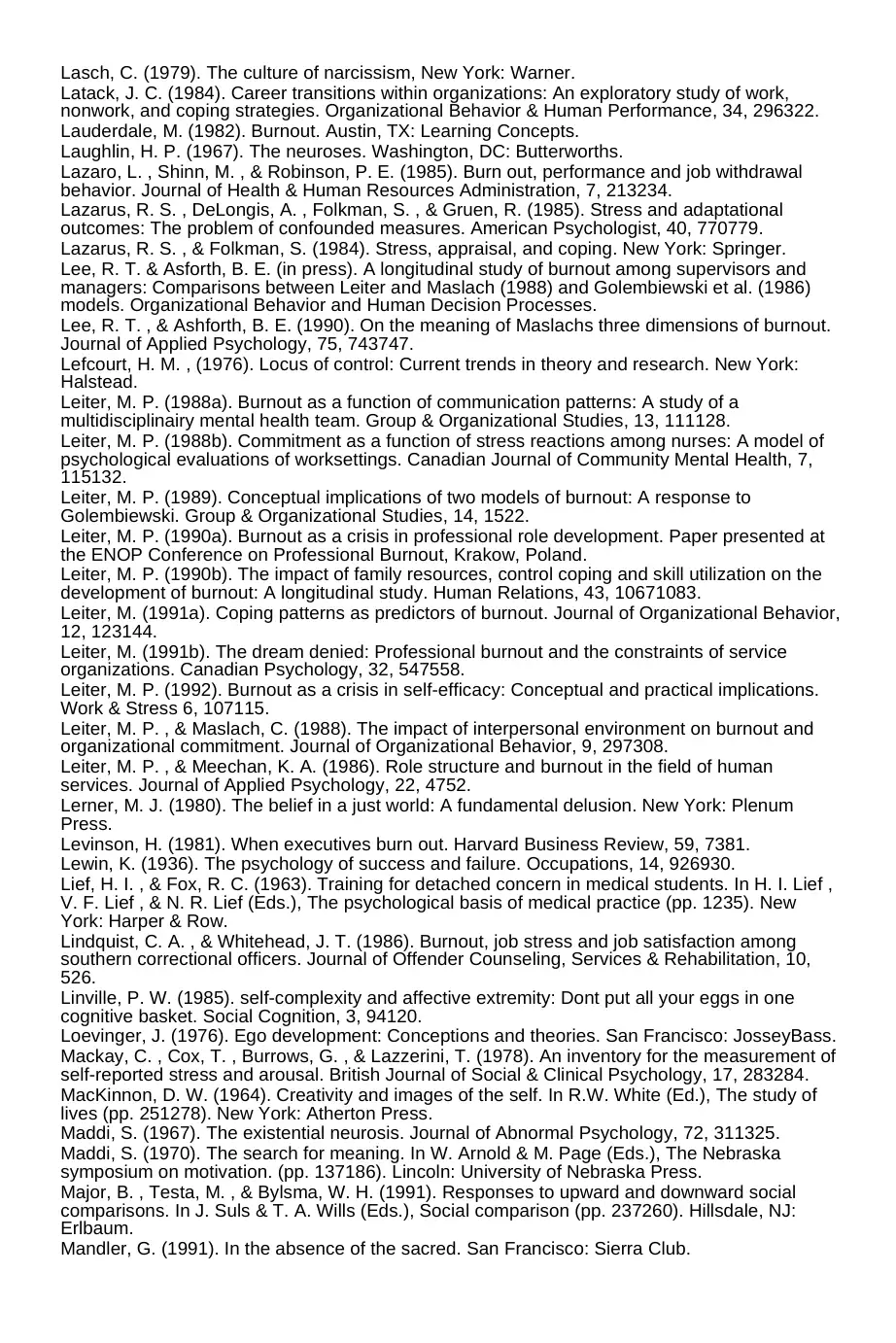
Lasch, C. (1979). The culture of narcissism, New York: Warner.
Latack, J. C. (1984). Career transitions within organizations: An exploratory study of work,
nonwork, and coping strategies. Organizational Behavior & Human Performance, 34, 296322.
Lauderdale, M. (1982). Burnout. Austin, TX: Learning Concepts.
Laughlin, H. P. (1967). The neuroses. Washington, DC: Butterworths.
Lazaro, L. , Shinn, M. , & Robinson, P. E. (1985). Burn out, performance and job withdrawal
behavior. Journal of Health & Human Resources Administration, 7, 213234.
Lazarus, R. S. , DeLongis, A. , Folkman, S. , & Gruen, R. (1985). Stress and adaptational
outcomes: The problem of confounded measures. American Psychologist, 40, 770779.
Lazarus, R. S. , & Folkman, S. (1984). Stress, appraisal, and coping. New York: Springer.
Lee, R. T. & Asforth, B. E. (in press). A longitudinal study of burnout among supervisors and
managers: Comparisons between Leiter and Maslach (1988) and Golembiewski et al. (1986)
models. Organizational Behavior and Human Decision Processes.
Lee, R. T. , & Ashforth, B. E. (1990). On the meaning of Maslachs three dimensions of burnout.
Journal of Applied Psychology, 75, 743747.
Lefcourt, H. M. , (1976). Locus of control: Current trends in theory and research. New York:
Halstead.
Leiter, M. P. (1988a). Burnout as a function of communication patterns: A study of a
multidisciplinairy mental health team. Group & Organizational Studies, 13, 111128.
Leiter, M. P. (1988b). Commitment as a function of stress reactions among nurses: A model of
psychological evaluations of worksettings. Canadian Journal of Community Mental Health, 7,
115132.
Leiter, M. P. (1989). Conceptual implications of two models of burnout: A response to
Golembiewski. Group & Organizational Studies, 14, 1522.
Leiter, M. P. (1990a). Burnout as a crisis in professional role development. Paper presented at
the ENOP Conference on Professional Burnout, Krakow, Poland.
Leiter, M. P. (1990b). The impact of family resources, control coping and skill utilization on the
development of burnout: A longitudinal study. Human Relations, 43, 10671083.
Leiter, M. (1991a). Coping patterns as predictors of burnout. Journal of Organizational Behavior,
12, 123144.
Leiter, M. (1991b). The dream denied: Professional burnout and the constraints of service
organizations. Canadian Psychology, 32, 547558.
Leiter, M. P. (1992). Burnout as a crisis in self-efficacy: Conceptual and practical implications.
Work & Stress 6, 107115.
Leiter, M. P. , & Maslach, C. (1988). The impact of interpersonal environment on burnout and
organizational commitment. Journal of Organizational Behavior, 9, 297308.
Leiter, M. P. , & Meechan, K. A. (1986). Role structure and burnout in the field of human
services. Journal of Applied Psychology, 22, 4752.
Lerner, M. J. (1980). The belief in a just world: A fundamental delusion. New York: Plenum
Press.
Levinson, H. (1981). When executives burn out. Harvard Business Review, 59, 7381.
Lewin, K. (1936). The psychology of success and failure. Occupations, 14, 926930.
Lief, H. I. , & Fox, R. C. (1963). Training for detached concern in medical students. In H. I. Lief ,
V. F. Lief , & N. R. Lief (Eds.), The psychological basis of medical practice (pp. 1235). New
York: Harper & Row.
Lindquist, C. A. , & Whitehead, J. T. (1986). Burnout, job stress and job satisfaction among
southern correctional officers. Journal of Offender Counseling, Services & Rehabilitation, 10,
526.
Linville, P. W. (1985). self-complexity and affective extremity: Dont put all your eggs in one
cognitive basket. Social Cognition, 3, 94120.
Loevinger, J. (1976). Ego development: Conceptions and theories. San Francisco: JosseyBass.
Mackay, C. , Cox, T. , Burrows, G. , & Lazzerini, T. (1978). An inventory for the measurement of
self-reported stress and arousal. British Journal of Social & Clinical Psychology, 17, 283284.
MacKinnon, D. W. (1964). Creativity and images of the self. In R.W. White (Ed.), The study of
lives (pp. 251278). New York: Atherton Press.
Maddi, S. (1967). The existential neurosis. Journal of Abnormal Psychology, 72, 311325.
Maddi, S. (1970). The search for meaning. In W. Arnold & M. Page (Eds.), The Nebraska
symposium on motivation. (pp. 137186). Lincoln: University of Nebraska Press.
Major, B. , Testa, M. , & Bylsma, W. H. (1991). Responses to upward and downward social
comparisons. In J. Suls & T. A. Wills (Eds.), Social comparison (pp. 237260). Hillsdale, NJ:
Erlbaum.
Mandler, G. (1991). In the absence of the sacred. San Francisco: Sierra Club.
Latack, J. C. (1984). Career transitions within organizations: An exploratory study of work,
nonwork, and coping strategies. Organizational Behavior & Human Performance, 34, 296322.
Lauderdale, M. (1982). Burnout. Austin, TX: Learning Concepts.
Laughlin, H. P. (1967). The neuroses. Washington, DC: Butterworths.
Lazaro, L. , Shinn, M. , & Robinson, P. E. (1985). Burn out, performance and job withdrawal
behavior. Journal of Health & Human Resources Administration, 7, 213234.
Lazarus, R. S. , DeLongis, A. , Folkman, S. , & Gruen, R. (1985). Stress and adaptational
outcomes: The problem of confounded measures. American Psychologist, 40, 770779.
Lazarus, R. S. , & Folkman, S. (1984). Stress, appraisal, and coping. New York: Springer.
Lee, R. T. & Asforth, B. E. (in press). A longitudinal study of burnout among supervisors and
managers: Comparisons between Leiter and Maslach (1988) and Golembiewski et al. (1986)
models. Organizational Behavior and Human Decision Processes.
Lee, R. T. , & Ashforth, B. E. (1990). On the meaning of Maslachs three dimensions of burnout.
Journal of Applied Psychology, 75, 743747.
Lefcourt, H. M. , (1976). Locus of control: Current trends in theory and research. New York:
Halstead.
Leiter, M. P. (1988a). Burnout as a function of communication patterns: A study of a
multidisciplinairy mental health team. Group & Organizational Studies, 13, 111128.
Leiter, M. P. (1988b). Commitment as a function of stress reactions among nurses: A model of
psychological evaluations of worksettings. Canadian Journal of Community Mental Health, 7,
115132.
Leiter, M. P. (1989). Conceptual implications of two models of burnout: A response to
Golembiewski. Group & Organizational Studies, 14, 1522.
Leiter, M. P. (1990a). Burnout as a crisis in professional role development. Paper presented at
the ENOP Conference on Professional Burnout, Krakow, Poland.
Leiter, M. P. (1990b). The impact of family resources, control coping and skill utilization on the
development of burnout: A longitudinal study. Human Relations, 43, 10671083.
Leiter, M. (1991a). Coping patterns as predictors of burnout. Journal of Organizational Behavior,
12, 123144.
Leiter, M. (1991b). The dream denied: Professional burnout and the constraints of service
organizations. Canadian Psychology, 32, 547558.
Leiter, M. P. (1992). Burnout as a crisis in self-efficacy: Conceptual and practical implications.
Work & Stress 6, 107115.
Leiter, M. P. , & Maslach, C. (1988). The impact of interpersonal environment on burnout and
organizational commitment. Journal of Organizational Behavior, 9, 297308.
Leiter, M. P. , & Meechan, K. A. (1986). Role structure and burnout in the field of human
services. Journal of Applied Psychology, 22, 4752.
Lerner, M. J. (1980). The belief in a just world: A fundamental delusion. New York: Plenum
Press.
Levinson, H. (1981). When executives burn out. Harvard Business Review, 59, 7381.
Lewin, K. (1936). The psychology of success and failure. Occupations, 14, 926930.
Lief, H. I. , & Fox, R. C. (1963). Training for detached concern in medical students. In H. I. Lief ,
V. F. Lief , & N. R. Lief (Eds.), The psychological basis of medical practice (pp. 1235). New
York: Harper & Row.
Lindquist, C. A. , & Whitehead, J. T. (1986). Burnout, job stress and job satisfaction among
southern correctional officers. Journal of Offender Counseling, Services & Rehabilitation, 10,
526.
Linville, P. W. (1985). self-complexity and affective extremity: Dont put all your eggs in one
cognitive basket. Social Cognition, 3, 94120.
Loevinger, J. (1976). Ego development: Conceptions and theories. San Francisco: JosseyBass.
Mackay, C. , Cox, T. , Burrows, G. , & Lazzerini, T. (1978). An inventory for the measurement of
self-reported stress and arousal. British Journal of Social & Clinical Psychology, 17, 283284.
MacKinnon, D. W. (1964). Creativity and images of the self. In R.W. White (Ed.), The study of
lives (pp. 251278). New York: Atherton Press.
Maddi, S. (1967). The existential neurosis. Journal of Abnormal Psychology, 72, 311325.
Maddi, S. (1970). The search for meaning. In W. Arnold & M. Page (Eds.), The Nebraska
symposium on motivation. (pp. 137186). Lincoln: University of Nebraska Press.
Major, B. , Testa, M. , & Bylsma, W. H. (1991). Responses to upward and downward social
comparisons. In J. Suls & T. A. Wills (Eds.), Social comparison (pp. 237260). Hillsdale, NJ:
Erlbaum.
Mandler, G. (1991). In the absence of the sacred. San Francisco: Sierra Club.
Secure Best Marks with AI Grader
Need help grading? Try our AI Grader for instant feedback on your assignments.
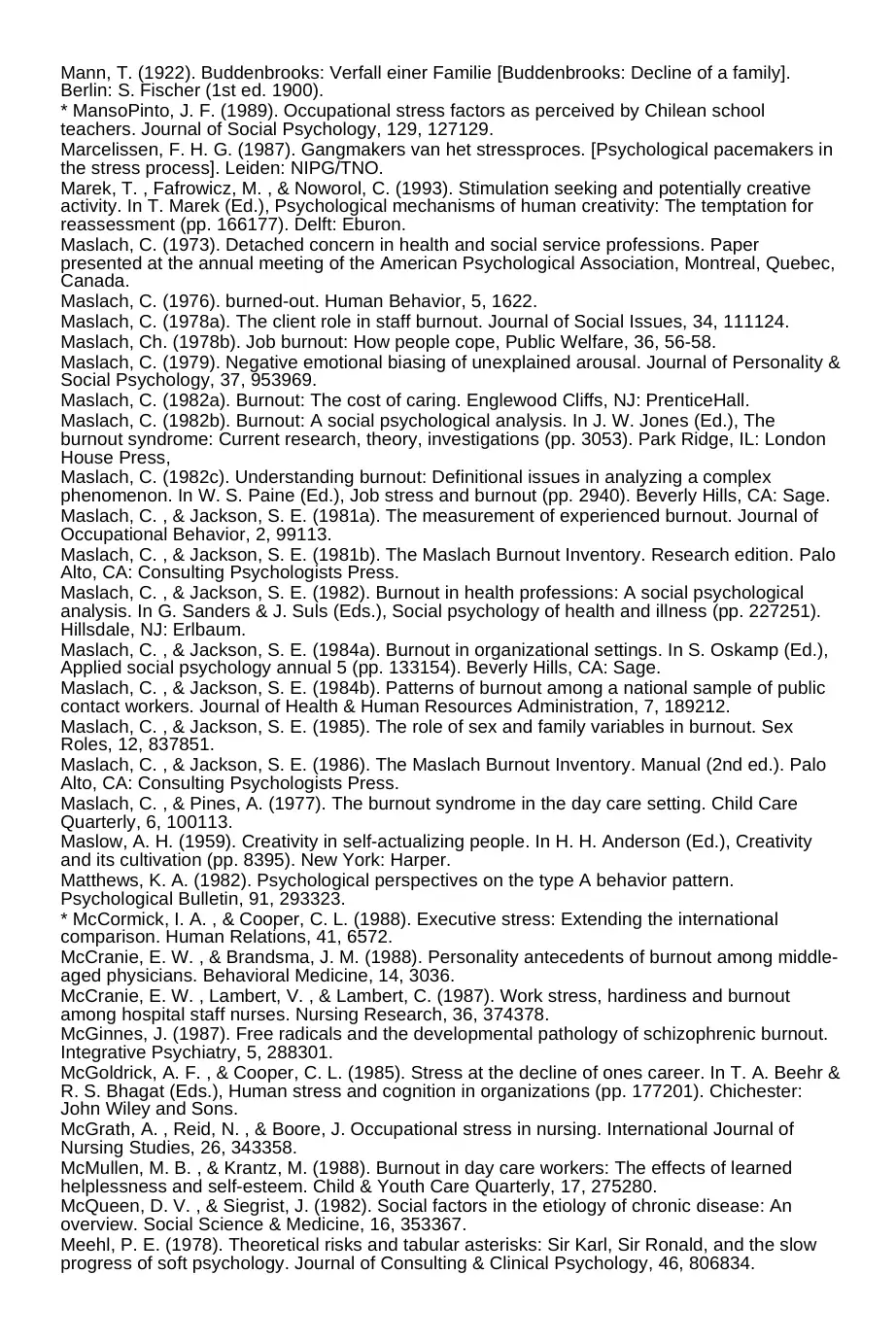
Mann, T. (1922). Buddenbrooks: Verfall einer Familie [Buddenbrooks: Decline of a family].
Berlin: S. Fischer (1st ed. 1900).
* MansoPinto, J. F. (1989). Occupational stress factors as perceived by Chilean school
teachers. Journal of Social Psychology, 129, 127129.
Marcelissen, F. H. G. (1987). Gangmakers van het stressproces. [Psychological pacemakers in
the stress process]. Leiden: NIPG/TNO.
Marek, T. , Fafrowicz, M. , & Noworol, C. (1993). Stimulation seeking and potentially creative
activity. In T. Marek (Ed.), Psychological mechanisms of human creativity: The temptation for
reassessment (pp. 166177). Delft: Eburon.
Maslach, C. (1973). Detached concern in health and social service professions. Paper
presented at the annual meeting of the American Psychological Association, Montreal, Quebec,
Canada.
Maslach, C. (1976). burned-out. Human Behavior, 5, 1622.
Maslach, C. (1978a). The client role in staff burnout. Journal of Social Issues, 34, 111124.
Maslach, Ch. (1978b). Job burnout: How people cope, Public Welfare, 36, 56-58.
Maslach, C. (1979). Negative emotional biasing of unexplained arousal. Journal of Personality &
Social Psychology, 37, 953969.
Maslach, C. (1982a). Burnout: The cost of caring. Englewood Cliffs, NJ: PrenticeHall.
Maslach, C. (1982b). Burnout: A social psychological analysis. In J. W. Jones (Ed.), The
burnout syndrome: Current research, theory, investigations (pp. 3053). Park Ridge, IL: London
House Press,
Maslach, C. (1982c). Understanding burnout: Definitional issues in analyzing a complex
phenomenon. In W. S. Paine (Ed.), Job stress and burnout (pp. 2940). Beverly Hills, CA: Sage.
Maslach, C. , & Jackson, S. E. (1981a). The measurement of experienced burnout. Journal of
Occupational Behavior, 2, 99113.
Maslach, C. , & Jackson, S. E. (1981b). The Maslach Burnout Inventory. Research edition. Palo
Alto, CA: Consulting Psychologists Press.
Maslach, C. , & Jackson, S. E. (1982). Burnout in health professions: A social psychological
analysis. In G. Sanders & J. Suls (Eds.), Social psychology of health and illness (pp. 227251).
Hillsdale, NJ: Erlbaum.
Maslach, C. , & Jackson, S. E. (1984a). Burnout in organizational settings. In S. Oskamp (Ed.),
Applied social psychology annual 5 (pp. 133154). Beverly Hills, CA: Sage.
Maslach, C. , & Jackson, S. E. (1984b). Patterns of burnout among a national sample of public
contact workers. Journal of Health & Human Resources Administration, 7, 189212.
Maslach, C. , & Jackson, S. E. (1985). The role of sex and family variables in burnout. Sex
Roles, 12, 837851.
Maslach, C. , & Jackson, S. E. (1986). The Maslach Burnout Inventory. Manual (2nd ed.). Palo
Alto, CA: Consulting Psychologists Press.
Maslach, C. , & Pines, A. (1977). The burnout syndrome in the day care setting. Child Care
Quarterly, 6, 100113.
Maslow, A. H. (1959). Creativity in self-actualizing people. In H. H. Anderson (Ed.), Creativity
and its cultivation (pp. 8395). New York: Harper.
Matthews, K. A. (1982). Psychological perspectives on the type A behavior pattern.
Psychological Bulletin, 91, 293323.
* McCormick, I. A. , & Cooper, C. L. (1988). Executive stress: Extending the international
comparison. Human Relations, 41, 6572.
McCranie, E. W. , & Brandsma, J. M. (1988). Personality antecedents of burnout among middle-
aged physicians. Behavioral Medicine, 14, 3036.
McCranie, E. W. , Lambert, V. , & Lambert, C. (1987). Work stress, hardiness and burnout
among hospital staff nurses. Nursing Research, 36, 374378.
McGinnes, J. (1987). Free radicals and the developmental pathology of schizophrenic burnout.
Integrative Psychiatry, 5, 288301.
McGoldrick, A. F. , & Cooper, C. L. (1985). Stress at the decline of ones career. In T. A. Beehr &
R. S. Bhagat (Eds.), Human stress and cognition in organizations (pp. 177201). Chichester:
John Wiley and Sons.
McGrath, A. , Reid, N. , & Boore, J. Occupational stress in nursing. International Journal of
Nursing Studies, 26, 343358.
McMullen, M. B. , & Krantz, M. (1988). Burnout in day care workers: The effects of learned
helplessness and self-esteem. Child & Youth Care Quarterly, 17, 275280.
McQueen, D. V. , & Siegrist, J. (1982). Social factors in the etiology of chronic disease: An
overview. Social Science & Medicine, 16, 353367.
Meehl, P. E. (1978). Theoretical risks and tabular asterisks: Sir Karl, Sir Ronald, and the slow
progress of soft psychology. Journal of Consulting & Clinical Psychology, 46, 806834.
Berlin: S. Fischer (1st ed. 1900).
* MansoPinto, J. F. (1989). Occupational stress factors as perceived by Chilean school
teachers. Journal of Social Psychology, 129, 127129.
Marcelissen, F. H. G. (1987). Gangmakers van het stressproces. [Psychological pacemakers in
the stress process]. Leiden: NIPG/TNO.
Marek, T. , Fafrowicz, M. , & Noworol, C. (1993). Stimulation seeking and potentially creative
activity. In T. Marek (Ed.), Psychological mechanisms of human creativity: The temptation for
reassessment (pp. 166177). Delft: Eburon.
Maslach, C. (1973). Detached concern in health and social service professions. Paper
presented at the annual meeting of the American Psychological Association, Montreal, Quebec,
Canada.
Maslach, C. (1976). burned-out. Human Behavior, 5, 1622.
Maslach, C. (1978a). The client role in staff burnout. Journal of Social Issues, 34, 111124.
Maslach, Ch. (1978b). Job burnout: How people cope, Public Welfare, 36, 56-58.
Maslach, C. (1979). Negative emotional biasing of unexplained arousal. Journal of Personality &
Social Psychology, 37, 953969.
Maslach, C. (1982a). Burnout: The cost of caring. Englewood Cliffs, NJ: PrenticeHall.
Maslach, C. (1982b). Burnout: A social psychological analysis. In J. W. Jones (Ed.), The
burnout syndrome: Current research, theory, investigations (pp. 3053). Park Ridge, IL: London
House Press,
Maslach, C. (1982c). Understanding burnout: Definitional issues in analyzing a complex
phenomenon. In W. S. Paine (Ed.), Job stress and burnout (pp. 2940). Beverly Hills, CA: Sage.
Maslach, C. , & Jackson, S. E. (1981a). The measurement of experienced burnout. Journal of
Occupational Behavior, 2, 99113.
Maslach, C. , & Jackson, S. E. (1981b). The Maslach Burnout Inventory. Research edition. Palo
Alto, CA: Consulting Psychologists Press.
Maslach, C. , & Jackson, S. E. (1982). Burnout in health professions: A social psychological
analysis. In G. Sanders & J. Suls (Eds.), Social psychology of health and illness (pp. 227251).
Hillsdale, NJ: Erlbaum.
Maslach, C. , & Jackson, S. E. (1984a). Burnout in organizational settings. In S. Oskamp (Ed.),
Applied social psychology annual 5 (pp. 133154). Beverly Hills, CA: Sage.
Maslach, C. , & Jackson, S. E. (1984b). Patterns of burnout among a national sample of public
contact workers. Journal of Health & Human Resources Administration, 7, 189212.
Maslach, C. , & Jackson, S. E. (1985). The role of sex and family variables in burnout. Sex
Roles, 12, 837851.
Maslach, C. , & Jackson, S. E. (1986). The Maslach Burnout Inventory. Manual (2nd ed.). Palo
Alto, CA: Consulting Psychologists Press.
Maslach, C. , & Pines, A. (1977). The burnout syndrome in the day care setting. Child Care
Quarterly, 6, 100113.
Maslow, A. H. (1959). Creativity in self-actualizing people. In H. H. Anderson (Ed.), Creativity
and its cultivation (pp. 8395). New York: Harper.
Matthews, K. A. (1982). Psychological perspectives on the type A behavior pattern.
Psychological Bulletin, 91, 293323.
* McCormick, I. A. , & Cooper, C. L. (1988). Executive stress: Extending the international
comparison. Human Relations, 41, 6572.
McCranie, E. W. , & Brandsma, J. M. (1988). Personality antecedents of burnout among middle-
aged physicians. Behavioral Medicine, 14, 3036.
McCranie, E. W. , Lambert, V. , & Lambert, C. (1987). Work stress, hardiness and burnout
among hospital staff nurses. Nursing Research, 36, 374378.
McGinnes, J. (1987). Free radicals and the developmental pathology of schizophrenic burnout.
Integrative Psychiatry, 5, 288301.
McGoldrick, A. F. , & Cooper, C. L. (1985). Stress at the decline of ones career. In T. A. Beehr &
R. S. Bhagat (Eds.), Human stress and cognition in organizations (pp. 177201). Chichester:
John Wiley and Sons.
McGrath, A. , Reid, N. , & Boore, J. Occupational stress in nursing. International Journal of
Nursing Studies, 26, 343358.
McMullen, M. B. , & Krantz, M. (1988). Burnout in day care workers: The effects of learned
helplessness and self-esteem. Child & Youth Care Quarterly, 17, 275280.
McQueen, D. V. , & Siegrist, J. (1982). Social factors in the etiology of chronic disease: An
overview. Social Science & Medicine, 16, 353367.
Meehl, P. E. (1978). Theoretical risks and tabular asterisks: Sir Karl, Sir Ronald, and the slow
progress of soft psychology. Journal of Consulting & Clinical Psychology, 46, 806834.
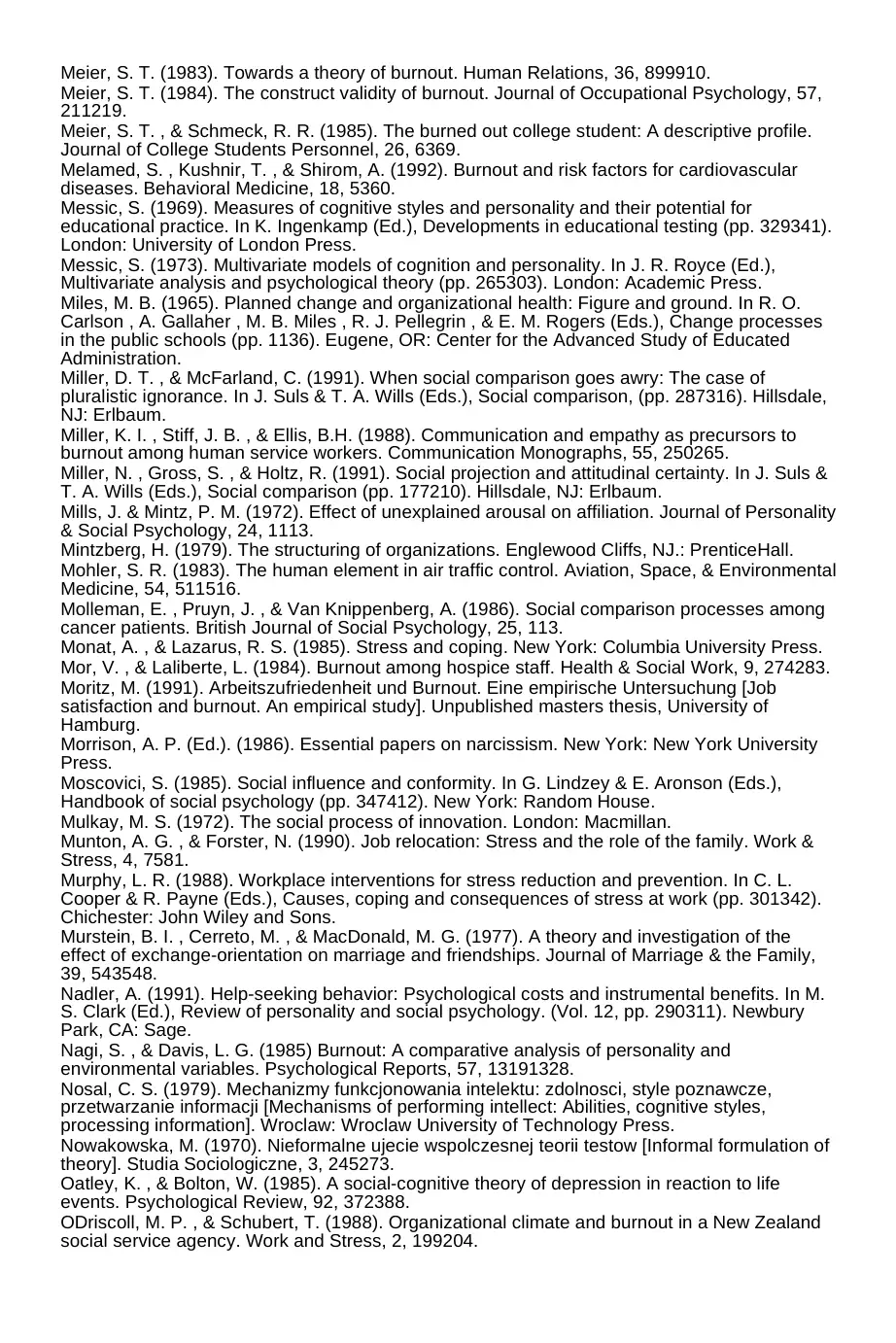
Meier, S. T. (1983). Towards a theory of burnout. Human Relations, 36, 899910.
Meier, S. T. (1984). The construct validity of burnout. Journal of Occupational Psychology, 57,
211219.
Meier, S. T. , & Schmeck, R. R. (1985). The burned out college student: A descriptive profile.
Journal of College Students Personnel, 26, 6369.
Melamed, S. , Kushnir, T. , & Shirom, A. (1992). Burnout and risk factors for cardiovascular
diseases. Behavioral Medicine, 18, 5360.
Messic, S. (1969). Measures of cognitive styles and personality and their potential for
educational practice. In K. Ingenkamp (Ed.), Developments in educational testing (pp. 329341).
London: University of London Press.
Messic, S. (1973). Multivariate models of cognition and personality. In J. R. Royce (Ed.),
Multivariate analysis and psychological theory (pp. 265303). London: Academic Press.
Miles, M. B. (1965). Planned change and organizational health: Figure and ground. In R. O.
Carlson , A. Gallaher , M. B. Miles , R. J. Pellegrin , & E. M. Rogers (Eds.), Change processes
in the public schools (pp. 1136). Eugene, OR: Center for the Advanced Study of Educated
Administration.
Miller, D. T. , & McFarland, C. (1991). When social comparison goes awry: The case of
pluralistic ignorance. In J. Suls & T. A. Wills (Eds.), Social comparison, (pp. 287316). Hillsdale,
NJ: Erlbaum.
Miller, K. I. , Stiff, J. B. , & Ellis, B.H. (1988). Communication and empathy as precursors to
burnout among human service workers. Communication Monographs, 55, 250265.
Miller, N. , Gross, S. , & Holtz, R. (1991). Social projection and attitudinal certainty. In J. Suls &
T. A. Wills (Eds.), Social comparison (pp. 177210). Hillsdale, NJ: Erlbaum.
Mills, J. & Mintz, P. M. (1972). Effect of unexplained arousal on affiliation. Journal of Personality
& Social Psychology, 24, 1113.
Mintzberg, H. (1979). The structuring of organizations. Englewood Cliffs, NJ.: PrenticeHall.
Mohler, S. R. (1983). The human element in air traffic control. Aviation, Space, & Environmental
Medicine, 54, 511516.
Molleman, E. , Pruyn, J. , & Van Knippenberg, A. (1986). Social comparison processes among
cancer patients. British Journal of Social Psychology, 25, 113.
Monat, A. , & Lazarus, R. S. (1985). Stress and coping. New York: Columbia University Press.
Mor, V. , & Laliberte, L. (1984). Burnout among hospice staff. Health & Social Work, 9, 274283.
Moritz, M. (1991). Arbeitszufriedenheit und Burnout. Eine empirische Untersuchung [Job
satisfaction and burnout. An empirical study]. Unpublished masters thesis, University of
Hamburg.
Morrison, A. P. (Ed.). (1986). Essential papers on narcissism. New York: New York University
Press.
Moscovici, S. (1985). Social influence and conformity. In G. Lindzey & E. Aronson (Eds.),
Handbook of social psychology (pp. 347412). New York: Random House.
Mulkay, M. S. (1972). The social process of innovation. London: Macmillan.
Munton, A. G. , & Forster, N. (1990). Job relocation: Stress and the role of the family. Work &
Stress, 4, 7581.
Murphy, L. R. (1988). Workplace interventions for stress reduction and prevention. In C. L.
Cooper & R. Payne (Eds.), Causes, coping and consequences of stress at work (pp. 301342).
Chichester: John Wiley and Sons.
Murstein, B. I. , Cerreto, M. , & MacDonald, M. G. (1977). A theory and investigation of the
effect of exchange-orientation on marriage and friendships. Journal of Marriage & the Family,
39, 543548.
Nadler, A. (1991). Help-seeking behavior: Psychological costs and instrumental benefits. In M.
S. Clark (Ed.), Review of personality and social psychology. (Vol. 12, pp. 290311). Newbury
Park, CA: Sage.
Nagi, S. , & Davis, L. G. (1985) Burnout: A comparative analysis of personality and
environmental variables. Psychological Reports, 57, 13191328.
Nosal, C. S. (1979). Mechanizmy funkcjonowania intelektu: zdolnosci, style poznawcze,
przetwarzanie informacji [Mechanisms of performing intellect: Abilities, cognitive styles,
processing information]. Wroclaw: Wroclaw University of Technology Press.
Nowakowska, M. (1970). Nieformalne ujecie wspolczesnej teorii testow [Informal formulation of
theory]. Studia Sociologiczne, 3, 245273.
Oatley, K. , & Bolton, W. (1985). A social-cognitive theory of depression in reaction to life
events. Psychological Review, 92, 372388.
ODriscoll, M. P. , & Schubert, T. (1988). Organizational climate and burnout in a New Zealand
social service agency. Work and Stress, 2, 199204.
Meier, S. T. (1984). The construct validity of burnout. Journal of Occupational Psychology, 57,
211219.
Meier, S. T. , & Schmeck, R. R. (1985). The burned out college student: A descriptive profile.
Journal of College Students Personnel, 26, 6369.
Melamed, S. , Kushnir, T. , & Shirom, A. (1992). Burnout and risk factors for cardiovascular
diseases. Behavioral Medicine, 18, 5360.
Messic, S. (1969). Measures of cognitive styles and personality and their potential for
educational practice. In K. Ingenkamp (Ed.), Developments in educational testing (pp. 329341).
London: University of London Press.
Messic, S. (1973). Multivariate models of cognition and personality. In J. R. Royce (Ed.),
Multivariate analysis and psychological theory (pp. 265303). London: Academic Press.
Miles, M. B. (1965). Planned change and organizational health: Figure and ground. In R. O.
Carlson , A. Gallaher , M. B. Miles , R. J. Pellegrin , & E. M. Rogers (Eds.), Change processes
in the public schools (pp. 1136). Eugene, OR: Center for the Advanced Study of Educated
Administration.
Miller, D. T. , & McFarland, C. (1991). When social comparison goes awry: The case of
pluralistic ignorance. In J. Suls & T. A. Wills (Eds.), Social comparison, (pp. 287316). Hillsdale,
NJ: Erlbaum.
Miller, K. I. , Stiff, J. B. , & Ellis, B.H. (1988). Communication and empathy as precursors to
burnout among human service workers. Communication Monographs, 55, 250265.
Miller, N. , Gross, S. , & Holtz, R. (1991). Social projection and attitudinal certainty. In J. Suls &
T. A. Wills (Eds.), Social comparison (pp. 177210). Hillsdale, NJ: Erlbaum.
Mills, J. & Mintz, P. M. (1972). Effect of unexplained arousal on affiliation. Journal of Personality
& Social Psychology, 24, 1113.
Mintzberg, H. (1979). The structuring of organizations. Englewood Cliffs, NJ.: PrenticeHall.
Mohler, S. R. (1983). The human element in air traffic control. Aviation, Space, & Environmental
Medicine, 54, 511516.
Molleman, E. , Pruyn, J. , & Van Knippenberg, A. (1986). Social comparison processes among
cancer patients. British Journal of Social Psychology, 25, 113.
Monat, A. , & Lazarus, R. S. (1985). Stress and coping. New York: Columbia University Press.
Mor, V. , & Laliberte, L. (1984). Burnout among hospice staff. Health & Social Work, 9, 274283.
Moritz, M. (1991). Arbeitszufriedenheit und Burnout. Eine empirische Untersuchung [Job
satisfaction and burnout. An empirical study]. Unpublished masters thesis, University of
Hamburg.
Morrison, A. P. (Ed.). (1986). Essential papers on narcissism. New York: New York University
Press.
Moscovici, S. (1985). Social influence and conformity. In G. Lindzey & E. Aronson (Eds.),
Handbook of social psychology (pp. 347412). New York: Random House.
Mulkay, M. S. (1972). The social process of innovation. London: Macmillan.
Munton, A. G. , & Forster, N. (1990). Job relocation: Stress and the role of the family. Work &
Stress, 4, 7581.
Murphy, L. R. (1988). Workplace interventions for stress reduction and prevention. In C. L.
Cooper & R. Payne (Eds.), Causes, coping and consequences of stress at work (pp. 301342).
Chichester: John Wiley and Sons.
Murstein, B. I. , Cerreto, M. , & MacDonald, M. G. (1977). A theory and investigation of the
effect of exchange-orientation on marriage and friendships. Journal of Marriage & the Family,
39, 543548.
Nadler, A. (1991). Help-seeking behavior: Psychological costs and instrumental benefits. In M.
S. Clark (Ed.), Review of personality and social psychology. (Vol. 12, pp. 290311). Newbury
Park, CA: Sage.
Nagi, S. , & Davis, L. G. (1985) Burnout: A comparative analysis of personality and
environmental variables. Psychological Reports, 57, 13191328.
Nosal, C. S. (1979). Mechanizmy funkcjonowania intelektu: zdolnosci, style poznawcze,
przetwarzanie informacji [Mechanisms of performing intellect: Abilities, cognitive styles,
processing information]. Wroclaw: Wroclaw University of Technology Press.
Nowakowska, M. (1970). Nieformalne ujecie wspolczesnej teorii testow [Informal formulation of
theory]. Studia Sociologiczne, 3, 245273.
Oatley, K. , & Bolton, W. (1985). A social-cognitive theory of depression in reaction to life
events. Psychological Review, 92, 372388.
ODriscoll, M. P. , & Schubert, T. (1988). Organizational climate and burnout in a New Zealand
social service agency. Work and Stress, 2, 199204.
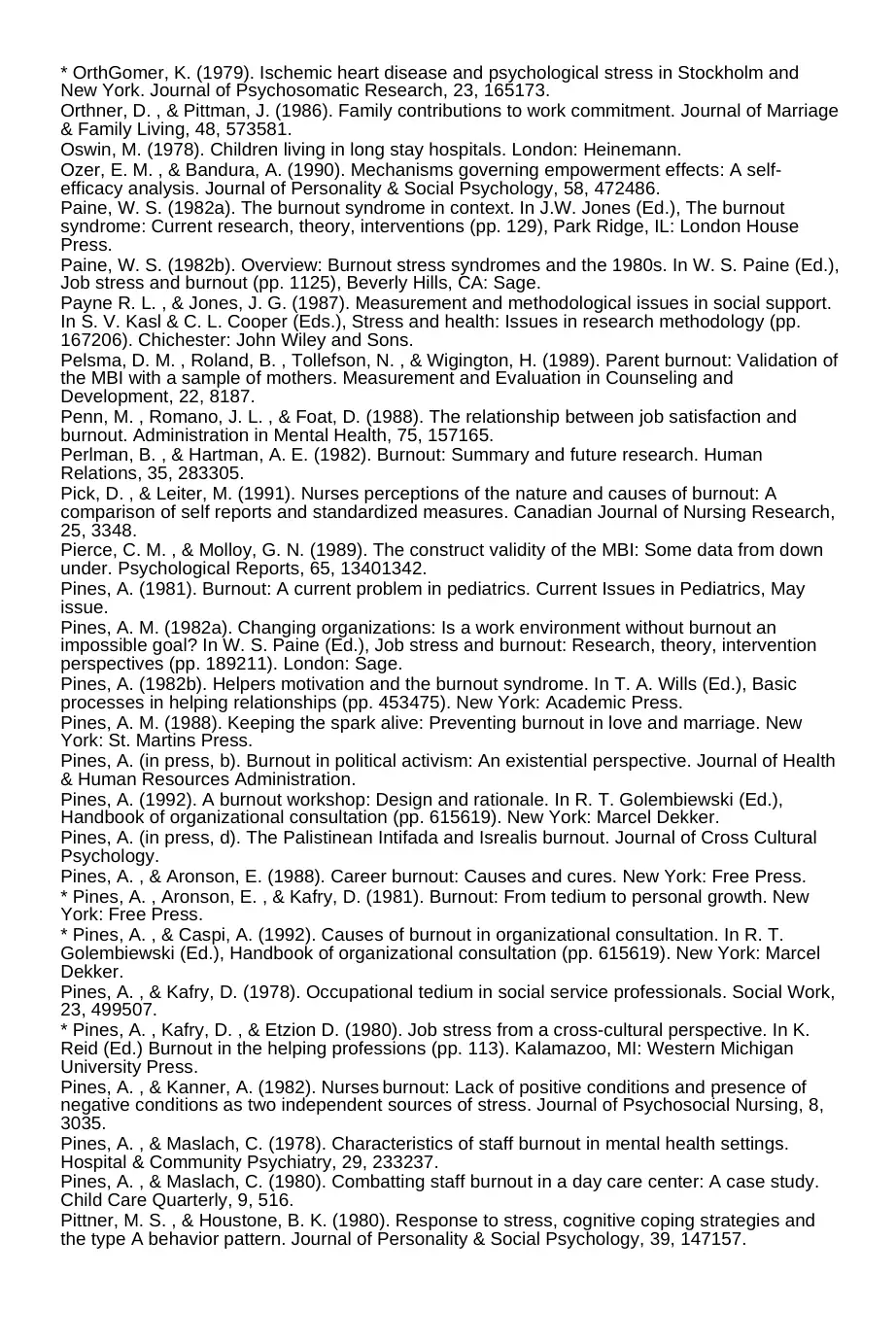
* OrthGomer, K. (1979). Ischemic heart disease and psychological stress in Stockholm and
New York. Journal of Psychosomatic Research, 23, 165173.
Orthner, D. , & Pittman, J. (1986). Family contributions to work commitment. Journal of Marriage
& Family Living, 48, 573581.
Oswin, M. (1978). Children living in long stay hospitals. London: Heinemann.
Ozer, E. M. , & Bandura, A. (1990). Mechanisms governing empowerment effects: A self-
efficacy analysis. Journal of Personality & Social Psychology, 58, 472486.
Paine, W. S. (1982a). The burnout syndrome in context. In J.W. Jones (Ed.), The burnout
syndrome: Current research, theory, interventions (pp. 129), Park Ridge, IL: London House
Press.
Paine, W. S. (1982b). Overview: Burnout stress syndromes and the 1980s. In W. S. Paine (Ed.),
Job stress and burnout (pp. 1125), Beverly Hills, CA: Sage.
Payne R. L. , & Jones, J. G. (1987). Measurement and methodological issues in social support.
In S. V. Kasl & C. L. Cooper (Eds.), Stress and health: Issues in research methodology (pp.
167206). Chichester: John Wiley and Sons.
Pelsma, D. M. , Roland, B. , Tollefson, N. , & Wigington, H. (1989). Parent burnout: Validation of
the MBI with a sample of mothers. Measurement and Evaluation in Counseling and
Development, 22, 8187.
Penn, M. , Romano, J. L. , & Foat, D. (1988). The relationship between job satisfaction and
burnout. Administration in Mental Health, 75, 157165.
Perlman, B. , & Hartman, A. E. (1982). Burnout: Summary and future research. Human
Relations, 35, 283305.
Pick, D. , & Leiter, M. (1991). Nurses perceptions of the nature and causes of burnout: A
comparison of self reports and standardized measures. Canadian Journal of Nursing Research,
25, 3348.
Pierce, C. M. , & Molloy, G. N. (1989). The construct validity of the MBI: Some data from down
under. Psychological Reports, 65, 13401342.
Pines, A. (1981). Burnout: A current problem in pediatrics. Current Issues in Pediatrics, May
issue.
Pines, A. M. (1982a). Changing organizations: Is a work environment without burnout an
impossible goal? In W. S. Paine (Ed.), Job stress and burnout: Research, theory, intervention
perspectives (pp. 189211). London: Sage.
Pines, A. (1982b). Helpers motivation and the burnout syndrome. In T. A. Wills (Ed.), Basic
processes in helping relationships (pp. 453475). New York: Academic Press.
Pines, A. M. (1988). Keeping the spark alive: Preventing burnout in love and marriage. New
York: St. Martins Press.
Pines, A. (in press, b). Burnout in political activism: An existential perspective. Journal of Health
& Human Resources Administration.
Pines, A. (1992). A burnout workshop: Design and rationale. In R. T. Golembiewski (Ed.),
Handbook of organizational consultation (pp. 615619). New York: Marcel Dekker.
Pines, A. (in press, d). The Palistinean Intifada and Isrealis burnout. Journal of Cross Cultural
Psychology.
Pines, A. , & Aronson, E. (1988). Career burnout: Causes and cures. New York: Free Press.
* Pines, A. , Aronson, E. , & Kafry, D. (1981). Burnout: From tedium to personal growth. New
York: Free Press.
* Pines, A. , & Caspi, A. (1992). Causes of burnout in organizational consultation. In R. T.
Golembiewski (Ed.), Handbook of organizational consultation (pp. 615619). New York: Marcel
Dekker.
Pines, A. , & Kafry, D. (1978). Occupational tedium in social service professionals. Social Work,
23, 499507.
* Pines, A. , Kafry, D. , & Etzion D. (1980). Job stress from a cross-cultural perspective. In K.
Reid (Ed.) Burnout in the helping professions (pp. 113). Kalamazoo, MI: Western Michigan
University Press.
Pines, A. , & Kanner, A. (1982). Nurses burnout: Lack of positive conditions and presence of
negative conditions as two independent sources of stress. Journal of Psychosocial Nursing, 8,
3035.
Pines, A. , & Maslach, C. (1978). Characteristics of staff burnout in mental health settings.
Hospital & Community Psychiatry, 29, 233237.
Pines, A. , & Maslach, C. (1980). Combatting staff burnout in a day care center: A case study.
Child Care Quarterly, 9, 516.
Pittner, M. S. , & Houstone, B. K. (1980). Response to stress, cognitive coping strategies and
the type A behavior pattern. Journal of Personality & Social Psychology, 39, 147157.
New York. Journal of Psychosomatic Research, 23, 165173.
Orthner, D. , & Pittman, J. (1986). Family contributions to work commitment. Journal of Marriage
& Family Living, 48, 573581.
Oswin, M. (1978). Children living in long stay hospitals. London: Heinemann.
Ozer, E. M. , & Bandura, A. (1990). Mechanisms governing empowerment effects: A self-
efficacy analysis. Journal of Personality & Social Psychology, 58, 472486.
Paine, W. S. (1982a). The burnout syndrome in context. In J.W. Jones (Ed.), The burnout
syndrome: Current research, theory, interventions (pp. 129), Park Ridge, IL: London House
Press.
Paine, W. S. (1982b). Overview: Burnout stress syndromes and the 1980s. In W. S. Paine (Ed.),
Job stress and burnout (pp. 1125), Beverly Hills, CA: Sage.
Payne R. L. , & Jones, J. G. (1987). Measurement and methodological issues in social support.
In S. V. Kasl & C. L. Cooper (Eds.), Stress and health: Issues in research methodology (pp.
167206). Chichester: John Wiley and Sons.
Pelsma, D. M. , Roland, B. , Tollefson, N. , & Wigington, H. (1989). Parent burnout: Validation of
the MBI with a sample of mothers. Measurement and Evaluation in Counseling and
Development, 22, 8187.
Penn, M. , Romano, J. L. , & Foat, D. (1988). The relationship between job satisfaction and
burnout. Administration in Mental Health, 75, 157165.
Perlman, B. , & Hartman, A. E. (1982). Burnout: Summary and future research. Human
Relations, 35, 283305.
Pick, D. , & Leiter, M. (1991). Nurses perceptions of the nature and causes of burnout: A
comparison of self reports and standardized measures. Canadian Journal of Nursing Research,
25, 3348.
Pierce, C. M. , & Molloy, G. N. (1989). The construct validity of the MBI: Some data from down
under. Psychological Reports, 65, 13401342.
Pines, A. (1981). Burnout: A current problem in pediatrics. Current Issues in Pediatrics, May
issue.
Pines, A. M. (1982a). Changing organizations: Is a work environment without burnout an
impossible goal? In W. S. Paine (Ed.), Job stress and burnout: Research, theory, intervention
perspectives (pp. 189211). London: Sage.
Pines, A. (1982b). Helpers motivation and the burnout syndrome. In T. A. Wills (Ed.), Basic
processes in helping relationships (pp. 453475). New York: Academic Press.
Pines, A. M. (1988). Keeping the spark alive: Preventing burnout in love and marriage. New
York: St. Martins Press.
Pines, A. (in press, b). Burnout in political activism: An existential perspective. Journal of Health
& Human Resources Administration.
Pines, A. (1992). A burnout workshop: Design and rationale. In R. T. Golembiewski (Ed.),
Handbook of organizational consultation (pp. 615619). New York: Marcel Dekker.
Pines, A. (in press, d). The Palistinean Intifada and Isrealis burnout. Journal of Cross Cultural
Psychology.
Pines, A. , & Aronson, E. (1988). Career burnout: Causes and cures. New York: Free Press.
* Pines, A. , Aronson, E. , & Kafry, D. (1981). Burnout: From tedium to personal growth. New
York: Free Press.
* Pines, A. , & Caspi, A. (1992). Causes of burnout in organizational consultation. In R. T.
Golembiewski (Ed.), Handbook of organizational consultation (pp. 615619). New York: Marcel
Dekker.
Pines, A. , & Kafry, D. (1978). Occupational tedium in social service professionals. Social Work,
23, 499507.
* Pines, A. , Kafry, D. , & Etzion D. (1980). Job stress from a cross-cultural perspective. In K.
Reid (Ed.) Burnout in the helping professions (pp. 113). Kalamazoo, MI: Western Michigan
University Press.
Pines, A. , & Kanner, A. (1982). Nurses burnout: Lack of positive conditions and presence of
negative conditions as two independent sources of stress. Journal of Psychosocial Nursing, 8,
3035.
Pines, A. , & Maslach, C. (1978). Characteristics of staff burnout in mental health settings.
Hospital & Community Psychiatry, 29, 233237.
Pines, A. , & Maslach, C. (1980). Combatting staff burnout in a day care center: A case study.
Child Care Quarterly, 9, 516.
Pittner, M. S. , & Houstone, B. K. (1980). Response to stress, cognitive coping strategies and
the type A behavior pattern. Journal of Personality & Social Psychology, 39, 147157.
Paraphrase This Document
Need a fresh take? Get an instant paraphrase of this document with our AI Paraphraser
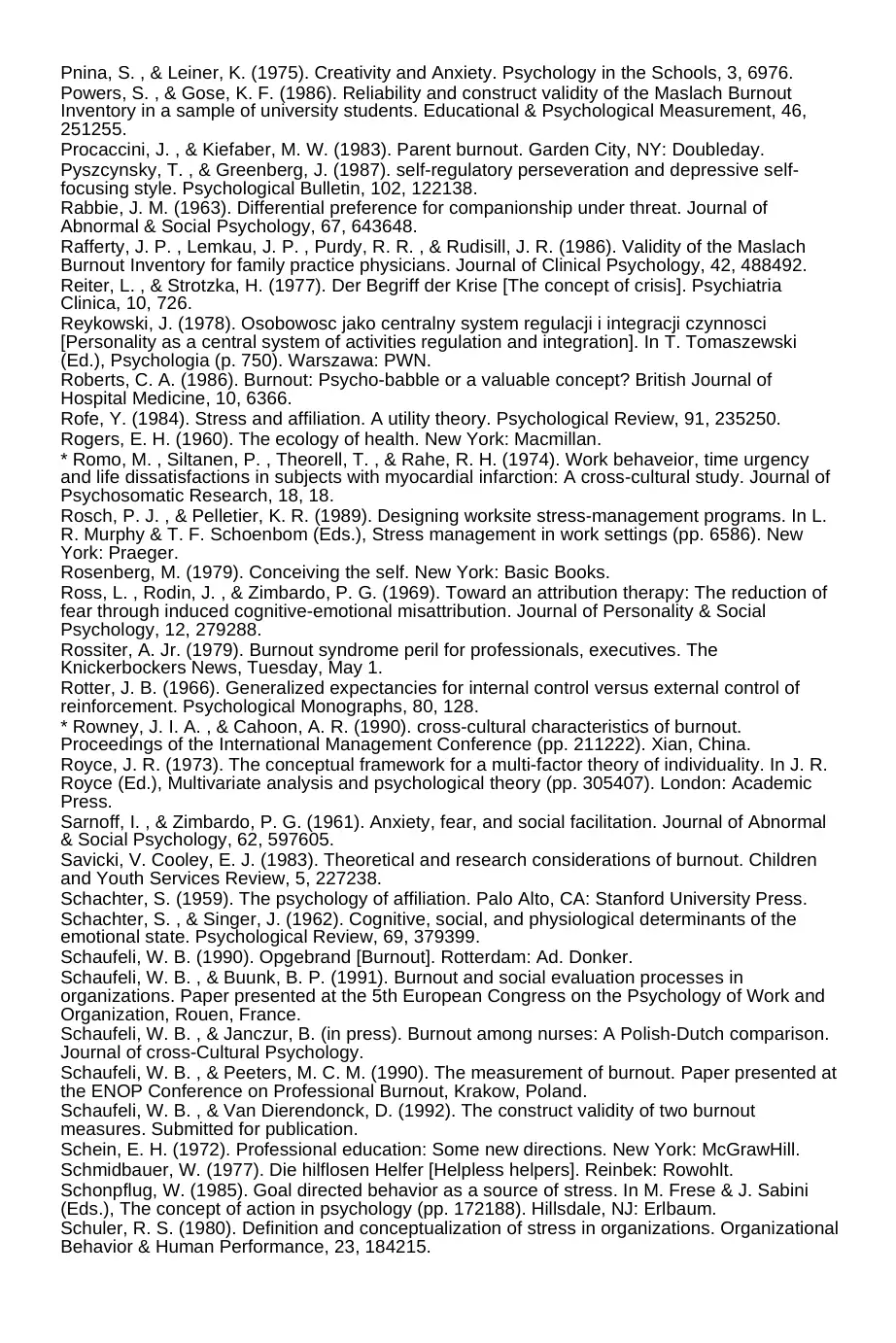
Pnina, S. , & Leiner, K. (1975). Creativity and Anxiety. Psychology in the Schools, 3, 6976.
Powers, S. , & Gose, K. F. (1986). Reliability and construct validity of the Maslach Burnout
Inventory in a sample of university students. Educational & Psychological Measurement, 46,
251255.
Procaccini, J. , & Kiefaber, M. W. (1983). Parent burnout. Garden City, NY: Doubleday.
Pyszcynsky, T. , & Greenberg, J. (1987). self-regulatory perseveration and depressive self-
focusing style. Psychological Bulletin, 102, 122138.
Rabbie, J. M. (1963). Differential preference for companionship under threat. Journal of
Abnormal & Social Psychology, 67, 643648.
Rafferty, J. P. , Lemkau, J. P. , Purdy, R. R. , & Rudisill, J. R. (1986). Validity of the Maslach
Burnout Inventory for family practice physicians. Journal of Clinical Psychology, 42, 488492.
Reiter, L. , & Strotzka, H. (1977). Der Begriff der Krise [The concept of crisis]. Psychiatria
Clinica, 10, 726.
Reykowski, J. (1978). Osobowosc jako centralny system regulacji i integracji czynnosci
[Personality as a central system of activities regulation and integration]. In T. Tomaszewski
(Ed.), Psychologia (p. 750). Warszawa: PWN.
Roberts, C. A. (1986). Burnout: Psycho-babble or a valuable concept? British Journal of
Hospital Medicine, 10, 6366.
Rofe, Y. (1984). Stress and affiliation. A utility theory. Psychological Review, 91, 235250.
Rogers, E. H. (1960). The ecology of health. New York: Macmillan.
* Romo, M. , Siltanen, P. , Theorell, T. , & Rahe, R. H. (1974). Work behaveior, time urgency
and life dissatisfactions in subjects with myocardial infarction: A cross-cultural study. Journal of
Psychosomatic Research, 18, 18.
Rosch, P. J. , & Pelletier, K. R. (1989). Designing worksite stress-management programs. In L.
R. Murphy & T. F. Schoenbom (Eds.), Stress management in work settings (pp. 6586). New
York: Praeger.
Rosenberg, M. (1979). Conceiving the self. New York: Basic Books.
Ross, L. , Rodin, J. , & Zimbardo, P. G. (1969). Toward an attribution therapy: The reduction of
fear through induced cognitive-emotional misattribution. Journal of Personality & Social
Psychology, 12, 279288.
Rossiter, A. Jr. (1979). Burnout syndrome peril for professionals, executives. The
Knickerbockers News, Tuesday, May 1.
Rotter, J. B. (1966). Generalized expectancies for internal control versus external control of
reinforcement. Psychological Monographs, 80, 128.
* Rowney, J. I. A. , & Cahoon, A. R. (1990). cross-cultural characteristics of burnout.
Proceedings of the International Management Conference (pp. 211222). Xian, China.
Royce, J. R. (1973). The conceptual framework for a multi-factor theory of individuality. In J. R.
Royce (Ed.), Multivariate analysis and psychological theory (pp. 305407). London: Academic
Press.
Sarnoff, I. , & Zimbardo, P. G. (1961). Anxiety, fear, and social facilitation. Journal of Abnormal
& Social Psychology, 62, 597605.
Savicki, V. Cooley, E. J. (1983). Theoretical and research considerations of burnout. Children
and Youth Services Review, 5, 227238.
Schachter, S. (1959). The psychology of affiliation. Palo Alto, CA: Stanford University Press.
Schachter, S. , & Singer, J. (1962). Cognitive, social, and physiological determinants of the
emotional state. Psychological Review, 69, 379399.
Schaufeli, W. B. (1990). Opgebrand [Burnout]. Rotterdam: Ad. Donker.
Schaufeli, W. B. , & Buunk, B. P. (1991). Burnout and social evaluation processes in
organizations. Paper presented at the 5th European Congress on the Psychology of Work and
Organization, Rouen, France.
Schaufeli, W. B. , & Janczur, B. (in press). Burnout among nurses: A Polish-Dutch comparison.
Journal of cross-Cultural Psychology.
Schaufeli, W. B. , & Peeters, M. C. M. (1990). The measurement of burnout. Paper presented at
the ENOP Conference on Professional Burnout, Krakow, Poland.
Schaufeli, W. B. , & Van Dierendonck, D. (1992). The construct validity of two burnout
measures. Submitted for publication.
Schein, E. H. (1972). Professional education: Some new directions. New York: McGrawHill.
Schmidbauer, W. (1977). Die hilflosen Helfer [Helpless helpers]. Reinbek: Rowohlt.
Schonpflug, W. (1985). Goal directed behavior as a source of stress. In M. Frese & J. Sabini
(Eds.), The concept of action in psychology (pp. 172188). Hillsdale, NJ: Erlbaum.
Schuler, R. S. (1980). Definition and conceptualization of stress in organizations. Organizational
Behavior & Human Performance, 23, 184215.
Powers, S. , & Gose, K. F. (1986). Reliability and construct validity of the Maslach Burnout
Inventory in a sample of university students. Educational & Psychological Measurement, 46,
251255.
Procaccini, J. , & Kiefaber, M. W. (1983). Parent burnout. Garden City, NY: Doubleday.
Pyszcynsky, T. , & Greenberg, J. (1987). self-regulatory perseveration and depressive self-
focusing style. Psychological Bulletin, 102, 122138.
Rabbie, J. M. (1963). Differential preference for companionship under threat. Journal of
Abnormal & Social Psychology, 67, 643648.
Rafferty, J. P. , Lemkau, J. P. , Purdy, R. R. , & Rudisill, J. R. (1986). Validity of the Maslach
Burnout Inventory for family practice physicians. Journal of Clinical Psychology, 42, 488492.
Reiter, L. , & Strotzka, H. (1977). Der Begriff der Krise [The concept of crisis]. Psychiatria
Clinica, 10, 726.
Reykowski, J. (1978). Osobowosc jako centralny system regulacji i integracji czynnosci
[Personality as a central system of activities regulation and integration]. In T. Tomaszewski
(Ed.), Psychologia (p. 750). Warszawa: PWN.
Roberts, C. A. (1986). Burnout: Psycho-babble or a valuable concept? British Journal of
Hospital Medicine, 10, 6366.
Rofe, Y. (1984). Stress and affiliation. A utility theory. Psychological Review, 91, 235250.
Rogers, E. H. (1960). The ecology of health. New York: Macmillan.
* Romo, M. , Siltanen, P. , Theorell, T. , & Rahe, R. H. (1974). Work behaveior, time urgency
and life dissatisfactions in subjects with myocardial infarction: A cross-cultural study. Journal of
Psychosomatic Research, 18, 18.
Rosch, P. J. , & Pelletier, K. R. (1989). Designing worksite stress-management programs. In L.
R. Murphy & T. F. Schoenbom (Eds.), Stress management in work settings (pp. 6586). New
York: Praeger.
Rosenberg, M. (1979). Conceiving the self. New York: Basic Books.
Ross, L. , Rodin, J. , & Zimbardo, P. G. (1969). Toward an attribution therapy: The reduction of
fear through induced cognitive-emotional misattribution. Journal of Personality & Social
Psychology, 12, 279288.
Rossiter, A. Jr. (1979). Burnout syndrome peril for professionals, executives. The
Knickerbockers News, Tuesday, May 1.
Rotter, J. B. (1966). Generalized expectancies for internal control versus external control of
reinforcement. Psychological Monographs, 80, 128.
* Rowney, J. I. A. , & Cahoon, A. R. (1990). cross-cultural characteristics of burnout.
Proceedings of the International Management Conference (pp. 211222). Xian, China.
Royce, J. R. (1973). The conceptual framework for a multi-factor theory of individuality. In J. R.
Royce (Ed.), Multivariate analysis and psychological theory (pp. 305407). London: Academic
Press.
Sarnoff, I. , & Zimbardo, P. G. (1961). Anxiety, fear, and social facilitation. Journal of Abnormal
& Social Psychology, 62, 597605.
Savicki, V. Cooley, E. J. (1983). Theoretical and research considerations of burnout. Children
and Youth Services Review, 5, 227238.
Schachter, S. (1959). The psychology of affiliation. Palo Alto, CA: Stanford University Press.
Schachter, S. , & Singer, J. (1962). Cognitive, social, and physiological determinants of the
emotional state. Psychological Review, 69, 379399.
Schaufeli, W. B. (1990). Opgebrand [Burnout]. Rotterdam: Ad. Donker.
Schaufeli, W. B. , & Buunk, B. P. (1991). Burnout and social evaluation processes in
organizations. Paper presented at the 5th European Congress on the Psychology of Work and
Organization, Rouen, France.
Schaufeli, W. B. , & Janczur, B. (in press). Burnout among nurses: A Polish-Dutch comparison.
Journal of cross-Cultural Psychology.
Schaufeli, W. B. , & Peeters, M. C. M. (1990). The measurement of burnout. Paper presented at
the ENOP Conference on Professional Burnout, Krakow, Poland.
Schaufeli, W. B. , & Van Dierendonck, D. (1992). The construct validity of two burnout
measures. Submitted for publication.
Schein, E. H. (1972). Professional education: Some new directions. New York: McGrawHill.
Schmidbauer, W. (1977). Die hilflosen Helfer [Helpless helpers]. Reinbek: Rowohlt.
Schonpflug, W. (1985). Goal directed behavior as a source of stress. In M. Frese & J. Sabini
(Eds.), The concept of action in psychology (pp. 172188). Hillsdale, NJ: Erlbaum.
Schuler, R. S. (1980). Definition and conceptualization of stress in organizations. Organizational
Behavior & Human Performance, 23, 184215.
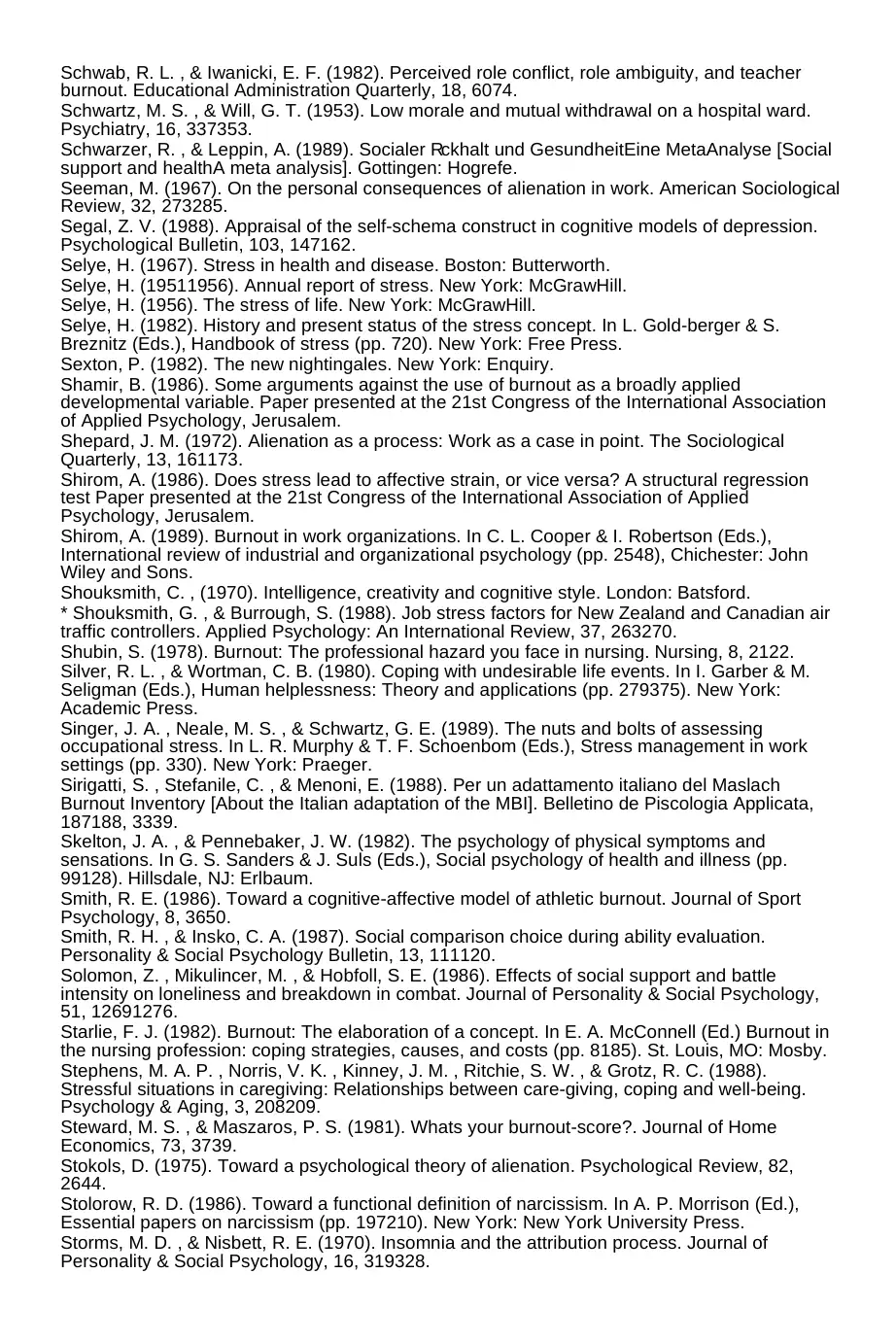
Schwab, R. L. , & Iwanicki, E. F. (1982). Perceived role conflict, role ambiguity, and teacher
burnout. Educational Administration Quarterly, 18, 6074.
Schwartz, M. S. , & Will, G. T. (1953). Low morale and mutual withdrawal on a hospital ward.
Psychiatry, 16, 337353.
Schwarzer, R. , & Leppin, A. (1989). Socialer Rckhalt und GesundheitEine MetaAnalyse [Social
support and healthA meta analysis]. Gottingen: Hogrefe.
Seeman, M. (1967). On the personal consequences of alienation in work. American Sociological
Review, 32, 273285.
Segal, Z. V. (1988). Appraisal of the self-schema construct in cognitive models of depression.
Psychological Bulletin, 103, 147162.
Selye, H. (1967). Stress in health and disease. Boston: Butterworth.
Selye, H. (19511956). Annual report of stress. New York: McGrawHill.
Selye, H. (1956). The stress of life. New York: McGrawHill.
Selye, H. (1982). History and present status of the stress concept. In L. Gold-berger & S.
Breznitz (Eds.), Handbook of stress (pp. 720). New York: Free Press.
Sexton, P. (1982). The new nightingales. New York: Enquiry.
Shamir, B. (1986). Some arguments against the use of burnout as a broadly applied
developmental variable. Paper presented at the 21st Congress of the International Association
of Applied Psychology, Jerusalem.
Shepard, J. M. (1972). Alienation as a process: Work as a case in point. The Sociological
Quarterly, 13, 161173.
Shirom, A. (1986). Does stress lead to affective strain, or vice versa? A structural regression
test Paper presented at the 21st Congress of the International Association of Applied
Psychology, Jerusalem.
Shirom, A. (1989). Burnout in work organizations. In C. L. Cooper & I. Robertson (Eds.),
International review of industrial and organizational psychology (pp. 2548), Chichester: John
Wiley and Sons.
Shouksmith, C. , (1970). Intelligence, creativity and cognitive style. London: Batsford.
* Shouksmith, G. , & Burrough, S. (1988). Job stress factors for New Zealand and Canadian air
traffic controllers. Applied Psychology: An International Review, 37, 263270.
Shubin, S. (1978). Burnout: The professional hazard you face in nursing. Nursing, 8, 2122.
Silver, R. L. , & Wortman, C. B. (1980). Coping with undesirable life events. In I. Garber & M.
Seligman (Eds.), Human helplessness: Theory and applications (pp. 279375). New York:
Academic Press.
Singer, J. A. , Neale, M. S. , & Schwartz, G. E. (1989). The nuts and bolts of assessing
occupational stress. In L. R. Murphy & T. F. Schoenbom (Eds.), Stress management in work
settings (pp. 330). New York: Praeger.
Sirigatti, S. , Stefanile, C. , & Menoni, E. (1988). Per un adattamento italiano del Maslach
Burnout Inventory [About the Italian adaptation of the MBI]. Belletino de Piscologia Applicata,
187188, 3339.
Skelton, J. A. , & Pennebaker, J. W. (1982). The psychology of physical symptoms and
sensations. In G. S. Sanders & J. Suls (Eds.), Social psychology of health and illness (pp.
99128). Hillsdale, NJ: Erlbaum.
Smith, R. E. (1986). Toward a cognitive-affective model of athletic burnout. Journal of Sport
Psychology, 8, 3650.
Smith, R. H. , & Insko, C. A. (1987). Social comparison choice during ability evaluation.
Personality & Social Psychology Bulletin, 13, 111120.
Solomon, Z. , Mikulincer, M. , & Hobfoll, S. E. (1986). Effects of social support and battle
intensity on loneliness and breakdown in combat. Journal of Personality & Social Psychology,
51, 12691276.
Starlie, F. J. (1982). Burnout: The elaboration of a concept. In E. A. McConnell (Ed.) Burnout in
the nursing profession: coping strategies, causes, and costs (pp. 8185). St. Louis, MO: Mosby.
Stephens, M. A. P. , Norris, V. K. , Kinney, J. M. , Ritchie, S. W. , & Grotz, R. C. (1988).
Stressful situations in caregiving: Relationships between care-giving, coping and well-being.
Psychology & Aging, 3, 208209.
Steward, M. S. , & Maszaros, P. S. (1981). Whats your burnout-score?. Journal of Home
Economics, 73, 3739.
Stokols, D. (1975). Toward a psychological theory of alienation. Psychological Review, 82,
2644.
Stolorow, R. D. (1986). Toward a functional definition of narcissism. In A. P. Morrison (Ed.),
Essential papers on narcissism (pp. 197210). New York: New York University Press.
Storms, M. D. , & Nisbett, R. E. (1970). Insomnia and the attribution process. Journal of
Personality & Social Psychology, 16, 319328.
burnout. Educational Administration Quarterly, 18, 6074.
Schwartz, M. S. , & Will, G. T. (1953). Low morale and mutual withdrawal on a hospital ward.
Psychiatry, 16, 337353.
Schwarzer, R. , & Leppin, A. (1989). Socialer Rckhalt und GesundheitEine MetaAnalyse [Social
support and healthA meta analysis]. Gottingen: Hogrefe.
Seeman, M. (1967). On the personal consequences of alienation in work. American Sociological
Review, 32, 273285.
Segal, Z. V. (1988). Appraisal of the self-schema construct in cognitive models of depression.
Psychological Bulletin, 103, 147162.
Selye, H. (1967). Stress in health and disease. Boston: Butterworth.
Selye, H. (19511956). Annual report of stress. New York: McGrawHill.
Selye, H. (1956). The stress of life. New York: McGrawHill.
Selye, H. (1982). History and present status of the stress concept. In L. Gold-berger & S.
Breznitz (Eds.), Handbook of stress (pp. 720). New York: Free Press.
Sexton, P. (1982). The new nightingales. New York: Enquiry.
Shamir, B. (1986). Some arguments against the use of burnout as a broadly applied
developmental variable. Paper presented at the 21st Congress of the International Association
of Applied Psychology, Jerusalem.
Shepard, J. M. (1972). Alienation as a process: Work as a case in point. The Sociological
Quarterly, 13, 161173.
Shirom, A. (1986). Does stress lead to affective strain, or vice versa? A structural regression
test Paper presented at the 21st Congress of the International Association of Applied
Psychology, Jerusalem.
Shirom, A. (1989). Burnout in work organizations. In C. L. Cooper & I. Robertson (Eds.),
International review of industrial and organizational psychology (pp. 2548), Chichester: John
Wiley and Sons.
Shouksmith, C. , (1970). Intelligence, creativity and cognitive style. London: Batsford.
* Shouksmith, G. , & Burrough, S. (1988). Job stress factors for New Zealand and Canadian air
traffic controllers. Applied Psychology: An International Review, 37, 263270.
Shubin, S. (1978). Burnout: The professional hazard you face in nursing. Nursing, 8, 2122.
Silver, R. L. , & Wortman, C. B. (1980). Coping with undesirable life events. In I. Garber & M.
Seligman (Eds.), Human helplessness: Theory and applications (pp. 279375). New York:
Academic Press.
Singer, J. A. , Neale, M. S. , & Schwartz, G. E. (1989). The nuts and bolts of assessing
occupational stress. In L. R. Murphy & T. F. Schoenbom (Eds.), Stress management in work
settings (pp. 330). New York: Praeger.
Sirigatti, S. , Stefanile, C. , & Menoni, E. (1988). Per un adattamento italiano del Maslach
Burnout Inventory [About the Italian adaptation of the MBI]. Belletino de Piscologia Applicata,
187188, 3339.
Skelton, J. A. , & Pennebaker, J. W. (1982). The psychology of physical symptoms and
sensations. In G. S. Sanders & J. Suls (Eds.), Social psychology of health and illness (pp.
99128). Hillsdale, NJ: Erlbaum.
Smith, R. E. (1986). Toward a cognitive-affective model of athletic burnout. Journal of Sport
Psychology, 8, 3650.
Smith, R. H. , & Insko, C. A. (1987). Social comparison choice during ability evaluation.
Personality & Social Psychology Bulletin, 13, 111120.
Solomon, Z. , Mikulincer, M. , & Hobfoll, S. E. (1986). Effects of social support and battle
intensity on loneliness and breakdown in combat. Journal of Personality & Social Psychology,
51, 12691276.
Starlie, F. J. (1982). Burnout: The elaboration of a concept. In E. A. McConnell (Ed.) Burnout in
the nursing profession: coping strategies, causes, and costs (pp. 8185). St. Louis, MO: Mosby.
Stephens, M. A. P. , Norris, V. K. , Kinney, J. M. , Ritchie, S. W. , & Grotz, R. C. (1988).
Stressful situations in caregiving: Relationships between care-giving, coping and well-being.
Psychology & Aging, 3, 208209.
Steward, M. S. , & Maszaros, P. S. (1981). Whats your burnout-score?. Journal of Home
Economics, 73, 3739.
Stokols, D. (1975). Toward a psychological theory of alienation. Psychological Review, 82,
2644.
Stolorow, R. D. (1986). Toward a functional definition of narcissism. In A. P. Morrison (Ed.),
Essential papers on narcissism (pp. 197210). New York: New York University Press.
Storms, M. D. , & Nisbett, R. E. (1970). Insomnia and the attribution process. Journal of
Personality & Social Psychology, 16, 319328.
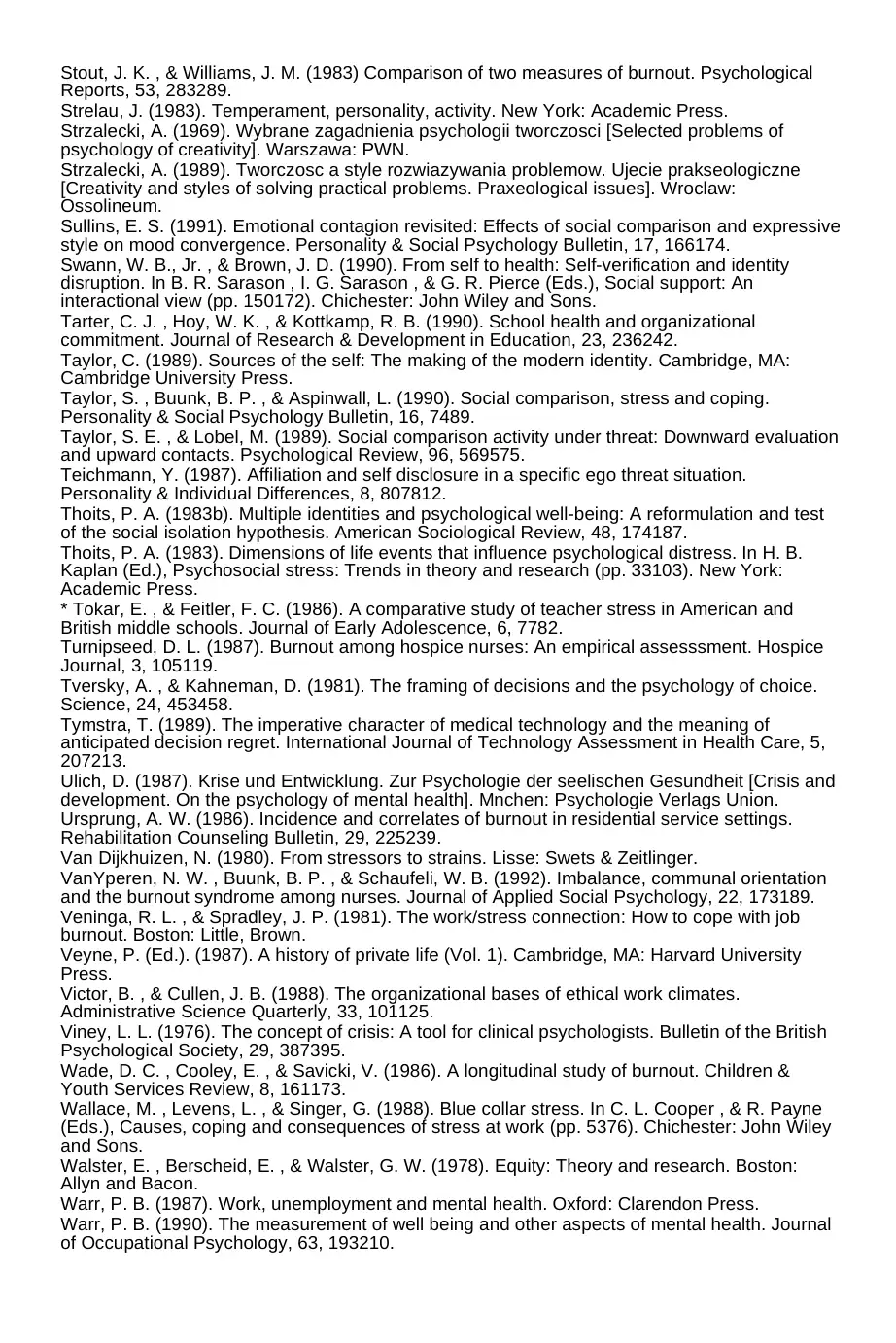
Stout, J. K. , & Williams, J. M. (1983) Comparison of two measures of burnout. Psychological
Reports, 53, 283289.
Strelau, J. (1983). Temperament, personality, activity. New York: Academic Press.
Strzalecki, A. (1969). Wybrane zagadnienia psychologii tworczosci [Selected problems of
psychology of creativity]. Warszawa: PWN.
Strzalecki, A. (1989). Tworczosc a style rozwiazywania problemow. Ujecie prakseologiczne
[Creativity and styles of solving practical problems. Praxeological issues]. Wroclaw:
Ossolineum.
Sullins, E. S. (1991). Emotional contagion revisited: Effects of social comparison and expressive
style on mood convergence. Personality & Social Psychology Bulletin, 17, 166174.
Swann, W. B., Jr. , & Brown, J. D. (1990). From self to health: Self-verification and identity
disruption. In B. R. Sarason , I. G. Sarason , & G. R. Pierce (Eds.), Social support: An
interactional view (pp. 150172). Chichester: John Wiley and Sons.
Tarter, C. J. , Hoy, W. K. , & Kottkamp, R. B. (1990). School health and organizational
commitment. Journal of Research & Development in Education, 23, 236242.
Taylor, C. (1989). Sources of the self: The making of the modern identity. Cambridge, MA:
Cambridge University Press.
Taylor, S. , Buunk, B. P. , & Aspinwall, L. (1990). Social comparison, stress and coping.
Personality & Social Psychology Bulletin, 16, 7489.
Taylor, S. E. , & Lobel, M. (1989). Social comparison activity under threat: Downward evaluation
and upward contacts. Psychological Review, 96, 569575.
Teichmann, Y. (1987). Affiliation and self disclosure in a specific ego threat situation.
Personality & Individual Differences, 8, 807812.
Thoits, P. A. (1983b). Multiple identities and psychological well-being: A reformulation and test
of the social isolation hypothesis. American Sociological Review, 48, 174187.
Thoits, P. A. (1983). Dimensions of life events that influence psychological distress. In H. B.
Kaplan (Ed.), Psychosocial stress: Trends in theory and research (pp. 33103). New York:
Academic Press.
* Tokar, E. , & Feitler, F. C. (1986). A comparative study of teacher stress in American and
British middle schools. Journal of Early Adolescence, 6, 7782.
Turnipseed, D. L. (1987). Burnout among hospice nurses: An empirical assesssment. Hospice
Journal, 3, 105119.
Tversky, A. , & Kahneman, D. (1981). The framing of decisions and the psychology of choice.
Science, 24, 453458.
Tymstra, T. (1989). The imperative character of medical technology and the meaning of
anticipated decision regret. International Journal of Technology Assessment in Health Care, 5,
207213.
Ulich, D. (1987). Krise und Entwicklung. Zur Psychologie der seelischen Gesundheit [Crisis and
development. On the psychology of mental health]. Mnchen: Psychologie Verlags Union.
Ursprung, A. W. (1986). Incidence and correlates of burnout in residential service settings.
Rehabilitation Counseling Bulletin, 29, 225239.
Van Dijkhuizen, N. (1980). From stressors to strains. Lisse: Swets & Zeitlinger.
VanYperen, N. W. , Buunk, B. P. , & Schaufeli, W. B. (1992). Imbalance, communal orientation
and the burnout syndrome among nurses. Journal of Applied Social Psychology, 22, 173189.
Veninga, R. L. , & Spradley, J. P. (1981). The work/stress connection: How to cope with job
burnout. Boston: Little, Brown.
Veyne, P. (Ed.). (1987). A history of private life (Vol. 1). Cambridge, MA: Harvard University
Press.
Victor, B. , & Cullen, J. B. (1988). The organizational bases of ethical work climates.
Administrative Science Quarterly, 33, 101125.
Viney, L. L. (1976). The concept of crisis: A tool for clinical psychologists. Bulletin of the British
Psychological Society, 29, 387395.
Wade, D. C. , Cooley, E. , & Savicki, V. (1986). A longitudinal study of burnout. Children &
Youth Services Review, 8, 161173.
Wallace, M. , Levens, L. , & Singer, G. (1988). Blue collar stress. In C. L. Cooper , & R. Payne
(Eds.), Causes, coping and consequences of stress at work (pp. 5376). Chichester: John Wiley
and Sons.
Walster, E. , Berscheid, E. , & Walster, G. W. (1978). Equity: Theory and research. Boston:
Allyn and Bacon.
Warr, P. B. (1987). Work, unemployment and mental health. Oxford: Clarendon Press.
Warr, P. B. (1990). The measurement of well being and other aspects of mental health. Journal
of Occupational Psychology, 63, 193210.
Reports, 53, 283289.
Strelau, J. (1983). Temperament, personality, activity. New York: Academic Press.
Strzalecki, A. (1969). Wybrane zagadnienia psychologii tworczosci [Selected problems of
psychology of creativity]. Warszawa: PWN.
Strzalecki, A. (1989). Tworczosc a style rozwiazywania problemow. Ujecie prakseologiczne
[Creativity and styles of solving practical problems. Praxeological issues]. Wroclaw:
Ossolineum.
Sullins, E. S. (1991). Emotional contagion revisited: Effects of social comparison and expressive
style on mood convergence. Personality & Social Psychology Bulletin, 17, 166174.
Swann, W. B., Jr. , & Brown, J. D. (1990). From self to health: Self-verification and identity
disruption. In B. R. Sarason , I. G. Sarason , & G. R. Pierce (Eds.), Social support: An
interactional view (pp. 150172). Chichester: John Wiley and Sons.
Tarter, C. J. , Hoy, W. K. , & Kottkamp, R. B. (1990). School health and organizational
commitment. Journal of Research & Development in Education, 23, 236242.
Taylor, C. (1989). Sources of the self: The making of the modern identity. Cambridge, MA:
Cambridge University Press.
Taylor, S. , Buunk, B. P. , & Aspinwall, L. (1990). Social comparison, stress and coping.
Personality & Social Psychology Bulletin, 16, 7489.
Taylor, S. E. , & Lobel, M. (1989). Social comparison activity under threat: Downward evaluation
and upward contacts. Psychological Review, 96, 569575.
Teichmann, Y. (1987). Affiliation and self disclosure in a specific ego threat situation.
Personality & Individual Differences, 8, 807812.
Thoits, P. A. (1983b). Multiple identities and psychological well-being: A reformulation and test
of the social isolation hypothesis. American Sociological Review, 48, 174187.
Thoits, P. A. (1983). Dimensions of life events that influence psychological distress. In H. B.
Kaplan (Ed.), Psychosocial stress: Trends in theory and research (pp. 33103). New York:
Academic Press.
* Tokar, E. , & Feitler, F. C. (1986). A comparative study of teacher stress in American and
British middle schools. Journal of Early Adolescence, 6, 7782.
Turnipseed, D. L. (1987). Burnout among hospice nurses: An empirical assesssment. Hospice
Journal, 3, 105119.
Tversky, A. , & Kahneman, D. (1981). The framing of decisions and the psychology of choice.
Science, 24, 453458.
Tymstra, T. (1989). The imperative character of medical technology and the meaning of
anticipated decision regret. International Journal of Technology Assessment in Health Care, 5,
207213.
Ulich, D. (1987). Krise und Entwicklung. Zur Psychologie der seelischen Gesundheit [Crisis and
development. On the psychology of mental health]. Mnchen: Psychologie Verlags Union.
Ursprung, A. W. (1986). Incidence and correlates of burnout in residential service settings.
Rehabilitation Counseling Bulletin, 29, 225239.
Van Dijkhuizen, N. (1980). From stressors to strains. Lisse: Swets & Zeitlinger.
VanYperen, N. W. , Buunk, B. P. , & Schaufeli, W. B. (1992). Imbalance, communal orientation
and the burnout syndrome among nurses. Journal of Applied Social Psychology, 22, 173189.
Veninga, R. L. , & Spradley, J. P. (1981). The work/stress connection: How to cope with job
burnout. Boston: Little, Brown.
Veyne, P. (Ed.). (1987). A history of private life (Vol. 1). Cambridge, MA: Harvard University
Press.
Victor, B. , & Cullen, J. B. (1988). The organizational bases of ethical work climates.
Administrative Science Quarterly, 33, 101125.
Viney, L. L. (1976). The concept of crisis: A tool for clinical psychologists. Bulletin of the British
Psychological Society, 29, 387395.
Wade, D. C. , Cooley, E. , & Savicki, V. (1986). A longitudinal study of burnout. Children &
Youth Services Review, 8, 161173.
Wallace, M. , Levens, L. , & Singer, G. (1988). Blue collar stress. In C. L. Cooper , & R. Payne
(Eds.), Causes, coping and consequences of stress at work (pp. 5376). Chichester: John Wiley
and Sons.
Walster, E. , Berscheid, E. , & Walster, G. W. (1978). Equity: Theory and research. Boston:
Allyn and Bacon.
Warr, P. B. (1987). Work, unemployment and mental health. Oxford: Clarendon Press.
Warr, P. B. (1990). The measurement of well being and other aspects of mental health. Journal
of Occupational Psychology, 63, 193210.
Secure Best Marks with AI Grader
Need help grading? Try our AI Grader for instant feedback on your assignments.
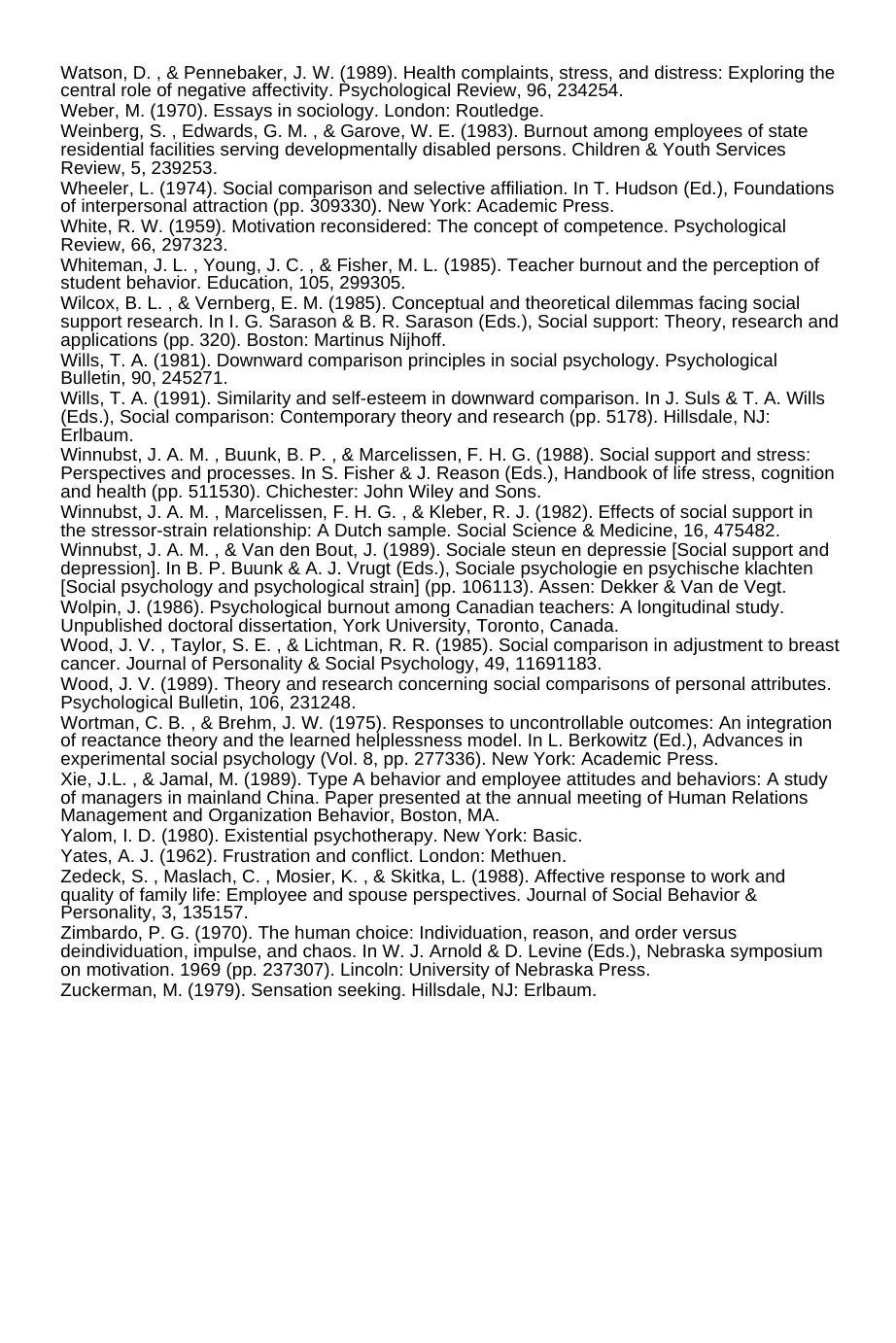
Watson, D. , & Pennebaker, J. W. (1989). Health complaints, stress, and distress: Exploring the
central role of negative affectivity. Psychological Review, 96, 234254.
Weber, M. (1970). Essays in sociology. London: Routledge.
Weinberg, S. , Edwards, G. M. , & Garove, W. E. (1983). Burnout among employees of state
residential facilities serving developmentally disabled persons. Children & Youth Services
Review, 5, 239253.
Wheeler, L. (1974). Social comparison and selective affiliation. In T. Hudson (Ed.), Foundations
of interpersonal attraction (pp. 309330). New York: Academic Press.
White, R. W. (1959). Motivation reconsidered: The concept of competence. Psychological
Review, 66, 297323.
Whiteman, J. L. , Young, J. C. , & Fisher, M. L. (1985). Teacher burnout and the perception of
student behavior. Education, 105, 299305.
Wilcox, B. L. , & Vernberg, E. M. (1985). Conceptual and theoretical dilemmas facing social
support research. In I. G. Sarason & B. R. Sarason (Eds.), Social support: Theory, research and
applications (pp. 320). Boston: Martinus Nijhoff.
Wills, T. A. (1981). Downward comparison principles in social psychology. Psychological
Bulletin, 90, 245271.
Wills, T. A. (1991). Similarity and self-esteem in downward comparison. In J. Suls & T. A. Wills
(Eds.), Social comparison: Contemporary theory and research (pp. 5178). Hillsdale, NJ:
Erlbaum.
Winnubst, J. A. M. , Buunk, B. P. , & Marcelissen, F. H. G. (1988). Social support and stress:
Perspectives and processes. In S. Fisher & J. Reason (Eds.), Handbook of life stress, cognition
and health (pp. 511530). Chichester: John Wiley and Sons.
Winnubst, J. A. M. , Marcelissen, F. H. G. , & Kleber, R. J. (1982). Effects of social support in
the stressor-strain relationship: A Dutch sample. Social Science & Medicine, 16, 475482.
Winnubst, J. A. M. , & Van den Bout, J. (1989). Sociale steun en depressie [Social support and
depression]. In B. P. Buunk & A. J. Vrugt (Eds.), Sociale psychologie en psychische klachten
[Social psychology and psychological strain] (pp. 106113). Assen: Dekker & Van de Vegt.
Wolpin, J. (1986). Psychological burnout among Canadian teachers: A longitudinal study.
Unpublished doctoral dissertation, York University, Toronto, Canada.
Wood, J. V. , Taylor, S. E. , & Lichtman, R. R. (1985). Social comparison in adjustment to breast
cancer. Journal of Personality & Social Psychology, 49, 11691183.
Wood, J. V. (1989). Theory and research concerning social comparisons of personal attributes.
Psychological Bulletin, 106, 231248.
Wortman, C. B. , & Brehm, J. W. (1975). Responses to uncontrollable outcomes: An integration
of reactance theory and the learned helplessness model. In L. Berkowitz (Ed.), Advances in
experimental social psychology (Vol. 8, pp. 277336). New York: Academic Press.
Xie, J.L. , & Jamal, M. (1989). Type A behavior and employee attitudes and behaviors: A study
of managers in mainland China. Paper presented at the annual meeting of Human Relations
Management and Organization Behavior, Boston, MA.
Yalom, I. D. (1980). Existential psychotherapy. New York: Basic.
Yates, A. J. (1962). Frustration and conflict. London: Methuen.
Zedeck, S. , Maslach, C. , Mosier, K. , & Skitka, L. (1988). Affective response to work and
quality of family life: Employee and spouse perspectives. Journal of Social Behavior &
Personality, 3, 135157.
Zimbardo, P. G. (1970). The human choice: Individuation, reason, and order versus
deindividuation, impulse, and chaos. In W. J. Arnold & D. Levine (Eds.), Nebraska symposium
on motivation. 1969 (pp. 237307). Lincoln: University of Nebraska Press.
Zuckerman, M. (1979). Sensation seeking. Hillsdale, NJ: Erlbaum.
central role of negative affectivity. Psychological Review, 96, 234254.
Weber, M. (1970). Essays in sociology. London: Routledge.
Weinberg, S. , Edwards, G. M. , & Garove, W. E. (1983). Burnout among employees of state
residential facilities serving developmentally disabled persons. Children & Youth Services
Review, 5, 239253.
Wheeler, L. (1974). Social comparison and selective affiliation. In T. Hudson (Ed.), Foundations
of interpersonal attraction (pp. 309330). New York: Academic Press.
White, R. W. (1959). Motivation reconsidered: The concept of competence. Psychological
Review, 66, 297323.
Whiteman, J. L. , Young, J. C. , & Fisher, M. L. (1985). Teacher burnout and the perception of
student behavior. Education, 105, 299305.
Wilcox, B. L. , & Vernberg, E. M. (1985). Conceptual and theoretical dilemmas facing social
support research. In I. G. Sarason & B. R. Sarason (Eds.), Social support: Theory, research and
applications (pp. 320). Boston: Martinus Nijhoff.
Wills, T. A. (1981). Downward comparison principles in social psychology. Psychological
Bulletin, 90, 245271.
Wills, T. A. (1991). Similarity and self-esteem in downward comparison. In J. Suls & T. A. Wills
(Eds.), Social comparison: Contemporary theory and research (pp. 5178). Hillsdale, NJ:
Erlbaum.
Winnubst, J. A. M. , Buunk, B. P. , & Marcelissen, F. H. G. (1988). Social support and stress:
Perspectives and processes. In S. Fisher & J. Reason (Eds.), Handbook of life stress, cognition
and health (pp. 511530). Chichester: John Wiley and Sons.
Winnubst, J. A. M. , Marcelissen, F. H. G. , & Kleber, R. J. (1982). Effects of social support in
the stressor-strain relationship: A Dutch sample. Social Science & Medicine, 16, 475482.
Winnubst, J. A. M. , & Van den Bout, J. (1989). Sociale steun en depressie [Social support and
depression]. In B. P. Buunk & A. J. Vrugt (Eds.), Sociale psychologie en psychische klachten
[Social psychology and psychological strain] (pp. 106113). Assen: Dekker & Van de Vegt.
Wolpin, J. (1986). Psychological burnout among Canadian teachers: A longitudinal study.
Unpublished doctoral dissertation, York University, Toronto, Canada.
Wood, J. V. , Taylor, S. E. , & Lichtman, R. R. (1985). Social comparison in adjustment to breast
cancer. Journal of Personality & Social Psychology, 49, 11691183.
Wood, J. V. (1989). Theory and research concerning social comparisons of personal attributes.
Psychological Bulletin, 106, 231248.
Wortman, C. B. , & Brehm, J. W. (1975). Responses to uncontrollable outcomes: An integration
of reactance theory and the learned helplessness model. In L. Berkowitz (Ed.), Advances in
experimental social psychology (Vol. 8, pp. 277336). New York: Academic Press.
Xie, J.L. , & Jamal, M. (1989). Type A behavior and employee attitudes and behaviors: A study
of managers in mainland China. Paper presented at the annual meeting of Human Relations
Management and Organization Behavior, Boston, MA.
Yalom, I. D. (1980). Existential psychotherapy. New York: Basic.
Yates, A. J. (1962). Frustration and conflict. London: Methuen.
Zedeck, S. , Maslach, C. , Mosier, K. , & Skitka, L. (1988). Affective response to work and
quality of family life: Employee and spouse perspectives. Journal of Social Behavior &
Personality, 3, 135157.
Zimbardo, P. G. (1970). The human choice: Individuation, reason, and order versus
deindividuation, impulse, and chaos. In W. J. Arnold & D. Levine (Eds.), Nebraska symposium
on motivation. 1969 (pp. 237307). Lincoln: University of Nebraska Press.
Zuckerman, M. (1979). Sensation seeking. Hillsdale, NJ: Erlbaum.
1 out of 47
Related Documents
Your All-in-One AI-Powered Toolkit for Academic Success.
+13062052269
info@desklib.com
Available 24*7 on WhatsApp / Email
![[object Object]](/_next/static/media/star-bottom.7253800d.svg)
Unlock your academic potential
© 2024 | Zucol Services PVT LTD | All rights reserved.
